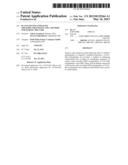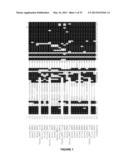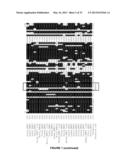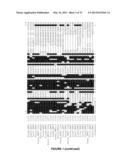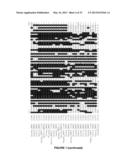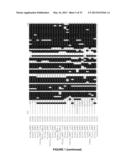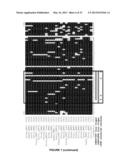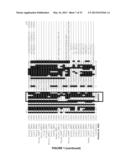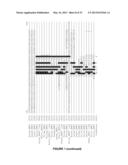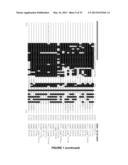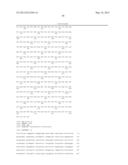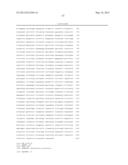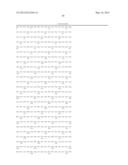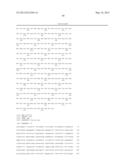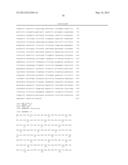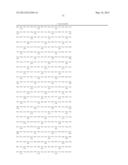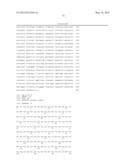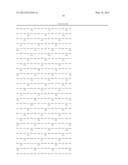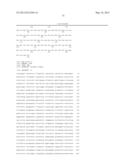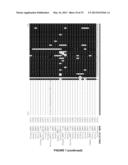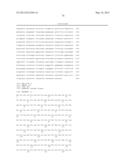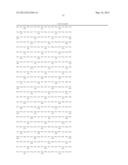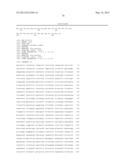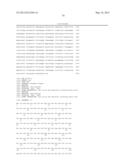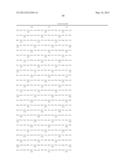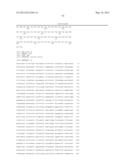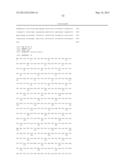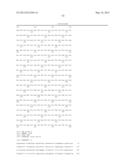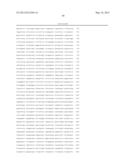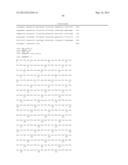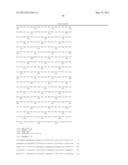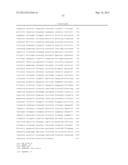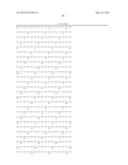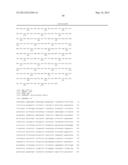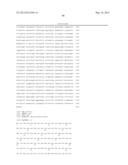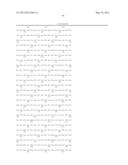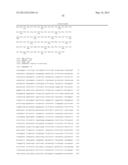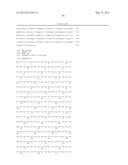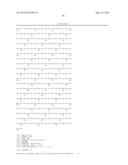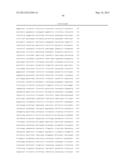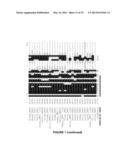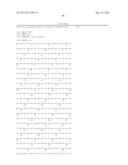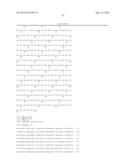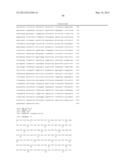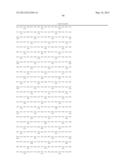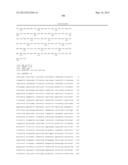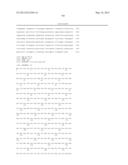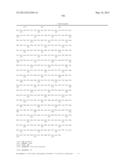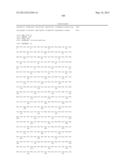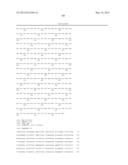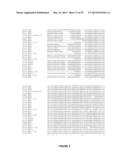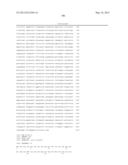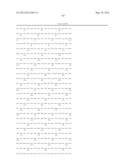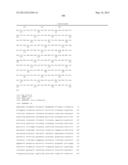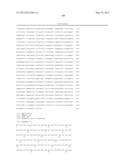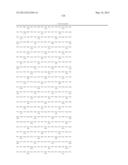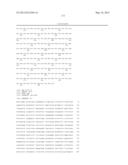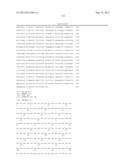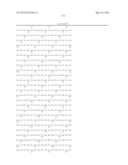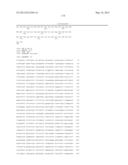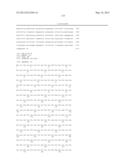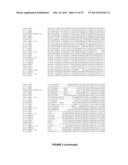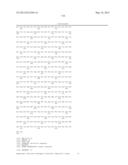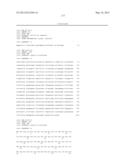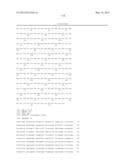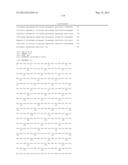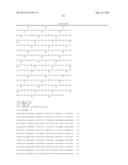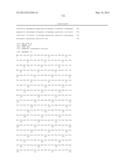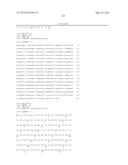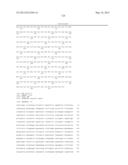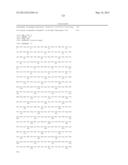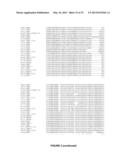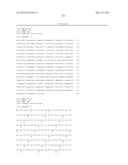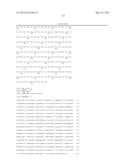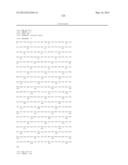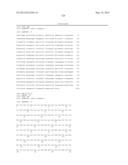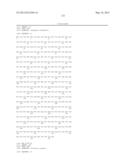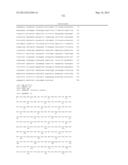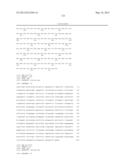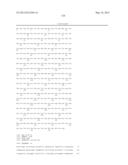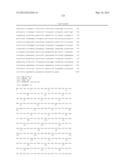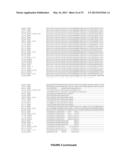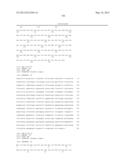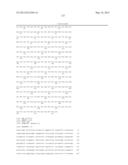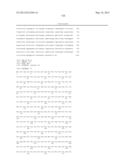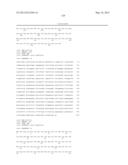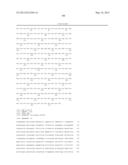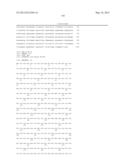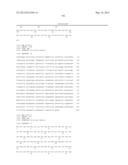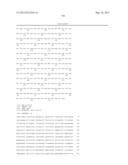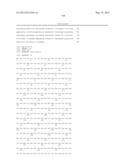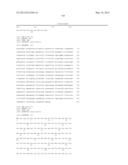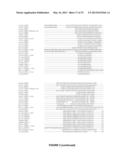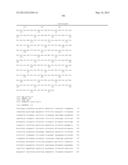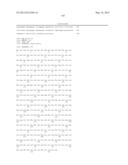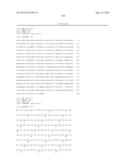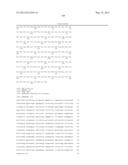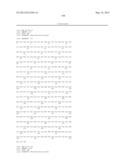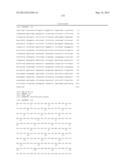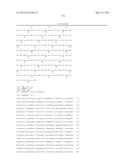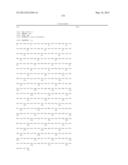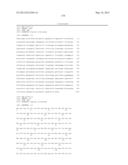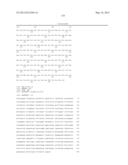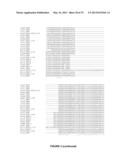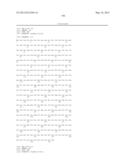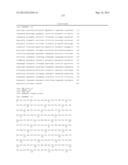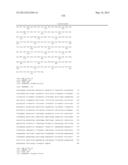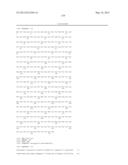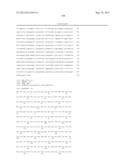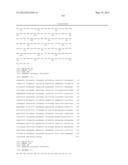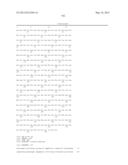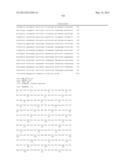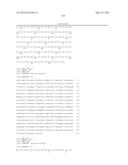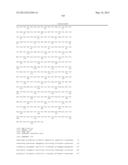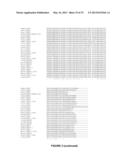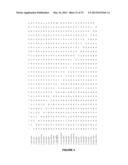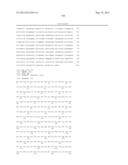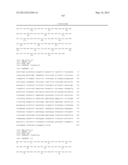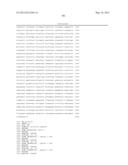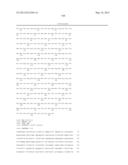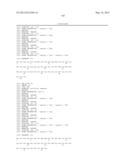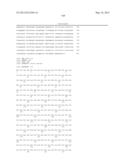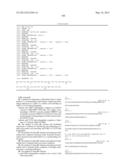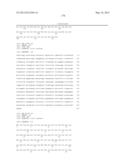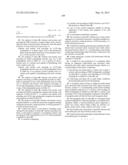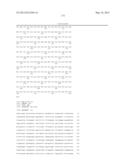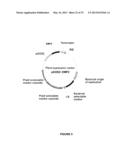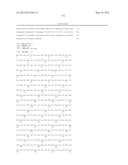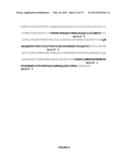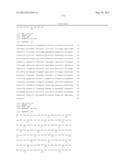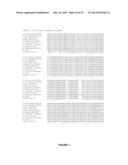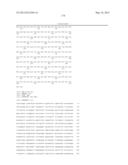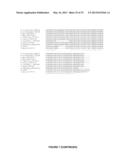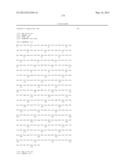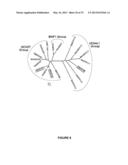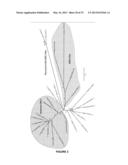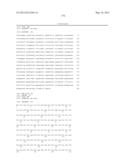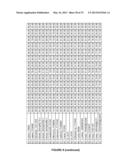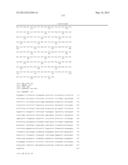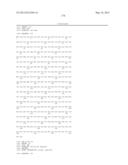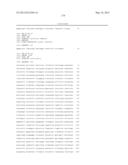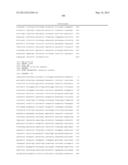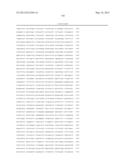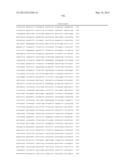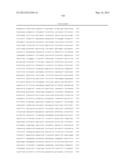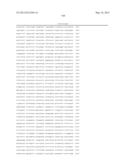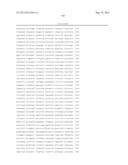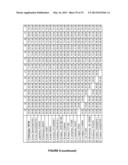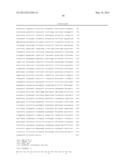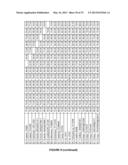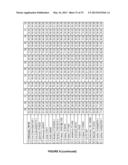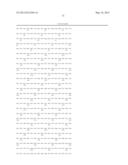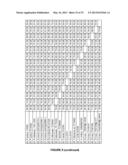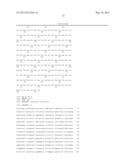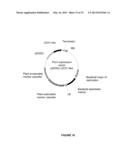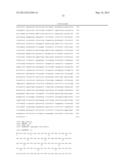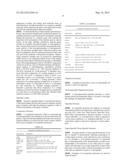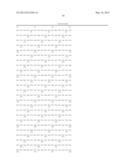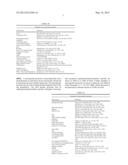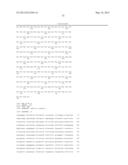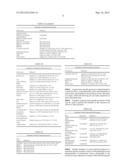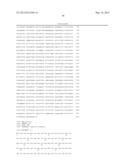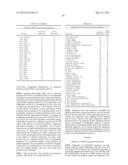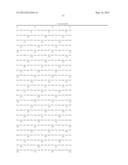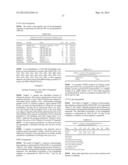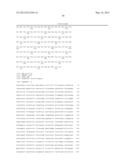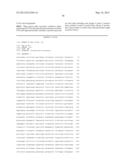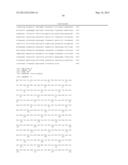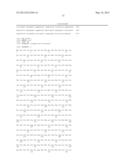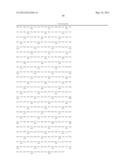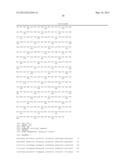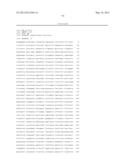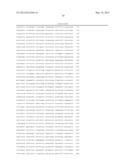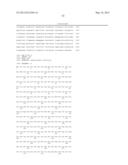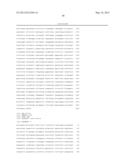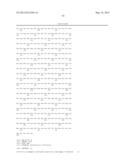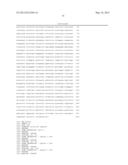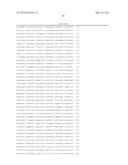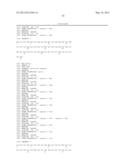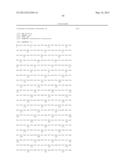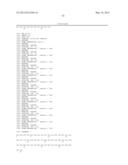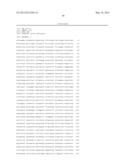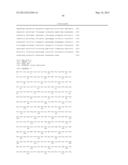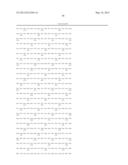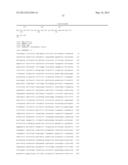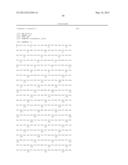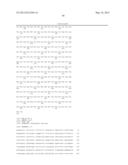Patent application title: Plants Having Enhanced Yield-Related Traits and a Method for Making the Same
Inventors:
Valerie Frankard (Waterloo, BE)
Steven Vandenabeele (Oudenaarde, BE)
Assignees:
BASF Plant Science Company GmbH
IPC8 Class: AC12N1582FI
USPC Class:
800290
Class name: Multicellular living organisms and unmodified parts thereof and related processes method of introducing a polynucleotide molecule into or rearrangement of genetic material within a plant or plant part the polynucleotide alters plant part growth (e.g., stem or tuber length, etc.)
Publication date: 2013-05-16
Patent application number: 20130125264
Abstract:
Nucleic acids and the encoded embryonic flower 2 (EMF2) polypeptides or
Ubiquitin C-terminal Hydrolase 1 (UCH1-like) polypeptides are provided. A
method of enhancing yield-related traits in plants by modulating
expression of nucleic acids encoding EMF2 polypeptides or UCH1-like
polypeptides is provided. Plants with modulated expression of the nucleic
acids encoding EMF2 polypeptides or UCH1-like polypeptides have enhanced
yield-related traits relative to control plants.Claims:
1-44. (canceled)
45. A method for enhancing a yield-related trait in a plant relative to a corresponding control plant, comprising modulating expression in a plant of a nucleic acid encoding an EMF2 or UCH1-like polypeptide, wherein said EMF2 polypeptide comprises an InterPro accession IPR015880 C2H2-type Zinc finger corresponding to SMART accession number SM00355 and an InterPro accession IPR019135 VEFS-box Polycomb protein domain corresponding to PFAM accession number PF09733, and wherein said UCH1-like polypeptide comprises a Peptidase_C12 domain (Pfam PF1088).
46. The method of claim 45, wherein said modulated expression is effected by introducing and expressing in a plant said nucleic acid encoding said EMF2 or UCH1-like polypeptide.
47. The method of claim 45, wherein said enhanced yield-related trait comprises increased yield, increased biomass, and/or increased seed yield relative to a corresponding control plant.
48. The method of claim 45, wherein said enhanced yield-related trait is obtained under non-stress conditions.
49. The method of claim 45, wherein said enhanced yield-related trait is obtained under conditions of drought stress, salt stress, or nitrogen deficiency.
50. The method of claim 45, wherein a) said EMF2 polypeptide comprises one or more of the following motifs: TABLE-US-00021 (i) Motif 1: (SEQ ID NO: 5) D[VI]AD[LF]EDRRMLDDFVDVTKDEK[QL][VIM]MH[LM]WNSFVRK QRVLADGHIPWACEAF; (ii) Motif 2: (SEQ ID NO: 6) [LM]Q[KR]TEVTEDF[TS]CPFCLVKC[VAG]SFKGL[RG][YC]HL [CNPT]SSHDLF[KHN][FY]EFW[VI]; (iii) Motif 3: (SEQ ID NO: 7) AAEES[LF][AS][SLI]YCKPVELYNI[IL]QRRA[VI][RK]NP [SL]FLQRCL[QHL]YKI[QH]A[KR][HR]K[KR]RIQ[MI]T[IV]; and b) said UCH1-like polypeptide comprises one or more of the following motifs: (i) Motif 4: (SEQ ID NO: 150) [VA][TS]EKI[IL]MEEE[DK]FKKW[KR]TENIRRKHNY[IV]PFLF NFLKILAEK[KQ]QLKPLIEKA[VKA]; (ii) Motif 5: Q[KR]AA[GST][QK][ED]DDVYHFISY[LVI]PVDGVLYELDGLK EGPISLGQC[TP]G; (SEQ ID NO: 151) (iii) Motif 6: (SEQ ID NO: 152) PNPNLFFA[RSN]Q[VI]INNACA[ST]QAILS[IV]L[ML]N[CSR]P.
51. The method of claim 45, wherein said nucleic acid encoding an EMF2 protein is of plant origin, from a dicotyledonous plant, from the family Solanaceae, from the genus Solanum, or from Solarium lycopersicum, or wherein said nucleic acid encoding an UCH1-like polypeptide is of plant origin, from a dicotyledonous plant, from the family Salicaceae, from the genus Populus, or from Populus trichocarpa.
52. The method of claim 45, wherein said nucleic acid encoding an EMF2 polypeptide encodes any one of the polypeptides listed in Table A1, or is a portion of such a nucleic acid, or a nucleic acid capable of hybridising with such a nucleic acid, and wherein said nucleic acid encoding an UCH1-like polypeptide encodes any one of the polypeptides listed in Table A2, or is a portion of such a nucleic acid, or a nucleic acid capable of hybridising with such a nucleic acid.
53. The method of claim 45, wherein said nucleic acid sequence encoding an EMF2 polypeptide encodes an orthologue or paralogue of any of the polypeptides given in Table A1, or wherein said nucleic acid sequence encoding an UCH1-like polypeptide encodes an orthologue or paralogue of any of the polypeptides given in Table A2.
54. The method of claim 45, wherein said nucleic acid encoding said EMF2 polypeptide comprises the nucleic acid sequence of SEQ ID NO: 1, or wherein said nucleic acid encoding said UCH1-like polypeptide comprises the nucleic acid sequence of SEQ ID NO: 62.
55. The method of claim 45, wherein said nucleic acid is operably linked to a constitutive promoter, a medium strength constitutive promoter, a plant promoter, a GOS2 promoter, or a GOS2 promoter from rice.
56. A plant cell, plant, or part thereof, including seeds, obtained by the method of claim 45, wherein said plant cell, plant, or part thereof comprises a recombinant nucleic acid encoding an EMF2 polypeptide or an UCH1-like polypeptide as defined in claim 45.
57. A construct comprising: (i) a nucleic acid encoding an EMF2 protein or an UCH1-like protein as defined claim 45; (ii) one or more control sequences capable of driving expression of the nucleic acid sequence of (i); and optionally (iii) a transcription termination sequence.
58. The construct of claim 57, wherein one of said control sequences is a constitutive promoter, a medium strength constitutive promoter, a plant promoter, a GOS2 promoter, or a GOS2 promoter from rice.
59. A method for making a plant having an enhanced yield-related trait, increased yield, increased seed yield, and/or increased biomass relative to a corresponding control plant comprising transforming a plant cell, plant, or plant part with the construct of claim 57.
60. A plant, plant part, or plant cell transformed with the construct of claim 57.
61. A method for the production of a transgenic plant having an enhanced yield-related trait increased yield, increased seed yield, and/or increased biomass relative to a corresponding control plant, comprising: (i) introducing and expressing in a plant cell or plant a nucleic acid encoding an EMF2 polypeptide as defined in claim 45 or a nucleic acid encoding an UCH1-like polypeptide as defined in claim 45; and (ii) cultivating said plant cell or plant under conditions promoting plant growth and development.
62. A transgenic plant having an enhanced yield-related trait, increased yield, increased seed yield, and/or increased biomass, relative to a corresponding control plant resulting from modulated expression of a nucleic acid encoding an EMF2 polypeptide as defined in claim 45 or a nucleic acid encoding a UCH1-like polypeptide as defined in claim 45, or a transgenic plant cell derived from said transgenic plant.
63. The transgenic plant of claim 56, or a transgenic plant cell derived therefrom, wherein said plant is a crop plant, beet, sugarbeet, alfalfa, a monocotyledonous plant, sugarcane, a cereal, rice, maize, wheat, barley, millet, rye, triticale, sorghum, emmer, spelt, secale, einkorn, teff, milo, or oats.
64. Harvestable parts of the plant of claim 63, wherein said harvestable parts are shoot biomass and/or seeds.
65. Products derived from the plant of claim 63 and/or from harvestable parts of said plant.
Description:
[0001] The present invention relates generally to the field of molecular
biology and concerns a method for enhancing yield-related traits in
plants by modulating expression in a plant of a nucleic acid encoding an
embryonic flower 2 or EMF2 polypeptide or a UCH1-like (Ubiquitin
C-terminal Hydrolase 1) polypeptide. The present invention also concerns
plants having modulated expression of a nucleic acid encoding an EMF2
polypeptide or a UCH1-like polypeptide, which plants have enhanced
yield-related traits relative to corresponding wild type plants or other
control plants. The invention also provides constructs useful in the
methods of the invention.
[0002] The ever-increasing world population and the dwindling supply of arable land available for agriculture fuels research towards increasing the efficiency of agriculture. Conventional means for crop and horticultural improvements utilise selective breeding techniques to identify plants having desirable characteristics. However, such selective breeding techniques have several drawbacks, namely that these techniques are typically labour intensive and result in plants that often contain heterogeneous genetic components that may not always result in the desirable trait being passed on from parent plants. Advances in molecular biology have allowed mankind to modify the germplasm of animals and plants. Genetic engineering of plants entails the isolation and manipulation of genetic material (typically in the form of DNA or RNA) and the subsequent introduction of that genetic material into a plant. Such technology has the capacity to deliver crops or plants having various improved economic, agronomic or horticultural traits.
[0003] A trait of particular economic interest is increased yield. Yield is normally defined as the measurable produce of economic value from a crop. This may be defined in terms of quantity and/or quality. Yield is directly dependent on several factors, for example, the number and size of the organs, plant architecture (for example, the number of branches), seed production, leaf senescence and more. Root development, nutrient uptake, stress tolerance and early vigour may also be important factors in determining yield. Optimizing the abovementioned factors may therefore contribute to increasing crop yield.
[0004] Seed yield is a particularly important trait, since the seeds of many plants are important for human and animal nutrition. Crops such as corn, rice, wheat, canola and soybean account for over half the total human caloric intake, whether through direct consumption of the seeds themselves or through consumption of meat products raised on processed seeds. They are also a source of sugars, oils and many kinds of metabolites used in industrial processes. Seeds contain an embryo (the source of new shoots and roots) and an endosperm (the source of nutrients for embryo growth during germination and during early growth of seedlings). The development of a seed involves many genes, and requires the transfer of metabolites from the roots, leaves and stems into the growing seed. The endosperm, in particular, assimilates the metabolic precursors of carbohydrates, oils and proteins and synthesizes them into storage macromolecules to fill out the grain.
[0005] Another important trait for many crops is early vigour. Improving early vigour is an important objective of modern rice breeding programs in both temperate and tropical rice cultivars. Long roots are important for proper soil anchorage in water-seeded rice. Where rice is sown directly into flooded fields, and where plants must emerge rapidly through water, longer shoots are associated with vigour. Where drill-seeding is practiced, longer mesocotyls and coleoptiles are important for good seedling emergence. The ability to engineer early vigour into plants would be of great importance in agriculture. For example, poor early vigour has been a limitation to the introduction of maize (Zea mays L.) hybrids based on Corn Belt germplasm in the European Atlantic.
[0006] A further important trait is that of improved abiotic stress tolerance. Abiotic stress is a primary cause of crop loss worldwide, reducing average yields for most major crop plants by more than 50% (Wang et al., Planta 218, 1-14, 2003). Abiotic stresses may be caused by drought, salinity, extremes of temperature, chemical toxicity and oxidative stress. The ability to improve plant tolerance to abiotic stress would be of great economic advantage to farmers worldwide and would allow for the cultivation of crops during adverse conditions and in territories where cultivation of crops may not otherwise be possible.
[0007] Crop yield may therefore be increased by optimising one of the above-mentioned factors.
[0008] Depending on the end use, the modification of certain yield traits may be favoured over others. For example for applications such as forage or wood production, or bio-fuel resource, an increase in the vegetative parts of a plant may be desirable, and for applications such as flour, starch or oil production, an increase in seed parameters may be particularly desirable. Even amongst the seed parameters, some may be favoured over others, depending on the application. Various mechanisms may contribute to increasing seed yield, whether that is in the form of increased seed size or increased seed number.
[0009] It has now been found that various yield-related traits may be improved in plants by modulating expression in a plant of a nucleic acid encoding an EMF2 or a UCH1-like (Ubiquitin C-terminal Hydrolase 1) polypeptide in a plant.
BACKGROUND
[0010] EMF2 is a PcG, a chromatin-associated Polycomb Group protein. In animals, PcG proteins form large protein complexes and act to remodel chromatin structures, altering the accessibility of DNA to factors required for transcription. PcG proteins can also be found in the plant kingdom.
[0011] The drosophila Su(Z)12 has e.g. three (and a pseudo) orthologs in Arabidopsis: F1S, EMF2 and VRN2. These orthologs are active in three similar complexes, called Polycomb repressive complex 2, or PRC2-like complexes. These three PRC2 complexes have at least partially discrete functions. The complex FIS2/MEA/FIE/MSI1 mediates Pheresl repression of endosperm proliferation during gametophyte and endosperm development. The complex EMF2/CLF/FIE/MSI1 represses the flower homeotic genes Agamous (AG), Apetala 3 (AP3), and Pistallata (PI) during vegetative development. The VRN2 complex exercises epigenetic control of the vernalization response by repressing Flowering Locus C (FLC). EMF2 belongs to a small Arabidopsis gene family involved in PcG complexes that specify developmental processes through the repression of MADS-box genes.
[0012] The PRC2-like complexes act at different stages of the Arabidopsis life cycle. The EMF complex, i.e. CLF/SWN, EMF2, FIE and MSI1, promotes vegetative development of the plant, and delays reproduction, but also maintains cells in a differentiated state. The VRN complex, i.e. CLF/SWN, VRN2, FIE and MSI1, establishes epigenetic silencing of FLC after vernalisation and enables flowering. The FIS complex, i.e. MEA/SWN, FIS2, FIE and MSI1, prevents seed development in the absence of fertilisation and is required for normal seed development.
[0013] Ubiquitin C-terminal hydrolases (UCHs) are part of the group of de-ubiquitinating proteases that cleave covalently linked ubiquitin (Ub) from Ub-labeled protein, thereby recycling Ub. Overexpression of UCH-1 in Arabidopsis reportedly resulted in negative effects on plant growth, in particular on the development of the shoot (Yang et al. Plant J. 51, 441-457, 2007). No effects were observed with respect to fertility.
SUMMARY
[0014] Surprisingly, it has now been found that modulating expression of a nucleic acid encoding an EMF2 polypeptide or a UCH1-like polypeptide as defined herein gives plants having enhanced yield-related traits, in particular increased yield, relative to control plants.
[0015] According one embodiment, there is provided a method for improving yield-related traits as provided herein in plants relative to control plants, comprising modulating expression in a plant of a nucleic acid encoding an EMF2 polypeptide or a UCH1-like polypeptide as defined herein.
[0016] The section captions and headings in this specification are for convenience and reference purpose only and should not affect in any way the meaning or interpretation of this specification.
Definitions
[0017] The following definitions will be used throughout the present specification.
Polypeptide(s)/Protein(s)
[0018] The terms "polypeptide" and "protein" are used interchangeably herein and refer to amino acids in a polymeric form of any length, linked together by peptide bonds.
Polynucleotide(s)/Nucleic acid(s)/Nucleic acid sequence(s)/nucleotide sequence(s)
[0019] The terms "polynucleotide(s)", "nucleic acid sequence(s)", "nucleotide sequence(s)", "nucleic acid(s)", "nucleic acid molecule" are used interchangeably herein and refer to nucleotides, either ribonucleotides or deoxyribonucleotides or a combination of both, in a polymeric unbranched form of any length.
Homologue(s)
[0020] "Homologues" of a protein encompass peptides, oligopeptides, polypeptides, proteins and enzymes having amino acid substitutions, deletions and/or insertions relative to the unmodified protein in question and having similar biological and functional activity as the unmodified protein from which they are derived.
[0021] A deletion refers to removal of one or more amino acids from a protein.
[0022] An insertion refers to one or more amino acid residues being introduced into a predetermined site in a protein. Insertions may comprise N-terminal and/or C-terminal fusions as well as intra-sequence insertions of single or multiple amino acids. Generally, insertions within the amino acid sequence will be smaller than N- or C-terminal fusions, of the order of about 1 to 10 residues. Examples of N- or C-terminal fusion proteins or peptides include the binding domain or activation domain of a transcriptional activator as used in the yeast two-hybrid system, phage coat proteins, (histidine)-6-tag, glutathione S-transferase-tag, protein A, maltose-binding protein, dihydrofolate reductase, Tag•100 epitope, c-myc epitope, FLAG®-epitope, lacZ, CMP (calmodulin-binding peptide), HA epitope, protein C epitope and VSV epitope.
[0023] A substitution refers to replacement of amino acids of the protein with other amino acids having similar properties (such as similar hydrophobicity, hydrophilicity, antigenicity, propensity to form or break a-helical structures or β-sheet structures). Amino acid substitutions are typically of single residues, but may be clustered depending upon functional constraints placed upon the polypeptide and may range from 1 to 10 amino acids; insertions will usually be of the order of about 1 to 10 amino acid residues. The amino acid substitutions are preferably conservative amino acid substitutions. Conservative substitution tables are well known in the art (see for example Creighton (1984) Proteins. W.H. Freeman and Company (Eds) and Table 1 below).
TABLE-US-00001 TABLE 1 Examples of conserved amino acid substitutions Conservative Conservative Residue Substitutions Residue Substitutions Ala Ser Leu Ile; Val Arg Lys Lys Arg; Gln Asn Gln; His Met Leu; Ile Asp Glu Phe Met; Leu; Tyr Gln Asn Ser Thr; Gly Cys Ser Thr Ser; Val Glu Asp Trp Tyr Gly Pro Tyr Trp; Phe His Asn; Gln Val Ile; Leu Ile Leu, Val
[0024] Amino acid substitutions, deletions and/or insertions may readily be made using peptide synthetic techniques well known in the art, such as solid phase peptide synthesis and the like, or by recombinant DNA manipulation. Methods for the manipulation of DNA sequences to produce substitution, insertion or deletion variants of a protein are well known in the art. For example, techniques for making substitution mutations at predetermined sites in DNA are well known to those skilled in the art and include M13 mutagenesis, T7-Gen in vitro mutagenesis (USB, Cleveland, Ohio), QuickChange Site Directed mutagenesis (Stratagene, San Diego, Calif.), PCR-mediated site-directed mutagenesis or other site-directed mutagenesis protocols.
Derivatives
[0025] "Derivatives" include peptides, oligopeptides, polypeptides which may, compared to the amino acid sequence of the naturally-occurring form of the protein, such as the protein of interest, comprise substitutions of amino acids with non-naturally occurring amino acid residues, or additions of non-naturally occurring amino acid residues. "Derivatives" of a protein also encompass peptides, oligopeptides, polypeptides which comprise naturally occurring altered (glycosylated, acylated, prenylated, phosphorylated, myristoylated, sulphated etc.) or non-naturally altered amino acid residues compared to the amino acid sequence of a naturally-occurring form of the polypeptide. A derivative may also comprise one or more non-amino acid substituents or additions compared to the amino acid sequence from which it is derived, for example a reporter molecule or other ligand, covalently or non-covalently bound to the amino acid sequence, such as a reporter molecule which is bound to facilitate its detection, and non-naturally occurring amino acid residues relative to the amino acid sequence of a naturally-occurring protein. Furthermore, "derivatives" also include fusions of the naturally-occurring form of the protein with tagging peptides such as FLAG, HIS6 or thioredoxin (for a review of tagging peptides, see Terpe, Appl. Microbiol. Biotechnol. 60, 523-533, 2003).
Orthologue(s)/Paralogue(s)
[0026] Orthologues and paralogues encompass evolutionary concepts used to describe the ancestral relationships of genes. Paralogues are genes within the same species that have originated through duplication of an ancestral gene; orthologues are genes from different organisms that have originated through speciation, and are also derived from a common ancestral gene.
Domain, Motif/Consensus sequence/Signature
[0027] The term "domain" refers to a set of amino acids conserved at specific positions along an alignment of sequences of evolutionarily related proteins. While amino acids at other positions can vary between homologues, amino acids that are highly conserved at specific positions indicate amino acids that are likely essential in the structure, stability or function of a protein. Identified by their high degree of conservation in aligned sequences of a family of protein homologues, they can be used as identifiers to determine if any polypeptide in question belongs to a previously identified polypeptide family.
[0028] The term "motif" or "consensus sequence" or "signature" refers to a short conserved region in the sequence of evolutionarily related proteins. Motifs are frequently highly conserved parts of domains, but may also include only part of the domain, or be located outside of conserved domain (if all of the amino acids of the motif fall outside of a defined domain).
[0029] Specialist databases exist for the identification of domains, for example, SMART (Schultz et al. (1998) Proc. Natl. Acad. Sci. USA 95, 5857-5864; Letunic et al. (2002) Nucleic Acids Res 30, 242-244), InterPro (Mulder et al., (2003) Nucl. Acids. Res. 31, 315-318), Prosite (Bucher and Bairoch (1994), A generalized profile syntax for biomolecular sequences motifs and its function in automatic sequence interpretation. (In) ISMB-94; Proceedings 2nd International Conference on Intelligent Systems for Molecular Biology. Altman R., Brutlag D., Karp P., Lathrop R., Searls D., Eds., pp 53-61, AAAI Press, Menlo Park; Hulo et al., Nucl. Acids. Res. 32:D134-D137, (2004)), or Pfam (Bateman et al., Nucleic Acids Research 30(1): 276-280 (2002)). A set of tools for in silico analysis of protein sequences is available on the ExPASy proteomics server (Swiss Institute of Bioinformatics (Gasteiger et al., ExPASy: the proteomics server for in-depth protein knowledge and analysis, Nucleic Acids Res. 31:3784-3788 (2003)). Domains or motifs may also be identified using routine techniques, such as by sequence alignment.
[0030] Methods for the alignment of sequences for comparison are well known in the art, such methods include GAP, BESTFIT, BLAST, FASTA and TFASTA. GAP uses the algorithm of Needleman and Wunsch ((1970) J Mol Biol 48: 443-453) to find the global (i.e. spanning the complete sequences) alignment of two sequences that maximizes the number of matches and minimizes the number of gaps. The BLAST algorithm (Altschul et al. (1990) J Mol Biol 215: 403-10) calculates percent sequence identity and performs a statistical analysis of the similarity between the two sequences. The software for performing BLAST analysis is publicly available through the National Centre for Biotechnology Information (NCBI). Homologues may readily be identified using, for example, the ClustalW multiple sequence alignment algorithm (version 1.83), with the default pairwise alignment parameters, and a scoring method in percentage. Global percentages of similarity and identity may also be determined using one of the methods available in the MatGAT software package (Campanella et al., BMC Bioinformatics. 2003 Jul. 10; 4:29. MatGAT: an application that generates similarity/identity matrices using protein or DNA sequences.). Minor manual editing may be performed to optimise alignment between conserved motifs, as would be apparent to a person skilled in the art. Furthermore, instead of using full-length sequences for the identification of homologues, specific domains may also be used. The sequence identity values may be determined over the entire nucleic acid or amino acid sequence or over selected domains or conserved motif(s), using the programs mentioned above using the default parameters. For local alignments, the Smith-Waterman algorithm is particularly useful (Smith T F, Waterman M S (1981) J. Mol. Biol 147(1); 195-7).
Reciprocal BLAST
[0031] Typically, this involves a first BLAST involving BLASTing a query sequence (for example using any of the sequences listed in Table A of the Examples section) against any sequence database, such as the publicly available NCBI database. BLASTN or TBLASTX (using standard default values) are generally used when starting from a nucleotide sequence, and BLASTP or TBLASTN (using standard default values) when starting from a protein sequence. The BLAST results may optionally be filtered. The full-length sequences of either the filtered results or non-filtered results are then BLASTed back (second BLAST) against sequences from the organism from which the query sequence is derived. The results of the first and second BLASTs are then compared. A paralogue is identified if a high-ranking hit from the first blast is from the same species as from which the query sequence is derived, a BLAST back then ideally results in the query sequence amongst the highest hits; an orthologue is identified if a high-ranking hit in the first BLAST is not from the same species as from which the query sequence is derived, and preferably results upon BLAST back in the query sequence being among the highest hits.
[0032] High-ranking hits are those having a low E-value. The lower the E-value, the more significant the score (or in other words the lower the chance that the hit was found by chance). Computation of the E-value is well known in the art. In addition to E-values, comparisons are also scored by percentage identity. Percentage identity refers to the number of identical nucleotides (or amino acids) between the two compared nucleic acid (or polypeptide) sequences over a particular length. In the case of large families, ClustalW may be used, followed by a neighbour joining tree, to help visualize clustering of related genes and to identify orthologues and paralogues.
Hybridisation
[0033] The term "hybridisation" as defined herein is a process wherein substantially homologous complementary nucleotide sequences anneal to each other. The hybridisation process can occur entirely in solution, i.e. both complementary nucleic acids are in solution. The hybridisation process can also occur with one of the complementary nucleic acids immobilised to a matrix such as magnetic beads, Sepharose beads or any other resin. The hybridisation process can furthermore occur with one of the complementary nucleic acids immobilised to a solid support such as a nitro-cellulose or nylon membrane or immobilised by e.g. photolithography to, for example, a siliceous glass support (the latter known as nucleic acid arrays or microarrays or as nucleic acid chips). In order to allow hybridisation to occur, the nucleic acid molecules are generally thermally or chemically denatured to melt a double strand into two single strands and/or to remove hairpins or other secondary structures from single stranded nucleic acids.
[0034] The term "stringency" refers to the conditions under which a hybridisation takes place. The stringency of hybridisation is influenced by conditions such as temperature, salt concentration, ionic strength and hybridisation buffer composition. Generally, low stringency conditions are selected to be about 30° C. lower than the thermal melting point (Tm) for the specific sequence at a defined ionic strength and pH. Medium stringency conditions are when the temperature is 20° C. below Tm, and high stringency conditions are when the temperature is 10° C. below Tm. High stringency hybridisation conditions are typically used for isolating hybridising sequences that have high sequence similarity to the target nucleic acid sequence. However, nucleic acids may deviate in sequence and still encode a substantially identical polypeptide, due to the degeneracy of the genetic code. Therefore medium stringency hybridisation conditions may sometimes be needed to identify such nucleic acid molecules.
[0035] The Tm is the temperature under defined ionic strength and pH, at which 50% of the target sequence hybridises to a perfectly matched probe. The Tm is dependent upon the solution conditions and the base composition and length of the probe. For example, longer sequences hybridise specifically at higher temperatures. The maximum rate of hybridisation is obtained from about 16° C. up to 32° C. below Tm. The presence of monovalent cations in the hybridisation solution reduce the electrostatic repulsion between the two nucleic acid strands thereby promoting hybrid formation; this effect is visible for sodium concentrations of up to 0.4M (for higher concentrations, this effect may be ignored). Formamide reduces the melting temperature of DNA-DNA and DNA-RNA duplexes with 0.6 to 0.7° C. for each percent formamide, and addition of 50% formamide allows hybridisation to be performed at 30 to 45° C., though the rate of hybridisation will be lowered. Base pair mismatches reduce the hybridisation rate and the thermal stability of the duplexes. On average and for large probes, the Tm decreases about 1° C. per % base mismatch. The Tm may be calculated using the following equations, depending on the types of hybrids:
1) DNA-DNA hybrids (Meinkoth and Wahl, Anal. Biochem., 138: 267-284, 1984):
[0036] Tm=81.5° C.+16.6×log10[Na.sup.+]a+0.41×%[G/Cb]-500.time- s.[Lc]-1-0.61×% formamide a or for other monovalent cation, but only accurate in the 0.01-0.4 M range. b only accurate for % GC in the 30% to 75% range. c L=length of duplex in base pairs.
2) DNA-RNA or RNA-RNA hybrids:
[0037] Tm=79.8° C.+18.5 (log10[Na.sup.+]a)+0.58(% G/Cb)+11.8(% G/Cb)2-820/Lc
3) oligo-DNA or oligo-RNAs hybrids: d oligo, oligonucleotide; In,=effective length of primer=2×(no. of G/C)+(no. of NT).
[0038] For <20 nucleotides: Tm=2 (In)
[0039] For 20-35 nucleotides: Tm=22+1.46 (In)
[0040] Non-specific binding may be controlled using any one of a number of known techniques such as, for example, blocking the membrane with protein containing solutions, additions of heterologous RNA, DNA, and SDS to the hybridisation buffer, and treatment with Rnase. For non-homologous probes, a series of hybridizations may be performed by varying one of (i) progressively lowering the annealing temperature (for example from 68° C. to 42° C.) or (ii) progressively lowering the formamide concentration (for example from 50% to 0%). The skilled artisan is aware of various parameters which may be altered during hybridisation and which will either maintain or change the stringency conditions.
[0041] Besides the hybridisation conditions, specificity of hybridisation typically also depends on the function of post-hybridisation washes. To remove background resulting from non-specific hybridisation, samples are washed with dilute salt solutions. Critical factors of such washes include the ionic strength and temperature of the final wash solution: the lower the salt concentration and the higher the wash temperature, the higher the stringency of the wash. Wash conditions are typically performed at or below hybridisation stringency. A positive hybridisation gives a signal that is at least twice of that of the background. Generally, suitable stringent conditions for nucleic acid hybridisation assays or gene amplification detection procedures are as set forth above. More or less stringent conditions may also be selected. The skilled artisan is aware of various parameters which may be altered during washing and which will either maintain or change the stringency conditions.
[0042] For example, typical high stringency hybridisation conditions for DNA hybrids longer than 50 nucleotides encompass hybridisation at 65° C. in 1×SSC or at 42° C. in 1×SSC and 50% formamide, followed by washing at 65° C. in 0.3×SSC. Examples of medium stringency hybridisation conditions for DNA hybrids longer than 50 nucleotides encompass hybridisation at 50° C. in 4×SSC or at 40° C. in 6×SSC and 50% formamide, followed by washing at 50° C. in 2×SSC. The length of the hybrid is the anticipated length for the hybridising nucleic acid. When nucleic acids of known sequence are hybridised, the hybrid length may be determined by aligning the sequences and identifying the conserved regions described herein. 1×SSC is 0.15M NaCl and 15 mM sodium citrate; the hybridisation solution and wash solutions may additionally include 5×Denhardt's reagent, 0.5-1.0% SDS, 100 μg/ml denatured, fragmented salmon sperm DNA, 0.5% sodium pyrophosphate.
[0043] For the purposes of defining the level of stringency, reference can be made to Sambrook et al. (2001) Molecular Cloning: a laboratory manual, 3rd Edition, Cold Spring Harbor Laboratory Press, CSH, New York or to Current Protocols in Molecular Biology, John Wiley & Sons, N.Y. (1989 and yearly updates).
Splice Variant
[0044] The term "splice variant" as used herein encompasses variants of a nucleic acid sequence in which selected introns and/or exons have been excised, replaced, displaced or added, or in which introns have been shortened or lengthened. Such variants will be ones in which the biological activity of the protein is substantially retained; this may be achieved by selectively retaining functional segments of the protein. Such splice variants may be found in nature or may be manmade. Methods for predicting and isolating such splice variants are well known in the art (see for example Foissac and Schiex (2005) BMC Bioinformatics 6: 25).
Allelic Variant
[0045] Alleles or allelic variants are alternative forms of a given gene, located at the same chromosomal position. Allelic variants encompass Single Nucleotide Polymorphisms (SNPs), as well as Small Insertion/Deletion Polymorphisms (INDELs). The size of INDELs is usually less than 100 bp. SNPs and INDELs form the largest set of sequence variants in naturally occurring polymorphic strains of most organisms.
Endogenous Gene
[0046] Reference herein to an "endogenous" gene not only refers to the gene in question as found in a plant in its natural form (i.e., without there being any human intervention), but also refers to that same gene (or a substantially homologous nucleic acid/gene) in an isolated form subsequently (re)introduced into a plant (a transgene). For example, a transgenic plant containing such a transgene may encounter a substantial reduction of the transgene expression and/or substantial reduction of expression of the endogenous gene. The isolated gene may be isolated from an organism or may be manmade, for example by chemical synthesis.
Gene Shuffling/Directed Evolution
[0047] Gene shuffling or directed evolution consists of iterations of DNA shuffling followed by appropriate screening and/or selection to generate variants of nucleic acids or portions thereof encoding proteins having a modified biological activity (Castle et al., (2004) Science 304(5674): 1151-4; U.S. Pat. Nos. 5,811,238 and 6,395,547).
Construct
[0048] Additional regulatory elements may include transcriptional as well as translational enhancers. Those skilled in the art will be aware of terminator and enhancer sequences that may be suitable for use in performing the invention. An intron sequence may also be added to the 5' untranslated region (UTR) or in the coding sequence to increase the amount of the mature message that accumulates in the cytosol, as described in the definitions section. Other control sequences (besides promoter, enhancer, silencer, intron sequences, 3'UTR and/or 5'UTR regions) may be protein and/or RNA stabilizing elements. Such sequences would be known or may readily be obtained by a person skilled in the art.
[0049] The genetic constructs of the invention may further include an origin of replication sequence that is required for maintenance and/or replication in a specific cell type. One example is when a genetic construct is required to be maintained in a bacterial cell as an episomal genetic element (e.g. plasmid or cosmid molecule). Preferred origins of replication include, but are not limited to, the f1-ori and colE1.
[0050] For the detection of the successful transfer of the nucleic acid sequences as used in the methods of the invention and/or selection of transgenic plants comprising these nucleic acids, it is advantageous to use marker genes (or reporter genes). Therefore, the genetic construct may optionally comprise a selectable marker gene. Selectable markers are described in more detail in the "definitions" section herein. The marker genes may be removed or excised from the transgenic cell once they are no longer needed. Techniques for marker removal are known in the art, useful techniques are described above in the definitions section.
Regulatory Element/Control Sequence/Promoter
[0051] The terms "regulatory element", "control sequence" and "promoter" are all used interchangeably herein and are to be taken in a broad context to refer to regulatory nucleic acid sequences capable of effecting expression of the sequences to which they are ligated. The term "promoter" typically refers to a nucleic acid control sequence located upstream from the transcriptional start of a gene and which is involved in recognising and binding of RNA polymerase and other proteins, thereby directing transcription of an operably linked nucleic acid. Encompassed by the aforementioned terms are transcriptional regulatory sequences derived from a classical eukaryotic genomic gene (including the TATA box which is required for accurate transcription initiation, with or without a CCAAT box sequence) and additional regulatory elements (i.e. upstream activating sequences, enhancers and silencers) which alter gene expression in response to developmental and/or external stimuli, or in a tissue-specific manner. Also included within the term is a transcriptional regulatory sequence of a classical prokaryotic gene, in which case it may include a -35 box sequence and/or -10 box transcriptional regulatory sequences. The term "regulatory element" also encompasses a synthetic fusion molecule or derivative that confers, activates or enhances expression of a nucleic acid molecule in a cell, tissue or organ.
[0052] A "plant promoter" comprises regulatory elements, which mediate the expression of a coding sequence segment in plant cells. Accordingly, a plant promoter need not be of plant origin, but may originate from viruses or micro-organisms, for example from viruses which attack plant cells. The "plant promoter" can also originate from a plant cell, e.g. from the plant which is transformed with the nucleic acid sequence to be expressed in the inventive process and described herein. This also applies to other "plant" regulatory signals, such as "plant" terminators. The promoters upstream of the nucleotide sequences useful in the methods of the present invention can be modified by one or more nucleotide substitution(s), insertion(s) and/or deletion(s) without interfering with the functionality or activity of either the promoters, the open reading frame (ORF) or the 3'-regulatory region such as terminators or other 3' regulatory regions which are located away from the ORF. It is furthermore possible that the activity of the promoters is increased by modification of their sequence, or that they are replaced completely by more active promoters, even promoters from heterologous organisms. For expression in plants, the nucleic acid molecule must, as described above, be linked operably to or comprise a suitable promoter which expresses the gene at the right point in time and with the required spatial expression pattern.
[0053] For the identification of functionally equivalent promoters, the promoter strength and/or expression pattern of a candidate promoter may be analysed for example by operably linking the promoter to a reporter gene and assaying the expression level and pattern of the reporter gene in various tissues of the plant. Suitable well-known reporter genes include for example beta-glucuronidase or beta-galactosidase. The promoter activity is assayed by measuring the enzymatic activity of the beta-glucuronidase or beta-galactosidase. The promoter strength and/or expression pattern may then be compared to that of a reference promoter (such as the one used in the methods of the present invention). Alternatively, promoter strength may be assayed by quantifying mRNA levels or by comparing mRNA levels of the nucleic acid used in the methods of the present invention, with mRNA levels of housekeeping genes such as 18S rRNA, using methods known in the art, such as Northern blotting with densitometric analysis of autoradiograms, quantitative real-time PCR or RT-PCR (Heid et al., 1996 Genome Methods 6: 986-994). Generally by "weak promoter" is intended a promoter that drives expression of a coding sequence at a low level. By "low level" is intended at levels of about 1/10,000 transcripts to about 1/100,000 transcripts, to about 1/500,0000 transcripts per cell. Conversely, a "strong promoter" drives expression of a coding sequence at high level, or at about 1/10 transcripts to about 1/100 transcripts to about 1/1000 transcripts per cell. Generally, by "medium strength promoter" is intended a promoter that drives expression of a coding sequence at a lower level than a strong promoter, in particular at a level that is in all instances below that obtained when under the control of a 35S CaMV promoter.
Operably Linked
[0054] The term "operably linked" as used herein refers to a functional linkage between the promoter sequence and the gene of interest, such that the promoter sequence is able to initiate transcription of the gene of interest.
Constitutive Promoter
[0055] A "constitutive promoter" refers to a promoter that is transcriptionally active during most, but not necessarily all, phases of growth and development and under most environmental conditions, in at least one cell, tissue or organ. Table 2a below gives examples of constitutive promoters.
TABLE-US-00002 TABLE 2a Examples of constitutive promoters Gene Source Reference Actin McElroy et al, Plant Cell, 2: 163-171, 1990 HMGP WO 2004/070039 CAMV 35S Odell et al, Nature, 313: 810-812, 1985 CaMV 19S Nilsson et al., Physiol. Plant. 100: 456-462, 1997 GOS2 de Pater et al, Plant J Nov; 2(6): 837-44, 1992, WO 2004/065596 Ubiquitin Christensen et al, Plant Mol. Biol. 18: 675-689, 1992 Rice Buchholz et al, Plant Mol Biol. 25(5): 837-43, 1994 cyclophilin Maize H3 Lepetit et al, Mol. Gen. Genet. 231: 276-285, 1992 histone Alfalfa H3 Wu et al. Plant Mol. Biol. 11: 641-649, 1988 histone Actin 2 An et al, Plant J. 10(1); 107-121, 1996 34S FMV Sanger et al., Plant. Mol. Biol., 14, 1990: 433-443 Rubisco U.S. Pat. No. 4,962,028 small subunit OCS Leisner (1988) Proc Natl Acad Sci USA 85(5): 2553 SAD1 Jain et al., Crop Science, 39 (6), 1999: 1696 SAD2 Jain et al., Crop Science, 39 (6), 1999: 1696 nos Shaw et al. (1984) Nucleic Acids Res. 12(20): 7831-7846 V-ATPase WO 01/14572 Super promoter WO 95/14098 G-box proteins WO 94/12015
Ubiquitous Promoter
[0056] A ubiquitous promoter is active in substantially all tissues or cells of an organism.
Developmentally-Regulated Promoter
[0057] A developmentally-regulated promoter is active during certain developmental stages or in parts of the plant that undergo developmental changes.
Inducible Promoter
[0058] An inducible promoter has induced or increased transcription initiation in response to a chemical (for a review see Gatz 1997, Annu. Rev. Plant Physiol. Plant Mol. Biol., 48:89-108), environmental or physical stimulus, or may be "stress-inducible", i.e. activated when a plant is exposed to various stress conditions, or a "pathogen-inducible" i.e. activated when a plant is exposed to exposure to various pathogens.
Organ-Specific/Tissue-Specific Promoter
[0059] An organ-specific or tissue-specific promoter is one that is capable of preferentially initiating transcription in certain organs or tissues, such as the leaves, roots, seed tissue etc. For example, a "root-specific promoter" is a promoter that is transcriptionally active predominantly in plant roots, substantially to the exclusion of any other parts of a plant, whilst still allowing for any leaky expression in these other plant parts. Promoters able to initiate transcription in certain cells only are referred to herein as "cell-specific".
[0060] Examples of root-specific promoters are listed in Table 2b below:
TABLE-US-00003 TABLE 2b Examples of root-specific promoters Gene Source Reference RCc3 Plant Mol Biol. 1995 Jan; 27(2): 237-48 Arabidopsis PHT1 Koyama et al. J Biosci Bioeng. 2005 Jan; 99(1): 38-42.; Mudge et al. (2002, Plant J. 31: 341) Medicago phosphate Xiao et al., 2006, Plant Biol (Stuttg). 2006 Jul; 8(4): 439-49 transporter Arabidopsis Pyk10 Nitz et al. (2001) Plant Sci 161(2): 337-346 root-expressible genes Tingey et al., EMBO J. 6: 1, 1987. tobacco auxin-inducible Van der Zaal et al., Plant Mol. Biol. 16, 983, 1991. gene β-tubulin Oppenheimer, et al., Gene 63: 87, 1988. tobacco root-specific genes Conkling, et al., Plant Physiol. 93: 1203, 1990. B. napus G1-3b gene U.S. Pat. No. 5,401,836 SbPRP1 Suzuki et al., Plant Mol. Biol. 21: 109-119, 1993. LRX1 Baumberger et al. 2001, Genes & Dev. 15: 1128 BTG-26 Brassica napus US 20050044585 LeAMT1 (tomato) Lauter et al. (1996, PNAS 3: 8139) The LeNRT1-1 (tomato) Lauter et al. (1996, PNAS 3: 8139) class I patatin gene (potato) Liu et al., Plant Mol. Biol. 17 (6): 1139-1154 KDC1 (Daucus carota) Downey et al. (2000, J. Biol. Chem. 275: 39420) TobRB7 gene W Song (1997) PhD Thesis, North Carolina State University, Raleigh, NC USA OsRAB5a (rice) Wang et al. 2002, Plant Sci. 163: 273 ALF5 (Arabidopsis) Diener et al. (2001, Plant Cell 13: 1625) NRT2; 1Np (N. plumbaginifolia) Quesada et al. (1997, Plant Mol. Biol. 34: 265)
[0061] A seed-specific promoter is transcriptionally active predominantly in seed tissue, but not necessarily exclusively in seed tissue (in cases of leaky expression). The seed-specific promoter may be active during seed development and/or during germination. The seed specific promoter may be endosperm/aleurone/embryo specific. Examples of seed-specific promoters (endosperm/aleurone/embryo specific) are shown in Table 2c to Table 2f below. Further examples of seed-specific promoters are given in Qing Qu and Takaiwa (Plant Biotechnol. J. 2, 113-125, 2004), which disclosure is incorporated by reference herein as if fully set forth.
TABLE-US-00004 TABLE 2c Examples of seed-specific promoters Gene source Reference seed-specific genes Simon et al., Plant Mol. Biol. 5: 191, 1985; Scofield et al., J. Biol. Chem. 262: 12202, 1987.; Baszczynski et al., Plant Mol. Biol. 14: 633, 1990. Brazil Nut albumin Pearson et al., Plant Mol. Biol. 18: 235-245, 1992. legumin Ellis et al., Plant Mol. Biol. 10: 203-214, 1988. glutelin (rice) Takaiwa et al., Mol. Gen. Genet. 208: 15-22, 1986; Takaiwa et al., FEBS Letts. 221: 43-47, 1987. zein Matzke et al Plant Mol Biol, 14(3): 323-32 1990 napA Stalberg et al, Planta 199: 515-519, 1996. wheat LMW and HMW Mol Gen Genet 216: 81-90, 1989; NAR 17: 461-2, 1989 glutenin-1 wheat SPA Albani et al, Plant Cell, 9: 171-184, 1997 wheat α,β,γ-gliadins EMBO J. 3: 1409-15, 1984 barley Itr1 promoter Diaz et al. (1995) Mol Gen Genet 248(5): 592-8 barley B1, C, D, hordein Theor Appl Gen 98: 1253-62, 1999; Plant J 4: 343-55, 1993; Mol Gen Genet 250: 750-60, 1996 barley DOF Mena et al, The Plant Journal, 116(1): 53-62, 1998 blz2 EP99106056.7 synthetic promoter Vicente-Carbajosa et al., Plant J. 13: 629-640, 1998. rice prolamin NRP33 Wu et al, Plant Cell Physiology 39(8) 885-889, 1998 rice a-globulin Glb-1 Wu et al, Plant Cell Physiology 39(8) 885-889, 1998 rice OSH1 Sato et al, Proc. Natl. Acad. Sci. USA, 93: 8117-8122, 1996 rice α-globulin REB/OHP-1 Nakase et al. Plant Mol. Biol. 33: 513-522, 1997 rice ADP-glucose pyrophosphorylase Trans Res 6: 157-68, 1997 maize ESR gene family Plant J 12: 235-46, 1997 sorghum α-kafirin DeRose et al., Plant Mol. Biol 32: 1029-35, 1996 KNOX Postma-Haarsma et al, Plant Mol. Biol. 39: 257-71, 1999 rice oleosin Wu et al, J. Biochem. 123: 386, 1998 sunflower oleosin Cummins et al., Plant Mol. Biol. 19: 873-876, 1992 PRO0117, putative rice 40S WO 2004/070039 ribosomal protein PRO0136, rice alanine unpublished aminotransferase PRO0147, trypsin inhibitor unpublished ITR1 (barley) PRO0151, rice WSI18 WO 2004/070039 PRO0175, rice RAB21 WO 2004/070039 PRO005 WO 2004/070039 PRO0095 WO 2004/070039 α-amylase (Amy32b) Lanahan et al, Plant Cell 4: 203-211, 1992; Skriver et al, Proc Natl Acad Sci USA 88: 7266-7270, 1991 cathepsin β-like gene Cejudo et al, Plant Mol Biol 20: 849-856, 1992 Barley Ltp2 Kalla et al., Plant J. 6: 849-60, 1994 Chi26 Leah et al., Plant J. 4: 579-89, 1994 Maize B-Peru Selinger et al., Genetics 149; 1125-38, 1998
TABLE-US-00005 TABLE 2d examples of endosperm-specific promoters Gene source Reference glutelin (rice) Takaiwa et al. (1986) Mol Gen Genet 208: 15-22; Takaiwa et al. (1987) FEBS Letts. 221: 43-47 zein Matzke et al., (1990) Plant Mol Biol 14(3): 323-32 wheat LMW and Colot et al. (1989) Mol Gen Genet 216: 81-90, HMW glutenin-1 Anderson et al. (1989) NAR 17: 461-2 wheat SPA Albani et al. (1997) Plant Cell 9: 171-184 wheat gliadins Rafalski et al. (1984) EMBO 3: 1409-15 barley Itr1 promoter Diaz et al. (1995) Mol Gen Genet 248(5): 592-8 barley B1, C, D, Cho et al. (1999) Theor Appl Genet 98: 1253-62; hordein Muller et al. (1993) Plant J 4: 343-55; Sorenson et al. (1996) Mol Gen Genet 250: 750-60 barley DOF Mena et al, (1998) Plant J 116(1): 53-62 blz2 Onate et al. (1999) J Biol Chem 274(14): 9175-82 synthetic promoter Vicente-Carbajosa et al. (1998) Plant J 13: 629-640 rice prolamin Wu et al, (1998) Plant Cell Physiol 39(8) 885-889 NRP33 rice globulin Glb-1 Wu et al. (1998) Plant Cell Physiol 39(8) 885-889 rice globulin Nakase et al. (1997) Plant Molec Biol 33: 513-522 REB/OHP-1 rice ADP-glucose Russell et al. (1997) Trans Res 6: 157-68 pyrophosphorylase maize ESR gene Opsahl-Ferstad et al. (1997) Plant J 12: 235-46 family sorghum kafirin DeRose et al. (1996) Plant Mol Biol 32: 1029-35
TABLE-US-00006 TABLE 2e Examples of embryo specific promoters: Gene source Reference rice OSH1 Sato et al, Proc. Natl. Acad. Sci. USA, 93: 8117-8122, 1996 KNOX Postma-Haarsma et al, Plant Mol. Biol. 39: 257-71, 1999 PRO0151 WO 2004/070039 PRO0175 WO 2004/070039 PRO005 WO 2004/070039 PRO0095 WO 2004/070039
TABLE-US-00007 TABLE 2f Examples of aleurone-specific promoters: Gene source Reference α-amylase (Amy32b) Lanahan et al, Plant Cell 4: 203-211, 1992; Skriver et al, Proc Natl Acad Sci USA 88: 7266-7270, 1991 cathepsin β-like gene Cejudo et al, Plant Mol Biol 20: 849-856, 1992 Barley Ltp2 Kalla et al., Plant J. 6: 849-60, 1994 Chi26 Leah et al., Plant J. 4: 579-89, 1994 Maize B-Peru Selinger et al., Genetics 149; 1125-38, 1998
[0062] A green tissue-specific promoter as defined herein is a promoter that is transcriptionally active predominantly in green tissue, substantially to the exclusion of any other parts of a plant, whilst still allowing for any leaky expression in these other plant parts.
[0063] Examples of green tissue-specific promoters which may be used to perform the methods of the invention are shown in Table 2g below.
TABLE-US-00008 TABLE 2g Examples of green tissue-specific promoters Gene Expression Reference Maize Leaf specific Fukavama et al., Plant Physiol. Orthophosphate 2001 Nov; 127(3): 1136-46 dikinase Maize Leaf specific Kausch et al., Plant Mol Biol. Phosphoenolpyruvate 2001 Jan; 45(1): 1-15 carboxylase Rice Leaf specific Lin et al., 2004 DNA Seq. 2004 Phosphoenolpyruvate Aug; 15(4): 269-76 carboxylase Rice small subunit Leaf specific Nomura et al., Plant Mol Biol. Rubisco 2000 Sep; 44(1): 99-106 rice beta expansin Shoot specific WO 2004/070039 EXBP9 Pigeonpea small Leaf specific Panguluri et al., Indian J Exp subunit Rubisco Biol. 2005 Apr; 43(4): 369-72 Pea RBCS3A Leaf specific
[0064] Another example of a tissue-specific promoter is a meristem-specific promoter, which is transcriptionally active predominantly in meristematic tissue, substantially to the exclusion of any other parts of a plant, whilst still allowing for any leaky expression in these other plant parts. Examples of green meristem-specific promoters which may be used to perform the methods of the invention are shown in Table 2h below.
TABLE-US-00009 TABLE 2h Examples of meristem-specific promoters Gene source Expression pattern Reference rice OSH1 Shoot apical meristem, Sato et al. (1996) Proc. Natl. from embryo globular Acad. Sci. USA, 93: stage to seedling stage 8117-8122 Rice Meristem specific BAD87835.1 metallothionein WAK1 & WAK 2 Shoot and root apical Wagner & Kohorn (2001) meristems, and in Plant Cell 13(2): 303-318 expanding leaves and sepals
Terminator
[0065] The term "terminator" encompasses a control sequence which is a DNA sequence at the end of a transcriptional unit which signals 3' processing and polyadenylation of a primary transcript and termination of transcription. The terminator can be derived from the natural gene, from a variety of other plant genes, or from T-DNA. The terminator to be added may be derived from, for example, the nopaline synthase or octopine synthase genes, or alternatively from another plant gene, or less preferably from any other eukaryotic gene.
Selectable Marker (Gene)/Reporter Gene
[0066] "Selectable marker", "selectable marker gene" or "reporter gene" includes any gene that confers a phenotype on a cell in which it is expressed to facilitate the identification and/or selection of cells that are transfected or transformed with a nucleic acid construct of the invention. These marker genes enable the identification of a successful transfer of the nucleic acid molecules via a series of different principles. Suitable markers may be selected from markers that confer antibiotic or herbicide resistance, that introduce a new metabolic trait or that allow visual selection. Examples of selectable marker genes include genes conferring resistance to antibiotics (such as nptII that phosphorylates neomycin and kanamycin, or hpt, phosphorylating hygromycin, or genes conferring resistance to, for example, bleomycin, streptomycin, tetracyclin, chloramphenicol, ampicillin, gentamycin, geneticin (G418), spectinomycin or blasticidin), to herbicides (for example bar which provides resistance to Basta®; aroA or gox providing resistance against glyphosate, or the genes conferring resistance to, for example, imidazolinone, phosphinothricin or sulfonylurea), or genes that provide a metabolic trait (such as manA that allows plants to use mannose as sole carbon source or xylose isomerase for the utilisation of xylose, or antinutritive markers such as the resistance to 2-deoxyglucose). Expression of visual marker genes results in the formation of colour (for example β-glucuronidase, GUS or β-galactosidase with its coloured substrates, for example X-Gal), luminescence (such as the luciferin/luceferase system) or fluorescence (Green Fluorescent Protein, GFP, and derivatives thereof). This list represents only a small number of possible markers. The skilled worker is familiar with such markers. Different markers are preferred, depending on the organism and the selection method.
[0067] It is known that upon stable or transient integration of nucleic acids into plant cells, only a minority of the cells takes up the foreign DNA and, if desired, integrates it into its genome, depending on the expression vector used and the transfection technique used. To identify and select these integrants, a gene coding for a selectable marker (such as the ones described above) is usually introduced into the host cells together with the gene of interest. These markers can for example be used in mutants in which these genes are not functional by, for example, deletion by conventional methods. Furthermore, nucleic acid molecules encoding a selectable marker can be introduced into a host cell on the same vector that comprises the sequence encoding the polypeptides of the invention or used in the methods of the invention, or else in a separate vector. Cells which have been stably transfected with the introduced nucleic acid can be identified for example by selection (for example, cells which have integrated the selectable marker survive whereas the other cells die).
[0068] Since the marker genes, particularly genes for resistance to antibiotics and herbicides, are no longer required or are undesired in the transgenic host cell once the nucleic acids have been introduced successfully, the process according to the invention for introducing the nucleic acids advantageously employs techniques which enable the removal or excision of these marker genes. One such a method is what is known as co-transformation. The co-transformation method employs two vectors simultaneously for the transformation, one vector bearing the nucleic acid according to the invention and a second bearing the marker gene(s). A large proportion of transformants receives or, in the case of plants, comprises (up to 40% or more of the transformants), both vectors. In case of transformation with Agrobacteria, the transformants usually receive only a part of the vector, i.e. the sequence flanked by the T-DNA, which usually represents the expression cassette. The marker genes can subsequently be removed from the transformed plant by performing crosses. In another method, marker genes integrated into a transposon are used for the transformation together with desired nucleic acid (known as the Ac/Ds technology). The transformants can be crossed with a transposase source or the transformants are transformed with a nucleic acid construct conferring expression of a transposase, transiently or stable. In some cases (approx. 10%), the transposon jumps out of the genome of the host cell once transformation has taken place successfully and is lost. In a further number of cases, the transposon jumps to a different location. In these cases the marker gene must be eliminated by performing crosses. In microbiology, techniques were developed which make possible, or facilitate, the detection of such events. A further advantageous method relies on what is known as recombination systems; whose advantage is that elimination by crossing can be dispensed with. The best-known system of this type is what is known as the Cre/lox system. Cre1 is a recombinase that removes the sequences located between the loxP sequences. If the marker gene is integrated between the loxP sequences, it is removed once transformation has taken place successfully, by expression of the recombinase. Further recombination systems are the HIN/HIX, FLP/FRT and REP/STB system (Tribble et al., J. Biol. Chem., 275, 2000: 22255-22267; Velmurugan et al., J. Cell Biol., 149, 2000: 553-566). A site-specific integration into the plant genome of the nucleic acid sequences according to the invention is possible. Naturally, these methods can also be applied to microorganisms such as yeast, fungi or bacteria.
Transgenic/Transgene/Recombinant
[0069] For the purposes of the invention, "transgenic", "transgene" or "recombinant" means with regard to, for example, a nucleic acid sequence, an expression cassette, gene construct or a vector comprising the nucleic acid sequence or an organism transformed with the nucleic acid sequences, expression cassettes or vectors according to the invention, all those constructions brought about by recombinant methods in which either
[0070] (a) the nucleic acid sequences encoding proteins useful in the methods of the invention, or
[0071] (b) genetic control sequence(s) which is operably linked with the nucleic acid sequence according to the invention, for example a promoter, or
[0072] (c) a) and b) are not located in their natural genetic environment or have been modified by recombinant methods, it being possible for the modification to take the form of, for example, a substitution, addition, deletion, inversion or insertion of one or more nucleotide residues. The natural genetic environment is understood as meaning the natural genomic or chromosomal locus in the original plant or the presence in a genomic library. In the case of a genomic library, the natural genetic environment of the nucleic acid sequence is preferably retained, at least in part. The environment flanks the nucleic acid sequence at least on one side and has a sequence length of at least 50 bp, preferably at least 500 bp, especially preferably at least 1000 bp, most preferably at least 5000 bp. A naturally occurring expression cassette--for example the naturally occurring combination of the natural promoter of the nucleic acid sequences with the corresponding nucleic acid sequence encoding a polypeptide useful in the methods of the present invention, as defined above--becomes a transgenic expression cassette when this expression cassette is modified by non-natural, synthetic ("artificial") methods such as, for example, mutagenic treatment. Suitable methods are described, for example, in U.S. Pat. No. 5,565,350 or WO 00/15815.
[0073] A transgenic plant for the purposes of the invention is thus understood as meaning, as above, that the nucleic acids used in the method of the invention are not present in, or originating from, the genome of said plant, or are present in the genome of said plant but not at their natural locus in the genome of said plant, it being possible for the nucleic acids to be expressed homologously or heterologously. However, as mentioned, transgenic also means that, while the nucleic acids according to the invention or used in the inventive method are at their natural position in the genome of a plant, the sequence has been modified with regard to the natural sequence, and/or that the regulatory sequences of the natural sequences have been modified. Transgenic is preferably understood as meaning the expression of the nucleic acids according to the invention at an unnatural locus in the genome, i.e. homologous or, preferably, heterologous expression of the nucleic acids takes place. Preferred transgenic plants are mentioned herein.
[0074] It shall further be noted that in the context of the present invention, the term "isolated nucleic acid" or "isolated polypeptide" may in some instances be considered as a synonym for a "recombinant nucleic acid" or a "recombinant polypeptide", respectively and refers to a nucleic acid or polypeptide that is not located in its natural genetic environment and/or that has been modified by recombinant methods.
Modulation
[0075] The term "modulation" means in relation to expression or gene expression, a process in which the expression level is changed by said gene expression in comparison to the control plant, the expression level may be increased or decreased. The original, unmodulated expression may be of any kind of expression of a structural RNA (rRNA, tRNA) or mRNA with subsequent translation. For the purposes of this invention, the original unmodulated expression may also be absence of any expression. The term "modulating the activity" shall mean any change of the expression of the inventive nucleic acid sequences or encoded proteins, which leads to increased yield and/or increased growth of the plants. The expression can increase from zero (absence of or immeasurable expression) to a certain amount, or can decrease from a certain amount to immeasurable small amounts or zero.
Expression
[0076] The term "expression" or "gene expression" means the transcription of a specific gene or specific genes or specific genetic construct. The term "expression" or "gene expression" in particular means the transcription of a gene or genes or genetic construct into structural RNA (rRNA, tRNA) or mRNA with or without subsequent translation of the latter into a protein. The process includes transcription of DNA and processing of the resulting mRNA product.
Increased Expression/Overexpression
[0077] The term "increased expression" or "overexpression" as used herein means any form of expression that is additional to the original wild-type expression level. For the purposes of this invention, the original wild-type expression level might also be zero (absence of or immeasurable expression).
[0078] Methods for increasing expression of genes or gene products are well documented in the art and include, for example, overexpression driven by appropriate promoters, the use of transcription enhancers or translation enhancers. Isolated nucleic acids which serve as promoter or enhancer elements may be introduced in an appropriate position (typically upstream) of a non-heterologous form of a polynucleotide so as to upregulate expression of a nucleic acid encoding the polypeptide of interest. For example, endogenous promoters may be altered in vivo by mutation, deletion, and/or substitution (see, Kmiec, U.S. Pat. No. 5,565,350; Zarling et al., WO9322443), or isolated promoters may be introduced into a plant cell in the proper orientation and distance from a gene of the present invention so as to control the expression of the gene.
[0079] If polypeptide expression is desired, it is generally desirable to include a polyadenylation region at the 3'-end of a polynucleotide coding region. The polyadenylation region can be derived from the natural gene, from a variety of other plant genes, or from T-DNA. The 3' end sequence to be added may be derived from, for example, the nopaline synthase or octopine synthase genes, or alternatively from another plant gene, or less preferably from any other eukaryotic gene.
[0080] An intron sequence may also be added to the 5' untranslated region (UTR) or the coding sequence of the partial coding sequence to increase the amount of the mature message that accumulates in the cytosol. Inclusion of a spliceable intron in the transcription unit in both plant and animal expression constructs has been shown to increase gene expression at both the mRNA and protein levels up to 1000-fold (Buchman and Berg (1988) Mol. Cell biol. 8: 4395-4405; Callis et al. (1987) Genes Dev 1:1183-1200). Such intron enhancement of gene expression is typically greatest when placed near the 5' end of the transcription unit. Use of the maize introns Adh1-S intron 1, 2, and 6, the Bronze-1 intron are known in the art. For general information see: The Maize Handbook, Chapter 116, Freeling and Walbot, Eds., Springer, N.Y. (1994).
Decreased Expression
[0081] Reference herein to "decreased expression" or "reduction or substantial elimination" of expression is taken to mean a decrease in endogenous gene expression and/or polypeptide levels and/or polypeptide activity relative to control plants. The reduction or substantial elimination is in increasing order of preference at least 10%, 20%, 30%, 40% or 50%, 60%, 70%, 80%, 85%, 90%, or 95%, 96%, 97%, 98%, 99% or more reduced compared to that of control plants.
[0082] For the reduction or substantial elimination of expression an endogenous gene in a plant, a sufficient length of substantially contiguous nucleotides of a nucleic acid sequence is required. In order to perform gene silencing, this may be as little as 20, 19, 18, 17, 16, 15, 14, 13, 12, 11, 10 or fewer nucleotides, alternatively this may be as much as the entire gene (including the 5' and/or 3' UTR, either in part or in whole). The stretch of substantially contiguous nucleotides may be derived from the nucleic acid encoding the protein of interest (target gene), or from any nucleic acid capable of encoding an orthologue, paralogue or homologue of the protein of interest. Preferably, the stretch of substantially contiguous nucleotides is capable of forming hydrogen bonds with the target gene (either sense or antisense strand), more preferably, the stretch of substantially contiguous nucleotides has, in increasing order of preference, 50%, 60%, 70%, 80%, 85%, 90%, 95%, 96%, 97%, 98%, 99%, 100% sequence identity to the target gene (either sense or antisense strand). A nucleic acid sequence encoding a (functional) polypeptide is not a requirement for the various methods discussed herein for the reduction or substantial elimination of expression of an endogenous gene.
[0083] This reduction or substantial elimination of expression may be achieved using routine tools and techniques. A preferred method for the reduction or substantial elimination of endogenous gene expression is by introducing and expressing in a plant a genetic construct into which the nucleic acid (in this case a stretch of substantially contiguous nucleotides derived from the gene of interest, or from any nucleic acid capable of encoding an orthologue, paralogue or homologue of any one of the protein of interest) is cloned as an inverted repeat (in part or completely), separated by a spacer (non-coding DNA).
[0084] In such a preferred method, expression of the endogenous gene is reduced or substantially eliminated through RNA-mediated silencing using an inverted repeat of a nucleic acid or a part thereof (in this case a stretch of substantially contiguous nucleotides derived from the gene of interest, or from any nucleic acid capable of encoding an orthologue, paralogue or homologue of the protein of interest), preferably capable of forming a hairpin structure. The inverted repeat is cloned in an expression vector comprising control sequences. A non-coding DNA nucleic acid sequence (a spacer, for example a matrix attachment region fragment (MAR), an intron, a polylinker, etc.) is located between the two inverted nucleic acids forming the inverted repeat. After transcription of the inverted repeat, a chimeric RNA with a self-complementary structure is formed (partial or complete). This double-stranded RNA structure is referred to as the hairpin RNA (hpRNA). The hpRNA is processed by the plant into siRNAs that are incorporated into an RNA-induced silencing complex (RISC). The RISC further cleaves the mRNA transcripts, thereby substantially reducing the number of mRNA transcripts to be translated into polypeptides. For further general details see for example, Grierson et al. (1998) WO 98/53083; Waterhouse et al. (1999) WO 99/53050).
[0085] Performance of the methods of the invention does not rely on introducing and expressing in a plant a genetic construct into which the nucleic acid is cloned as an inverted repeat, but any one or more of several well-known "gene silencing" methods may be used to achieve the same effects.
[0086] One such method for the reduction of endogenous gene expression is RNA-mediated silencing of gene expression (downregulation). Silencing in this case is triggered in a plant by a double stranded RNA sequence (dsRNA) that is substantially similar to the target endogenous gene. This dsRNA is further processed by the plant into about 20 to about 26 nucleotides called short interfering RNAs (siRNAs). The siRNAs are incorporated into an RNA-induced silencing complex (RISC) that cleaves the mRNA transcript of the endogenous target gene, thereby substantially reducing the number of mRNA transcripts to be translated into a polypeptide. Preferably, the double stranded RNA sequence corresponds to a target gene.
[0087] Another example of an RNA silencing method involves the introduction of nucleic acid sequences or parts thereof (in this case a stretch of substantially contiguous nucleotides derived from the gene of interest, or from any nucleic acid capable of encoding an orthologue, paralogue or homologue of the protein of interest) in a sense orientation into a plant. "Sense orientation" refers to a DNA sequence that is homologous to an mRNA transcript thereof. Introduced into a plant would therefore be at least one copy of the nucleic acid sequence. The additional nucleic acid sequence will reduce expression of the endogenous gene, giving rise to a phenomenon known as co-suppression. The reduction of gene expression will be more pronounced if several additional copies of a nucleic acid sequence are introduced into the plant, as there is a positive correlation between high transcript levels and the triggering of co-suppression.
[0088] Another example of an RNA silencing method involves the use of antisense nucleic acid sequences. An "antisense" nucleic acid sequence comprises a nucleotide sequence that is complementary to a "sense" nucleic acid sequence encoding a protein, i.e. complementary to the coding strand of a double-stranded cDNA molecule or complementary to an mRNA transcript sequence. The antisense nucleic acid sequence is preferably complementary to the endogenous gene to be silenced. The complementarity may be located in the "coding region" and/or in the "non-coding region" of a gene. The term "coding region" refers to a region of the nucleotide sequence comprising codons that are translated into amino acid residues. The term "non-coding region" refers to 5' and 3' sequences that flank the coding region that are transcribed but not translated into amino acids (also referred to as 5' and 3' untranslated regions).
[0089] Antisense nucleic acid sequences can be designed according to the rules of Watson and Crick base pairing. The antisense nucleic acid sequence may be complementary to the entire nucleic acid sequence (in this case a stretch of substantially contiguous nucleotides derived from the gene of interest, or from any nucleic acid capable of encoding an orthologue, paralogue or homologue of the protein of interest), but may also be an oligonucleotide that is antisense to only a part of the nucleic acid sequence (including the mRNA 5' and 3' UTR). For example, the antisense oligonucleotide sequence may be complementary to the region surrounding the translation start site of an mRNA transcript encoding a polypeptide. The length of a suitable antisense oligonucleotide sequence is known in the art and may start from about 50, 45, 40, 35, 30, 25, 20, 15 or 10 nucleotides in length or less. An antisense nucleic acid sequence according to the invention may be constructed using chemical synthesis and enzymatic ligation reactions using methods known in the art. For example, an antisense nucleic acid sequence (e.g., an antisense oligonucleotide sequence) may be chemically synthesized using naturally occurring nucleotides or variously modified nucleotides designed to increase the biological stability of the molecules or to increase the physical stability of the duplex formed between the antisense and sense nucleic acid sequences, e.g., phosphorothioate derivatives and acridine substituted nucleotides may be used. Examples of modified nucleotides that may be used to generate the antisense nucleic acid sequences are well known in the art. Known nucleotide modifications include methylation, cyclization and `caps` and substitution of one or more of the naturally occurring nucleotides with an analogue such as inosine. Other modifications of nucleotides are well known in the art.
[0090] The antisense nucleic acid sequence can be produced biologically using an expression vector into which a nucleic acid sequence has been subcloned in an antisense orientation (i.e., RNA transcribed from the inserted nucleic acid will be of an antisense orientation to a target nucleic acid of interest). Preferably, production of antisense nucleic acid sequences in plants occurs by means of a stably integrated nucleic acid construct comprising a promoter, an operably linked antisense oligonucleotide, and a terminator.
[0091] The nucleic acid molecules used for silencing in the methods of the invention (whether introduced into a plant or generated in situ) hybridize with or bind to mRNA transcripts and/or genomic DNA encoding a polypeptide to thereby inhibit expression of the protein, e.g., by inhibiting transcription and/or translation. The hybridization can be by conventional nucleotide complementarity to form a stable duplex, or, for example, in the case of an antisense nucleic acid sequence which binds to DNA duplexes, through specific interactions in the major groove of the double helix. Antisense nucleic acid sequences may be introduced into a plant by transformation or direct injection at a specific tissue site. Alternatively, antisense nucleic acid sequences can be modified to target selected cells and then administered systemically. For example, for systemic administration, antisense nucleic acid sequences can be modified such that they specifically bind to receptors or antigens expressed on a selected cell surface, e.g., by linking the antisense nucleic acid sequence to peptides or antibodies which bind to cell surface receptors or antigens. The antisense nucleic acid sequences can also be delivered to cells using the vectors described herein.
[0092] According to a further aspect, the antisense nucleic acid sequence is an a-anomeric nucleic acid sequence. An a-anomeric nucleic acid sequence forms specific double-stranded hybrids with complementary RNA in which, contrary to the usual b-units, the strands run parallel to each other (Gaultier et al. (1987) Nucl Ac Res 15: 6625-6641). The antisense nucleic acid sequence may also comprise a 2'-o-methylribonucleotide (Inoue et al. (1987) Nucl Ac Res 15, 6131-6148) or a chimeric RNA-DNA analogue (Inoue et al. (1987) FEBS Lett. 215, 327-330).
[0093] The reduction or substantial elimination of endogenous gene expression may also be performed using ribozymes. Ribozymes are catalytic RNA molecules with ribonuclease activity that are capable of cleaving a single-stranded nucleic acid sequence, such as an mRNA, to which they have a complementary region. Thus, ribozymes (e.g., hammerhead ribozymes (described in Haselhoff and Gerlach (1988) Nature 334, 585-591) can be used to catalytically cleave mRNA transcripts encoding a polypeptide, thereby substantially reducing the number of mRNA transcripts to be translated into a polypeptide. A ribozyme having specificity for a nucleic acid sequence can be designed (see for example: Cech et al. U.S. Pat. No. 4,987,071; and Cech et al. U.S. Pat. No. 5,116,742). Alternatively, mRNA transcripts corresponding to a nucleic acid sequence can be used to select a catalytic RNA having a specific ribonuclease activity from a pool of RNA molecules (Bartel and Szostak (1993) Science 261, 1411-1418). The use of ribozymes for gene silencing in plants is known in the art (e.g., Atkins et al. (1994) WO 94/00012; Lenne et al. (1995) WO 95/03404; Lutziger et al. (2000) WO 00/00619; Prinsen et al. (1997) WO 97/13865 and Scott et al. (1997) WO 97/38116).
[0094] Gene silencing may also be achieved by insertion mutagenesis (for example, T-DNA insertion or transposon insertion) or by strategies as described by, among others, Angell and Baulcombe ((1999) Plant J 20(3): 357-62), (Amplicon VIGS WO 98/36083), or Baulcombe (WO 99/15682).
[0095] Gene silencing may also occur if there is a mutation on an endogenous gene and/or a mutation on an isolated gene/nucleic acid subsequently introduced into a plant. The reduction or substantial elimination may be caused by a non-functional polypeptide. For example, the polypeptide may bind to various interacting proteins; one or more mutation(s) and/or truncation(s) may therefore provide for a polypeptide that is still able to bind interacting proteins (such as receptor proteins) but that cannot exhibit its normal function (such as signalling ligand).
[0096] A further approach to gene silencing is by targeting nucleic acid sequences complementary to the regulatory region of the gene (e.g., the promoter and/or enhancers) to form triple helical structures that prevent transcription of the gene in target cells. See Helene, C., Anticancer Drug Res. 6, 569-84, 1991; Helene et al., Ann. N.Y. Acad. Sci. 660, 27-36 1992; and Maher, L. J. Bioassays 14, 807-15, 1992.
[0097] Other methods, such as the use of antibodies directed to an endogenous polypeptide for inhibiting its function in planta, or interference in the signalling pathway in which a polypeptide is involved, will be well known to the skilled man. In particular, it can be envisaged that manmade molecules may be useful for inhibiting the biological function of a target polypeptide, or for interfering with the signalling pathway in which the target polypeptide is involved.
[0098] Alternatively, a screening program may be set up to identify in a plant population natural variants of a gene, which variants encode polypeptides with reduced activity. Such natural variants may also be used for example, to perform homologous recombination.
[0099] Artificial and/or natural microRNAs (miRNAs) may be used to knock out gene expression and/or mRNA translation. Endogenous miRNAs are single stranded small RNAs of typically 19-24 nucleotides long. They function primarily to regulate gene expression and/or mRNA translation. Most plant microRNAs (miRNAs) have perfect or near-perfect complementarity with their target sequences. However, there are natural targets with up to five mismatches. They are processed from longer non-coding RNAs with characteristic fold-back structures by double-strand specific RNases of the Dicer family. Upon processing, they are incorporated in the RNA-induced silencing complex (RISC) by binding to its main component, an Argonaute protein. MiRNAs serve as the specificity components of RISC, since they base-pair to target nucleic acids, mostly mRNAs, in the cytoplasm. Subsequent regulatory events include target mRNA cleavage and destruction and/or translational inhibition. Effects of miRNA overexpression are thus often reflected in decreased mRNA levels of target genes.
[0100] Artificial microRNAs (amiRNAs), which are typically 21 nucleotides in length, can be genetically engineered specifically to negatively regulate gene expression of single or multiple genes of interest. Determinants of plant microRNA target selection are well known in the art. Empirical parameters for target recognition have been defined and can be used to aid in the design of specific amiRNAs, (Schwab et al., Dev. Cell 8, 517-527, 2005). Convenient tools for design and generation of amiRNAs and their precursors are also available to the public (Schwab et al., Plant Cell 18, 1121-1133, 2006).
[0101] For optimal performance, the gene silencing techniques used for reducing expression in a plant of an endogenous gene requires the use of nucleic acid sequences from monocotyledonous plants for transformation of monocotyledonous plants, and from dicotyledonous plants for transformation of dicotyledonous plants. Preferably, a nucleic acid sequence from any given plant species is introduced into that same species. For example, a nucleic acid sequence from rice is transformed into a rice plant. However, it is not an absolute requirement that the nucleic acid sequence to be introduced originates from the same plant species as the plant in which it will be introduced. It is sufficient that there is substantial homology between the endogenous target gene and the nucleic acid to be introduced.
[0102] Described above are examples of various methods for the reduction or substantial elimination of expression in a plant of an endogenous gene. A person skilled in the art would readily be able to adapt the aforementioned methods for silencing so as to achieve reduction of expression of an endogenous gene in a whole plant or in parts thereof through the use of an appropriate promoter, for example.
Transformation
[0103] The term "introduction" or "transformation" as referred to herein encompasses the transfer of an exogenous polynucleotide into a host cell, irrespective of the method used for transfer. Plant tissue capable of subsequent clonal propagation, whether by organogenesis or embryogenesis, may be transformed with a genetic construct of the present invention and a whole plant regenerated there from. The particular tissue chosen will vary depending on the clonal propagation systems available for, and best suited to, the particular species being transformed. Exemplary tissue targets include leaf disks, pollen, embryos, cotyledons, hypocotyls, megagametophytes, callus tissue, existing meristematic tissue (e.g., apical meristem, axillary buds, and root meristems), and induced meristem tissue (e.g., cotyledon meristem and hypocotyl meristem). The polynucleotide may be transiently or stably introduced into a host cell and may be maintained non-integrated, for example, as a plasmid. Alternatively, it may be integrated into the host genome. The resulting transformed plant cell may then be used to regenerate a transformed plant in a manner known to persons skilled in the art.
[0104] The transfer of foreign genes into the genome of a plant is called transformation. Transformation of plant species is now a fairly routine technique. Advantageously, any of several transformation methods may be used to introduce the gene of interest into a suitable ancestor cell. The methods described for the transformation and regeneration of plants from plant tissues or plant cells may be utilized for transient or for stable transformation. Transformation methods include the use of liposomes, electroporation, chemicals that increase free DNA uptake, injection of the DNA directly into the plant, particle gun bombardment, transformation using viruses or pollen and microprojection. Methods may be selected from the calcium/polyethylene glycol method for protoplasts (Krens, F. A. et al., (1982) Nature 296, 72-74; Negrutiu I et al. (1987) Plant Mol Biol 8: 363-373); electroporation of protoplasts (Shillito R. D. et al. (1985) Bio/Technol 3, 1099-1102); microinjection into plant material (Crossway A et al., (1986) Mol. Gen Genet 202: 179-185); DNA or RNA-coated particle bombardment (Klein T M et al., (1987) Nature 327: 70) infection with (non-integrative) viruses and the like. Transgenic plants, including transgenic crop plants, are preferably produced via Agrobacterium-mediated transformation. An advantageous transformation method is the transformation in planta. To this end, it is possible, for example, to allow the agrobacteria to act on plant seeds or to inoculate the plant meristem with agrobacteria. It has proved particularly expedient in accordance with the invention to allow a suspension of transformed agrobacteria to act on the intact plant or at least on the flower primordia. The plant is subsequently grown on until the seeds of the treated plant are obtained (Clough and Bent, Plant J. (1998) 16, 735-743). Methods for Agrobacterium-mediated transformation of rice include well known methods for rice transformation, such as those described in any of the following: European patent application EP 1198985 A1, Aldemita and Hodges (Planta 199: 612-617, 1996); Chan et al. (Plant Mol Biol 22 (3): 491-506, 1993), Hiei et al. (Plant J 6 (2): 271-282, 1994), which disclosures are incorporated by reference herein as if fully set forth. In the case of corn transformation, the preferred method is as described in either Ishida et al. (Nat. Biotechnol 14(6): 745-50, 1996) or Frame et al. (Plant Physiol 129(1): 13-22, 2002), which disclosures are incorporated by reference herein as if fully set forth. Said methods are further described by way of example in B. Jenes et al., Techniques for Gene Transfer, in: Transgenic Plants, Vol. 1, Engineering and Utilization, eds. S. D. Kung and R. Wu, Academic Press (1993) 128-143 and in Potrykus Annu. Rev. Plant Physiol. Plant Molec. Biol. 42 (1991) 205-225). The nucleic acids or the construct to be expressed is preferably cloned into a vector, which is suitable for transforming Agrobacterium tumefaciens, for example pBin19 (Bevan et al., Nucl. Acids Res. 12 (1984) 8711). Agrobacteria transformed by such a vector can then be used in known manner for the transformation of plants, such as plants used as a model, like Arabidopsis (Arabidopsis thaliana is within the scope of the present invention not considered as a crop plant), or crop plants such as, by way of example, tobacco plants, for example by immersing bruised leaves or chopped leaves in an agrobacterial solution and then culturing them in suitable media. The transformation of plants by means of Agrobacterium tumefaciens is described, for example, by Hofgen and Willmitzer in Nucl. Acid Res. (1988) 16, 9877 or is known inter alia from F. F. White, Vectors for Gene Transfer in Higher Plants; in Transgenic Plants, Vol. 1, Engineering and Utilization, eds. S. D. Kung and R. Wu, Academic Press, 1993, pp. 15-38.
[0105] In addition to the transformation of somatic cells, which then have to be regenerated into intact plants, it is also possible to transform the cells of plant meristems and in particular those cells which develop into gametes. In this case, the transformed gametes follow the natural plant development, giving rise to transgenic plants. Thus, for example, seeds of Arabidopsis are treated with agrobacteria and seeds are obtained from the developing plants of which a certain proportion is transformed and thus transgenic [Feldman, K A and Marks M D (1987). Mol Gen Genet 208:1-9; Feldmann K (1992). In: C Koncz, N-H Chua and J Shell, eds, Methods in Arabidopsis Research. Word Scientific, Singapore, pp. 274-289]. Alternative methods are based on the repeated removal of the inflorescences and incubation of the excision site in the center of the rosette with transformed agrobacteria, whereby transformed seeds can likewise be obtained at a later point in time (Chang (1994). Plant J. 5: 551-558; Katavic (1994). Mol Gen Genet, 245: 363-370). However, an especially effective method is the vacuum infiltration method with its modifications such as the "floral dip" method. In the case of vacuum infiltration of Arabidopsis, intact plants under reduced pressure are treated with an agrobacterial suspension [Bechthold, N (1993). C R Acad Sci Paris Life Sci, 316: 1194-1199], while in the case of the "floral dip" method the developing floral tissue is incubated briefly with a surfactant-treated agrobacterial suspension [Clough, S J and Bent A F (1998) The Plant J. 16, 735-743]. A certain proportion of transgenic seeds are harvested in both cases, and these seeds can be distinguished from non-transgenic seeds by growing under the above-described selective conditions. In addition the stable transformation of plastids is of advantages because plastids are inherited maternally is most crops reducing or eliminating the risk of transgene flow through pollen. The transformation of the chloroplast genome is generally achieved by a process which has been schematically displayed in Klaus et al., 2004 [Nature Biotechnology 22 (2), 225-229]. Briefly the sequences to be transformed are cloned together with a selectable marker gene between flanking sequences homologous to the chloroplast genome. These homologous flanking sequences direct site specific integration into the plastome. Plastidal transformation has been described for many different plant species and an overview is given in Bock (2001) Transgenic plastids in basic research and plant biotechnology. J Mol Biol. 2001 Sep. 21; 312 (3):425-38 or Maliga, P (2003) Progress towards commercialization of plastid transformation technology. Trends Biotechnol. 21, 20-28. Further biotechnological progress has recently been reported in form of marker free plastid transformants, which can be produced by a transient co-integrated maker gene (Klaus et al., 2004, Nature Biotechnology 22(2), 225-229).
[0106] The genetically modified plant cells can be regenerated via all methods with which the skilled worker is familiar. Suitable methods can be found in the above-mentioned publications by S. D. Kung and R. Wu, Potrykus or Hofgen and Willmitzer.
[0107] Generally after transformation, plant cells or cell groupings are selected for the presence of one or more markers which are encoded by plant-expressible genes co-transferred with the gene of interest, following which the transformed material is regenerated into a whole plant. To select transformed plants, the plant material obtained in the transformation is, as a rule, subjected to selective conditions so that transformed plants can be distinguished from untransformed plants. For example, the seeds obtained in the above-described manner can be planted and, after an initial growing period, subjected to a suitable selection by spraying. A further possibility consists in growing the seeds, if appropriate after sterilization, on agar plates using a suitable selection agent so that only the transformed seeds can grow into plants. Alternatively, the transformed plants are screened for the presence of a selectable marker such as the ones described above.
[0108] Following DNA transfer and regeneration, putatively transformed plants may also be evaluated, for instance using Southern analysis, for the presence of the gene of interest, copy number and/or genomic organisation. Alternatively or additionally, expression levels of the newly introduced DNA may be monitored using Northern and/or Western analysis, both techniques being well known to persons having ordinary skill in the art.
[0109] The generated transformed plants may be propagated by a variety of means, such as by clonal propagation or classical breeding techniques. For example, a first generation (or T1) transformed plant may be selfed and homozygous second-generation (or T2) transformants selected, and the T2 plants may then further be propagated through classical breeding techniques. The generated transformed organisms may take a variety of forms. For example, they may be chimeras of transformed cells and non-transformed cells; clonal transformants (e.g., all cells transformed to contain the expression cassette); grafts of transformed and untransformed tissues (e.g., in plants, a transformed rootstock grafted to an untransformed scion).
T-DNA Activation Tagging
[0110] T-DNA activation tagging (Hayashi et al. Science (1992) 1350-1353), involves insertion of T-DNA, usually containing a promoter (may also be a translation enhancer or an intron), in the genomic region of the gene of interest or 10 kb up- or downstream of the coding region of a gene in a configuration such that the promoter directs expression of the targeted gene. Typically, regulation of expression of the targeted gene by its natural promoter is disrupted and the gene falls under the control of the newly introduced promoter. The promoter is typically embedded in a T-DNA. This T-DNA is randomly inserted into the plant genome, for example, through Agrobacterium infection and leads to modified expression of genes near the inserted T-DNA. The resulting transgenic plants show dominant phenotypes due to modified expression of genes close to the introduced promoter.
Tilling
[0111] The term "TILLING" is an abbreviation of "Targeted Induced Local Lesions In Genomes" and refers to a mutagenesis technology useful to generate and/or identify nucleic acids encoding proteins with modified expression and/or activity. TILLING also allows selection of plants carrying such mutant variants. These mutant variants may exhibit modified expression, either in strength or in location or in timing (if the mutations affect the promoter for example). These mutant variants may exhibit higher activity than that exhibited by the gene in its natural form. TILLING combines high-density mutagenesis with high-throughput screening methods. The steps typically followed in TILLING are: (a) EMS mutagenesis (Redei GP and Koncz C (1992) In Methods in Arabidopsis Research, Koncz C, Chua N H, Schell J, eds. Singapore, World Scientific Publishing Co, pp. 16-82; Feldmann et al., (1994) In Meyerowitz E M, Somerville C R, eds, Arabidopsis. Cold Spring Harbor Laboratory Press, Cold Spring Harbor, N.Y., pp 137-172; Lightner J and Caspar T (1998) In J Martinez-Zapater, J Salinas, eds, Methods on Molecular Biology, Vol. 82. Humana Press, Totowa, N.J., pp 91-104); (b) DNA preparation and pooling of individuals; (c) PCR amplification of a region of interest; (d) denaturation and annealing to allow formation of heteroduplexes; (e) DHPLC, where the presence of a heteroduplex in a pool is detected as an extra peak in the chromatogram; (f) identification of the mutant individual; and (g) sequencing of the mutant PCR product. Methods for TILLING are well known in the art (McCallum et al., (2000) Nat Biotechnol 18: 455-457; reviewed by Stemple (2004) Nat Rev Genet 5(2): 145-50).
Homologous Recombination
[0112] Homologous recombination allows introduction in a genome of a selected nucleic acid at a defined selected position. Homologous recombination is a standard technology used routinely in biological sciences for lower organisms such as yeast or the moss Physcomitrella. Methods for performing homologous recombination in plants have been described not only for model plants (Offring a et al. (1990) EMBO J 9(10): 3077-84) but also for crop plants, for example rice (Terada et al. (2002) Nat Biotech 20(10): 1030-4; lida and Terada (2004) Curr Opin Biotech 15(2): 132-8), and approaches exist that are generally applicable regardless of the target organism (Miller et al, Nature Biotechnol. 25, 778-785, 2007).
Yield Related Traits
[0113] Yield related traits are traits or features which are related to plant yield. Yield related traits comprise one or more of the following non-limitative list of features of early flowering time, yield, biomass, seed yield, early vigour, greenness index, increased growth rate, improved agronomic traits (such as improved Water Use Efficiency (WUE), Nitrogen Use Efficiency (NUE), etc.).
Yield
[0114] The term "yield" in general means a measurable produce of economic value, typically related to a specified crop, to an area, and to a period of time. Individual plant parts directly contribute to yield based on their number, size and/or weight, or the actual yield is the yield per square meter for a crop and year, which is determined by dividing total production (includes both harvested and appraised production) by planted square meters. The terms "yield" of a plant and "plant yield" are used interchangeably herein and are meant to refer to vegetative biomass such as root and/or shoot biomass, to reproductive organs, and/or to propagules such as seeds of that plant.
[0115] Taking corn as an example, having male inflorescences (tassels) and female inflorescences (ears). The female inflorescence produces pairs of spikelets on the surface of a central axis (cob). Each of the female spikelets encloses two fertile florets, one of whose will usually mature into a maize kernel once fertilized. Hence, a yield increase in maize may be manifested as one or more of the following: increase in the number of plants established per square meter, an increase in the number of ears per plant, an increase in the number of rows, number of kernels per row, kernel weight, thousand kernel weight, ear length/diameter, increase in the seed filling rate (which is the number of filled seeds divided by the total number of seeds and multiplied by 100), among others. Rice panicles (florets) bear spikelets, which are the basic unit of the panicles and consist of a pedicel and a floret. The floret is born on the pedicel. A floret includes a flower that is covered by two protective glumes: a larger glume (the lemma) and a shorter glume (the palea). Hence, a yield increase may manifest itself as an increase in one or more of the following: number of plants per square meter, number of panicles per plant, panicle length, number of spikelets per panicle, number of flowers (florets) per panicle, increase in the seed filling rate (which is the number of filled seeds divided by the total number of seeds and multiplied by 100), increase in thousand kernel weight, among others. In rice, submergence tolerance may also result in increased yield.
Early Flowering Time
[0116] Plants having an "early flowering time" as used herein are plants which start to flower earlier than control plants. Hence this term refers to plants that show an earlier start of flowering. Flowering time of plants can be assessed by counting the number of days ("time to flower") between sowing and the emergence of a first inflorescence. The "flowering time" of a plant can for instance be determined using the method as described in WO 2007/093444.
Early Vigour
[0117] "Early vigour" refers to active healthy well-balanced growth especially during early stages of plant growth, and may result from increased plant fitness due to, for example, the plants being better adapted to their environment (i.e. optimizing the use of energy resources and partitioning between shoot and root). Plants having early vigour also show increased seedling survival and a better establishment of the crop, which often results in highly uniform fields (with the crop growing in uniform manner, i.e. with the majority of plants reaching the various stages of development at substantially the same time), and often better and higher yield. Therefore, early vigour may be determined by measuring various factors, such as thousand kernel weight, percentage germination, percentage emergence, seedling growth, seedling height, root length, root and shoot biomass and many more.
Increased Growth Rate
[0118] The increased growth rate may be specific to one or more parts of a plant (including seeds), or may be throughout substantially the whole plant. Plants having an increased growth rate may have a shorter life cycle. The life cycle of a plant may be taken to mean the time needed to grow from a dry mature seed up to the stage where the plant has produced dry mature seeds, similar to the starting material. This life cycle may be influenced by factors such as speed of germination, early vigour, growth rate, greenness index, flowering time and speed of seed maturation. The increase in growth rate may take place at one or more stages in the life cycle of a plant or during substantially the whole plant life cycle. Increased growth rate during the early stages in the life cycle of a plant may reflect enhanced vigour. The increase in growth rate may alter the harvest cycle of a plant allowing plants to be sown later and/or harvested sooner than would otherwise be possible (a similar effect may be obtained with earlier flowering time). If the growth rate is sufficiently increased, it may allow for the further sowing of seeds of the same plant species (for example sowing and harvesting of rice plants followed by sowing and harvesting of further rice plants all within one conventional growing period). Similarly, if the growth rate is sufficiently increased, it may allow for the further sowing of seeds of different plants species (for example the sowing and harvesting of corn plants followed by, for example, the sowing and optional harvesting of soybean, potato or any other suitable plant). Harvesting additional times from the same rootstock in the case of some crop plants may also be possible. Altering the harvest cycle of a plant may lead to an increase in annual biomass production per square meter (due to an increase in the number of times (say in a year) that any particular plant may be grown and harvested). An increase in growth rate may also allow for the cultivation of transgenic plants in a wider geographical area than their wild-type counterparts, since the territorial limitations for growing a crop are often determined by adverse environmental conditions either at the time of planting (early season) or at the time of harvesting (late season). Such adverse conditions may be avoided if the harvest cycle is shortened. The growth rate may be determined by deriving various parameters from growth curves, such parameters may be: T-Mid (the time taken for plants to reach 50% of their maximal size) and T-90 (time taken for plants to reach 90% of their maximal size), amongst others.
Stress Resistance
[0119] An increase in yield and/or growth rate occurs whether the plant is under non-stress conditions or whether the plant is exposed to various stresses compared to control plants. Plants typically respond to exposure to stress by growing more slowly. In conditions of severe stress, the plant may even stop growing altogether. Mild stress on the other hand is defined herein as being any stress to which a plant is exposed which does not result in the plant ceasing to grow altogether without the capacity to resume growth. Mild stress in the sense of the invention leads to a reduction in the growth of the stressed plants of less than 40%, 35%, 30% or 25%, more preferably less than 20% or 15% in comparison to the control plant under non-stress conditions. Due to advances in agricultural practices (irrigation, fertilization, pesticide treatments) severe stresses are not often encountered in cultivated crop plants. As a consequence, the compromised growth induced by mild stress is often an undesirable feature for agriculture. "Mild stresses" are the everyday biotic and/or abiotic (environmental) stresses to which a plant is exposed. Abiotic stresses may be due to drought or excess water, anaerobic stress, salt stress, chemical toxicity, oxidative stress and hot, cold or freezing temperatures.
[0120] "Biotic stresses" are typically those stresses caused by pathogens, such as bacteria, viruses, fungi, nematodes and insects.
[0121] The "abiotic stress" may be an osmotic stress caused by a water stress, e.g. due to drought, salt stress, or freezing stress. Abiotic stress may also be an oxidative stress or a cold stress. "Freezing stress" is intended to refer to stress due to freezing temperatures, i.e. temperatures at which available water molecules freeze and turn into ice. "Cold stress", also called "chilling stress", is intended to refer to cold temperatures, e.g. temperatures below 10°, or preferably below 5° C., but at which water molecules do not freeze. As reported in Wang et al. (Planta (2003) 218: 1-14), abiotic stress leads to a series of morphological, physiological, biochemical and molecular changes that adversely affect plant growth and productivity. Drought, salinity, extreme temperatures and oxidative stress are known to be interconnected and may induce growth and cellular damage through similar mechanisms. Rabbani et al. (Plant Physiol (2003) 133: 1755-1767) describes a particularly high degree of "cross talk" between drought stress and high-salinity stress. For example, drought and/or salinisation are manifested primarily as osmotic stress, resulting in the disruption of homeostasis and ion distribution in the cell. Oxidative stress, which frequently accompanies high or low temperature, salinity or drought stress, may cause denaturing of functional and structural proteins. As a consequence, these diverse environmental stresses often activate similar cell signalling pathways and cellular responses, such as the production of stress proteins, up-regulation of anti-oxidants, accumulation of compatible solutes and growth arrest. The term "non-stress" conditions as used herein are those environmental conditions that allow optimal growth of plants. Persons skilled in the art are aware of normal soil conditions and climatic conditions for a given location. Plants with optimal growth conditions, (grown under non-stress conditions) typically yield in increasing order of preference at least 97%, 95%, 92%, 90%, 87%, 85%, 83%, 80%, 77% or 75% of the average production of such plant in a given environment. Average production may be calculated on harvest and/or season basis. Persons skilled in the art are aware of average yield productions of a crop.
[0122] In particular, the methods of the present invention may be performed under non-stress conditions. In an example, the methods of the present invention may be performed under non-stress conditions such as mild drought to give plants having increased yield relative to control plants.
[0123] In another embodiment, the methods of the present invention may be performed under stress conditions.
[0124] In an example, the methods of the present invention may be performed under stress conditions such as drought to give plants having increased yield relative to control plants.
[0125] In another example, the methods of the present invention may be performed under stress conditions such as nutrient deficiency to give plants having increased yield relative to control plants.
[0126] Nutrient deficiency may result from a lack of nutrients such as nitrogen, phosphates and other phosphorous-containing compounds, potassium, calcium, magnesium, manganese, iron and boron, amongst others.
[0127] In yet another example, the methods of the present invention may be performed under stress conditions such as salt stress to give plants having increased yield relative to control plants. The term salt stress is not restricted to common salt (NaCl), but may be any one or more of: NaCl, KCl, LiCl, MgCl2, CaCl2, amongst others.
[0128] In yet another example, the methods of the present invention may be performed under stress conditions such as cold stress or freezing stress to give plants having increased yield relative to control plants.
Increase/Improve/Enhance
[0129] The terms "increase", "improve" or "enhance" are interchangeable and shall mean in the sense of the application at least a 3%, 4%, 5%, 6%, 7%, 8%, 9% or 10%, preferably at least 15% or 20%, more preferably 25%, 30%, 35% or 40% more yield and/or growth in comparison to control plants as defined herein.
Seed Yield
[0130] Increased seed yield may manifest itself as one or more of the following:
[0131] (a) an increase in seed biomass (total seed weight) which may be on an individual seed basis and/or per plant and/or per square meter;
[0132] (b) increased number of flowers per plant;
[0133] (c) increased number of seeds and/or increased number of filled seeds;
[0134] (d) increased seed filling rate (which is expressed as the ratio between the number of filled seeds divided by the total number of seeds);
[0135] (e) increased harvest index, which is expressed as a ratio of the yield of harvestable parts, such as seeds, divided by the biomass of aboveground plant parts; and
[0136] (f) increased thousand kernel weight (TKW), which is extrapolated from the number of filled seeds counted and their total weight. An increased TKW may result from an increased seed size and/or seed weight, and may also result from an increase in embryo and/or endosperm size.
[0137] An increase in seed yield may also be manifested as an increase in seed size and/or seed volume. Furthermore, an increase in seed yield may also manifest itself as an increase in seed area and/or seed length and/or seed width and/or seed perimeter.
Greenness Index
[0138] The "greenness index" as used herein is calculated from digital images of plants. For each pixel belonging to the plant object on the image, the ratio of the green value versus the red value (in the RGB model for encoding color) is calculated. The greenness index is expressed as the percentage of pixels for which the green-to-red ratio exceeds a given threshold. Under normal growth conditions, under salt stress growth conditions, and under reduced nutrient availability growth conditions, the greenness index of plants is measured in the last imaging before flowering. In contrast, under drought stress growth conditions, the greenness index of plants is measured in the first imaging after drought.
Biomass
[0139] The term "biomass" as used herein is intended to refer to the total weight of a plant. Within the definition of biomass, a distinction may be made between the biomass of one or more parts of a plant, which may include:
[0140] aboveground parts such as but not limited to shoot biomass, seed biomass, leaf biomass, etc.;
[0141] aboveground (harvestable) parts such as but not limited to shoot biomass, seed biomass, leaf biomass, etc. and/or
[0142] parts below ground, such as but not limited to root biomass, etc.;
[0143] (harvestable) parts below ground, such as but not limited to root biomass, etc., and/or
[0144] vegetative biomass such as root biomass, shoot biomass, etc., and/or
[0145] reproductive organs, and/or
[0146] propagules such as seed.
Marker Assisted Breeding
[0147] Such breeding programmes sometimes require introduction of allelic variation by mutagenic treatment of the plants, using for example EMS mutagenesis; alternatively, the programme may start with a collection of allelic variants of so called "natural" origin caused unintentionally. Identification of allelic variants then takes place, for example, by PCR. This is followed by a step for selection of superior allelic variants of the sequence in question and which give increased yield. Selection is typically carried out by monitoring growth performance of plants containing different allelic variants of the sequence in question. Growth performance may be monitored in a greenhouse or in the field. Further optional steps include crossing plants in which the superior allelic variant was identified with another plant. This could be used, for example, to make a combination of interesting phenotypic features.
Use as Probes in (Gene Mapping)
[0148] Use of nucleic acids encoding the protein of interest for genetically and physically mapping the genes requires only a nucleic acid sequence of at least 15 nucleotides in length. These nucleic acids may be used as restriction fragment length polymorphism (RFLP) markers. Southern blots (Sambrook J, Fritsch E F and Maniatis T (1989) Molecular Cloning, A Laboratory Manual) of restriction-digested plant genomic DNA may be probed with the nucleic acids encoding the protein of interest. The resulting banding patterns may then be subjected to genetic analyses using computer programs such as MapMaker (Lander et al. (1987) Genomics 1: 174-181) in order to construct a genetic map. In addition, the nucleic acids may be used to probe Southern blots containing restriction endonuclease-treated genomic DNAs of a set of individuals representing parent and progeny of a defined genetic cross. Segregation of the DNA polymorphisms is noted and used to calculate the position of the nucleic acid encoding the protein of interest in the genetic map previously obtained using this population (Botstein et al. (1980) Am. J. Hum. Genet. 32:314-331).
[0149] The production and use of plant gene-derived probes for use in genetic mapping is described in Bernatzky and Tanksley (1986) Plant Mol. Biol. Reporter 4: 37-41. Numerous publications describe genetic mapping of specific cDNA clones using the methodology outlined above or variations thereof. For example, F2 intercross populations, backcross populations, randomly mated populations, near isogenic lines, and other sets of individuals may be used for mapping. Such methodologies are well known to those skilled in the art. The nucleic acid probes may also be used for physical mapping (i.e., placement of sequences on physical maps; see Hoheisel et al. In: Non-mammalian Genomic Analysis: A Practical Guide, Academic press 1996, pp. 319-346, and references cited therein).
[0150] In another embodiment, the nucleic acid probes may be used in direct fluorescence in situ hybridisation (FISH) mapping (Trask (1991) Trends Genet. 7:149-154). Although current methods of FISH mapping favour use of large clones (several kb to several hundred kb; see Laan et al. (1995) Genome Res. 5:13-20), improvements in sensitivity may allow performance of FISH mapping using shorter probes.
[0151] A variety of nucleic acid amplification-based methods for genetic and physical mapping may be carried out using the nucleic acids. Examples include allele-specific amplification (Kazazian (1989) J. Lab. Clin. Med 11:95-96), polymorphism of PCR-amplified fragments (CAPS; Sheffield et al. (1993) Genomics 16:325-332), allele-specific ligation (Landegren et al. (1988) Science 241:1077-1080), nucleotide extension reactions (Sokolov (1990) Nucleic Acid Res. 18:3671), Radiation Hybrid Mapping (Walter et al. (1997) Nat. Genet. 7:22-28) and Happy Mapping (Dear and Cook (1989) Nucleic Acid Res. 17:6795-6807). For these methods, the sequence of a nucleic acid is used to design and produce primer pairs for use in the amplification reaction or in primer extension reactions. The design of such primers is well known to those skilled in the art. In methods employing PCR-based genetic mapping, it may be necessary to identify DNA sequence differences between the parents of the mapping cross in the region corresponding to the instant nucleic acid sequence. This, however, is generally not necessary for mapping methods.
Plant
[0152] The term "plant" as used herein encompasses whole plants, ancestors and progeny of the plants and plant parts, including seeds, shoots, stems, leaves, roots (including tubers), flowers, and tissues and organs, wherein each of the aforementioned comprise the gene/nucleic acid of interest. The term "plant" also encompasses plant cells, suspension cultures, callus tissue, embryos, meristematic regions, gametophytes, sporophytes, pollen and microspores, again wherein each of the aforementioned comprises the gene/nucleic acid of interest.
[0153] Plants that are particularly useful in the methods of the invention include all plants which belong to the superfamily Viridiplantae, in particular monocotyledonous and dicotyledonous plants including fodder or forage legumes, ornamental plants, food crops, trees or shrubs selected from the list comprising Acer spp., Actinidia spp., Abelmoschus spp., Agave sisalana, Agropyron spp., Agrostis stolonifera, Allium spp., Amaranthus spp., Ammophila arenaria, Ananas comosus, Annona spp., Apium graveolens, Arachis spp, Artocarpus spp., Asparagus officinalis, Avena spp. (e.g. Avena sativa, Avena fatua, Avena byzantina, Avena fatua var. sativa, Avena hybrida), Averrhoa carambola, Bambusa sp., Benincasa hispida, Bertholletia excelsea, Beta vulgaris, Brassica spp. (e.g. Brassica napus, Brassica rapa ssp. [canola, oilseed rape, turnip rape]), Cadaba farinosa, Camellia sinensis, Canna indica, Cannabis sativa, Capsicum spp., Carex elata, Carica papaya, Carissa macrocarpa, Carya spp., Carthamus tinctorius, Castanea spp., Ceiba pentandra, Cichorium endivia, Cinnamomum spp., Citrullus lanatus, Citrus spp., Cocos spp., Coffea spp., Colocasia esculenta, Cola spp., Corchorus sp., Coriandrum sativum, Corylus spp., Crataegus spp., Crocus sativus, Cucurbita spp., Cucumis spp., Cynara spp., Daucus carota, Desmodium spp., Dimocarpus longan, Dioscorea spp., Diospyros spp., Echinochloa spp., Elaeis (e.g. Elaeis guineensis, Elaeis oleifera), Eleusine coracana, Eragrostis tef, Erianthus sp., Eriobotrya japonica, Eucalyptus sp., Eugenia uniflora, Fagopyrum spp., Fagus spp., Festuca arundinacea, Ficus carica, Fortunella spp., Fragaria spp., Ginkgo biloba, Glycine spp. (e.g. Glycine max, Soja hispida or Soja max), Gossypium hirsutum, Helianthus spp. (e.g. Helianthus annuus), Hemerocallis fulva, Hibiscus spp., Hordeum spp. (e.g. Hordeum vulgare), Ipomoea batatas, Juglans spp., Lactuca sativa, Lathyrus spp., Lens culinaris, Linum usitatissimum, Litchi chinensis, Lotus spp., Luffa acutangula, Lupinus spp., Luzula sylvatica, Lycopersicon spp. (e.g. Lycopersicon esculentum, Lycopersicon lycopersicum, Lycopersicon pyriforme), Macrotyloma spp., Malus spp., Malpighia emarginate, Mammea americana, Mangifera indica, Manihot spp., Manilkara zapota, Medicago sativa, Melilotus spp., Mentha spp., Miscanthus sinensis, Momordica spp., Morus nigra, Musa spp., Nicotiana spp., Olea spp., Opuntia spp., Ornithopus spp., Oryza spp. (e.g. Oryza sativa, Oryza latifolia), Panicum miliaceum, Panicum virgatum, Passiflora edulis, Pastinaca sativa, Pennisetum sp., Persea spp., Petroselinum crispum, Phalaris arundinacea, Phaseolus spp., Phleum pratense, Phoenix spp., Phragmites australis, Physalis spp., Pinus spp., Pistacia vera, Pisum spp., Poa spp., Populus spp., Prosopis spp., Prunus spp., Psidium spp., Punica granatum, Pyrus communis, Quercus spp., Raphanus sativus, Rheum rhabarbarum, Ribes spp., Ricinus communis, Rubus spp., Saccharum spp., Salix sp., Sambucus spp., Secale cereale, Sesamum spp., Sinapis sp., Solanum spp. (e.g. Solanum tuberosum, Solanum integrifolium or Solanum lycopersicum), Sorghum bicolor, Spinacia spp., Syzygium spp., Tagetes spp., Tamarindus indica, Theobroma cacao, Trifolium spp., Tripsacum dactyloides, Triticosecale rimpaui, Triticum spp. (e.g. Triticum aestivum, Triticum durum, Triticum turgidum, Triticum hybernum, Triticum macha, Triticum sativum, Triticum monococcum or Triticum vulgare), Tropaeolum minus, Tropaeolum majus, Vaccinium spp., Vicia spp., Vigna spp., Viola odorata, Vitis spp., Zea mays, Zizania palustris, Ziziphus spp., amongst others.
Control Plant(s)
[0154] The choice of suitable control plants is a routine part of an experimental setup and may include corresponding wild type plants or corresponding plants without the gene of interest. The control plant is typically of the same plant species or even of the same variety as the plant to be assessed. The control plant may also be a nullizygote of the plant to be assessed. Nullizygotes are individuals missing the transgene by segregation. A "control plant" as used herein refers not only to whole plants, but also to plant parts, including seeds and seed parts.
DETAILED DESCRIPTION OF THE INVENTION
[0155] Surprisingly, it has now been found that modulating expression in a plant of a nucleic acid encoding an EMF2 polypeptide or a UCH1-like polypeptide gives plants having enhanced yield-related traits relative to control plants.
[0156] According to a first embodiment, the present invention provides a method for enhancing yield-related traits in plants relative to control plants, comprising modulating expression in a plant of a nucleic acid encoding an EMF2 polypeptide or a UCH1-like polypeptide and optionally selecting for plants having enhanced yield-related traits.
[0157] According to another embodiment, the present invention provides a method for producing plants having enhanced yield-related traits relative to control plants, wherein said method comprises the steps of modulating expression in said plant of a nucleic acid encoding an EMF2 polypeptide or a UCH1-like polypeptide as described herein and optionally selecting for plants having enhanced yield-related traits.
[0158] A preferred method for modulating, preferably increasing, expression of a nucleic acid encoding an EMF2 polypeptide or a UCH1-like polypeptide is by introducing and expressing in a plant a nucleic acid encoding an EMF2 polypeptide or a UCH1-like polypeptide.
[0159] Any reference hereinafter to a "protein useful in the methods of the invention" is taken to mean an EMF2 polypeptide or a UCH1-like polypeptide as defined herein. Any reference hereinafter to a "nucleic acid useful in the methods of the invention" is taken to mean a nucleic acid capable of encoding such an EMF2 polypeptide or a UCH1-like polypeptide.
[0160] The nucleic acid to be introduced into a plant, and therefore useful in performing the methods of the invention, is any nucleic acid encoding the type of protein which will now be described, hereafter also named "EMF2 nucleic acid" or "EMF2 gene" or "UCH1-like nucleic acid" or "UCH1-like gene".
[0161] An "EMF2 polypeptide" as defined herein refers to any polypeptide comprising an InterPro accession IPR015880 C2H2-type Zinc finger corresponding to SMART accession number SM00355 and an InterPro accession IPR019135 VEFS-box Polycomb protein domain corresponding to PFAM accession number PF09733.
[0162] The term "EMF2" or "EMF2 polypeptide" as used herein also intends to include homologues as defined hereunder of "EMF2 polypeptide".
[0163] In a preferred embodiment, the EMF2 polypeptide comprises the sequence matching IPR015880 from SEQ ID NO: 2 as represented by amino acid coordinates 328-351 and the sequence matching IPR019135 polycomb protein from SEQ ID NO: 2 as represented by amino acid coordinates 484-625.
[0164] In another preferred embodiment, the EMF2 polypeptide comprises at least one or more of the following motifs:
TABLE-US-00010 (i) Motif 1: (SEQ ID NO: 5) D[VI]AD[LF]EDRRMLDDFVDVTKDEK[QL][VIM]MH[LM]WNSF VRKQRVLADGHIPWACEAF, (ii) Motif 2: (SEQ ID NO: 6) [LM]Q[KR]TEVTEDF[TS]CPFCLVKC[VAG]SFKGL[RG][YC]HL [CNPT]SSHDLF[KHN][FY]EFW[VI], (iii) Motif 3: (SEQ ID NO: 7) AAEES[LF][AS][SLI]YCKPVELYNI[IL]QRRA[VI][RK]NP [SL]FLQRCL[QHL]YKI[QH]A[KR][HR]K[KR]RIQ[MI]T[IV]
[0165] Motifs 1 to 3 were derived using the MEME algorithm (Bailey and Elkan, Proceedings of the Second International Conference on Intelligent Systems for Molecular Biology, pp. 28-36, AAAI Press, Menlo Park, Calif., 1994). At each position within a MEME motif, the residues are shown that are present in the query set of sequences with a frequency higher than 0.2. Residues within square brackets represent alternatives.
[0166] More preferably, the EMF2 polypeptide comprises in increasing order of preference, at least 2, or all 3 motifs.
[0167] Additionally or alternatively, the homologue of an EMF2 protein has in increasing order of preference at least 25%, 26%, 27%, 28%, 29%, 30%, 31%, 32%, 33%, 34%, 35%, 36%, 37%, 38%, 39%, 40%, 41%, 42%, 43%, 44%, 45%, 46%, 47%, 48%, 49%, 50%, 51%, 52%, 53%, 54%, 55%, 56%, 57%, 58%, 59%, 60%, 61%, 62%, 63%, 64%, 65%, 66%, 67%, 68%, 69%, 70%, 71%, 72%, 73%, 74%, 75%, 76%, 77%, 78%, 79%, 80%, 81%, 82%, 83%, 84%, 85%, 86%, 87%, 88%, 89%, 90%, 91%, 92%, 93%, 94%, 95%, 96%, 97%, 98%, or 99% overall sequence identity to the amino acid represented by SEQ ID NO: 2, provided that the homologous protein comprises any one or more of the conserved motifs as outlined above. The overall sequence identity is determined using a global alignment algorithm, such as the Needleman Wunsch algorithm in the program GAP (GCG Wisconsin Package, Accelrys), preferably with default parameters and preferably with sequences of mature proteins (i.e. without taking into account secretion signals or transit peptides). Compared to overall sequence identity, the sequence identity will generally be higher when only conserved domains or motifs are considered. Preferably the motifs in an EMF2 polypeptide have, in increasing order of preference, at least 70%, 71%, 72%, 73%, 74%, 75%, 76%, 77%, 78%, 79%, 80%, 81%, 82%, 83%, 84%, 85%, 86%, 87%, 88%, 89%, 90%, 91%, 92%, 93%, 94%, 95%, 96%, 97%, 98%, or 99% sequence identity to any one or more of the motifs represented by SEQ ID NO: 5 to SEQ ID NO: 7 (Motifs 1 to 3).
[0168] In another embodiment a method is provided wherein said EMF2 polypeptide comprises a motif with at least 70%, 71%, 72%, 73%, 74%, 75%, 76%, 77%, 78%, 79%, 80%, 81%, 82%, 83%, 84%, 85%, 86%, 87%, 88%, 89%, 90%, 91%, 92%, 93%, 94%, 95%, 96%, 97%, 98%, or 99% sequence identity to any one or more of the conserved domain of amino acid coordinates 532 to 581; 319 to 360; or 42 to 92 of SEQ ID NO:2.
[0169] A "UCH1-like polypeptide" as defined herein refers to any polypeptide comprising Peptidase_C12 domain (Pfam PF1088, PANTHER PTHR 10589), or a UCH1 domain (PROSITE pattern PS00140), or a Ubiquitin carboxyl-terminal hydrolase, UCH37 type domain (HMMPIR accession nr PIRSF038120), or a UBCTHYDRLASE (PrintScan accession PR00707). Preferably UCH1-like polypeptides useful in the methods of the present invention comprise also one or more of the following motifs:
TABLE-US-00011 Motif 4 (SEQ ID NO: 150): [VA][TS]EKI[IL]MEEE[DK]FKKW[KR]TENIRRKHNY[IV]PFL FNFLKILAEK[KQ]QLKPLIEKA[VKA] Motif 5 (SEQ ID NO: 151): Q[KR]AA[GST][QK][ED]DDVYHFISY[LVI]PVDGVLYELDGLK EGPISLGQC[TP]G Motif 6 (SEQ ID NO: 152): PNPNLFFA[RSN]Q[VI]INNACA[ST]QAILS[IV]L[ML]N[CSR]P
[0170] The term "UCH1-like" or "UCH1-like polypeptide" as used herein also intends to include homologues as defined hereunder of "UCH1-like polypeptide".
[0171] Motifs 4 to 6 were derived using the MEME algorithm (Bailey and Elkan, Proceedings of the Second International Conference on Intelligent Systems for Molecular Biology, pp. 28-36, AAAI Press, Menlo Park, Calif., 1994). At each position within a MEME motif, the residues are shown that are present in the query set of sequences with a frequency higher than 0.2. Residues within square brackets represent alternatives.
[0172] More preferably, the UCH1-like polypeptide comprises in increasing order of preference, at least one, at least 2, or all 3 motifs.
[0173] Additionally or alternatively, the homologue of a UCH1-like protein has in increasing order of preference at least 25%, 26%, 27%, 28%, 29%, 30%, 31%, 32%, 33%, 34%, 35%, 36%, 37%, 38%, 39%, 40%, 41%, 42%, 43%, 44%, 45%, 46%, 47%, 48%, 49%, 50%, 51%, 52%, 53%, 54%, 55%, 56%, 57%, 58%, 59%, 60%, 61%, 62%, 63%, 64%, 65%, 66%, 67%, 68%, 69%, 70%, 71%, 72%, 73%, 74%, 75%, 76%, 77%, 78%, 79%, 80%, 81%, 82%, 83%, 84%, 85%, 86%, 87%, 88%, 89%, 90%, 91%, 92%, 93%, 94%, 95%, 96%, 97%, 98%, or 99% overall sequence identity to the amino acid represented by SEQ ID NO: 63, provided that the homologous protein comprises any one or more of the conserved motifs as outlined above. The overall sequence identity is determined using a global alignment algorithm, such as the Needleman Wunsch algorithm in the program GAP (GCG Wisconsin Package, Accelrys), preferably with default parameters and preferably with sequences of mature proteins (i.e. without taking into account secretion signals or transit peptides). Compared to overall sequence identity, the sequence identity will generally be higher when only conserved domains or motifs are considered. Preferably the motifs in a UCH1-like polypeptide have, in increasing order of preference, at least 70%, 71%, 72%, 73%, 74%, 75%, 76%, 77%, 78%, 79%, 80%, 81%, 82%, 83%, 84%, 85%, 86%, 87%, 88%, 89%, 90%, 91%, 92%, 93%, 94%, 95%, 96%, 97%, 98%, or 99% sequence identity to any one or more of the motifs represented by SEQ ID NO: 150 to SEQ ID NO: 152 (Motifs 4 to 6).
[0174] In other words, in another embodiment a method is provided wherein said UCH1-like polypeptide comprises a conserved domain (or motif) with at least 70%, 71%, 72%, 73%, 74%, 75%, 76%, 77%, 78%, 79%, 80%, 81%, 82%, 83%, 84%, 85%, 86%, 87%, 88%, 89%, 90%, 91%, 92%, 93%, 94%, 95%, 96%, 97%, 98%, or 99% sequence identity to a conserved domain corresponding to amino acids 277 to 327 of SEQ ID NO:63, or to a conserved domain corresponding to amino acids 146 to 187 of SEQ ID NO:63, or to a conserved domain corresponding to amino acids 67 to 96 of SEQ ID NO:63.
[0175] The terms "domain", "signature" and "motif" are defined in the "definitions" section herein.
[0176] Preferably, the polypeptide sequence which when used in the construction of a phylogenetic tree, such as the one depicted in FIG. 3, from Chen et al. (2009) Mol Plant, 2: 738-754, clusters with the group of EMF2 polypeptides, but outside the group of the VRN2-like polypeptides as defined by Chen et al., said group of EMF2 polypeptides comprising the amino acid sequence represented by SEQ ID NO: 2, rather than with any other group.
[0177] In addition, EMF2 polypeptides, when expressed in transgenic plants, such as e.g. rice according to the methods of the present invention as outlined in Examples 6 and 8, give plants having increased yield related traits, in particular increased seed yield, more in particular increased thousand kernel weight, also called TKW, increased total weight of the seeds, increased fill rate and increased harvest index.
[0178] The present invention is illustrated by transforming plants with the nucleic acid sequence represented by SEQ ID NO: 1, encoding the polypeptide sequence of SEQ ID NO: 2. However, performance of the invention is not restricted to these sequences; the methods of the invention may advantageously be performed using any EMF2-encoding nucleic acid or EMF2 polypeptide as defined herein.
[0179] Examples of nucleic acids encoding EMF2 polypeptides are given in Table A1 of the Examples section herein. Such nucleic acids are useful in performing the methods of the invention. The amino acid sequences given in Table A1 of the Examples section are example sequences of orthologues and paralogues of the EMF2 polypeptide represented by SEQ ID NO: 2, the terms "orthologues" and "paralogues" being as defined herein. Further orthologues and paralogues may readily be identified by performing a so-called reciprocal blast search as described in the definitions section; where the query sequence is SEQ ID NO: 1 or SEQ ID NO: 2, the second BLAST (back-BLAST) would be against tomato sequences.
[0180] According to a further embodiment of the present invention, there is therefore provided an isolated nucleic acid molecule selected from:
[0181] (i) a nucleic acid represented by SEQ ID NO: 1;
[0182] (ii) the complement of a nucleic acid represented by SEQ ID NO: 1;
[0183] (iii) a nucleic acid encoding the polypeptide as represented by SEQ ID NO: 2, preferably as a result of the degeneracy of the genetic code, said isolated nucleic acid can be derived from a polypeptide sequence as represented by SEQ ID NO: 2 and further preferably confers enhanced yield-related traits relative to control plants;
[0184] (iv) a nucleic acid having, in increasing order of preference at least 30%, 31%, 32%, 33%, 34%, 35%, 36%, 37%, 38%, 39%, 40%, 41%, 42%, 43%, 44%, 45%, 46%, 47%, 48%, 49%, 50%, 51%, 52%, 53%, 54%, 55%, 56%, 57%, 58%, 59%, 60%, 61%, 62%, 63%, 64%, 65%, 66%, 67%, 68%, 69%, 70%, 71%, 72%, 73%, 74%, 75%, 76%, 77%, 78%, 79%, 80%, 81%, 82%, 83%, 84%, 85%, 86%, 87%, 88%, 89%, 90%, 91%, 92%, 93%, 94%, 95%, 96%, 97%, 98%, or 99% sequence identity with any of the nucleic acid sequences of table A1 and further preferably conferring enhanced yield-related traits relative to control plants;
[0185] (v) a nucleic acid molecule which hybridizes with a nucleic acid molecule of (i) to (iv) under stringent hybridization conditions and preferably confers enhanced yield-related traits relative to control plants;
[0186] (vi) a nucleic acid encoding an EMF2 polypeptide having, in increasing order of preference, at least 50%, 51%, 52%, 53%, 54%, 55%, 56%, 57%, 58%, 59%, 60%, 61%, 62%, 63%, 64%, 65%, 66%, 67%, 68%, 69%, 70%, 71%, 72%, 73%, 74%, 75%, 76%, 77%, 78%, 79%, 80%, 81%, 82%, 83%, 84%, 85%, 86%, 87%, 88%, 89%, 90%, 91%, 92%, 93%, 94%, 95%, 96%, 97%, 98%, or 99% sequence identity to the amino acid sequence represented by SEQ ID NO: 2 and any of the other amino acid sequences in Table A1 and preferably conferring enhanced yield-related traits relative to control plants.
[0187] According to a further embodiment of the present invention, there is also provided an isolated polypeptide selected from:
[0188] (i) an amino acid sequence represented by SEQ ID NO: 2;
[0189] (ii) an amino acid sequence having, in increasing order of preference, at least 50%, 51%, 52%, 53%, 54%, 55%, 56%, 57%, 58%, 59%, 60%, 61%, 62%, 63%, 64%, 65%, 66%, 67%, 68%, 69%, 70%, 71%, 72%, 73%, 74%, 75%, 76%, 77%, 78%, 79%, 80%, 81%, 82%, 83%, 84%, 85%, 86%, 87%, 88%, 89%, 90%, 91%, 92%, 93%, 94%, 95%, 96%, 97%, 98%, or 99% sequence identity to the amino acid sequence represented by SEQ ID NO: 2 and any of the other amino acid sequences in Table A1 and preferably conferring enhanced yield-related traits relative to control plants.
[0190] (iii) derivatives of any of the amino acid sequences given in (i) or (ii) above.
[0191] Preferably, the polypeptide sequence, which when used in the construction of a phylogenetic tree as described in Yang et al. Plant J. 51, 441-457, 2007, such as the one depicted in FIG. 8, clusters with the UCH37 group of UCH1-like polypeptides comprising the amino acid sequence represented by SEQ ID NO: 63 rather than with any other group.
[0192] Furthermore, UCH1-like polypeptides (at least in their native form) typically have de-ubiquitinating activity. Tools and techniques for measuring de-ubiquitinating enzyme activity are well known in the art; see for example Yang et al. (2007). Further details are provided in Example 7.
[0193] In addition, UCH1-like polypeptides, when expressed in rice according to the methods of the present invention as outlined in Examples 6 and 8, give plants having increased yield related traits, in particular one or more of increased above ground biomass, increased total seed weight and increased thousand kernel weight.
[0194] The present invention is illustrated by transforming plants with the nucleic acid sequence represented by SEQ ID NO: 62, encoding the polypeptide sequence of SEQ ID NO: 63. However, performance of the invention is not restricted to these sequences; the methods of the invention may advantageously be performed using any UCH1-like-encoding nucleic acid or UCH1-like polypeptide as defined herein.
[0195] Examples of nucleic acids encoding UCH1-like polypeptides are given in Table A2 of the Examples section herein. Such nucleic acids are useful in performing the methods of the invention. The amino acid sequences given in Table A2 of the Examples section are example sequences of orthologues and paralogues of the UCH1-like polypeptide represented by SEQ ID NO: 63, the terms "orthologues" and "paralogues" being as defined herein. Further orthologues and paralogues may readily be identified by performing a so-called reciprocal blast search as described in the definitions section; where the query sequence is SEQ ID NO: 62 or SEQ ID NO: 63, the second BLAST (back-BLAST) would be against Populus trichocarpa sequences.
[0196] The invention also provides hitherto unknown UCH1-like-encoding nucleic acids and UCH1-like polypeptides useful for conferring enhanced yield-related traits in plants relative to control plants.
[0197] According to a further embodiment of the present invention, there is therefore provided an isolated nucleic acid molecule selected from:
[0198] (i) a nucleic acid represented by any one of SEQ ID NO: 72 or 136 or 142 or 144;
[0199] (ii) the complement of a nucleic acid represented by any one of SEQ ID NO: 72 or 136 or 142 or 144;
[0200] (iii) a nucleic acid encoding a UCH1-like polypeptide having in increasing order of preference at least 50%, 51%, 52%, 53%, 54%, 55%, 56%, 57%, 58%, 59%, 60%, 61%, 62%, 63%, 64%, 65%, 66%, 67%, 68%, 69%, 70%, 71%, 72%, 73%, 74%, 75%, 76%, 77%, 78%, 79%, 80%, 81%, 82%, 83%, 84%, 85%, 86%, 87%, 88%, 89%, 90%, 91%, 92%, 93%, 94%, 95%, 96%, 97%, 98%, or 99% sequence identity to the amino acid sequence represented by SEQ ID NO: 73 or 137 or 143 or 145, and additionally or alternatively comprising one or more motifs having in increasing order of preference at least 50%, 55%, 60%, 65%, 70%, 75%, 80%, 85%, 90%, 95%, 96%, 97%, 98%, 99% or more sequence identity to any one or more of the motifs given in SEQ ID NO: 150 to SEQ ID NO: 152, and further preferably conferring enhanced yield-related traits relative to control plants.
[0201] (iv) a nucleic acid molecule which hybridizes with a nucleic acid molecule of (i) to (iii) under high stringency hybridization conditions and preferably confers enhanced yield-related traits relative to control plants.
[0202] According to a further embodiment of the present invention, there is also provided an isolated polypeptide selected from:
[0203] (i) an amino acid sequence represented by SEQ ID NO: 73 or 137 or 143 or 145;
[0204] (ii) an amino acid sequence having, in increasing order of preference, at least 50%, 51%, 52%, 53%, 54%, 55%, 56%, 57%, 58%, 59%, 60%, 61%, 62%, 63%, 64%, 65%, 66%, 67%, 68%, 69%, 70%, 71%, 72%, 73%, 74%, 75%, 76%, 77%, 78%, 79%, 80%, 81%, 82%, 83%, 84%, 85%, 86%, 87%, 88%, 89%, 90%, 91%, 92%, 93%, 94%, 95%, 96%, 97%, 98%, or 99% sequence identity to the amino acid sequence represented by SEQ ID NO: 73 or 137 or 143 or 145, and additionally or alternatively comprising one or more motifs having in increasing order of preference at least 50%, 55%, 60%, 65%, 70%, 75%, 80%, 85%, 90%, 95%, 96%, 97%, 98%, 99% or more sequence identity to any one or more of the motifs given in SEQ ID NO: 150 to SEQ ID NO: 152, and further preferably conferring enhanced yield-related traits relative to control plants;
[0205] (iii) derivatives of any of the amino acid sequences given in (i) or (ii) above.
[0206] Nucleic acid variants may also be useful in practising the methods of the invention. Examples of such variants include nucleic acids encoding homologues and derivatives of any one of the amino acid sequences given in Table A of the Examples section, the terms "homologue" and "derivative" being as defined herein. Also useful in the methods of the invention are nucleic acids encoding homologues and derivatives of orthologues or paralogues of any one of the amino acid sequences given in Table A of the Examples section. Homologues and derivatives useful in the methods of the present invention have substantially the same biological and functional activity as the unmodified protein from which they are derived. Further variants useful in practising the methods of the invention are variants in which codon usage is optimised or in which miRNA target sites are removed.
[0207] Further nucleic acid variants useful in practising the methods of the invention include portions of nucleic acids encoding EMF2 polypeptides or UCH1-like polypeptides, nucleic acids hybridising to nucleic acids encoding EMF2 polypeptides or UCH1-like polypeptides, splice variants of nucleic acids encoding EMF2 polypeptides or UCH1-like polypeptides, allelic variants of nucleic acids encoding EMF2 polypeptides or UCH1-like polypeptides and variants of nucleic acids encoding EMF2 polypeptides or UCH1-like polypeptides obtained by gene shuffling. The terms hybridising sequence, splice variant, allelic variant and gene shuffling are as described herein.
[0208] Nucleic acids encoding EMF2 polypeptides or UCH1-like polypeptides need not be full-length nucleic acids, since performance of the methods of the invention does not rely on the use of full-length nucleic acid sequences. According to the present invention, there is provided a method for enhancing yield-related traits in plants, comprising introducing and expressing in a plant a portion of any one of the nucleic acid sequences given in Table A of the Examples section, or a portion of a nucleic acid encoding an orthologue, paralogue or homologue of any of the amino acid sequences given in Table A of the Examples section.
[0209] A portion of a nucleic acid may be prepared, for example, by making one or more deletions to the nucleic acid. The portions may be used in isolated form or they may be fused to other coding (or non-coding) sequences in order to, for example, produce a protein that combines several activities. When fused to other coding sequences, the resultant polypeptide produced upon translation may be bigger than that predicted for the protein portion.
[0210] Portions useful in the methods of the invention, encode an EMF2 polypeptide or a UCH1-like polypeptide as defined herein, and have substantially the same biological activity as the amino acid sequences given in Table A of the Examples section. Preferably, the portion is a portion of any one of the nucleic acids given in Table A of the Examples section, or is a portion of a nucleic acid encoding an orthologue or paralogue of any one of the amino acid sequences given in Table A of the Examples section. Preferably the portion is at least 500, 550, 600, 650, 700, 750, 800, 850, 900, 950, 1000, 1050, 1100, 1150, 1200, 1250, 1300, 1350, 1400, 1450, 1500, 1550, 1600, 1650, 1700, 1750, 1800, 1850, 1900, 1950, 2000, 2050, 2100, 2150 consecutive nucleotides in length, the consecutive nucleotides being of any one of the nucleic acid sequences given in Table A of the Examples section, or of a nucleic acid encoding an orthologue or paralogue of any one of the amino acid sequences given in Table A of the Examples section.
[0211] Most preferably the portion is a portion of the nucleic acid of SEQ ID NO: 1. Preferably, the portion encodes a fragment of an amino acid sequence which, when used in the construction of a phylogenetic tree, such as the one depicted in FIG. 3, clusters with the group of EMF2 polypeptides in FIG. 3, from Chen et al. (2009) Mol Plant, 2: 738-754, but outside the group of the VRN2-like polypeptides as defined by Chen et al., said group of EMF2 polypeptides comprising the amino acid sequence represented by SEQ ID NO: 2, rather than with any other group and/or comprises any one or more motifs 1 to 3.
[0212] Most preferably the portion is a portion of the nucleic acid of SEQ ID NO: 62. Preferably, the portion encodes a fragment of an amino acid sequence which when used in the construction of a phylogenetic tree as described in Yang et al. Plant J. 51, 441-457, 2007, such as the one depicted in FIG. 8, clusters with the UCH37 group of UCH1-like polypeptides comprising the amino acid sequence represented by SEQ ID NO: 63 rather than with any other group, and/or comprises one or more of the motifs 4 to 6, and/or has de-ubiquitinating enzyme activity.
[0213] Another nucleic acid variant useful in the methods of the invention is a nucleic acid capable of hybridising, under reduced stringency conditions, preferably under stringent conditions, with a nucleic acid encoding an EMF2 polypeptide or a UCH1-like polypeptide as defined herein, or with a portion as defined herein.
[0214] According to the present invention, there is provided a method for enhancing yield-related traits in plants, comprising introducing and expressing in a plant a nucleic acid capable of hybridizing to any one of the nucleic acids given in Table A of the Examples section, or comprising introducing and expressing in a plant a nucleic acid capable of hybridising to a nucleic acid encoding an orthologue, paralogue or homologue of any of the nucleic acid sequences given in Table A of the Examples section.
[0215] Hybridising sequences useful in the methods of the invention encode an EMF2 polypeptide or a UCH 1-like polypeptide as defined herein, having substantially the same biological activity as the amino acid sequences given in Table A of the Examples section. Preferably, the hybridising sequence is capable of hybridising to the complement of any one of the nucleic acids given in Table A of the Examples section, or to a portion of any of these sequences, a portion being as defined above, or the hybridising sequence is capable of hybridising to the complement of a nucleic acid encoding an orthologue or paralogue of any one of the amino acid sequences given in Table A of the Examples section. Most preferably, the hybridising sequence is capable of hybridising to the complement of a nucleic acid as represented by SEQ ID NO: 1 or SEQ ID NO: 62 or to a portion thereof.
[0216] Preferably, the hybridising sequence encodes a polypeptide with an amino acid sequence which, when full-length and used in the construction of a phylogenetic tree, such as the one depicted in FIG. 3, clusters with the group of EMF2 polypeptides in FIG. 3, from Chen et al. (2009) Mol Plant, 2: 738-754, clusters with the group of EMF2 polypeptides, but outside the group of the VRN2-like polypeptides as defined by Chen et al. (2009) Mol Plant, 2: 738-754, said group of EMF2 polypeptides comprising the amino acid sequence represented by SEQ ID NO: 2 rather than with any other group and/or comprises any one or more motifs 1 to 3 and/or has at least 60% sequence identity to SEQ ID NO: 2.
[0217] Preferably, the hybridising sequence encodes a polypeptide with an amino acid sequence which when used in the construction of a phylogenetic tree as described in Yang et al. Plant J. 51, 441-457, 2007, such as the one depicted in FIG. 8, clusters with the UCH37 group of UCH1-like polypeptides comprising the amino acid sequence represented by SEQ ID NO: 63 rather than with any other group, and/or comprises one or more of the motifs 4 to 6, and/or has de-ubiquitinating enzyme activity.
[0218] Another nucleic acid variant useful in the methods of the invention is a splice variant encoding an EMF2 polypeptide or a UCH1-like polypeptide as defined hereinabove, a splice variant being as defined herein.
[0219] According to the present invention, there is provided a method for enhancing yield-related traits in plants, comprising introducing and expressing in a plant a splice variant of any one of the nucleic acid sequences given in Table A of the Examples section, or a splice variant of a nucleic acid encoding an orthologue, paralogue or homologue of any of the amino acid sequences given in Table A of the Examples section.
[0220] Preferred splice variants are splice variants of a nucleic acid represented by SEQ ID NO: 1, or a splice variant of a nucleic acid encoding an orthologue or paralogue of SEQ ID NO: 2. Preferably, the amino acid sequence encoded by the splice variant, when used in the construction of a phylogenetic tree, such as the one depicted FIG. 3, clusters with the group of EMF2 polypeptides in FIG. 3, from Chen et al. (2009) Mol Plant, 2: 738-754, but outside the group of the VRN2-like polypeptides as defined by Chen et al. (2009) Mol Plant, 2: 738-754, said group of EMF2 polypeptides comprising the amino acid sequence represented by SEQ ID NO: 2 rather than with any other group and/or comprises any one or more motifs 1 to 3 and/or has at least 60% sequence identity to SEQ ID NO: 2.
[0221] Preferred splice variants are splice variants of a nucleic acid represented by SEQ ID NO: 62, or a splice variant of a nucleic acid encoding an orthologue or paralogue of SEQ ID NO: 63. Preferably, the amino acid sequence encoded by the splice variant, when used in the construction of a phylogenetic tree as described in Yang et al. Plant J. 51, 441-457, 2007, such as the one depicted in FIG. 8, clusters with the UCH37 group of UCH1-like polypeptides comprising the amino acid sequence represented by SEQ ID NO: 63 rather than with any other group, and/or comprises one or more of the motifs 4 to 6, and/or has de-ubiquitinating enzyme activity.
[0222] Another nucleic acid variant useful in performing the methods of the invention is an allelic variant of a nucleic acid encoding an EMF2 polypeptide or a UCH1-like polypeptide as defined hereinabove, an allelic variant being as defined herein.
[0223] According to the present invention, there is provided a method for enhancing yield-related traits in plants, comprising introducing and expressing in a plant an allelic variant of any one of the nucleic acids given in Table A of the Examples section, or comprising introducing and expressing in a plant an allelic variant of a nucleic acid encoding an orthologue, paralogue or homologue of any of the amino acid sequences given in Table A of the Examples section.
[0224] The polypeptides encoded by allelic variants useful in the methods of the present invention have substantially the same biological activity as the EMF2 polypeptide of SEQ ID NO: 2 and any of the amino acids depicted in Table A1 of the Examples section. Allelic variants exist in nature, and encompassed within the methods of the present invention is the use of these natural alleles. Preferably, the allelic variant is an allelic variant of SEQ ID NO: 1 or an allelic variant of a nucleic acid encoding an orthologue or paralogue of SEQ ID NO: 2. Preferably, the amino acid sequence encoded by the allelic variant, when used in the construction of a phylogenetic tree, such as the one depicted in FIG. 3, clusters with the group of EMF2 polypeptides in FIG. 3, from Chen et al. (2009) Mol Plant, 2: 738-754, but outside the group of the VRN2-like polypeptides as defined by Chen et al., said group of EMF2 polypeptides comprising the amino acid sequence represented by SEQ ID NO: 2 rather than with any other group and/or comprises any one or more motifs 1 to 3 and/or has at least 60% sequence identity to SEQ ID NO: 2.
[0225] The polypeptides encoded by allelic variants useful in the methods of the present invention have substantially the same biological activity as the UCH1-like polypeptide of SEQ ID NO: 63 and any of the amino acids depicted in Table A2 of the Examples section. Allelic variants exist in nature, and encompassed within the methods of the present invention is the use of these natural alleles. Preferably, the allelic variant is an allelic variant of SEQ ID NO: 62 or an allelic variant of a nucleic acid encoding an orthologue or paralogue of SEQ ID NO: 63. Preferably, the amino acid sequence encoded by the allelic variant, when used in the construction of a phylogenetic tree as described in Yang et al. Plant J. 51, 441-457, 2007, such as the one depicted in FIG. 8, clusters with the UCH37 group of UCH1-like polypeptides comprising the amino acid sequence represented by SEQ ID NO: 63 rather than with any other group, and/or comprises one or more of the motifs 4 to 6, and/or has de-ubiquitinating enzyme activity.
[0226] Gene shuffling or directed evolution may also be used to generate variants of nucleic acids encoding EMF2 polypeptides or UCH1-like polypeptides as defined above; the term "gene shuffling" being as defined herein.
[0227] According to the present invention, there is provided a method for enhancing yield-related traits in plants, comprising introducing and expressing in a plant a variant of any one of the nucleic acid sequences given in Table A of the Examples section, or comprising introducing and expressing in a plant a variant of a nucleic acid encoding an orthologue, paralogue or homologue of any of the amino acid sequences given in Table A of the Examples section, which variant nucleic acid is obtained by gene shuffling.
[0228] Preferably, the amino acid sequence encoded by the variant nucleic acid obtained by gene shuffling, when used in the construction of a phylogenetic tree such as the one depicted in FIG. 3, clusters with the group of EMF2 polypeptides in FIG. 3, from Chen et al. (2009) Mol Plant, 2: 738-754, but outside the group of the VRN2-like polypeptides as defined by Chen et al. (2009) Mol Plant, 2: 738-754, said group of EMF2 polypeptides comprising the amino acid sequence represented by SEQ ID NO: 2 rather than with any other group and/or comprises any one or more motifs 1 to 3.
[0229] Preferably, the amino acid sequence encoded by the variant nucleic acid obtained by gene shuffling, which when used in the construction of a phylogenetic tree as described in Yang et al. Plant J. 51, 441-457, 2007, such as the one depicted in FIG. 8, clusters with the UCH37 group of UCH1-like polypeptides comprising the amino acid sequence represented by SEQ ID NO: 63 rather than with any other group, and/or comprises one or more of the motifs 4 to 6, and/or has de-ubiquitinating enzyme activity.
[0230] Furthermore, nucleic acid variants may also be obtained by site-directed mutagenesis. Several methods are available to achieve site-directed mutagenesis, the most common being PCR based methods (Current Protocols in Molecular Biology. Wiley Eds.).
[0231] Nucleic acids encoding EMF2 polypeptides or UCH1-like polypeptides may be derived from any natural or artificial source. The nucleic acid may be modified from its native form in composition and/or genomic environment through deliberate human manipulation. Preferably the EMF2 polypeptide or UCH1-like polypeptide-encoding nucleic acid is from a plant, further preferably from a dicotyledonous plant, more preferably from the family Solanaceae or Salicaceae, most preferably the nucleic acid is from Solanum lycopersicum or Populus trichocarpa.
[0232] Performance of the methods of the invention gives plants having enhanced yield-related traits. In particular performance of the methods of the invention gives plants having increased yield, especially increased seed yield relative to control plants. The terms "yield" and "seed yield" are described in more detail in the "definitions" section herein.
[0233] Reference herein to enhanced yield-related traits is taken to mean an increase early vigour and/or in biomass (weight) of one or more parts of a plant, which may include aboveground (harvestable) parts and/or (harvestable) parts below ground. In particular, such harvestable parts are seeds or above ground biomass, and performance of the methods of the invention results in plants having increased seed yield relative to the seed yield of control plants.
[0234] The present invention provides a method for increasing yield-related traits, especially seed yield or increased biomass of plants, relative to control plants, which method comprises modulating expression in a plant of a nucleic acid encoding an EMF2 polypeptide or a UCH1-like polypeptide as defined herein.
[0235] According to a preferred feature of the present invention, performance of the methods of the invention gives plants having an increased growth rate relative to control plants. Therefore, according to the present invention, there is provided a method for increasing the growth rate of plants, which method comprises modulating expression in a plant of a nucleic acid encoding an EMF2 polypeptide or a UCH1-like polypeptide as defined herein.
[0236] Performance of the methods of the invention gives plants grown under non-stress conditions or under mild drought conditions increased yield relative to control plants grown under comparable conditions. Therefore, according to the present invention, there is provided a method for increasing yield in plants grown under non-stress conditions or under mild drought conditions, which method comprises modulating expression in a plant of a nucleic acid encoding an EMF2 polypeptide or a UCH1-like polypeptide.
[0237] Performance of the methods of the invention gives plants grown under conditions of nutrient deficiency, particularly under conditions of nitrogen deficiency, increased yield relative to control plants grown under comparable conditions. Therefore, according to the present invention, there is provided a method for increasing yield in plants grown under conditions of nutrient deficiency, which method comprises modulating expression in a plant of a nucleic acid encoding an EMF2 polypeptide or a UCH1-like polypeptide.
[0238] Performance of the methods of the invention gives plants grown under conditions of salt stress, increased yield relative to control plants grown under comparable conditions. Therefore, according to the present invention, there is provided a method for increasing yield in plants grown under conditions of salt stress, which method comprises modulating expression in a plant of a nucleic acid encoding an EMF2 polypeptide or a UCH1-like polypeptide.
[0239] Performance of the methods of the invention gives plants grown under conditions of drought stress, increased yield relative to control plants grown under comparable conditions. Therefore, according to the present invention, there is provided a method for increasing yield in plants grown under conditions of drought stress, which method comprises modulating expression in a plant of a nucleic acid encoding an EMF2 polypeptide or a UCH1-like polypeptide.
[0240] The invention also provides genetic constructs and vectors to facilitate introduction and/or expression in plants of nucleic acids encoding EMF2 polypeptides or UCH1-like polypeptides. The gene constructs may be inserted into vectors, which may be commercially available, suitable for transforming into plants and suitable for expression of the gene of interest in the transformed cells. The invention also provides use of a gene construct as defined herein in the methods of the invention.
[0241] More specifically, the present invention provides a construct comprising:
[0242] (a) a nucleic acid encoding an EMF2 polypeptide or a UCH1-like polypeptide as defined above;
[0243] (b) one or more control sequences capable of driving expression of the nucleic acid sequence of (a); and optionally
[0244] (c) a transcription termination sequence.
[0245] Preferably, the nucleic acid encoding an EMF2 polypeptide or a UCH1-like polypeptide is as defined above. The term "control sequence" and "termination sequence" are as defined herein.
[0246] The invention furthermore provides plants transformed with a construct as described above. In particular, the invention provides plants transformed with a construct as described above, which plants have increased yield-related traits as described herein.
[0247] Plants are transformed with a vector comprising any of the nucleic acids described above. The skilled artisan is well aware of the genetic elements that must be present on the vector in order to successfully transform, select and propagate host cells containing the sequence of interest. The sequence of interest is operably linked to one or more control sequences (at least to a promoter).
[0248] Advantageously, any type of promoter, whether natural or synthetic, may be used to drive expression of the nucleic acid sequence, but preferably the promoter is of plant origin. A constitutive promoter is particularly useful in the methods. Preferably the constitutive promoter is a ubiquitous constitutive promoter of medium strength. See the "Definitions" section herein for definitions of the various promoter types.
[0249] It should be clear that the applicability of the present invention is not restricted to the EMF2 polypeptide or UCH1-like polypeptide-encoding nucleic acid represented by SEQ ID NO: 1 or SEQ ID NO: 62, nor is the applicability of the invention restricted to expression of an EMF2 polypeptide or a UCH1-like polypeptide-encoding nucleic acid when driven by a constitutive promoter.
[0250] The constitutive promoter is preferably a medium strength promoter. More preferably it is a plant derived promoter, such as a GOS2 promoter or a promoter of substantially the same strength and having substantially the same expression pattern (a functionally equivalent promoter), more preferably the promoter is the promoter GOS2 promoter from rice. Further preferably the constitutive promoter is represented by a nucleic acid sequence substantially similar to SEQ ID NO: 4 or SEQ ID NO: 148, most preferably the constitutive promoter is as represented by SEQ ID NO: 4 or SEQ ID NO: 148. See the "Definitions" section herein for further examples of constitutive promoters.
[0251] Optionally, one or more terminator sequences may be used in the construct introduced into a plant. Preferably, the construct comprises an expression cassette comprising a GOS2 promoter, substantially similar to SEQ ID NO: 4, and the nucleic acid encoding the EMF2 polypeptide. More preferably, the expression cassette comprises the sequence represented by SEQ ID NO: 3 (pGOS2::EMF2::t-zein sequence). Furthermore, one or more sequences encoding selectable markers may be present on the construct introduced into a plant.
[0252] Optionally, one or more terminator sequences may be used in the construct introduced into a plant. Preferably, the construct comprises an expression cassette comprising a GOS2 promoter, substantially similar to SEQ ID NO: 148, and the nucleic acid encoding the UCH1-like polypeptide. More preferably, the expression cassette comprises the sequence represented by SEQ ID NO: 149 (GOS2 promoter--SEQ ID NO: 62--zein terminator). Furthermore, one or more sequences encoding selectable markers may be present on the construct introduced into a plant.
[0253] According to a preferred feature of the invention, the modulated expression is increased expression. Methods for increasing expression of nucleic acids or genes, or gene products, are well documented in the art and examples are provided in the definitions section.
[0254] As mentioned above, a preferred method for modulating expression of a nucleic acid encoding an EMF2 polypeptide is by introducing and expressing in a plant a nucleic acid encoding an EMF2 polypeptide; however the effects of performing the method, i.e. enhancing yield-related traits may also be achieved using other well known techniques, including but not limited to T-DNA activation tagging, TILLING, homologous recombination. A description of these techniques is provided in the definitions section.
[0255] The invention also provides a method for the production of transgenic plants having enhanced yield-related traits relative to control plants, comprising introduction and expression in a plant of any nucleic acid encoding an EMF2 polypeptide or a UCH1-like polypeptide as defined hereinabove.
[0256] More specifically, the present invention provides a method for the production of transgenic plants having enhanced yield-related traits, particularly increased seed yield, which method comprises:
[0257] (i) introducing and expressing in a plant or plant cell an EMF2 polypeptide or a UCH1-like polypeptide-encoding nucleic acid or a genetic construct comprising an EMF2 polypeptide or a UCH1-like polypeptide-encoding nucleic acid; and
[0258] (ii) cultivating the plant cell under conditions promoting plant growth and development.
[0259] Cultivating the plant cell under conditions promoting plant growth and development, may or may not include regeneration and or growth to maturity.
[0260] The nucleic acid of (i) may be any of the nucleic acids capable of encoding an EMF2 polypeptide or a UCH1-like polypeptide as defined herein.
[0261] The nucleic acid may be introduced directly into a plant cell or into the plant itself (including introduction into a tissue, organ or any other part of a plant). According to a preferred feature of the present invention, the nucleic acid is preferably introduced into a plant by transformation. The term "transformation" is described in more detail in the "definitions" section herein.
[0262] The present invention clearly extends to any plant cell or plant produced by any of the methods described herein, and to all plant parts and propagules thereof. The present invention encompasses plants or parts thereof (including seeds) obtainable by the methods according to the present invention. The plants or parts thereof comprise a nucleic acid transgene encoding an EMF2 polypeptide or a UCH1-like polypeptide as defined above.
[0263] The present invention extends further to encompass the progeny of a primary transformed or transfected cell, tissue, organ or whole plant that has been produced by any of the aforementioned methods, the only requirement being that progeny exhibit the same genotypic and/or phenotypic characteristic(s) as those produced by the parent in the methods according to the invention.
[0264] The invention also includes host cells containing an isolated nucleic acid encoding an EMF2 polypeptide or a UCH1-like polypeptide as defined hereinabove. Preferred host cells according to the invention are plant cells, bacterial, yeast or fungal cells. In a particular embodiment, the plant cell is a non-regenerable plant cell. Host plants for the nucleic acids or the vector used in the method according to the invention, the expression cassette or construct or vector are, in principle, advantageously all plants, which are capable of synthesizing the polypeptides used in the inventive method.
[0265] The methods of the invention are advantageously applicable to any plant, in particular to any plant as defined herein. Plants that are particularly useful in the methods of the invention include all plants which belong to the superfamily Viridiplantae, in particular monocotyledonous and dicotyledonous plants including fodder or forage legumes, ornamental plants, food crops, trees or shrubs.
[0266] According to an embodiment of the present invention, the plant is a crop plant. Examples of crop plants include but are not limited to chicory, carrot, cassaya, trefoil, soybean, beet, sugar beet, sunflower, canola, alfalfa, rapeseed, linseed, cotton, tomato, potato and tobacco.
[0267] According to another embodiment of the present invention, the plant is a monocotyledonous plant. Examples of monocotyledonous plants include sugarcane.
[0268] According to another embodiment of the present invention, the plant is a cereal. Examples of cereals include rice, maize, wheat, barley, millet, rye, triticale, sorghum, emmer, spelt, secale, einkorn, teff, milo and oats.
[0269] The invention also extends to harvestable parts of a plant such as, but not limited to, seeds, leaves, fruits, flowers, stems, roots, rhizomes, tubers and bulbs, which harvestable parts comprise a recombinant nucleic acid encoding an EMF2 polypeptide or a UCH1-like polypeptide. The invention furthermore relates to products derived, preferably directly derived, from a harvestable part of such a plant, such as dry pellets or powders, oil, fat and fatty acids, starch or proteins.
[0270] The present invention also encompasses use of nucleic acids encoding EMF2 polypeptides or UCH1-like polypeptides as described herein and use of these EMF2 polypeptides or UCH1-like polypeptides in enhancing any of the aforementioned yield-related traits in plants. For example, nucleic acids encoding EMF2 polypeptides or UCH1-like polypeptides described herein, or the EMF2 polypeptides or UCH1-like polypeptides themselves, may find use in breeding programmes in which a DNA marker is identified which may be genetically linked to an EMF2 polypeptide or a UCH1-like polypeptide-encoding gene. The nucleic acids/genes, or the EMF2 polypeptides or UCH1-like polypeptides themselves may be used to define a molecular marker. This DNA or protein marker may then be used in breeding programmes to select plants having enhanced yield-related traits as defined hereinabove in the methods of the invention. Furthermore, allelic variants of an EMF2 polypeptide or a UCH1-like polypeptide-encoding nucleic acid/gene may find use in marker-assisted breeding programmes. Nucleic acids encoding the EMF2 polypeptides or UCH1-like polypeptides may also be used as probes for genetically and physically mapping the genes that they are a part of, and as markers for traits linked to those genes. Such information may be useful in plant breeding in order to develop lines with desired phenotypes.
Items
[0271] 1. A method for enhancing yield-related traits in plants relative to control plants, comprising modulating expression in a plant of a nucleic acid encoding an EMF2 polypeptide, wherein said EMF2 polypeptide comprises an InterPro accession IPR015880 C2H2-type Zinc finger corresponding to SMART accession number SM00355 and an InterPro accession IPR019135 VEFS-box Polycomb protein domain corresponding to PFAM accession number PF09733.
[0272] 2. Method according to item 1, wherein said modulated expression is effected by introducing and expressing in a plant said nucleic acid encoding said EMF2 polypeptide.
[0273] 3. Method according to item 1 or 2, wherein said enhanced yield-related traits comprise increased yield relative to control plants, and preferably comprise increased biomass and/or increased seed yield relative to control plants.
[0274] 4. Method according to any one of items 1 to 3, wherein said enhanced yield-related traits are obtained under non-stress conditions.
[0275] 5. Method according to any one of items 1 to 3, wherein said enhanced yield-related traits are obtained under conditions of drought stress, salt stress or nitrogen deficiency.
[0276] 6. Method according to any of items 1 to 5, wherein said EMF2 polypeptide comprises one or more of the following motifs:
TABLE-US-00012
[0276] (i) Motif 1: (SEQ ID NO: 5) D[VI]AD[LF]EDRRMLDDFVDVTKDEK[QL][VIM]MH[LM]WNSF VRKQRVLADGHIPWACEAF, (ii) Motif 2: (SEQ ID NO: 6) [LM]Q[KR]TEVTEDF[TS]CPFCLVKC[VAG]SFKGL[RG][YC] HL[CNPT]SSHDLF[KHN][FY]EFW[VI], (iii) Motif 3: (SEQ ID NO: 7) AAEES[LF][AS][SLI]YCKPVELYNI[IL]QRRA[VI][RK]NP [SL]FLQRCL[QHL]YKI[QH]A[KR][HR]K[KR]RIQ[MI]T[IV]
[0277] 7. Method according to any one of items 1 to 6, wherein said nucleic acid encoding an EMF2 protein is of plant origin, preferably from a dicotyledonous plant, further preferably from the family Solanaceae, more preferably from the genus Solanum, most preferably from Solanum lycopersicum.
[0278] 8. Method according to any one of items 1 to 7, wherein said nucleic acid encoding an EMF2 encodes any one of the polypeptides listed in Table A1 or is a portion of such a nucleic acid, or a nucleic acid capable of hybridising with such a nucleic acid.
[0279] 9. Method according to any one of items 1 to 7, wherein said nucleic acid sequence encodes an orthologue or paralogue of any of the polypeptides given in Table A1.
[0280] 10. Method according to any one of items 1 to 9, wherein said nucleic acid encoding said EMF2 polypeptide corresponds to SEQ ID NO: 2.
[0281] 11. Method according to any one of items 1 to 10, wherein said nucleic acid is operably linked to a constitutive promoter, preferably to a medium strength constitutive promoter, preferably to a plant promoter, more preferably to a GOS2 promoter, most preferably to a GOS2 promoter from rice.
[0282] 12. Plant, plant part thereof, including seeds, or plant cell, obtainable by a method according to any one of items 1 to 11, wherein said plant, plant part or plant cell comprises a recombinant nucleic acid encoding an EMF2 polypeptide as defined in any of items 1 and 6 to 10.
[0283] 13. Construct comprising:
[0284] (i) nucleic acid encoding an EMF2 protein as defined in any of items 1 and 6 to 10;
[0285] (ii) one or more control sequences capable of driving expression of the nucleic acid sequence of (i); and optionally
[0286] (iii) a transcription termination sequence.
[0287] 14. Construct according to item 13, wherein one of said control sequences is a constitutive promoter, preferably a medium strength constitutive promoter, preferably a plant promoter, more preferably a GOS2 promoter, most preferably a GOS2 promoter from rice.
[0288] 15. Use of a construct according to item 13 or 14 in a method for making plants having enhanced yield-related traits, preferably increased yield relative to control plants, and more preferably increased seed yield and/or increased biomass relative to control plants.
[0289] 16. Plant, plant part or plant cell transformed with a construct according to item 13 or 14.
[0290] 17. Method for the production of a transgenic plant having enhanced yield-related traits relative to control plants, preferably increased yield relative to control plants, and more preferably increased seed yield and/or increased biomass relative to control plants, comprising:
[0291] (i) introducing and expressing in a plant cell or plant a nucleic acid encoding an EMF2 polypeptide as defined in any of items 1 and 6 to 10; and
[0292] (ii) cultivating said plant cell or plant under conditions promoting plant growth and development.
[0293] 18. Transgenic plant having enhanced yield-related traits relative to control plants, preferably increased yield relative to control plants, and more preferably increased seed yield and/or increased biomass, resulting from modulated expression of a nucleic acid encoding an EMF2 polypeptide as defined in any of items 1 and 6 to 10 or a transgenic plant cell derived from said transgenic plant.
[0294] 19. Transgenic plant according to item 12, 16 or 18, or a transgenic plant cell derived therefrom, wherein said plant is a crop plant, such as beet, sugarbeet or alfalfa; or a monocotyledonous plant such as sugarcane; or a cereal, such as rice, maize, wheat, barley, millet, rye, triticale, sorghum, emmer, spelt, secale, einkorn, teff, milo or oats.
[0295] 20. Harvestable parts of a plant according to item 19, wherein said harvestable parts are preferably shoot biomass and/or seeds.
[0296] 21. Products derived from a plant according to item 19 and/or from harvestable parts of a plant according to item 20.
[0297] 22. Use of a nucleic acid encoding an EMF2 polypeptide as defined in any of items 1 and 6 to 10 for enhancing yield-related traits in plants relative to control plants, preferably for increasing yield, and more preferably for increasing seed yield and/or for increasing biomass in plants relative to control plants.
[0298] 23. A method for enhancing yield-related traits in plants relative to control plants, comprising modulating expression in a plant of a nucleic acid encoding a UCH1-like polypeptide, wherein said UCH1-like polypeptide comprises a Peptidase_C12 domain (Pfam PF1088).
[0299] 24. Method according to item 23, wherein said modulated expression is effected by introducing and expressing in a plant said nucleic acid encoding said UCH1-like polypeptide.
[0300] 25. Method according to item 23 or 24, wherein said enhanced yield-related traits comprise increased yield relative to control plants, and preferably comprise increased biomass and/or increased seed yield relative to control plants.
[0301] 26. Method according to any one of items 23 to 25, wherein said enhanced yield-related traits are obtained under non-stress conditions.
[0302] 27. Method according to any one of items 23 to 25, wherein said enhanced yield-related traits are obtained under conditions of drought stress, salt stress or nitrogen deficiency.
[0303] 28. Method according to any of items 23 to 27, wherein said UCH1-like polypeptide comprises one or more of the following motifs:
TABLE-US-00013
[0303] (i) Motif 4: (SEQ ID NO: 150) [VA][TS]EKI[IL]MEEE[DK]FKKW[KR]TENIRRKHNY[IV]PFL FNFLKILAEK[KQ]QLKPLIEKA[VKA], (ii) Motif 5: (SEQ ID NO: 151) Q[KR]AA[GST][QK][ED]DDVYHFISY[LVI]PVDGVLYELDGLKE GPISLGQC[TP]G, (iii) Motif 6: (SEQ ID NO: 152) PNPNLFFA[RSN]Q[VI]INNACA[ST]QAILS[IV]L[ML]N[CSR]P
[0304] 29. Method according to any one of items 23 to 28, wherein said nucleic acid encoding a UCH1-like is of plant origin, preferably from a dicotyledonous plant, further preferably from the family Salicaceae, more preferably from the genus Populus, most preferably from Populus trichocarpa.
[0305] 30. Method according to any one of items 23 to 29, wherein said nucleic acid encoding a UCH1-like encodes any one of the polypeptides listed in Table A2 or is a portion of such a nucleic acid, or a nucleic acid capable of hybridising with such a nucleic acid.
[0306] 31. Method according to any one of items 23 to 30, wherein said nucleic acid sequence encodes an orthologue or paralogue of any of the polypeptides given in Table A2.
[0307] 32. Method according to any one of items 23 to 31, wherein said nucleic acid encoding said a UCH1-like polypeptide corresponds to SEQ ID NO: 62.
[0308] 33. Method according to any one of items 23 to 32, wherein said nucleic acid is operably linked to a constitutive promoter, preferably to a medium strength constitutive promoter, preferably to a plant promoter, more preferably to a GOS2 promoter, most preferably to a GOS2 promoter from rice.
[0309] 34. Plant, plant part thereof, including seeds, or plant cell, obtainable by a method according to any one of items 23 to 33, wherein said plant, plant part or plant cell comprises a recombinant nucleic acid encoding a UCH1-like polypeptide as defined in any of items 23 and 28 to 32.
[0310] 35. Construct comprising:
[0311] (i) nucleic acid encoding a UCH1-like as defined in any of items 23 and 28 to 32;
[0312] (ii) one or more control sequences capable of driving expression of the nucleic acid sequence of (i); and optionally
[0313] (iii) a transcription termination sequence.
[0314] 36. Construct according to item 35, wherein one of said control sequences is a constitutive promoter, preferably a medium strength constitutive promoter, preferably to a plant promoter, more preferably a GOS2 promoter, most preferably a GOS2 promoter from rice.
[0315] 37. Use of a construct according to item 35 or 36 in a method for making plants having enhanced yield-related traits, preferably increased yield relative to control plants, and more preferably increased seed yield and/or increased biomass relative to control plants.
[0316] 38. Plant, plant part or plant cell transformed with a construct according to item 35 or 36.
[0317] 39. Method for the production of a transgenic plant having enhanced yield-related traits relative to control plants, preferably increased yield relative to control plants, and more preferably increased seed yield and/or increased biomass relative to control plants, comprising:
[0318] (i) introducing and expressing in a plant cell or plant a nucleic acid encoding a UCH1-like polypeptide as defined in any of items 23 and 28 to 32; and
[0319] (ii) cultivating said plant cell or plant under conditions promoting plant growth and development.
[0320] 40. Transgenic plant having enhanced yield-related traits relative to control plants, preferably increased yield relative to control plants, and more preferably increased seed yield and/or increased biomass, resulting from modulated expression of a nucleic acid encoding a UCH1-like polypeptide as defined in any of items 23 and 28 to 32 or a transgenic plant cell derived from said transgenic plant.
[0321] 41. Transgenic plant according to item 34, 38 or 40, or a transgenic plant cell derived therefrom, wherein said plant is a crop plant, such as beet, sugarbeet or alfalfa; or a monocotyledonous plant such as sugarcane; or a cereal, such as rice, maize, wheat, barley, millet, rye, triticale, sorghum, emmer, spelt, secale, einkorn, teff, milo or oats.
[0322] 42. Harvestable parts of a plant according to item 41, wherein said harvestable parts are preferably shoot biomass and/or seeds.
[0323] 43. Products derived from a plant according to item 41 and/or from harvestable parts of a plant according to item 42.
[0324] 44. Use of a nucleic acid encoding a UCH1-like polypeptide as defined in any of items 23 and 28 to 32 for enhancing yield-related traits in plants relative to control plants, preferably for increasing yield, and more preferably for increasing seed yield and/or for increasing biomass in plants relative to control plants.
DESCRIPTION OF FIGURES
[0325] The present invention will now be described with reference to the following figures in which:
[0326] FIG. 1 represents a multiple alignment of various EMF2 polypeptides showing the conserved motifs and/or domains.
[0327] FIG. 2 represents a multiple alignment of various EMF2 polypeptides. The asterisks indicate identical amino acids among the various protein sequences, colons represent highly conserved amino acid substitutions, and the dots represent less conserved amino acid substitution; on other positions there is no sequence conservation. These alignments can be used for defining further motifs, when using conserved amino acids.
[0328] FIG. 3 shows phylogenetic tree of EMF2 polypeptides, according to Chen et al. (2009) Mol Plant 2: 738-754.
[0329] FIG. 4 shows the MATGAT table as explained in Example 3.
[0330] FIG. 5 represents the binary vector used for increased expression in Oryza sativa of an EMF2-encoding nucleic acid under the control of a rice GOS2 promoter (pGOS2).
[0331] FIG. 6 represents the domain structure of SEQ ID NO: 63 with conserved motifs 4 to 6 indicated in bold and the PFAM PF01088 domain (Peptidase_C12) shown in italics.
[0332] FIG. 7 represents a multiple alignment of various UCH1-like polypeptides. The asterisks indicate identical amino acids among the various protein sequences, colons represent highly conserved amino acid substitutions, and the dots represent less conserved amino acid substitution; on other positions there is no sequence conservation. These alignments can be used for defining further motifs, when using conserved amino acids.
[0333] FIG. 8 shows an unrooted phylogenetic tree based on the active sited domain of Ubiquitin C-terminal hydrolases (Yang et al. (2007). The UCH family members are from Arabidopsis (At), yeast (Sc), S. pombe (Sp), rice (Os), C. elegans (Ce), D. melanogaster (Dm), goldfish (Gg), mice (Mm) and human (Hs). Clades of functionally distinct subtypes are identified by the brackets. The three Arabidopsis UCHs are underlined.
[0334] FIG. 9 shows the MATGAT table of the UCH1-like sequences listed in Table A2
[0335] FIG. 10 represents the binary vector used for increased expression in Oryza sativa of a UCH1-like-encoding nucleic acid under the control of a rice GOS2 promoter (pGOS2).
EXAMPLES
[0336] The present invention will now be described with reference to the following examples, which are by way of illustration only. The following examples are not intended to limit the scope of the invention.
[0337] DNA manipulation: unless otherwise stated, recombinant DNA techniques are performed according to standard protocols described in (Sambrook (2001) Molecular Cloning: a laboratory manual, 3rd Edition Cold Spring Harbor Laboratory Press, CSH, New York) or in Volumes 1 and 2 of Ausubel et al. (1994), Current Protocols in Molecular Biology, Current Protocols. Standard materials and methods for plant molecular work are described in Plant Molecular Biology Labfax (1993) by R. D. D. Croy, published by BIOS Scientific Publications Ltd (UK) and Blackwell Scientific Publications (UK).
Example 1
EMF Polypeptides
Identification of Sequences Related to SEQ ID NO: 1 and SEQ ID NO: 2
[0338] Sequences (full length cDNA, ESTs or genomic) related to SEQ ID NO: 1 and SEQ ID NO: 2 were identified amongst those maintained in the Entrez Nucleotides database at the National Center for Biotechnology Information (NCBI) using database sequence search tools, such as the Basic Local Alignment Tool (BLAST) (Altschul et al. (1990) J. Mol. Biol. 215:403-410; and Altschul et al. (1997) Nucleic Acids Res. 25:3389-3402). The program is used to find regions of local similarity between sequences by comparing nucleic acid or polypeptide sequences to sequence databases and by calculating the statistical significance of matches. For example, the polypeptide encoded by the nucleic acid of SEQ ID NO: 1 was used for the TBLASTN algorithm, with default settings and the filter to ignore low complexity sequences set off. The output of the analysis was viewed by pairwise comparison, and ranked according to the probability score (E-value), where the score reflects the probability that a particular alignment occurs by chance (the lower the E-value, the more significant the hit). In addition to E-values, comparisons were also scored by percentage identity. Percentage identity refers to the number of identical nucleotides (or amino acids) between the two compared nucleic acid (or polypeptide) sequences over a particular length. In some instances, the default parameters may be adjusted to modify the stringency of the search. For example the E-value may be increased to show less stringent matches. This way, short nearly exact matches may be identified.
[0339] Table A1 provides a list of nucleic acid sequences related to SEQ ID NO: 1 and SEQ ID NO: 2.
TABLE-US-00014 TABLE A1 Examples of EMF2 nucleic acids and polypeptides: Nucleic acid Protein Acronym SEQ ID NO: SEQ ID NO: Lyces_EMF2 1 2 Acoam_EMF2 8 9 Araly_EMF2 10 11 Arath_EMF2 12 13 Aspof_EMF2 14 15 Camsi_EMF2 like 16 17 Carpa_EMF2 18 19 Denla_EMF2 20 21 Escca_EMF2 22 23 Escca_EMF2 like 24 25 Glyma_EMF2 26 27 Horvu_EMF2a 28 29 Horvu_EMF2b 30 31 Horvu_EMF2C like 32 33 Lacsa_EMF2 34 35 Orysa_EMF2 36 37 Orysa_EMF2 like 38 39 Phyed_EMF2 like 40 41 Poptr_EMF2 42 43 Silla_EMF2 44 45 Sorbi_EMF2 46 47 Triae_EMF2 48 49 Triae_EMF2 50 51 Vitvi_EMF2 52 53 Yucfi_EMF2 54 55 Zeama_EMF2 56 57 Zeama_EMF2.2 58 59
UCH1-Like Polypeptides--Identification of Sequences Related to SEQ ID NO: 62 and SEQ ID NO: 63
[0340] Sequences (full length cDNA, ESTs or genomic) related to SEQ ID NO: 62 and SEQ ID NO: 63 were identified amongst those maintained in the Entrez Nucleotides database at the National Center for Biotechnology Information (NCBI) using database sequence search tools, such as the Basic Local Alignment Tool (BLAST) (Altschul et al. (1990) J. Mol. Biol. 215:403-410; and Altschul et al. (1997) Nucleic Acids Res. 25:3389-3402). The program is used to find regions of local similarity between sequences by comparing nucleic acid or polypeptide sequences to sequence databases and by calculating the statistical significance of matches. For example, the polypeptide encoded by the nucleic acid of SEQ ID NO: 62 was used for the TBLASTN algorithm, with default settings and the filter to ignore low complexity sequences set off. The output of the analysis was viewed by pairwise comparison, and ranked according to the probability score (E-value), where the score reflect the probability that a particular alignment occurs by chance (the lower the E-value, the more significant the hit). In addition to E-values, comparisons were also scored by percentage identity. Percentage identity refers to the number of identical nucleotides (or amino acids) between the two compared nucleic acid (or polypeptide) sequences over a particular length. In some instances, the default parameters may be adjusted to modify the stringency of the search. For example the E-value may be increased to show less stringent matches. This way, short nearly exact matches may be identified.
[0341] Table A2 provides a list of nucleic acid sequences related to SEQ ID NO: 62 and SEQ ID NO: 63.
TABLE-US-00015 TABLE A2 Examples of UCH1-like nucleic acids and polypeptides: Protein Nucleotide SEQ ID Plant source SEQ ID NO: NO: P. trichocarpa_736198 62 63 A. lyrata_475671 64 65 A. lyrata_488484 66 67 A. thaliana_AT1G65650.1 68 69 A. thaliana_AT5G16310.1 70 71 B. napus_BN06MC01362_41943915@1358 72 73 B. napus_TC68255 74 75 B. napus_TC71925 76 77 C. canephora_TC4466 78 79 C. reinhardtii_182375 80 81 C. vulgaris_37635 82 83 G. max_Glyma10g31340.1 84 85 G. max_Glyma20g36170.1 86 87 H. vulgare_TC165890 88 89 I. nil_TC1297 90 91 L. japonicus_TC40332 92 93 Micromonas_RCC299_105588 94 95 N. tabacum_TC42232 96 97 O. sativa_LOC_Os02g08370.1 98 99 O. sativa_LOC_Os02g57630.1 100 101 Os_UCH1 102 103 Os_UCH2 104 105 P. patens_176083 106 107 P. patens_TC34082 108 109 P. sitchensis_TA11345_3332 110 111 P. trichocarpa_800674 112 113 S. bicolor_Sb01g042110.1 114 115 S. bicolor_Sb04g037680.1 116 117 S. bicolor_Sb07g023880.1 118 119 S. moellendorffii_231325 120 121 S. officinarum_TC88594 122 123 S. tuberosum_TC170183 124 125 T. aestivum_TC286894 126 127 T. cacao_TC3793 128 129 Triphysaria_sp_TC15496 130 131 V. carteri_84268 132 133 V. vinifera_GSVIVT00005967001 134 135 Z. mays_c65129116gm030403@12248 136 137 Z. mays_TC478737 138 139 Z. mays_TC521426 140 141 Z. mays_ZM07MC03181_59201480@3171 142 143 Z. mays_ZM07MC33920_BFb0376D05@33818 144 145
[0342] Sequences have been tentatively assembled and publicly disclosed by research institutions, such as The Institute for Genomic Research (TIGR; beginning with TA). For instance, the Eukaryotic Gene Orthologs (EGO) database may be used to identify such related sequences, either by keyword search or by using the BLAST algorithm with the nucleic acid sequence or polypeptide sequence of interest. Special nucleic acid sequence databases have been created for particular organisms, e.g. for certain prokaryotic organisms, such as by the Joint Genome Institute. Furthermore, access to proprietary databases, has allowed the identification of novel nucleic acid and polypeptide sequences.
Example 2
Alignment of EMF2 Polypeptide Sequences
[0343] Alignment of polypeptide sequences was performed using the AlignX programme from the Vector NTI (Invitrogen), which is based on the Clustal W2.0 algorithm of progressive alignment (Thompson et al. (1997) Nucleic Acids Res 25:4876-4882; Chenna et al. (2003). Nucleic Acids Res 31:3497-3500) with standard setting (slow alignment, similarity matrix: or Blosum 62, gap opening penalty 10, gap extension penalty: 0.2. Minor manual editing was done to further optimise the alignment. Highly conserved amino acid residues are indicated in the consensus sequence. The EMF2 polypeptides are aligned in FIG. 1.
[0344] An alternative alignment of polypeptide sequences was performed using the ClustalW 1.81 algorithm of progressive alignment (Thompson et al. (1997) Nucleic Acids Res 25:4876-4882; Chenna et al. (2003). Nucleic Acids Res 31:3497-3500) with standard setting (slow alignment, similarity matrix: Gonnet or Blosum 62 (if polypeptides are aligned) gap opening penalty 10, gap extension penalty: 0.2. Minor manual editing was done to further optimise the alignment. The EMF2 polypeptides are aligned in FIG. 2.
[0345] A phylogenetic tree of EMF2 polypeptides can be found in FIG. 3 which is taken from Chen et al. (2009) Mol Plant 2(4): 738-754.
Alignment of UCH1-Like Polypeptide Sequences
[0346] Alignment of polypeptide sequences was performed using the ClustalW 2.0 algorithm of progressive alignment (Thompson et al. (1997) Nucleic Acids Res 25:4876-4882; Chenna et al. (2003). Nucleic Acids Res 31:3497-3500) with standard setting (slow alignment, similarity matrix: Gonnet, gap opening penalty 10, gap extension penalty: 0.2). Minor manual editing was done to further optimise the alignment. The UCH1-like polypeptides are aligned in FIG. 7.
[0347] The phylogenetic tree of UCH1-like polypeptides (FIG. 8) was constructed as described in Yang et al. (2007). The tree was generated in MEGA 2.1 by the neighbourjoining, Poisson distance method, using a 2000 bootstrap replicate (Kumar et al., Bioinformatics, 17, 1244-1245, 2001). All sequences listed in Table A2 are part the UCH37 cluster in which AtUCH1 and SEQ ID NO: 63 are comprised.
Example 3
Calculation of Global Percentage Identity Between Polypeptide Sequences
[0348] Global percentages of similarity and identity between full length polypeptide sequences useful in performing the methods of the invention were determined using one of the methods available in the art, the MatGAT (Matrix Global Alignment Tool) software (BMC Bioinformatics. 2003 4:29. MatGAT: an application that generates similarity/identity matrices using protein or DNA sequences. Campanella J J, Bitincka L, Smalley J; software hosted by Ledion Bitincka). MatGAT software generates similarity/identity matrices for DNA or protein sequences without needing pre-alignment of the data. The program performs a series of pair-wise alignments using the Myers and Miller global alignment algorithm (with a gap opening penalty of 12, and a gap extension penalty of 2), calculates similarity and identity using for example Blosum 62 (for polypeptides), and then places the results in a distance matrix.
EMF2 Polypeptides
[0349] Results of the software analysis are shown in FIG. 4 for the global similarity and identity over the full length of the polypeptide sequences. Sequence similarity is shown in the bottom half of the dividing line and sequence identity is shown in the top half of the diagonal dividing line. Parameters used in the comparison were: Scoring matrix: Blosum62, First Gap: 12, Extending Gap: 2. Sequence identity (in %) between the EMF2 polypeptide sequences useful in performing the methods of the invention can be as low as 40% but is generally higher than 40%, compared to SEQ ID NO: 2.
UCH1-Like Polypeptide
[0350] Results of the software analysis are shown in FIG. 9 for the global similarity and identity over the full length of the polypeptide sequences. Sequence similarity is shown in the bottom half of the dividing line and sequence identity is shown in the top half of the diagonal dividing line. Parameters used in the comparison were: Scoring matrix: Blosum62, First Gap: 12, Extending Gap: 2. The sequence identity (in %) between the UCH1-like polypeptide sequences useful in performing the methods of the invention can be as low as 49% (but is generally higher than 60%) compared to SEQ ID NO: 63.
Example 4
Identification of Domains Comprised in Polypeptide Sequences Useful in Performing the Methods of the Invention
[0351] The Integrated Resource of Protein Families, Domains and Sites (InterPro) database is an integrated interface for the commonly used signature databases for text- and sequence-based searches. The InterPro database combines these databases, which use different methodologies and varying degrees of biological information about well-characterized proteins to derive protein signatures. Collaborating databases include SWISS-PROT, PROSITE, TrEMBL, PRINTS, ProDom and Pfam, Smart and TIGRFAMs. Pfam is a large collection of multiple sequence alignments and hidden Markov models covering many common protein domains and families. Pfam is hosted at the Sanger Institute server in the United Kingdom. Interpro is hosted at the European Bioinformatics Institute in the United Kingdom.
EMF2 Polypeptides
[0352] The results of the InterPro scan of the polypeptide sequence as represented by SEQ ID NO: 2 are presented in Table B1.
TABLE-US-00016 TABLE B1 InterPro scan results (major accession numbers) of the polypeptide sequence as represented by SEQ ID NO: 2. Amino acid coordinates on SEQ ID NO 2: Accession Accession e-value [amino acid Database number name position of the domain] SMART SM00355 ZnF_C2H2 6.3 [328-351]T PFAM PF09733 VEFS-Box 1.8e-97 [484-625]T
[0353] In an embodiment an EMF2 polypeptide comprises a conserved domain or motif with at least 70%, 71%, 72%, 73%, 74%, 75%, 76%, 77%, 78%, 79%, 80%, 81%, 82%, 83%, 84%, 85%, 86%, 87%, 88%, 89%, 90%, 91%, 92%, 93%, 94%, 95%, 96%, 97%, 98%, or 99% sequence identity to a conserved domain of amino acid coordinates 328 to 351 and/or 484 to 625 of SEQ ID NO:2.
UCH1-Like Polypeptide
[0354] The results of the InterPro scan of the polypeptide sequence as represented by SEQ ID NO: 63 are presented in Table B2.
TABLE-US-00017 TABLE B2 InterPro scan results (major accession numbers) of the polypeptide sequence as represented by SEQ ID NO: 63. Database Number Name start stop p-value HMMPIR PIRSF038120 Ubiquitinyl_hydrolase_UCH37 1 334 0.00E+00 Gene3D G3DSA:3.40.532.10 Peptidase_C12 3 225 2.40E-55 FPrintScan PR00707 UBCTHYDRLASE 5 22 2.00E+06 FPrintScan PR00707 UBCTHYDRLASE 76 93 2.00E+06 FPrintScan PR00707 UBCTHYDRLASE 168 178 2.00E+06 FPrintScan PR00707 UBCTHYDRLASE 152 163 2.00E+06 FPrintScan PR00707 UBCTHYDRLASE 40 52 2.00E+06 superfamily SSF54001 SSF54001 2 223 1.90E-57 HMMPanther PTHR10589 Peptidase_C12 1 334 0.00E+00 HMMPfam PF01088 Peptidase_C12 2 208 7.00E-86 HMMPanther PTHR10589:SF16 PTHR10589:SF16 1 334 0.00E+00
[0355] In an embodiment a UCH1-like polypeptide comprises a conserved domain (or motif) with at least 70%, 71%, 72%, 73%, 74%, 75%, 76%, 77%, 78%, 79%, 80%, 81%, 82%, 83%, 84%, 85%, 86%, 87%, 88%, 89%, 90%, 91%, 92%, 93%, 94%, 95%, 96%, 97%, 98%, or 99% sequence identity to the Pfam domain PF01088 starting at position 2 to amino acid 208 in SEQ ID NO:63.
Example 5
Topology Prediction of the EMF2 Polypeptide Sequences
[0356] TargetP 1.1 predicts the subcellular location of eukaryotic proteins. The location assignment is based on the predicted presence of any of the N-terminal pre-sequences: chloroplast transit peptide (cTP), mitochondrial targeting peptide (mTP) or secretory pathway signal peptide (SP). Scores on which the final prediction is based are not really probabilities, and they do not necessarily add to one. However, the location with the highest score is the most likely according to TargetP, and the relationship between the scores (the reliability class) may be an indication of how certain the prediction is. The reliability class (RC) ranges from 1 to 5, where 1 indicates the strongest prediction. TargetP is maintained at the server of the Technical University of Denmark.
[0357] For the sequences predicted to contain an N-terminal presequence a potential cleavage site can also be predicted.
[0358] A number of parameters were selected, such as organism group (non-plant or plant), cutoff sets (none, predefined set of cutoffs, or user-specified set of cutoffs), and the calculation of prediction of cleavage sites (yes or no).
EMF2 Polypeptides
[0359] The results of TargetP 1.1 analysis of the polypeptide sequence as represented by SEQ ID NO: 2 are presented Table C1. The "plant" organism group has been selected, no cutoffs defined, and the predicted length of the transit peptide requested. The subcellular localization of the polypeptide sequence as represented by SEQ ID NO: 2 may be the nucleus.
TABLE-US-00018 TABLE C1 TargetP 1.1 analysis of the polypeptide sequence as represented by SEQ ID NO: 2 Length (AA) 638 nucleus 0.600
[0360] For example: PSORT predicts two Nuclear localisation sites (NLS) one on position 82 of SEQ ID NO: 2, i.e. KHKR, and one on position 83 of SEQ ID NO: 2, i.e. HKRR. Yoshida et al. (2001) (Plant Cell 13: 2471-2481) describes two predicted NLS, with AA coordinates in SEQ ID NO: 2 of 83-87 and 397-402.
UCH1-Like Polypeptides
[0361] The results of TargetP 1.1 analysis of the polypeptide sequence as represented by SEQ ID NO: 63 are presented Table C2. The "plant" organism group has been selected, no cutoffs defined, and the predicted length of the transit peptide requested. The subcellular localization of the polypeptide sequence as represented by SEQ ID NO: 63 may be the cytoplasm or nucleus, no transit peptide is predicted.
TABLE-US-00019 TABLE C2 TargetP 1.1 analysis of the polypeptide sequence as represented by SEQ ID NO: 63. Name Len cTP mTP SP other Loc RC TPlen PtUCH1 334 0.121 0.096 0.113 0.827 -- 2 -- cutoff 0.000 0.000 0.000 0.000 Abbreviations: Len, Length; cTP, Chloroplastic transit peptide; mTP, Mitochondrial transit peptide, SP, Secretory pathway signal peptide, other, Other subcellular targeting, Loc, Predicted Location; RC, Reliability class; TPlen, Predicted transit peptide length.
[0362] Many other algorithms can be used to perform such analyses, including:
[0363] ChloroP 1.1 hosted on the server of the Technical University of Denmark;
[0364] Protein Prowler Subcellular Localisation Predictor version 1.2 hosted on the server of the Institute for Molecular Bioscience, University of Queensland, Brisbane, Australia;
[0365] PENCE Proteome Analyst PA-GOSUB 2.5 hosted on the server of the University of Alberta, Edmonton, Alberta, Canada;
[0366] TMHMM, hosted on the server of the Technical University of Denmark
[0367] PSORT (URL: psort.org)
[0368] PLOC (Park and Kanehisa, Bioinformatics, 19, 1656-1663, 2003).
Example 6
Cloning of the EMF2 Encoding Nucleic Acid Sequence
[0369] The nucleic acid sequence was amplified by PCR using as template a custom-made Solanum lycopersicum seedlings cDNA library. PCR was performed using Hifi Taq DNA polymerase in standard conditions, using 200 ng of template in a 50 μl PCR mix. The primers used were prm14866 (SEQ ID NO: 60; sense): 5'-ggggacaagtttgtacaaaaaagcagg cttaaacaatgccaggcatacctttagtg-3' and prm 14867 (SEQ ID N O: 61; reverse, complementary): 5'-ggggaccactttgtacaagaaagctgggtggtaacaaattgtcaaacggg-3', which include the AttB sites for Gateway recombination. The amplified PCR fragment was purified also using standard methods. The first step of the Gateway procedure, the BP reaction, was then performed, during which the PCR fragment recombined in vivo with the pDONR201 plasmid to produce, according to the Gateway terminology, an "entry clone", pEMF2. Plasmid pDONR201 was purchased from Invitrogen, as part of the Gateway® technology.
[0370] The entry clone comprising SEQ ID NO: 1 was then used in an LR reaction with a destination vector used for Oryza sativa transformation. This vector contained as functional elements within the T-DNA borders: a plant selectable marker; a screenable marker expression cassette; and a Gateway cassette intended for LR in vivo recombination with the nucleic acid sequence of interest already cloned in the entry clone. A rice GOS2 promoter (SEQ ID NO: 4) for constitutive specific expression was located upstream of this Gateway cassette.
[0371] After the LR recombination step, the resulting expression vector pGOS2::EMF2 (FIG. 5) was transformed into Agrobacterium strain LBA4044 according to methods well known in the art.
Cloning of the UCH1-Like Encoding Nucleic Acid Sequence
[0372] The nucleic acid sequence was amplified by PCR using as template a custom-made Populus trichocarpa seedlings cDNA library. PCR was performed using Hifi Taq DNA polymerase in standard conditions, using 200 ng of template in a 50 μl PCR mix. The primers used were prm14188 (SEQ ID NO: 146; sense, start codon in bold): 5'-gggg acaagtttgtacaaaaaagcaggcttaaacaatgtcttggtgcactattgg-3' and prm14189 (SEQ ID NO: 147; reverse, complementary): 5'-ggggaccactttgtacaagaaagctgggtaaaaaccttctactttgaggc-3', which include the AttB sites for Gateway recombination. The amplified PCR fragment was purified also using standard methods. The first step of the Gateway procedure, the BP reaction, was then performed, during which the PCR fragment recombined in vivo with the pDONR201 plasmid to produce, according to the Gateway terminology, an "entry clone", pUCH1-like. Plasmid pDONR201 was purchased from Invitrogen, as part of the Gateway® technology.
[0373] The entry clone comprising SEQ ID NO: 62 was then used in an LR reaction with a destination vector used for Oryza sativa transformation. This vector contained as functional elements within the T-DNA borders: a plant selectable marker; a screenable marker expression cassette; and a Gateway cassette intended for LR in vivo recombination with the nucleic acid sequence of interest already cloned in the entry clone. A rice GOS2 promoter (SEQ ID NO: 148) for constitutive expression was located upstream of this Gateway cassette.
[0374] After the LR recombination step, the resulting expression vector pGOS2::UCH1-like (FIG. 10) was transformed into Agrobacterium strain LBA4044 according to methods well known in the art.
Example 7
Functional Assay for the UCH1-Like Polypeptide
[0375] An assay for measuring de-ubiquitinating enzyme activity is described in Yang et al. (2007).
Example 8
Plant Transformation
Rice Transformation
[0376] The Agrobacterium containing the expression vector was used to transform Oryza sativa plants. Mature dry seeds of the rice japonica cultivar Nipponbare were dehusked. Sterilization was carried out by incubating for one minute in 70% ethanol, followed by 30 minutes in 0.2% HgCl2, followed by a 6 times 15 minutes wash with sterile distilled water. The sterile seeds were then germinated on a medium containing 2,4-D (callus induction medium). After incubation in the dark for four weeks, embryogenic, scutellum-derived calli were excised and propagated on the same medium. After two weeks, the calli were multiplied or propagated by subculture on the same medium for another 2 weeks. Embryogenic callus pieces were sub-cultured on fresh medium 3 days before co-cultivation (to boost cell division activity).
[0377] Agrobacterium astrain LBA4404 containing the expression vector was used for co-cultivation. Agrobacterium was inoculated on AB medium with the appropriate antibiotics and cultured for 3 days at 28° C. The bacteria were then collected and suspended in liquid co-cultivation medium to a density (OD600) of about 1. The suspension was then transferred to a Petri dish and the calli immersed in the suspension for 15 minutes. The callus tissues were then blotted dry on a filter paper and transferred to solidified, co-cultivation medium and incubated for 3 days in the dark at 25° C. Co-cultivated calli were grown on 2,4-D-containing medium for 4 weeks in the dark at 28° C. in the presence of a selection agent. During this period, rapidly growing resistant callus islands developed. After transfer of this material to a regeneration medium and incubation in the light, the embryogenic potential was released and shoots developed in the next four to five weeks. Shoots were excised from the calli and incubated for 2 to 3 weeks on an auxin-containing medium from which they were transferred to soil. Hardened shoots were grown under high humidity and short days in a greenhouse.
[0378] Approximately 35 independent T0 rice transformants were generated for one construct. The primary transformants were transferred from a tissue culture chamber to a greenhouse. After a quantitative PCR analysis to verify copy number of the T-DNA insert, only single copy transgenic plants that exhibit tolerance to the selection agent were kept for harvest of T1 seed. Seeds were then harvested three to five months after transplanting. The method yielded single locus transformants at a rate of over 50% (Aldemita and Hodges1996, Chan et al. 1993, Hiei et al. 1994).
Example 9
Transformation of Other Crops
Corn Transformation
[0379] Transformation of maize (Zea mays) is performed with a modification of the method described by Ishida et al. (1996) Nature Biotech 14(6): 745-50. Transformation is genotype-dependent in corn and only specific genotypes are amenable to transformation and regeneration. The inbred line A188 (University of Minnesota) or hybrids with A188 as a parent are good sources of donor material for transformation, but other genotypes can be used successfully as well. Ears are harvested from corn plant approximately 11 days after pollination (DAP) when the length of the immature embryo is about 1 to 1.2 mm. Immature embryos are cocultivated with Agrobacterium tumefaciens containing the expression vector, and transgenic plants are recovered through organogenesis. Excised embryos are grown on callus induction medium, then maize regeneration medium, containing the selection agent (for example imidazolinone but various selection markers can be used). The Petri plates are incubated in the light at 25° C. for 2-3 weeks, or until shoots develop. The green shoots are transferred from each embryo to maize rooting medium and incubated at 25° C. for 2-3 weeks, until roots develop. The rooted shoots are transplanted to soil in the greenhouse. T1 seeds are produced from plants that exhibit tolerance to the selection agent and that contain a single copy of the T-DNA insert.
Wheat Transformation
[0380] Transformation of wheat is performed with the method described by Ishida et al. (1996) Nature Biotech 14(6): 745-50. The cultivar Bobwhite (available from CIMMYT, Mexico) is commonly used in transformation. Immature embryos are co-cultivated with Agrobacterium tumefaciens containing the expression vector, and transgenic plants are recovered through organogenesis. After incubation with Agrobacterium, the embryos are grown in vitro on callus induction medium, then regeneration medium, containing the selection agent (for example imidazolinone but various selection markers can be used). The Petri plates are incubated in the light at 25° C. for 2-3 weeks, or until shoots develop. The green shoots are transferred from each embryo to rooting medium and incubated at 25° C. for 2-3 weeks, until roots develop. The rooted shoots are transplanted to soil in the greenhouse. T1 seeds are produced from plants that exhibit tolerance to the selection agent and that contain a single copy of the T-DNA insert.
Soybean Transformation
[0381] Soybean is transformed according to a modification of the method described in the Texas A&M patent U.S. Pat. No. 5,164,310. Several commercial soybean varieties are amenable to transformation by this method. The cultivar Jack (available from the Illinois Seed foundation) is commonly used for transformation. Soybean seeds are sterilised for in vitro sowing. The hypocotyl, the radicle and one cotyledon are excised from seven-day old young seedlings. The epicotyl and the remaining cotyledon are further grown to develop axillary nodes. These axillary nodes are excised and incubated with Agrobacterium tumefaciens containing the expression vector. After the cocultivation treatment, the explants are washed and transferred to selection media. Regenerated shoots are excised and placed on a shoot elongation medium. Shoots no longer than 1 cm are placed on rooting medium until roots develop. The rooted shoots are transplanted to soil in the greenhouse. T1 seeds are produced from plants that exhibit tolerance to the selection agent and that contain a single copy of the T-DNA insert.
Rapeseed/Canola Transformation
[0382] Cotyledonary petioles and hypocotyls of 5-6 day old young seedling are used as explants for tissue culture and transformed according to Babic et al. (1998, Plant Cell Rep 17: 183-188). The commercial cultivar Westar (Agriculture Canada) is the standard variety used for transformation, but other varieties can also be used. Canola seeds are surface-sterilized for in vitro sowing. The cotyledon petiole explants with the cotyledon attached are excised from the in vitro seedlings, and inoculated with Agrobacterium (containing the expression vector) by dipping the cut end of the petiole explant into the bacterial suspension. The explants are then cultured for 2 days on MSBAP-3 medium containing 3 mg/l BAP, 3% sucrose, 0.7 Phytagar at 23° C., 16 hr light. After two days of co-cultivation with Agrobacterium, the petiole explants are transferred to MSBAP-3 medium containing 3 mg/l BAP, cefotaxime, carbenicillin, or timentin (300 mg/l) for 7 days, and then cultured on MSBAP-3 medium with cefotaxime, carbenicillin, or timentin and selection agent until shoot regeneration. When the shoots are 5-10 mm in length, they are cut and transferred to shoot elongation medium (MSBAP-0.5, containing 0.5 mg/l BAP). Shoots of about 2 cm in length are transferred to the rooting medium (MS0) for root induction. The rooted shoots are transplanted to soil in the greenhouse. T1 seeds are produced from plants that exhibit tolerance to the selection agent and that contain a single copy of the T-DNA insert.
Alfalfa Transformation
[0383] A regenerating clone of alfalfa (Medicago sativa) is transformed using the method of (McKersie et al., 1999 Plant Physiol 119: 839-847). Regeneration and transformation of alfalfa is genotype dependent and therefore a regenerating plant is required. Methods to obtain regenerating plants have been described. For example, these can be selected from the cultivar Rangelander (Agriculture Canada) or any other commercial alfalfa variety as described by Brown DCW and A Atanassov (1985. Plant Cell Tissue Organ Culture 4: 111-112). Alternatively, the RA3 variety (University of Wisconsin) has been selected for use in tissue culture (Walker et al., 1978 μm J Bot 65:654-659). Petiole explants are cocultivated with an overnight culture of Agrobacterium tumefaciens C58C1 pMP90 (McKersie et al., 1999 Plant Physiol 119: 839-847) or LBA4404 containing the expression vector. The explants are cocultivated for 3 d in the dark on SH induction medium containing 288 mg/L Pro, 53 mg/L thioproline, 4.35 g/L K2504, and 100 μm acetosyringinone. The explants are washed in half-strength Murashige-Skoog medium (Murashige and Skoog, 1962) and plated on the same SH induction medium without acetosyringinone but with a suitable selection agent and suitable antibiotic to inhibit Agrobacterium growth. After several weeks, somatic embryos are transferred to BOi2Y development medium containing no growth regulators, no antibiotics, and 50 g/L sucrose. Somatic embryos are subsequently germinated on half-strength Murashige-Skoog medium. Rooted seedlings were transplanted into pots and grown in a greenhouse. T1 seeds are produced from plants that exhibit tolerance to the selection agent and that contain a single copy of the T-DNA insert.
Cotton Transformation
[0384] Cotton is transformed using Agrobacterium tumefaciens according to the method described in U.S. Pat. No. 5,159,135. Cotton seeds are surface sterilised in 3% sodium hypochlorite solution during 20 minutes and washed in distilled water with 500 μg/ml cefotaxime. The seeds are then transferred to SH-medium with 50 μg/ml benomyl for germination. Hypocotyls of 4 to 6 days old seedlings are removed, cut into 0.5 cm pieces and are placed on 0.8% agar. An Agrobacterium suspension (approx. 108 cells per ml, diluted from an overnight culture transformed with the gene of interest and suitable selection markers) is used for inoculation of the hypocotyl explants. After 3 days at room temperature and lighting, the tissues are transferred to a solid medium (1.6 g/l Gelrite) with Murashige and Skoog salts with B5 vitamins (Gamborg et al., Exp. Cell Res. 50:151-158 (1968)), 0.1 mg/l 2,4-D, 0.1 mg/l 6-furfurylaminopurine and 750 μg/ml MgCL2, and with 50 to 100 μg/ml cefotaxime and 400-500 μg/ml carbenicillin to kill residual bacteria. Individual cell lines are isolated after two to three months (with subcultures every four to six weeks) and are further cultivated on selective medium for tissue amplification (30° C., 16 hr photoperiod). Transformed tissues are subsequently further cultivated on non-selective medium during 2 to 3 months to give rise to somatic embryos. Healthy looking embryos of at least 4 mm length are transferred to tubes with SH medium in fine vermiculite, supplemented with 0.1 mg/l indole acetic acid, 6 furfurylaminopurine and gibberellic acid. The embryos are cultivated at 30° C. with a photoperiod of 16 hrs, and plantlets at the 2 to 3 leaf stage are transferred to pots with vermiculite and nutrients. The plants are hardened and subsequently moved to the greenhouse for further cultivation.
Example 10
Phenotypic Evaluation Procedure
10.1 Evaluation Setup
[0385] Approximately 35 independent T0 rice transformants were generated. The primary transformants were transferred from a tissue culture chamber to a greenhouse for growing and harvest of T1 seed. Six events, of which the T1 progeny segregated 3:1 for presence/absence of the transgene, were retained. For each of these events, approximately 10 T1 seedlings containing the transgene (hetero- and homo-zygotes) and approximately 10 T1 seedlings lacking the transgene (nullizygotes) were selected by monitoring visual marker expression. The transgenic plants and the corresponding nullizygotes were grown side-by-side at random positions. Greenhouse conditions were of shorts days (12 hours light), 28° C. in the light and 22° C. in the dark, and a relative humidity of 70%. Plants grown under non-stress conditions were watered at regular intervals to ensure that water and nutrients were not limiting and to satisfy plant needs to complete growth and development.
[0386] From the stage of sowing until the stage of maturity the plants were passed several times through a digital imaging cabinet. At each time point digital images (2048×1536 pixels, 16 million colours) were taken of each plant from at least 6 different angles.
[0387] T1 events can be further evaluated in the T2 generation following the same evaluation procedure as for the T1 generation, e.g. with less events and/or with more individuals per event.
Drought Screen
[0388] Plants from T2 seeds are grown in potting soil under normal conditions until they approached the heading stage. They are then transferred to a "dry" section where irrigation is withheld. Humidity probes are inserted in randomly chosen pots to monitor the soil water content (SWC). When SWC goes below certain thresholds, the plants are automatically re-watered continuously until a normal level is reached again. The plants are then re-transferred again to normal conditions. The rest of the cultivation (plant maturation, seed harvest) is the same as for plants not grown under abiotic stress conditions. Growth and yield parameters are recorded as detailed for growth under normal conditions.
Nitrogen Use Efficiency Screen
[0389] Rice plants from T2 seeds are grown in potting soil under normal conditions except for the nutrient solution. The pots are watered from transplantation to maturation with a specific nutrient solution containing reduced N nitrogen (N) content, usually between 7 to 8 times less. The rest of the cultivation (plant maturation, seed harvest) is the same as for plants not grown under abiotic stress. Growth and yield parameters are recorded as detailed for growth under normal conditions.
Salt Stress Screen
[0390] Plants are grown on a substrate made of coco fibers and argex (3 to 1 ratio). A normal nutrient solution is used during the first two weeks after transplanting the plantlets in the greenhouse. After the first two weeks, 25 mM of salt (NaCl) is added to the nutrient solution, until the plants are harvested. Seed-related parameters are then measured.
10.2 Statistical Analysis: F Test
[0391] A two factor ANOVA (analysis of variants) was used as a statistical model for the overall evaluation of plant phenotypic characteristics. An F test was carried out on all the parameters measured of all the plants of all the events transformed with the gene of the present invention. The F test was carried out to check for an effect of the gene over all the transformation events and to verify for an overall effect of the gene, also known as a global gene effect. The threshold for significance for a true global gene effect was set at a 5% probability level for the F test. A significant F test value points to a gene effect, meaning that it is not only the mere presence or position of the gene that is causing the differences in phenotype.
10.3 Parameters Measured
[0392] From the stage of sowing until the stage of maturity the plants were passed several times through a digital imaging cabinet. At each time point digital images (2048×1536 pixels, 16 million colours) were taken of each plant from at least 6 different angles as described in WO2010/031780. These measurements were used to determine different parameters.
Biomass-Related Parameter Measurement
[0393] The plant aboveground area or leafy biomass was determined by counting the total number of pixels on the digital images from aboveground plant parts discriminated from the background. This value was averaged for the pictures taken on the same time point from the different angles and was converted to a physical surface value expressed in square mm by calibration. Experiments show that the aboveground plant area measured this way correlates with the biomass of plant parts above ground. The above ground area is the area measured at the time point at which the plant had reached its maximal leafy biomass.
[0394] Increase in root biomass is expressed as an increase in total root biomass (measured as maximum biomass of roots observed during the lifespan of a plant); or as an increase in the root/shoot index, which is measured as the ratio between root mass and shoot mass in the period of active growth of root and shoot. Root biomass can be determined using a method as described in WO 2006/029987.
Parameters Related to Development Time
[0395] The early vigour is the plant, i.e. seedling, aboveground area three weeks post-germination. Early vigour was determined by counting the total number of pixels from aboveground plant parts discriminated from the background. This value was averaged for the pictures taken on the same time point from different angles and was converted to a physical surface value expressed in square mm by calibration.
[0396] AreaEmer is an indication of quick early development (when decreased compared to control plants). It is the ratio (expressed in %) between the time a plant needs to make 30% of the final biomass and the time a plant needs to make 90% of its final biomass.
[0397] The "flowering time" of the plant can be determined using the method as described in WO 2007/093444.
Seed-Related Parameter Measurements
[0398] The mature primary panicles were harvested, counted, bagged, barcode-labelled and then dried for three days in an oven at 37° C. The panicles were then threshed and all the seeds were collected and counted. The seeds are usually covered by a dry outer covering, the husk. The filled husks (herein also named filled florets) were separated from the empty ones using an air-blowing device. The empty husks were discarded and the remaining fraction was counted again. The filled husks were weighed on an analytical balance.
[0399] The total number of filled seeds was determined by counting the number of filled husks that remained after the separation step. The total seed weight, acronym is totalwgseeds, was measured by weighing all filled husks harvested from a plant. Total seed number per plant was measured by counting the number of husks harvested from a plant.
[0400] The total number of florets per plant was determined by counting the number of husks (whether filled or not) harvested from a plant.
[0401] Thousand Kernel Weight, or TKW, is extrapolated from the number of filled seeds counted and their total weight.
[0402] The Harvest Index, or HI, in the present invention is defined as the ratio between the total seed yield and the above ground area (mm2), multiplied by a factor 106.
[0403] The total number of flowers per panicle as defined in the present invention is the ratio between the total number of seeds or flowers and the number of mature primary panicles. The seed fill rate or seed filling rate as defined in the present invention is the proportion (expressed as a %) of the number of filled seeds or filled florets over the total number of seeds (or florets). In other words, the seed filling rate is the percentage of florets that are filled with seed.
Example 11
Results of the Phenotypic Evaluation of the Transgenic Plants
EMF2 Polypeptides
[0404] The results of the evaluation of transgenic rice plants in the T1 generation and expressing a nucleic acid comprising the longest Open Reading Frame in SEQ ID NO: 1 under non-stress conditions are presented below. See previous Examples for details on the generations of the transgenic plants.
[0405] The results of the evaluation of transgenic rice plants under non-stress conditions are presented below. An increase of at least 5% was observed for total seed yield including total seed weight, fill rate, harvest index, and thousand kernel weight.
[0406] The results of the evaluation of transgenic rice plants in the T1 generation and expressing a nucleic acid encoding the EMF2 polypeptide of SEQ ID NO: 2 under non-stress conditions are presented below in Table D. When grown under non-stress conditions, an increase of at least 5% was observed for seed yield including total weight of seeds, fill rate, harvest index and thousand kernel weight, or TKW). In addition, plants expressing an EMF2 nucleic acid showed a positive trend on Height of the plants, so thus showing taller plants and plants showing a positive trend in GravityYMax, which shows the height of the gravity centre of the leafy biomass.
TABLE-US-00020 TABLE D Data summary for transgenic rice plants; for each parameter, the overall percent increase is shown for T1 generation, for each parameter the p-value is <0.05. Parameter Overall increase Totalwgseeds 18.8 fillrate 14.8 harvestindex 18.7 TKW 9.6
UCH1-Like Polypeptides
[0407] When grown under non-stress conditions, plants expressing the UCH1-like gene showed an increase of at least 4% for aboveground biomass (AreaMax, 2 positive lines) and for seed yield (including total weight of seeds (2 positive lines), number of seeds (1 positive line), fill rate (1 positive line), harvest index (1 positive line), thousand kernel weight (4 positive lines)).
Sequence CWU
1
1
15211917DNALycopersicon esculentum 1atgccaggca tacctttagt ggctcgtgaa
accacgaatt acacttgcta ctgcagttac 60tctacagcca cggattcaat gtgcaggcaa
gattctgcta cacatttgtc tgcagaggag 120gagattgctg ctgaagaaag cctttcaagt
tattgcaaac ctgttgaact ctacaatatt 180ctccaacgcc gtgctgttag aaatccttca
ttccttcaaa gatgcttaca gtacaaaatt 240caagcaaagc acaaaagaag gattcaaatg
acaatatctg tgccagcaac tgtcagcgat 300gaatcacagg tccagaattt gtttcctttg
ggtgtaattt tggcaaagcc actatcaagt 360gctgcagctg ctgagggaca ttctgctgtc
tatcagttta agcgggcatg catgtctacc 420tcattcagtg gagttgatgg gataaatcgc
gctcaagcaa aattcattct ccctgaaatg 480aataaactct ctgctgaaat aagggccggc
tctcttgtca tcctgtttgt cagctttgcc 540gaacttgcca gagatcgtgg ggatatatct
tcatttccat tgaatcttga agggcactgc 600ttgttgggca gaatgccgat ggaattactt
catttgctgt gggacaagtc tcccaatttg 660agtttagggg agagagctga gatgtggtcg
gctgttgact tgaacccttg tttcatgaag 720acaagctctt tggacaaaga cagacacatt
agctttgagt atccccgcag ttctgcggct 780ctggcgacaa tacaacaatt acaagttaaa
attgcttcgg aagaagcttt tgcaagagaa 840agaacacgat atgattcatt ctcctatgat
gacattcctt caacttcatt ggctcgaata 900atacggttaa ggacaggaaa tgttgttttc
aactatatgt actataacaa taagttgcag 960aggacagaag tgacagagga cttcacctgt
cctttttgct tggtaaaatg tgtcagtttt 1020aagggtttga gatatcactt atgctcatcc
catgatctgt tcaaatttga attttgggta 1080aatgaagaat atcaagctgt aaatgtgtct
gtgagaagtg agatgtggag atctgagatt 1140gttgctgatg gtgtggatcc taagcaacaa
acattcttct tttgttcaaa gccactaaga 1200cggagggaac agccagattt agttcaaaat
tcaaagcatg tgcacccact tgttttagat 1260tcagatttcc cttcaatgaa tgatctcaat
ggaaggacta atggtgttgc ggacgctgtg 1320gagtgtgatc cttcaagttc caatggtgct
agtgttccct catccggtaa cttgtataca 1380gatcctgatt ctgttcagtc agcatcagga
agcactcttg cacccccagc actgcttcag 1440tttgctaagt caagaaagtt atcagttgag
cgctctgatc ccagaaatcg tgcactcctg 1500caaaaaaggc aattctttca ttctcatagg
gcccagccca tggcactgga gcaagtttta 1560tcggaccgag acagtgagga tgaagttgat
gatgatgttg cagatcttga agatcgaagg 1620atgcttgatg attttgtgga tgtgaccaaa
gatgaaaagc aagtgatgca tctgtggaac 1680tcatttgtta gaaagcaaag ggtgttggca
gatggtcata tcccttgggc atgtgaggcc 1740ttttcaaagc tgcatggtca gaggtttgcc
caagcaccag ccacactatg caggtgttgg 1800agattattca tgatgaagct gtggaaccat
ggccttgttg atgcgcgtac aattaacaat 1860tgtaacctaa tattagagca gttccaaaac
caagacagtg attctactag aagctga 19172638PRTLycopersicon esculentum
2Met Pro Gly Ile Pro Leu Val Ala Arg Glu Thr Thr Asn Tyr Thr Cys 1
5 10 15 Tyr Cys Ser Tyr
Ser Thr Ala Thr Asp Ser Met Cys Arg Gln Asp Ser 20
25 30 Ala Thr His Leu Ser Ala Glu Glu Glu
Ile Ala Ala Glu Glu Ser Leu 35 40
45 Ser Ser Tyr Cys Lys Pro Val Glu Leu Tyr Asn Ile Leu Gln
Arg Arg 50 55 60
Ala Val Arg Asn Pro Ser Phe Leu Gln Arg Cys Leu Gln Tyr Lys Ile 65
70 75 80 Gln Ala Lys His Lys
Arg Arg Ile Gln Met Thr Ile Ser Val Pro Ala 85
90 95 Thr Val Ser Asp Glu Ser Gln Val Gln Asn
Leu Phe Pro Leu Gly Val 100 105
110 Ile Leu Ala Lys Pro Leu Ser Ser Ala Ala Ala Ala Glu Gly His
Ser 115 120 125 Ala
Val Tyr Gln Phe Lys Arg Ala Cys Met Ser Thr Ser Phe Ser Gly 130
135 140 Val Asp Gly Ile Asn Arg
Ala Gln Ala Lys Phe Ile Leu Pro Glu Met 145 150
155 160 Asn Lys Leu Ser Ala Glu Ile Arg Ala Gly Ser
Leu Val Ile Leu Phe 165 170
175 Val Ser Phe Ala Glu Leu Ala Arg Asp Arg Gly Asp Ile Ser Ser Phe
180 185 190 Pro Leu
Asn Leu Glu Gly His Cys Leu Leu Gly Arg Met Pro Met Glu 195
200 205 Leu Leu His Leu Leu Trp Asp
Lys Ser Pro Asn Leu Ser Leu Gly Glu 210 215
220 Arg Ala Glu Met Trp Ser Ala Val Asp Leu Asn Pro
Cys Phe Met Lys 225 230 235
240 Thr Ser Ser Leu Asp Lys Asp Arg His Ile Ser Phe Glu Tyr Pro Arg
245 250 255 Ser Ser Ala
Ala Leu Ala Thr Ile Gln Gln Leu Gln Val Lys Ile Ala 260
265 270 Ser Glu Glu Ala Phe Ala Arg Glu
Arg Thr Arg Tyr Asp Ser Phe Ser 275 280
285 Tyr Asp Asp Ile Pro Ser Thr Ser Leu Ala Arg Ile Ile
Arg Leu Arg 290 295 300
Thr Gly Asn Val Val Phe Asn Tyr Met Tyr Tyr Asn Asn Lys Leu Gln 305
310 315 320 Arg Thr Glu Val
Thr Glu Asp Phe Thr Cys Pro Phe Cys Leu Val Lys 325
330 335 Cys Val Ser Phe Lys Gly Leu Arg Tyr
His Leu Cys Ser Ser His Asp 340 345
350 Leu Phe Lys Phe Glu Phe Trp Val Asn Glu Glu Tyr Gln Ala
Val Asn 355 360 365
Val Ser Val Arg Ser Glu Met Trp Arg Ser Glu Ile Val Ala Asp Gly 370
375 380 Val Asp Pro Lys Gln
Gln Thr Phe Phe Phe Cys Ser Lys Pro Leu Arg 385 390
395 400 Arg Arg Glu Gln Pro Asp Leu Val Gln Asn
Ser Lys His Val His Pro 405 410
415 Leu Val Leu Asp Ser Asp Phe Pro Ser Met Asn Asp Leu Asn Gly
Arg 420 425 430 Thr
Asn Gly Val Ala Asp Ala Val Glu Cys Asp Pro Ser Ser Ser Asn 435
440 445 Gly Ala Ser Val Pro Ser
Ser Gly Asn Leu Tyr Thr Asp Pro Asp Ser 450 455
460 Val Gln Ser Ala Ser Gly Ser Thr Leu Ala Pro
Pro Ala Leu Leu Gln 465 470 475
480 Phe Ala Lys Ser Arg Lys Leu Ser Val Glu Arg Ser Asp Pro Arg Asn
485 490 495 Arg Ala
Leu Leu Gln Lys Arg Gln Phe Phe His Ser His Arg Ala Gln 500
505 510 Pro Met Ala Leu Glu Gln Val
Leu Ser Asp Arg Asp Ser Glu Asp Glu 515 520
525 Val Asp Asp Asp Val Ala Asp Leu Glu Asp Arg Arg
Met Leu Asp Asp 530 535 540
Phe Val Asp Val Thr Lys Asp Glu Lys Gln Val Met His Leu Trp Asn 545
550 555 560 Ser Phe Val
Arg Lys Gln Arg Val Leu Ala Asp Gly His Ile Pro Trp 565
570 575 Ala Cys Glu Ala Phe Ser Lys Leu
His Gly Gln Arg Phe Ala Gln Ala 580 585
590 Pro Ala Thr Leu Cys Arg Cys Trp Arg Leu Phe Met Met
Lys Leu Trp 595 600 605
Asn His Gly Leu Val Asp Ala Arg Thr Ile Asn Asn Cys Asn Leu Ile 610
615 620 Leu Glu Gln Phe
Gln Asn Gln Asp Ser Asp Ser Thr Arg Ser 625 630
635 34096DNAArtificial sequenceexpression cassette
3aatccgaaaa gtttctgcac cgttttcacc ccctaactaa caatataggg aacgtgtgct
60aaatataaaa tgagacctta tatatgtagc gctgataact agaactatgc aagaaaaact
120catccaccta ctttagtggc aatcgggcta aataaaaaag agtcgctaca ctagtttcgt
180tttccttagt aattaagtgg gaaaatgaaa tcattattgc ttagaatata cgttcacatc
240tctgtcatga agttaaatta ttcgaggtag ccataattgt catcaaactc ttcttgaata
300aaaaaatctt tctagctgaa ctcaatgggt aaagagagag atttttttta aaaaaataga
360atgaagatat tctgaacgta ttggcaaaga tttaaacata taattatata attttatagt
420ttgtgcattc gtcatatcgc acatcattaa ggacatgtct tactccatcc caatttttat
480ttagtaatta aagacaattg acttattttt attatttatc ttttttcgat tagatgcaag
540gtacttacgc acacactttg tgctcatgtg catgtgtgag tgcacctcct caatacacgt
600tcaactagca acacatctct aatatcactc gcctatttaa tacatttagg tagcaatatc
660tgaattcaag cactccacca tcaccagacc acttttaata atatctaaaa tacaaaaaat
720aattttacag aatagcatga aaagtatgaa acgaactatt taggtttttc acatacaaaa
780aaaaaaagaa ttttgctcgt gcgcgagcgc caatctccca tattgggcac acaggcaaca
840acagagtggc tgcccacaga acaacccaca aaaaacgatg atctaacgga ggacagcaag
900tccgcaacaa ccttttaaca gcaggctttg cggccaggag agaggaggag aggcaaagaa
960aaccaagcat cctcctcctc ccatctataa attcctcccc ccttttcccc tctctatata
1020ggaggcatcc aagccaagaa gagggagagc accaaggaca cgcgactagc agaagccgag
1080cgaccgcctt cttcgatcca tatcttccgg tcgagttctt ggtcgatctc ttccctcctc
1140cacctcctcc tcacagggta tgtgcccttc ggttgttctt ggatttattg ttctaggttg
1200tgtagtacgg gcgttgatgt taggaaaggg gatctgtatc tgtgatgatt cctgttcttg
1260gatttgggat agaggggttc ttgatgttgc atgttatcgg ttcggtttga ttagtagtat
1320ggttttcaat cgtctggaga gctctatgga aatgaaatgg tttagggtac ggaatcttgc
1380gattttgtga gtaccttttg tttgaggtaa aatcagagca ccggtgattt tgcttggtgt
1440aataaaagta cggttgtttg gtcctcgatt ctggtagtga tgcttctcga tttgacgaag
1500ctatcctttg tttattccct attgaacaaa aataatccaa ctttgaagac ggtcccgttg
1560atgagattga atgattgatt cttaagcctg tccaaaattt cgcagctggc ttgtttagat
1620acagtagtcc ccatcacgaa attcatggaa acagttataa tcctcaggaa caggggattc
1680cctgttcttc cgatttgctt tagtcccaga attttttttc ccaaatatct taaaaagtca
1740ctttctggtt cagttcaatg aattgattgc tacaaataat gcttttatag cgttatccta
1800gctgtagttc agttaatagg taatacccct atagtttagt caggagaaga acttatccga
1860tttctgatct ccatttttaa ttatatgaaa tgaactgtag cataagcagt attcatttgg
1920attatttttt ttattagctc tcaccccttc attattctga gctgaaagtc tggcatgaac
1980tgtcctcaat tttgttttca aattcacatc gattatctat gcattatcct cttgtatcta
2040cctgtagaag tttctttttg gttattcctt gactgcttga ttacagaaag aaatttatga
2100agctgtaatc gggatagtta tactgcttgt tcttatgatt catttccttt gtgcagttct
2160tggtgtagct tgccactttc accagcaaag ttcatttaaa tcaactaggg atatcacaag
2220tttgtacaaa aaagcaggct taaacaatgc caggcatacc tttagtggct cgtgaaacca
2280cgaattacac ttgctactgc agttactcta cagccacgga ttcaatgtgc aggcaagatt
2340ctgctacaca tttgtctgca gaggaggaga ttgctgctga agaaagcctt tcaagttatt
2400gcaaacctgt tgaactctac aatattctcc aacgccgtgc tgttagaaat ccttcattcc
2460ttcaaagatg cttacagtac aaaattcaag caaagcacaa aagaaggatt caaatgacaa
2520tatctgtgcc agcaactgtc agcgatgaat cacaggtcca gaatttgttt cctttgggtg
2580taattttggc aaagccacta tcaagtgctg cagctgctga gggacattct gctgtctatc
2640agtttaagcg ggcatgcatg tctacctcat tcagtggagt tgatgggata aatcgcgctc
2700aagcaaaatt cattctccct gaaatgaata aactctctgc tgaaataagg gccggctctc
2760ttgtcatcct gtttgtcagc tttgccgaac ttgccagaga tcgtggggat atatcttcat
2820ttccattgaa tcttgaaggg cactgcttgt tgggcagaat gccgatggaa ttacttcatt
2880tgctgtggga caagtctccc aatttgagtt taggggagag agctgagatg tggtcggctg
2940ttgacttgaa cccttgtttc atgaagacaa gctctttgga caaagacaga cacattagct
3000ttgagtatcc ccgcagttct gcggctctgg cgacaataca acaattacaa gttaaaattg
3060cttcggaaga agcttttgca agagaaagaa cacgatatga ttcattctcc tatgatgaca
3120ttccttcaac ttcattggct cgaataatac ggttaaggac aggaaatgtt gttttcaact
3180atatgtacta taacaataag ttgcagagga cagaagtgac agaggacttc acctgtcctt
3240tttgcttggt aaaatgtgtc agttttaagg gtttgagata tcacttatgc tcatcccatg
3300atctgttcaa atttgaattt tgggtaaatg aagaatatca agctgtaaat gtgtctgtga
3360gaagtgagat gtggagatct gagattgttg ctgatggtgt ggatcctaag caacaaacat
3420tcttcttttg ttcaaagcca ctaagacgga gggaacagcc agatttagtt caaaattcaa
3480agcatgtgca cccacttgtt ttagattcag atttcccttc aatgaatgat ctcaatggaa
3540ggactaatgg tgttgcggac gctgtggagt gtgatccttc aagttccaat ggtgctagtg
3600ttccctcatc cggtaacttg tatacagatc ctgattctgt tcagtcagca tcaggaagca
3660ctcttgcacc cccagcactg cttcagtttg ctaagtcaag aaagttatca gttgagcgct
3720ctgatcccag aaatcgtgca ctcctgcaaa aaaggcaatt ctttcattct catagggccc
3780agcccatggc actggagcaa gttttatcgg accgagacag tgaggatgaa gttgatgatg
3840atgttgcaga tcttgaagat cgaaggatgc ttgatgattt tgtggatgtg accaaagatg
3900aaaagcaagt gatgcatctg tggaactcat ttgttagaaa gcaaagggtg ttggcagatg
3960gtcatatccc ttgggcatgt gaggcctttt caaagctgca tggtcagagg tttgcccaag
4020caccagccac actatgcagg tgttggagat tattcatgat gaagctgtgg aaccatggcc
4080ttgttgatgc gcgtac
409642194DNAOryza sativa 4aatccgaaaa gtttctgcac cgttttcacc ccctaactaa
caatataggg aacgtgtgct 60aaatataaaa tgagacctta tatatgtagc gctgataact
agaactatgc aagaaaaact 120catccaccta ctttagtggc aatcgggcta aataaaaaag
agtcgctaca ctagtttcgt 180tttccttagt aattaagtgg gaaaatgaaa tcattattgc
ttagaatata cgttcacatc 240tctgtcatga agttaaatta ttcgaggtag ccataattgt
catcaaactc ttcttgaata 300aaaaaatctt tctagctgaa ctcaatgggt aaagagagag
atttttttta aaaaaataga 360atgaagatat tctgaacgta ttggcaaaga tttaaacata
taattatata attttatagt 420ttgtgcattc gtcatatcgc acatcattaa ggacatgtct
tactccatcc caatttttat 480ttagtaatta aagacaattg acttattttt attatttatc
ttttttcgat tagatgcaag 540gtacttacgc acacactttg tgctcatgtg catgtgtgag
tgcacctcct caatacacgt 600tcaactagca acacatctct aatatcactc gcctatttaa
tacatttagg tagcaatatc 660tgaattcaag cactccacca tcaccagacc acttttaata
atatctaaaa tacaaaaaat 720aattttacag aatagcatga aaagtatgaa acgaactatt
taggtttttc acatacaaaa 780aaaaaaagaa ttttgctcgt gcgcgagcgc caatctccca
tattgggcac acaggcaaca 840acagagtggc tgcccacaga acaacccaca aaaaacgatg
atctaacgga ggacagcaag 900tccgcaacaa ccttttaaca gcaggctttg cggccaggag
agaggaggag aggcaaagaa 960aaccaagcat cctccttctc ccatctataa attcctcccc
ccttttcccc tctctatata 1020ggaggcatcc aagccaagaa gagggagagc accaaggaca
cgcgactagc agaagccgag 1080cgaccgcctt ctcgatccat atcttccggt cgagttcttg
gtcgatctct tccctcctcc 1140acctcctcct cacagggtat gtgcctccct tcggttgttc
ttggatttat tgttctaggt 1200tgtgtagtac gggcgttgat gttaggaaag gggatctgta
tctgtgatga ttcctgttct 1260tggatttggg atagaggggt tcttgatgtt gcatgttatc
ggttcggttt gattagtagt 1320atggttttca atcgtctgga gagctctatg gaaatgaaat
ggtttaggga tcggaatctt 1380gcgattttgt gagtaccttt tgtttgaggt aaaatcagag
caccggtgat tttgcttggt 1440gtaataaagt acggttgttt ggtcctcgat tctggtagtg
atgcttctcg atttgacgaa 1500gctatccttt gtttattccc tattgaacaa aaataatcca
actttgaaga cggtcccgtt 1560gatgagattg aatgattgat tcttaagcct gtccaaaatt
tcgcagctgg cttgtttaga 1620tacagtagtc cccatcacga aattcatgga aacagttata
atcctcagga acaggggatt 1680ccctgttctt ccgatttgct ttagtcccag aatttttttt
cccaaatatc ttaaaaagtc 1740actttctggt tcagttcaat gaattgattg ctacaaataa
tgcttttata gcgttatcct 1800agctgtagtt cagttaatag gtaatacccc tatagtttag
tcaggagaag aacttatccg 1860atttctgatc tccattttta attatatgaa atgaactgta
gcataagcag tattcatttg 1920gattattttt tttattagct ctcacccctt cattattctg
agctgaaagt ctggcatgaa 1980ctgtcctcaa ttttgttttc aaattcacat cgattatcta
tgcattatcc tcttgtatct 2040acctgtagaa gtttcttttt ggttattcct tgactgcttg
attacagaaa gaaatttatg 2100aagctgtaat cgggatagtt atactgcttg ttcttatgat
tcatttcctt tgtgcagttc 2160ttggtgtagc ttgccacttt caccagcaaa gttc
2194550PRTArtificial sequencemotif 1 5Asp Ile Ala
Asp Phe Glu Asp Arg Arg Met Leu Asp Asp Phe Val Asp 1 5
10 15 Val Thr Lys Asp Glu Lys Gln Ile
Met His Leu Trp Asn Ser Phe Val 20 25
30 Arg Lys Gln Arg Val Leu Ala Asp Gly His Ile Pro Trp
Ala Cys Glu 35 40 45
Ala Phe 50 642PRTArtificial sequencemotif 2 6Leu Gln Lys Thr Glu
Val Thr Glu Asp Phe Ser Cys Pro Phe Cys Leu 1 5
10 15 Val Lys Cys Ala Ser Phe Lys Gly Leu Arg
Cys His Leu Asn Ser Ser 20 25
30 His Asp Leu Phe His Phe Glu Phe Trp Val 35
40 750PRTArtificial sequencemotif 3 7Ala Ala Glu Glu Ser
Leu Ala Leu Tyr Cys Lys Pro Val Glu Leu Tyr 1 5
10 15 Asn Ile Ile Gln Arg Arg Ala Ile Arg Asn
Pro Ser Phe Leu Gln Arg 20 25
30 Cys Leu His Tyr Lys Ile Gln Ala Lys His Lys Lys Arg Ile Gln
Met 35 40 45 Thr
Ile 50 82625DNAAcorus americanus 8gctacggggc aaaagagctg agagctaagc
tcatcaatgg ccgtccaggg catgatcaga 60gaaccatgaa gattcttggt gtttgtgcat
cattcttgaa aaatgccagg cttacctctg 120gttgttcatg acactacgaa ttttggttgc
agttgtagct tttccagggc tgcagatcaa 180atgtgccgtc aggactcacg cgtccactta
agcgtggaag aagcgattgc agctgaagaa 240agtctctcga tatattgcaa gcctgttgag
ctttataata ttcttcaacg gcgtgcttcg 300caaaatccat catttctcca gcgtagtttg
cactacaaga tacaagcaag acgcaaaaga 360agaatacatc tgtccatatc actacagagg
aatgcaaatg aagtgcagtc acataagata 420ttccccttgt atattctttt ggcgagacct
gttgttaatt ttacaggtgc tgagtcttct 480acagtttatc aactcagtag agcatgtctg
ctgacgtctt atagtggact tggggagagt 540agtcgatcag aagccagttt cattctaccc
gagatgatga aactgtcagc tgaggctaaa 600gctggcaatc ttactatctt gtttgtaagc
catggggaag caaaatgttc atcccataaa 660agtgacacgc tgaaagatga tgtggagctc
atgtcatttc catcaatgtt tgaaggaaat 720tgcacatggg gcaatctgcc attagaaaca
atccattcgt ctttggagaa ctgtgtcaac 780ttgagtatgg agcacaaatc tgagatgctg
tcaactattg atatgcatcc tggtgttttg 840cagtcaagtt ccaaagggca ggacaagtgt
atagctttcc agatccctcg taattcaggg 900tccatgtgtt catcatggca agtgcaagtg
aatattcgcg cacaagaggt cggagcaaaa 960gaaagatctc cttatgattc gtacacctat
gacaatgttc ctagtttgtt actgcctcat 1020atcatccagt tgcgagctgg caatgttatt
ttcaactata aatattacaa caacacacta 1080cagaagactg aagttactga agacttctcc
tgtccatttt gtttggtgaa gtgtgccagc 1140tttaagggtc tacgatatca cttgacgtct
tgtcatgacc tgttcaattt tgagttttgg 1200gttactgaag agtatcaggc agttaatgtt
tctgtaaaga ctgatacttg gacatcagag 1260attgcagccg atggaaggga cccaaggctg
caaacatttt tcttctgctc aaaattcaag 1320cggcgtagga aaaatgacct ggtccataat
gcaaatccag tgcatccaca tgtaaaattg 1380gactcaatgg aagtaagtgg ggaggattct
cctgagggct accacgaaaa agatactgga 1440acatctttcc atgcacctat tacaccgcca
acagatgcag agccgtcaaa caggccttat 1500cgtagaaaat ctgacattgg agcagaaaag
actgcaaagg cttcttttgg tgaaagccaa 1560ttgcagtctg caagacgtaa gtctgagagc
tatggttcgg aaaatccttg ccccgctgag 1620tgtgctgaac ccattgcatc aagcccggac
acagtaggtg tatgtgctgc cactgctcag 1680gcttcttctg gcaatgaata tcctcaccct
gcatctgcgt gtggtaatca tctggtccct 1740gttgggcagc tgtgtgtgaa gacaaagaag
ctctctgcag acagatctga tccccgaaat 1800cgtgctctgt tgcaaaagcg ccagtttttc
cactcacata gagctcagcc aatgaccctg 1860gagcaagtat tgtcagatcg ggacagtgag
gatgaaattg atgatgacat tgcagatttt 1920gaagaccgaa ggatgcttga tgattttgtg
gatgtgacaa atgatgagaa gcatatgatg 1980cacctttgga attcatttgt gaggaaacag
agggtattgg cagatggtca cattccgtgg 2040gcatgtgagg cattctcacg attgcatggg
caggatcttg ttcgggcacc agctcttata 2100tggtgttgga ggttgtttat gataaaatta
tggaatcaca gccttcttga cggtcggtca 2160atgaacaatt gtaatttgat tcttgaaaga
tataaaaacg aggattcaga tgtgaagaaa 2220tgctgatcta taatttggct tgatatgaac
ttatctgagc attggtcgac gtttaacccc 2280ccgaatccca gctcttatga attccgtcac
agactgggag tcttcattct tcaccactac 2340tgtgactgca ttctttccta tagaggtatt
gagaaaggaa gaagggaggg ctaatgtcct 2400ttctcaaggg attcaaagtt caaactaact
taaaagctct ctctttgtac ttgtataatg 2460cgacatagta aatttttcta ttctttttgg
tggtctcaac ttaggcacag cagtcctcta 2520cgtaccctct tacaccattg agccacaggt
aacttcattt ttcaatgtaa tactgtacaa 2580catgataaag aataatattt tgtaacaaaa
aaaaaaaaaa aaaaa 26259707PRTAcorus americanus 9Met Pro
Gly Leu Pro Leu Val Val His Asp Thr Thr Asn Phe Gly Cys 1 5
10 15 Ser Cys Ser Phe Ser Arg Ala
Ala Asp Gln Met Cys Arg Gln Asp Ser 20 25
30 Arg Val His Leu Ser Val Glu Glu Ala Ile Ala Ala
Glu Glu Ser Leu 35 40 45
Ser Ile Tyr Cys Lys Pro Val Glu Leu Tyr Asn Ile Leu Gln Arg Arg
50 55 60 Ala Ser Gln
Asn Pro Ser Phe Leu Gln Arg Ser Leu His Tyr Lys Ile 65
70 75 80 Gln Ala Arg Arg Lys Arg Arg
Ile His Leu Ser Ile Ser Leu Gln Arg 85
90 95 Asn Ala Asn Glu Val Gln Ser His Lys Ile Phe
Pro Leu Tyr Ile Leu 100 105
110 Leu Ala Arg Pro Val Val Asn Phe Thr Gly Ala Glu Ser Ser Thr
Val 115 120 125 Tyr
Gln Leu Ser Arg Ala Cys Leu Leu Thr Ser Tyr Ser Gly Leu Gly 130
135 140 Glu Ser Ser Arg Ser Glu
Ala Ser Phe Ile Leu Pro Glu Met Met Lys 145 150
155 160 Leu Ser Ala Glu Ala Lys Ala Gly Asn Leu Thr
Ile Leu Phe Val Ser 165 170
175 His Gly Glu Ala Lys Cys Ser Ser His Lys Ser Asp Thr Leu Lys Asp
180 185 190 Asp Val
Glu Leu Met Ser Phe Pro Ser Met Phe Glu Gly Asn Cys Thr 195
200 205 Trp Gly Asn Leu Pro Leu Glu
Thr Ile His Ser Ser Leu Glu Asn Cys 210 215
220 Val Asn Leu Ser Met Glu His Lys Ser Glu Met Leu
Ser Thr Ile Asp 225 230 235
240 Met His Pro Gly Val Leu Gln Ser Ser Ser Lys Gly Gln Asp Lys Cys
245 250 255 Ile Ala Phe
Gln Ile Pro Arg Asn Ser Gly Ser Met Cys Ser Ser Trp 260
265 270 Gln Val Gln Val Asn Ile Arg Ala
Gln Glu Val Gly Ala Lys Glu Arg 275 280
285 Ser Pro Tyr Asp Ser Tyr Thr Tyr Asp Asn Val Pro Ser
Leu Leu Leu 290 295 300
Pro His Ile Ile Gln Leu Arg Ala Gly Asn Val Ile Phe Asn Tyr Lys 305
310 315 320 Tyr Tyr Asn Asn
Thr Leu Gln Lys Thr Glu Val Thr Glu Asp Phe Ser 325
330 335 Cys Pro Phe Cys Leu Val Lys Cys Ala
Ser Phe Lys Gly Leu Arg Tyr 340 345
350 His Leu Thr Ser Cys His Asp Leu Phe Asn Phe Glu Phe Trp
Val Thr 355 360 365
Glu Glu Tyr Gln Ala Val Asn Val Ser Val Lys Thr Asp Thr Trp Thr 370
375 380 Ser Glu Ile Ala Ala
Asp Gly Arg Asp Pro Arg Leu Gln Thr Phe Phe 385 390
395 400 Phe Cys Ser Lys Phe Lys Arg Arg Arg Lys
Asn Asp Leu Val His Asn 405 410
415 Ala Asn Pro Val His Pro His Val Lys Leu Asp Ser Met Glu Val
Ser 420 425 430 Gly
Glu Asp Ser Pro Glu Gly Tyr His Glu Lys Asp Thr Gly Thr Ser 435
440 445 Phe His Ala Pro Ile Thr
Pro Pro Thr Asp Ala Glu Pro Ser Asn Arg 450 455
460 Pro Tyr Arg Arg Lys Ser Asp Ile Gly Ala Glu
Lys Thr Ala Lys Ala 465 470 475
480 Ser Phe Gly Glu Ser Gln Leu Gln Ser Ala Arg Arg Lys Ser Glu Ser
485 490 495 Tyr Gly
Ser Glu Asn Pro Cys Pro Ala Glu Cys Ala Glu Pro Ile Ala 500
505 510 Ser Ser Pro Asp Thr Val Gly
Val Cys Ala Ala Thr Ala Gln Ala Ser 515 520
525 Ser Gly Asn Glu Tyr Pro His Pro Ala Ser Ala Cys
Gly Asn His Leu 530 535 540
Val Pro Val Gly Gln Leu Cys Val Lys Thr Lys Lys Leu Ser Ala Asp 545
550 555 560 Arg Ser Asp
Pro Arg Asn Arg Ala Leu Leu Gln Lys Arg Gln Phe Phe 565
570 575 His Ser His Arg Ala Gln Pro Met
Thr Leu Glu Gln Val Leu Ser Asp 580 585
590 Arg Asp Ser Glu Asp Glu Ile Asp Asp Asp Ile Ala Asp
Phe Glu Asp 595 600 605
Arg Arg Met Leu Asp Asp Phe Val Asp Val Thr Asn Asp Glu Lys His 610
615 620 Met Met His Leu
Trp Asn Ser Phe Val Arg Lys Gln Arg Val Leu Ala 625 630
635 640 Asp Gly His Ile Pro Trp Ala Cys Glu
Ala Phe Ser Arg Leu His Gly 645 650
655 Gln Asp Leu Val Arg Ala Pro Ala Leu Ile Trp Cys Trp Arg
Leu Phe 660 665 670
Met Ile Lys Leu Trp Asn His Ser Leu Leu Asp Gly Arg Ser Met Asn
675 680 685 Asn Cys Asn Leu
Ile Leu Glu Arg Tyr Lys Asn Glu Asp Ser Asp Val 690
695 700 Lys Lys Cys 705
101881DNAArabidopsis lyrata 10atgccaggca ttcctcttgt cagtcgtgaa acctcttctt
gttcaagaag cacagagcag 60atgtgccatg aagactcccg tgtgcgtatt tcggaagagg
aggagattgc tgctgaagag 120agcttggctg cttattgcaa gcctgttgaa ctctacaata
tccttcagcg ccgtgctatt 180aggaatccct tgtttcttca acgatgtttg cactataaga
ttgaggcaaa acataaaaga 240agaatacaaa tgactgtgtt cctctcgggg actatagatg
ttggggtaca aactcaaaaa 300ttattccctc tgtatatttt gttggcaaga ctcgtttctc
ctaagcctgt cgccgagtat 360tctgcagtat ataggttcag tcgagcatgt atcctaactg
gtggcctggg ggatgacgga 420gttagtcaag cccaagccaa ctttcttctc cctgatatga
atagactctc tttggaggct 480aaatcaggat cactcgctat cttgtttatc agctttgctg
gtgcgcaaaa ttcacaattt 540ggcattgatt ctggcaagat tcattcagga aatataggag
gacattgttt atggagcaaa 600atacccttgc aatctctgta tgcgtcgtgg cataaatctc
caaacatgga cttgggacag 660agagtagact cagtctccct tgttgaaatg cagccttgct
tcataaagct aaagtccatg 720agtgaggaaa agtgtgtgtc gattcaggtg cccagcaatc
ccctcacctc gagctcgccg 780cagcaagtac aagtcaccat atctgcagaa gaagttgggg
caacggaaaa atctccttat 840agttcattct cctataatga catctcatcc tcttcattgt
tgcaaattat caggttgaga 900acacgaaatg tagttttcaa ctacagatac tataacaaca
aattgcagag gaccgaagta 960actgaagact tctcttgtcc attctgctta gtaaaatgtg
ccagtttcaa gggcctgaga 1020tatcacttgc catcaaccca tgatctcttc aatttcgagt
tttgggtaac tgaagaatat 1080caggctgtaa atgtctccct caagactgag acaatgatgt
ccgagattaa tgaggatgac 1140gttgacccaa agcagcaaac tttctttttt tcacggagga
ggcagaagag tcaggtacgg 1200agctctaggc aagggcctca tcttggatta ggttgcgagg
tgctagataa aactgatgat 1260gctcattctg ttagaagtga gaagatccaa ataccacctg
gaaagcatta cgaaagaatt 1320gggggtgctg agtctgatca aagagttcct cctggcacga
gtcctgcaga cgtgcaatca 1380tgcggggatc cagattatgt gcagtcaata gctggaagta
caatgttgca gtttgcaaaa 1440acgaggaaac tatctataga acggtcggac ttgaggaacc
gaagcctcct tcagaagaga 1500cagttcttcc actctcatcg agctcagccc atggctctag
aacaagtact ttccgaccgg 1560gatagtgaag atgaagttga tgatgatgtg gcagattttg
aagatagaag gatgctcgat 1620gattttgttg atgtgactaa agatgagaag cagatgatgc
acatgtggaa ctcgtttgtg 1680aggaagcagc gagtattagc agatggtcac attccatggg
catgtgaggc attctcaaga 1740ttgcatggac ccatcatggt tcgaacaccg cacttgattt
ggtgctggag agtgtttatg 1800gtgaaacttt ggaaccacgg ccttcttgac gcccgaacca
tgaacaactg taataccttt 1860ctcgaacaac tccaaatttg a
188111626PRTArabidopsis lyrata 11Met Pro Gly Ile
Pro Leu Val Ser Arg Glu Thr Ser Ser Cys Ser Arg 1 5
10 15 Ser Thr Glu Gln Met Cys His Glu Asp
Ser Arg Val Arg Ile Ser Glu 20 25
30 Glu Glu Glu Ile Ala Ala Glu Glu Ser Leu Ala Ala Tyr Cys
Lys Pro 35 40 45
Val Glu Leu Tyr Asn Ile Leu Gln Arg Arg Ala Ile Arg Asn Pro Leu 50
55 60 Phe Leu Gln Arg Cys
Leu His Tyr Lys Ile Glu Ala Lys His Lys Arg 65 70
75 80 Arg Ile Gln Met Thr Val Phe Leu Ser Gly
Thr Ile Asp Val Gly Val 85 90
95 Gln Thr Gln Lys Leu Phe Pro Leu Tyr Ile Leu Leu Ala Arg Leu
Val 100 105 110 Ser
Pro Lys Pro Val Ala Glu Tyr Ser Ala Val Tyr Arg Phe Ser Arg 115
120 125 Ala Cys Ile Leu Thr Gly
Gly Leu Gly Asp Asp Gly Val Ser Gln Ala 130 135
140 Gln Ala Asn Phe Leu Leu Pro Asp Met Asn Arg
Leu Ser Leu Glu Ala 145 150 155
160 Lys Ser Gly Ser Leu Ala Ile Leu Phe Ile Ser Phe Ala Gly Ala Gln
165 170 175 Asn Ser
Gln Phe Gly Ile Asp Ser Gly Lys Ile His Ser Gly Asn Ile 180
185 190 Gly Gly His Cys Leu Trp Ser
Lys Ile Pro Leu Gln Ser Leu Tyr Ala 195 200
205 Ser Trp His Lys Ser Pro Asn Met Asp Leu Gly Gln
Arg Val Asp Ser 210 215 220
Val Ser Leu Val Glu Met Gln Pro Cys Phe Ile Lys Leu Lys Ser Met 225
230 235 240 Ser Glu Glu
Lys Cys Val Ser Ile Gln Val Pro Ser Asn Pro Leu Thr 245
250 255 Ser Ser Ser Pro Gln Gln Val Gln
Val Thr Ile Ser Ala Glu Glu Val 260 265
270 Gly Ala Thr Glu Lys Ser Pro Tyr Ser Ser Phe Ser Tyr
Asn Asp Ile 275 280 285
Ser Ser Ser Ser Leu Leu Gln Ile Ile Arg Leu Arg Thr Arg Asn Val 290
295 300 Val Phe Asn Tyr
Arg Tyr Tyr Asn Asn Lys Leu Gln Arg Thr Glu Val 305 310
315 320 Thr Glu Asp Phe Ser Cys Pro Phe Cys
Leu Val Lys Cys Ala Ser Phe 325 330
335 Lys Gly Leu Arg Tyr His Leu Pro Ser Thr His Asp Leu Phe
Asn Phe 340 345 350
Glu Phe Trp Val Thr Glu Glu Tyr Gln Ala Val Asn Val Ser Leu Lys
355 360 365 Thr Glu Thr Met
Met Ser Glu Ile Asn Glu Asp Asp Val Asp Pro Lys 370
375 380 Gln Gln Thr Phe Phe Phe Ser Arg
Arg Arg Gln Lys Ser Gln Val Arg 385 390
395 400 Ser Ser Arg Gln Gly Pro His Leu Gly Leu Gly Cys
Glu Val Leu Asp 405 410
415 Lys Thr Asp Asp Ala His Ser Val Arg Ser Glu Lys Ile Gln Ile Pro
420 425 430 Pro Gly Lys
His Tyr Glu Arg Ile Gly Gly Ala Glu Ser Asp Gln Arg 435
440 445 Val Pro Pro Gly Thr Ser Pro Ala
Asp Val Gln Ser Cys Gly Asp Pro 450 455
460 Asp Tyr Val Gln Ser Ile Ala Gly Ser Thr Met Leu Gln
Phe Ala Lys 465 470 475
480 Thr Arg Lys Leu Ser Ile Glu Arg Ser Asp Leu Arg Asn Arg Ser Leu
485 490 495 Leu Gln Lys Arg
Gln Phe Phe His Ser His Arg Ala Gln Pro Met Ala 500
505 510 Leu Glu Gln Val Leu Ser Asp Arg Asp
Ser Glu Asp Glu Val Asp Asp 515 520
525 Asp Val Ala Asp Phe Glu Asp Arg Arg Met Leu Asp Asp Phe
Val Asp 530 535 540
Val Thr Lys Asp Glu Lys Gln Met Met His Met Trp Asn Ser Phe Val 545
550 555 560 Arg Lys Gln Arg Val
Leu Ala Asp Gly His Ile Pro Trp Ala Cys Glu 565
570 575 Ala Phe Ser Arg Leu His Gly Pro Ile Met
Val Arg Thr Pro His Leu 580 585
590 Ile Trp Cys Trp Arg Val Phe Met Val Lys Leu Trp Asn His Gly
Leu 595 600 605 Leu
Asp Ala Arg Thr Met Asn Asn Cys Asn Thr Phe Leu Glu Gln Leu 610
615 620 Gln Ile 625
122427DNAArabidospis thaliana 12gaaacgcttc atctctctct ttctctctct
caagctgtca aagtcacctc tgtattcgcg 60tgaagataat ttctcacaat tagggttttt
tttttcttct gagttaactg ttccatctcc 120atcctaatct tcaccttctc cttgatttcg
agatctctgt caatttgttg aatctgttct 180ttatctaatt agctcaactc cgagtctttg
ctggattttg aagcttttgt agctgaagca 240aatttgtaat ctgtgatggt gtatgcactg
attctgggta tggtattgta ctctaggatc 300tcgtagcgag aatgccaggc attcctcttg
ttagtcgtga aacctcttct tgttcaagaa 360gcacagagca gatgtgccat gaagactccc
gtctgcgtat ttcggaagag gaggagattg 420ctgctgaaga gagcttggct gcctattgca
agcctgttga actctacaat atcattcaac 480gccgtgctat taggaatccc ttgtttcttc
agcgatgttt gcattataag attgaggcaa 540aacataaaag gagaatacaa atgactgtat
tcctctcggg cgctatagat gctggggtac 600aaactcaaaa attattccct ctgtatattt
tgttggcaag actcgtttct cctaagcctg 660tcgctgagta ttctgcagta tataggttca
gtcgagcatg tatcctaact ggtggattgg 720gggttgatgg agttagtcaa gcccaagcca
actttcttct ccctgatatg aatagactcg 780cattggaggc aaaatcagga tcactcgcta
tcttgtttat cagctttgct ggtgcgcaaa 840attctcaatt tggcattgat tcaggcaaga
ttcattcagg aaatatagga ggacattgtt 900tatggagcaa aatacctctg caatcactgt
atgcgtcgtg gcagaaatca ccaaacatgg 960acttgggaca gagagtagac acagtctctc
ttgttgaaat gcagccttgc ttcataaagc 1020taaagtccat gagtgaggaa aagtgtgtct
cgattcaggt gcccagcaat ccactcacct 1080cgagctctcc gcagcaagtg caagtcacca
tatctgcaga agaagttggg tcaacggaaa 1140aatctcctta tagttcattt tcatataatg
acatctcttc ctcttccttg ttgcaaatta 1200tcaggttgag aacaggaaat gtagttttca
actacagata ctataacaac aaattgcaga 1260agactgaagt aactgaagac ttttcttgtc
cattctgctt agtaaaatgt gccagtttca 1320agggcctgag atatcacttg ccatcaaccc
acgatctcct caatttcgag ttttgggtaa 1380ctgaagaatt tcaggcggta aatgtctccc
tcaagactga gacaatgata tccaaggtta 1440atgaggatga cgttgaccca aagcagcaaa
ctttcttttt ttcttccaaa aaattcagac 1500ggaggaggca aaagagtcag gtacggagct
caaggcaagg gcctcatctt ggattaggtt 1560gcgaggtgct agataagact gatgatgctc
attctgttag aagtgagaag agccgaatac 1620cacctggaaa gcattacgaa agaattgggg
gtgctgagtc tggtcaaaga gttcctcctg 1680gcacgagtcc tgcagacgtg caatcatgtg
gggatccaga ttatgtgcag tcgatagctg 1740gaagtacaat gttgcagttt gcaaaaacga
ggaaaatatc tatagaacgg tcggacttga 1800ggaaccgaag cctccttcag aagagacagt
tcttccactc tcatcgagct cagcccatgg 1860ctctagaaca agtactttcg gaccgggata
gtgaagatga agttgatgat gatgtggcag 1920attttgaaga tagaaggatg ctcgatgatt
tcgttgatgt gactaaagat gagaaacaga 1980tgatgcacat gtggaactcg tttgtgagga
agcagcgagt attagcagat ggtcacattc 2040catgggcatg cgaggcattc tcaagattgc
acggacccat catggttcga acaccgcact 2100tgatttggtg ctggagagtg tttatggtga
aactgtggaa ccacggtctt cttgatgccc 2160gaaccatgaa caactgtaat acctttctcg
aacagctcca aatttgaaaa cccaagaaat 2220cattaattta agtagaaaaa caaagaaaga
caagagaaga agagttttgg gttctcattt 2280aactactttt ggtgttttaa gagaaagagg
agcatattta tgcatgaatt tgtcctcatc 2340tttttttttt ttttttttaa ttataaatgt
gtacattggc ttatctttga cgcttgttct 2400tcgagtaatg ctttatacat gttcctt
242713631PRTArabidospis thaliana 13Met
Pro Gly Ile Pro Leu Val Ser Arg Glu Thr Ser Ser Cys Ser Arg 1
5 10 15 Ser Thr Glu Gln Met Cys
His Glu Asp Ser Arg Leu Arg Ile Ser Glu 20
25 30 Glu Glu Glu Ile Ala Ala Glu Glu Ser Leu
Ala Ala Tyr Cys Lys Pro 35 40
45 Val Glu Leu Tyr Asn Ile Ile Gln Arg Arg Ala Ile Arg Asn
Pro Leu 50 55 60
Phe Leu Gln Arg Cys Leu His Tyr Lys Ile Glu Ala Lys His Lys Arg 65
70 75 80 Arg Ile Gln Met Thr
Val Phe Leu Ser Gly Ala Ile Asp Ala Gly Val 85
90 95 Gln Thr Gln Lys Leu Phe Pro Leu Tyr Ile
Leu Leu Ala Arg Leu Val 100 105
110 Ser Pro Lys Pro Val Ala Glu Tyr Ser Ala Val Tyr Arg Phe Ser
Arg 115 120 125 Ala
Cys Ile Leu Thr Gly Gly Leu Gly Val Asp Gly Val Ser Gln Ala 130
135 140 Gln Ala Asn Phe Leu Leu
Pro Asp Met Asn Arg Leu Ala Leu Glu Ala 145 150
155 160 Lys Ser Gly Ser Leu Ala Ile Leu Phe Ile Ser
Phe Ala Gly Ala Gln 165 170
175 Asn Ser Gln Phe Gly Ile Asp Ser Gly Lys Ile His Ser Gly Asn Ile
180 185 190 Gly Gly
His Cys Leu Trp Ser Lys Ile Pro Leu Gln Ser Leu Tyr Ala 195
200 205 Ser Trp Gln Lys Ser Pro Asn
Met Asp Leu Gly Gln Arg Val Asp Thr 210 215
220 Val Ser Leu Val Glu Met Gln Pro Cys Phe Ile Lys
Leu Lys Ser Met 225 230 235
240 Ser Glu Glu Lys Cys Val Ser Ile Gln Val Pro Ser Asn Pro Leu Thr
245 250 255 Ser Ser Ser
Pro Gln Gln Val Gln Val Thr Ile Ser Ala Glu Glu Val 260
265 270 Gly Ser Thr Glu Lys Ser Pro Tyr
Ser Ser Phe Ser Tyr Asn Asp Ile 275 280
285 Ser Ser Ser Ser Leu Leu Gln Ile Ile Arg Leu Arg Thr
Gly Asn Val 290 295 300
Val Phe Asn Tyr Arg Tyr Tyr Asn Asn Lys Leu Gln Lys Thr Glu Val 305
310 315 320 Thr Glu Asp Phe
Ser Cys Pro Phe Cys Leu Val Lys Cys Ala Ser Phe 325
330 335 Lys Gly Leu Arg Tyr His Leu Pro Ser
Thr His Asp Leu Leu Asn Phe 340 345
350 Glu Phe Trp Val Thr Glu Glu Phe Gln Ala Val Asn Val Ser
Leu Lys 355 360 365
Thr Glu Thr Met Ile Ser Lys Val Asn Glu Asp Asp Val Asp Pro Lys 370
375 380 Gln Gln Thr Phe Phe
Phe Ser Ser Lys Lys Phe Arg Arg Arg Arg Gln 385 390
395 400 Lys Ser Gln Val Arg Ser Ser Arg Gln Gly
Pro His Leu Gly Leu Gly 405 410
415 Cys Glu Val Leu Asp Lys Thr Asp Asp Ala His Ser Val Arg Ser
Glu 420 425 430 Lys
Ser Arg Ile Pro Pro Gly Lys His Tyr Glu Arg Ile Gly Gly Ala 435
440 445 Glu Ser Gly Gln Arg Val
Pro Pro Gly Thr Ser Pro Ala Asp Val Gln 450 455
460 Ser Cys Gly Asp Pro Asp Tyr Val Gln Ser Ile
Ala Gly Ser Thr Met 465 470 475
480 Leu Gln Phe Ala Lys Thr Arg Lys Ile Ser Ile Glu Arg Ser Asp Leu
485 490 495 Arg Asn
Arg Ser Leu Leu Gln Lys Arg Gln Phe Phe His Ser His Arg 500
505 510 Ala Gln Pro Met Ala Leu Glu
Gln Val Leu Ser Asp Arg Asp Ser Glu 515 520
525 Asp Glu Val Asp Asp Asp Val Ala Asp Phe Glu Asp
Arg Arg Met Leu 530 535 540
Asp Asp Phe Val Asp Val Thr Lys Asp Glu Lys Gln Met Met His Met 545
550 555 560 Trp Asn Ser
Phe Val Arg Lys Gln Arg Val Leu Ala Asp Gly His Ile 565
570 575 Pro Trp Ala Cys Glu Ala Phe Ser
Arg Leu His Gly Pro Ile Met Val 580 585
590 Arg Thr Pro His Leu Ile Trp Cys Trp Arg Val Phe Met
Val Lys Leu 595 600 605
Trp Asn His Gly Leu Leu Asp Ala Arg Thr Met Asn Asn Cys Asn Thr 610
615 620 Phe Leu Glu Gln
Leu Gln Ile 625 630 142471DNAAsparagus officinalis
14tgcaccggct gcgaacgaag ttgccaactt cggtcggcta cggtcgtcat ccccaaattc
60attgaacccc gaaatcatca ttttctctgc gatcgctaga ggatctcagt gattagtgag
120gagtattgaa gttggccaca tgggaagcta tgactgattg catttcgaca ttctccattc
180agaatgcctg gcttgccttt gcttgctcat gaaaccacgt gcaggattat tggttgcagc
240tgcagccagt ctagaactac agatcagatg tgtcgacagc aatctcggag tcaattgact
300gccgaagagg ccctagcagc tgaagaaagt cttactgtct attgcaaacc agttgaactt
360tacaatattc ttcaacgacg agcaatacgg aatccatcat ttctgcagag atgtttgcat
420tacaagatac aagagaaaca taaaacaaga attcatatga ccatatctct ttctggggag
480atgaatgcag acatcgagat gcaaaatatg tttcctctct atgtgatatt agctagacct
540ctgattgata tctcagttaa ggagcagtcc gcagtttatc gagtcaatca agcatttatg
600ttgactagtt tcagtgaact cgggaggaaa gaccgagctg aagctagttt taccattcca
660gagatgaata agttgtcagc taatggacaa gttgggcatc tcactataat ccttgtggga
720aatggggaag caagaggttc ttgtgaaact tgtccatcag gggagcatga tggacttgcc
780tcatttccat caaaacttgt aggtgattgt ttttggggca ggataccaat tgaatcactc
840cgctcatcac tggaaaaatg tgttacttgg aacttggatc gtagagttga gatgattaca
900acaagtgata tgtacccaac tatcttaaag accagtattt tggacaacag caactgcttg
960gcttttggaa gtcataacgt ggattccaaa agttcattcc aagtgcaagt gactgtctgt
1020gcacaagaag tgggagcaag agagaagtcc ccttatgatt cttattcata tgataatgtc
1080cctgcatcat cactgccaca tattatccga ttgagaactg gtaatgtgct cttcaattat
1140aaatactaca acaacactct gcagaagacc gaagttacag aagatttctc ctgtccattt
1200tgcttggtgc aatgtgcaag ctttaagggt ttacgatatc atttatgctc atgtcatgac
1260ttattcaatt ttgagttctg ggtatctgag gagtaccaag ctgtgaatgt ttctgtcaga
1320actgatgtgt ggagaactga ggttgttccc gatggatttg atccaagatt gcaaacattc
1380ttttaccgct caaagtttag gaggcctaga agatcaaaaa atgttgtaca aaatgtaaat
1440catgttcacc cccatgttct agaagtagat tcaccggaag ctacacaaca ctcggcagat
1500tatctgcagg atgctgctat atgttcctcc cgcaggcctg tcagatatcc tatgagaact
1560gaggttccaa atggattcag tgatggaagt acctatagag tagaggcaaa agccgcaaaa
1620gcattattcc atgaaacaca attatattct tcccggcata aatcggaaag ttatggttca
1680gataaccatc gtgtagctga ctctacggaa cctgtgatgt ccagtcctga tattgcagga
1740gcttgcactg ctacaactca tgcttctaca agcaatgagt atgctcagct ggtatctgga
1800aacaatctca caccccctac tatgttgcaa tttgccaaga ccaggaaatt atctgttgaa
1860cgggctgacc cgagaaaccg tcaacttttg cagaagcgcc aattctttca ttctcatagg
1920gcccagccaa tggcattgga gcaagtgttc tcagaccgtg acagtgaaga tgaagttgat
1980gatgacattg cagattttga agatagaagg atgcttgatg attttgtgga tgtgacaaaa
2040gatgagaagc agattatgca tttgtggaat tcttttgtga ggaaacaaag ggtgctggct
2100gatggtcaca ttccatgggc ttgtgaagca ttctcgctat tgcatggtcg ggatcttgtc
2160cgagctccgg ctttgatctg gtgttggagg ctatttatgg tcaaactatg gaatcatagt
2220ttattagatg ctcgcgcaat gaacaactgt aatataattc ttgggagata tcaaaatgaa
2280atctccgatc ctaagcaagg cagagaatga agattactta ccttcaccat cgaagtttgt
2340cctcgtggtg gatgcagcct aaccactaat cccttacctc tttgtatttg ggggttggtt
2400gtcggtgcca attttttttg ttattgaaat gtagcgggct aacattgttt catttatagc
2460atcattgttt t
247115708PRTAsparagus officinalis 15Met Pro Gly Leu Pro Leu Leu Ala His
Glu Thr Thr Cys Arg Ile Ile 1 5 10
15 Gly Cys Ser Cys Ser Gln Ser Arg Thr Thr Asp Gln Met Cys
Arg Gln 20 25 30
Gln Ser Arg Ser Gln Leu Thr Ala Glu Glu Ala Leu Ala Ala Glu Glu
35 40 45 Ser Leu Thr Val
Tyr Cys Lys Pro Val Glu Leu Tyr Asn Ile Leu Gln 50
55 60 Arg Arg Ala Ile Arg Asn Pro Ser
Phe Leu Gln Arg Cys Leu His Tyr 65 70
75 80 Lys Ile Gln Glu Lys His Lys Thr Arg Ile His Met
Thr Ile Ser Leu 85 90
95 Ser Gly Glu Met Asn Ala Asp Ile Glu Met Gln Asn Met Phe Pro Leu
100 105 110 Tyr Val Ile
Leu Ala Arg Pro Leu Ile Asp Ile Ser Val Lys Glu Gln 115
120 125 Ser Ala Val Tyr Arg Val Asn Gln
Ala Phe Met Leu Thr Ser Phe Ser 130 135
140 Glu Leu Gly Arg Lys Asp Arg Ala Glu Ala Ser Phe Thr
Ile Pro Glu 145 150 155
160 Met Asn Lys Leu Ser Ala Asn Gly Gln Val Gly His Leu Thr Ile Ile
165 170 175 Leu Val Gly Asn
Gly Glu Ala Arg Gly Ser Cys Glu Thr Cys Pro Ser 180
185 190 Gly Glu His Asp Gly Leu Ala Ser Phe
Pro Ser Lys Leu Val Gly Asp 195 200
205 Cys Phe Trp Gly Arg Ile Pro Ile Glu Ser Leu Arg Ser Ser
Leu Glu 210 215 220
Lys Cys Val Thr Trp Asn Leu Asp Arg Arg Val Glu Met Ile Thr Thr 225
230 235 240 Ser Asp Met Tyr Pro
Thr Ile Leu Lys Thr Ser Ile Leu Asp Asn Ser 245
250 255 Asn Cys Leu Ala Phe Gly Ser His Asn Val
Asp Ser Lys Ser Ser Phe 260 265
270 Gln Val Gln Val Thr Val Cys Ala Gln Glu Val Gly Ala Arg Glu
Lys 275 280 285 Ser
Pro Tyr Asp Ser Tyr Ser Tyr Asp Asn Val Pro Ala Ser Ser Leu 290
295 300 Pro His Ile Ile Arg Leu
Arg Thr Gly Asn Val Leu Phe Asn Tyr Lys 305 310
315 320 Tyr Tyr Asn Asn Thr Leu Gln Lys Thr Glu Val
Thr Glu Asp Phe Ser 325 330
335 Cys Pro Phe Cys Leu Val Gln Cys Ala Ser Phe Lys Gly Leu Arg Tyr
340 345 350 His Leu
Cys Ser Cys His Asp Leu Phe Asn Phe Glu Phe Trp Val Ser 355
360 365 Glu Glu Tyr Gln Ala Val Asn
Val Ser Val Arg Thr Asp Val Trp Arg 370 375
380 Thr Glu Val Val Pro Asp Gly Phe Asp Pro Arg Leu
Gln Thr Phe Phe 385 390 395
400 Tyr Arg Ser Lys Phe Arg Arg Pro Arg Arg Ser Lys Asn Val Val Gln
405 410 415 Asn Val Asn
His Val His Pro His Val Leu Glu Val Asp Ser Pro Glu 420
425 430 Ala Thr Gln His Ser Ala Asp Tyr
Leu Gln Asp Ala Ala Ile Cys Ser 435 440
445 Ser Arg Arg Pro Val Arg Tyr Pro Met Arg Thr Glu Val
Pro Asn Gly 450 455 460
Phe Ser Asp Gly Ser Thr Tyr Arg Val Glu Ala Lys Ala Ala Lys Ala 465
470 475 480 Leu Phe His Glu
Thr Gln Leu Tyr Ser Ser Arg His Lys Ser Glu Ser 485
490 495 Tyr Gly Ser Asp Asn His Arg Val Ala
Asp Ser Thr Glu Pro Val Met 500 505
510 Ser Ser Pro Asp Ile Ala Gly Ala Cys Thr Ala Thr Thr His
Ala Ser 515 520 525
Thr Ser Asn Glu Tyr Ala Gln Leu Val Ser Gly Asn Asn Leu Thr Pro 530
535 540 Pro Thr Met Leu Gln
Phe Ala Lys Thr Arg Lys Leu Ser Val Glu Arg 545 550
555 560 Ala Asp Pro Arg Asn Arg Gln Leu Leu Gln
Lys Arg Gln Phe Phe His 565 570
575 Ser His Arg Ala Gln Pro Met Ala Leu Glu Gln Val Phe Ser Asp
Arg 580 585 590 Asp
Ser Glu Asp Glu Val Asp Asp Asp Ile Ala Asp Phe Glu Asp Arg 595
600 605 Arg Met Leu Asp Asp Phe
Val Asp Val Thr Lys Asp Glu Lys Gln Ile 610 615
620 Met His Leu Trp Asn Ser Phe Val Arg Lys Gln
Arg Val Leu Ala Asp 625 630 635
640 Gly His Ile Pro Trp Ala Cys Glu Ala Phe Ser Leu Leu His Gly Arg
645 650 655 Asp Leu
Val Arg Ala Pro Ala Leu Ile Trp Cys Trp Arg Leu Phe Met 660
665 670 Val Lys Leu Trp Asn His Ser
Leu Leu Asp Ala Arg Ala Met Asn Asn 675 680
685 Cys Asn Ile Ile Leu Gly Arg Tyr Gln Asn Glu Ile
Ser Asp Pro Lys 690 695 700
Gln Gly Arg Glu 705 162362DNACamellia sinensis
16acgcgggggc tgctaaatta atactgacat caccagcagc tccacaggca atcagctagt
60caggtctggg tggctagtgg ttactgactt tggaaagaag acatagctat gaatttacat
120ttcaacattg tctaaccaga atgccaggca tacctttagt ggctcgtgaa acgacctaca
180ctagaagtgc agtttaaatg tgcaggcaag attctcgtgt gcatttgtct gcagaggagg
240aggttgcagc cgaggagagc ctttcaatat actgcaagcc tgtagaactt tacaatattc
300ttcaacgccg tgctattaga aatccttcat ttcttcaaag atgcttgcag tacaaaatac
360aagcgaagca caaaaaaagg attcaaatga caatttcctt gtcagggact tcaaaagatg
420gattggaaac tcaaaattat tttcctctgt acatattatt ggcaaggcca gttaataact
480ttgcagttgc agagaattct gcagtttatc gctttagtcg ggcatgtatc ttgaccattt
540cttctggagc tgaggggaag aatcgagctc aagcaaattt tattcttcct gagtttaaca
600agctggcagc agatgtcaaa tctggctccc ttgttgtttt gtttgtcagc tttgctgaag
660tcacgaattc tgtgtgcgct actgatccaa ccgagagcca tatggccatg acatcttttc
720catcaaatgt tgaaggattg tgcttactgg ggaagatgcc gatggagtta ctttatttgt
780catgggagaa atctccaaac ttgagtttgg gggagagagc tgagatgatg tcaactgttg
840atttgcattc ttgttttgcg aagttaagtt gcatggatga agacaaatct attgccattc
900agatgcccca tagttctgga actgtgaata cgccactgca agtggaagtc atcatttctg
960cagaagagat tggggcaaaa gaaaaatctc catataattc atactcctgt aatgacattg
1020ctacttcttc attttctcat attatacggt tgagaactgg aaatgtcatt ttcaactaca
1080ggtactataa taataagttg cagaggaccg aagtgacaga agatttctcc tgcccattct
1140gcttggtaaa atgtgcaagc tttaagggtc tgcgatgtca cttgccctca tcccatgatc
1200tattcaactt tgagttttgg gtcactgaag attatcaggc tgtaaacgtt tctgtaaaaa
1260cagatatatg gagacctgag attgttgcag atggtgtcaa tcctaagcaa caaacatttt
1320tcttttgttc aaagccactg agacggagaa aaccaaaaaa cttagttcaa aatgcaaagc
1380atgtgcatcc actcgtcttg gattctgact ttcctgcagc attgaatgag cttctggaca
1440aaactgatgg ccttgctgag tgtgtggaac gtgatacatc cagccctaat gcgactgggg
1500tttctactga aacagctcac tcatatgcag atccagaatg tgtccaatct gtacctggaa
1560gcaacctttc acctcctgtc atgctacaat ttgcaaagac aagaaagcta tctgttgaac
1620gttctgaccc tagaaatcgt ttcctcctgc agaagcgaca gttctttcac tcacatagag
1680cgcagccgat ggaattggag caagttttgt cggaccggga cagcgaggac gaagttgatg
1740atgatgttgc agattttgaa gatagaagga tgcttgatga ttttgtggat gtaaccaaag
1800atgagaagca aatgatgcat ctctggaact catttgtcag gaagcagcgg gtgctcgcag
1860atggtcatat tgcctgggca tgtgaggcat tttcaaaatt gcatggtcaa gaccttatcc
1920aggcaccagc acttctttgg tgttggagat tatttatgat caaactgtgg aatcacggtg
1980tgcttgacgc acgcacattg aacaattgta atataatact tgaacgatgc caaagccaag
2040atgcagatca tatgaaaagc taaatttatt cgcgtcgtcg gtaaaggctc tatttgattt
2100taatggggat gttcttcttc actaatttac tgatttgagc tccgtcacat ttctaacatt
2160tgttgtacca cctattcagg ttatttaact tttgcttatc gggctactaa agtcctcttc
2220ttctttttgt cttattgaca aaccctatat ctttttattt atagatcatg tataagattc
2280atgtgtaatc aatcacctta cagttctaca aaggaaaatg aaagaaaaat gcctctcctt
2340tcaaaaaaaa aaaaaaaaaa aa
236217621PRTCamellia sinensis 17Met Cys Arg Gln Asp Ser Arg Val His Leu
Ser Ala Glu Glu Glu Val 1 5 10
15 Ala Ala Glu Glu Ser Leu Ser Ile Tyr Cys Lys Pro Val Glu Leu
Tyr 20 25 30 Asn
Ile Leu Gln Arg Arg Ala Ile Arg Asn Pro Ser Phe Leu Gln Arg 35
40 45 Cys Leu Gln Tyr Lys Ile
Gln Ala Lys His Lys Lys Arg Ile Gln Met 50 55
60 Thr Ile Ser Leu Ser Gly Thr Ser Lys Asp Gly
Leu Glu Thr Gln Asn 65 70 75
80 Tyr Phe Pro Leu Tyr Ile Leu Leu Ala Arg Pro Val Asn Asn Phe Ala
85 90 95 Val Ala
Glu Asn Ser Ala Val Tyr Arg Phe Ser Arg Ala Cys Ile Leu 100
105 110 Thr Ile Ser Ser Gly Ala Glu
Gly Lys Asn Arg Ala Gln Ala Asn Phe 115 120
125 Ile Leu Pro Glu Phe Asn Lys Leu Ala Ala Asp Val
Lys Ser Gly Ser 130 135 140
Leu Val Val Leu Phe Val Ser Phe Ala Glu Val Thr Asn Ser Val Cys 145
150 155 160 Ala Thr Asp
Pro Thr Glu Ser His Met Ala Met Thr Ser Phe Pro Ser 165
170 175 Asn Val Glu Gly Leu Cys Leu Leu
Gly Lys Met Pro Met Glu Leu Leu 180 185
190 Tyr Leu Ser Trp Glu Lys Ser Pro Asn Leu Ser Leu Gly
Glu Arg Ala 195 200 205
Glu Met Met Ser Thr Val Asp Leu His Ser Cys Phe Ala Lys Leu Ser 210
215 220 Cys Met Asp Glu
Asp Lys Ser Ile Ala Ile Gln Met Pro His Ser Ser 225 230
235 240 Gly Thr Val Asn Thr Pro Leu Gln Val
Glu Val Ile Ile Ser Ala Glu 245 250
255 Glu Ile Gly Ala Lys Glu Lys Ser Pro Tyr Asn Ser Tyr Ser
Cys Asn 260 265 270
Asp Ile Ala Thr Ser Ser Phe Ser His Ile Ile Arg Leu Arg Thr Gly
275 280 285 Asn Val Ile Phe
Asn Tyr Arg Tyr Tyr Asn Asn Lys Leu Gln Arg Thr 290
295 300 Glu Val Thr Glu Asp Phe Ser Cys
Pro Phe Cys Leu Val Lys Cys Ala 305 310
315 320 Ser Phe Lys Gly Leu Arg Cys His Leu Pro Ser Ser
His Asp Leu Phe 325 330
335 Asn Phe Glu Phe Trp Val Thr Glu Asp Tyr Gln Ala Val Asn Val Ser
340 345 350 Val Lys Thr
Asp Ile Trp Arg Pro Glu Ile Val Ala Asp Gly Val Asn 355
360 365 Pro Lys Gln Gln Thr Phe Phe Phe
Cys Ser Lys Pro Leu Arg Arg Arg 370 375
380 Lys Pro Lys Asn Leu Val Gln Asn Ala Lys His Val His
Pro Leu Val 385 390 395
400 Leu Asp Ser Asp Phe Pro Ala Ala Leu Asn Glu Leu Leu Asp Lys Thr
405 410 415 Asp Gly Leu Ala
Glu Cys Val Glu Arg Asp Thr Ser Ser Pro Asn Ala 420
425 430 Thr Gly Val Ser Thr Glu Thr Ala His
Ser Tyr Ala Asp Pro Glu Cys 435 440
445 Val Gln Ser Val Pro Gly Ser Asn Leu Ser Pro Pro Val Met
Leu Gln 450 455 460
Phe Ala Lys Thr Arg Lys Leu Ser Val Glu Arg Ser Asp Pro Arg Asn 465
470 475 480 Arg Phe Leu Leu Gln
Lys Arg Gln Phe Phe His Ser His Arg Ala Gln 485
490 495 Pro Met Glu Leu Glu Gln Val Leu Ser Asp
Arg Asp Ser Glu Asp Glu 500 505
510 Val Asp Asp Asp Val Ala Asp Phe Glu Asp Arg Arg Met Leu Asp
Asp 515 520 525 Phe
Val Asp Val Thr Lys Asp Glu Lys Gln Met Met His Leu Trp Asn 530
535 540 Ser Phe Val Arg Lys Gln
Arg Val Leu Ala Asp Gly His Ile Ala Trp 545 550
555 560 Ala Cys Glu Ala Phe Ser Lys Leu His Gly Gln
Asp Leu Ile Gln Ala 565 570
575 Pro Ala Leu Leu Trp Cys Trp Arg Leu Phe Met Ile Lys Leu Trp Asn
580 585 590 His Gly
Val Leu Asp Ala Arg Thr Leu Asn Asn Cys Asn Ile Ile Leu 595
600 605 Glu Arg Cys Gln Ser Gln Asp
Ala Asp His Met Lys Ser 610 615 620
181965DNACarioca papaya 18atgccaggca tacccctagt ggctcgtgaa acctcctcct
attccagaag cacagatcag 60atgtgccgtg aggactctcg tgtacatctg tctgcagaag
agaaaattgc cgctgaagag 120agtctctcaa tctattgcaa gcctgttgag ctttacaata
ttctacaacg acgtgctata 180agaaatccaa tatttcttca aagatgtttg cactacaaga
ttcagggaaa gcacaaaagg 240agaatacaaa tgacaatttc tctgtcaggg actctaaatg
aaggtgcaca cactcaggga 300ttgtttcctt tatacatttt gttggctagg ctaatttctg
acaaggcgac agttgaacat 360tctgcagtat acaaattcag tcgagcgtgt gtcttgacaa
gtttccttgg aattgatggg 420agtaatcaag ctcaagcaag ctttgttctt cctgaaatta
ataaacttgc actggaggcc 480aaatcaaata ctcttgctgt tttgtttatc agctttgctg
gaactcaaaa tccccagtgt 540ggtaatgatt cgatgaaagt tcattcagga aatggtggag
gatattgtct atggggcaag 600atacaattgg aatcattata catgtcatgg gagaagtccc
caaacatgag tttgggacag 660agagctgagg tgatgtcatt cgttgacata cacccttgct
ttgtaaagat gagttgtttg 720aacgaggaca aatgtatctc aattcaagtt cctaataatt
gtggaagcgt gaacacagca 780caacaggtgc aagtcaccat ttctgcagaa gagattgggg
caaaggagaa gtctccttat 840aattcttata catgtagtga catttcatcc tcatcaacat
tatctcatat tattcggttg 900cgaactggaa atgtaatttt caattatagg tactacaaca
acaaattgca gaggactgaa 960gtaactgaag acttttcatg tcctttctgc ttggtaaaat
gtgcaagctt taagggtctt 1020aggcttcact taccatcatc acacgatctc ttccattttg
aattctgggt tactgaagag 1080tatcaagctg taaatatatc tgtgaaaact gatatctgga
gatctgagat cgttgcagat 1140ggtattgacc ccaaacaaca aacgttcttt ttctgctcaa
ggaaattaaa acgcaggaga 1200caaaagaaca tagtacaaaa tgcagaaaat ggatgtccac
ttgctttaga gtctaaccta 1260cctggtctgg gtcaggctct tgataaggtt gatgatgctc
attccagtaa aggtgaaaaa 1320gctcgtattt caggtgggag tgatttgcat aatgctagca
ttagtagtat ggaatatgtg 1380caagatgatc catctatctc taattttacg gggctttcag
gtgcatttgg agaagctgac 1440tgtgttcaat cagtatctgg aaacaacctt gaaccttctt
ctgtgctaca atttgcaaaa 1500accagaaagc tgtctgcaga gcgaccggat caaagaaatc
gaactcttct tcaaaagcga 1560cagtttttcc actcccatag agctcagcca atggcattgg
agcaagtaat gtcggatcga 1620gacagtgagg atgaagttga tgatgatgtt gcggattttg
aagatcgaag aattcttgat 1680gattttgtgg atgtgacccg agatgagaag caaatgatgc
acttgtggaa ctcatttgtg 1740aggaaacagc gagtgctcgc agatggtcat attccgtggg
catgtgaagc attttctaga 1800ttgcatggat ctgaccttgt tcgttcccca gccttgcttt
ggtgttggaa actgtttatg 1860atcaagctgt ggaatcatgg gcttcttgat gcacgtacca
tgaacaattg tagtattatt 1920cttcaacagt tccagaagca ggactcagat cctatgaaaa
actaa 196519654PRTCarioca papaya 19Met Pro Gly Ile Pro
Leu Val Ala Arg Glu Thr Ser Ser Tyr Ser Arg 1 5
10 15 Ser Thr Asp Gln Met Cys Arg Glu Asp Ser
Arg Val His Leu Ser Ala 20 25
30 Glu Glu Lys Ile Ala Ala Glu Glu Ser Leu Ser Ile Tyr Cys Lys
Pro 35 40 45 Val
Glu Leu Tyr Asn Ile Leu Gln Arg Arg Ala Ile Arg Asn Pro Ile 50
55 60 Phe Leu Gln Arg Cys Leu
His Tyr Lys Ile Gln Gly Lys His Lys Arg 65 70
75 80 Arg Ile Gln Met Thr Ile Ser Leu Ser Gly Thr
Leu Asn Glu Gly Ala 85 90
95 His Thr Gln Gly Leu Phe Pro Leu Tyr Ile Leu Leu Ala Arg Leu Ile
100 105 110 Ser Asp
Lys Ala Thr Val Glu His Ser Ala Val Tyr Lys Phe Ser Arg 115
120 125 Ala Cys Val Leu Thr Ser Phe
Leu Gly Ile Asp Gly Ser Asn Gln Ala 130 135
140 Gln Ala Ser Phe Val Leu Pro Glu Ile Asn Lys Leu
Ala Leu Glu Ala 145 150 155
160 Lys Ser Asn Thr Leu Ala Val Leu Phe Ile Ser Phe Ala Gly Thr Gln
165 170 175 Asn Pro Gln
Cys Gly Asn Asp Ser Met Lys Val His Ser Gly Asn Gly 180
185 190 Gly Gly Tyr Cys Leu Trp Gly Lys
Ile Gln Leu Glu Ser Leu Tyr Met 195 200
205 Ser Trp Glu Lys Ser Pro Asn Met Ser Leu Gly Gln Arg
Ala Glu Val 210 215 220
Met Ser Phe Val Asp Ile His Pro Cys Phe Val Lys Met Ser Cys Leu 225
230 235 240 Asn Glu Asp Lys
Cys Ile Ser Ile Gln Val Pro Asn Asn Cys Gly Ser 245
250 255 Val Asn Thr Ala Gln Gln Val Gln Val
Thr Ile Ser Ala Glu Glu Ile 260 265
270 Gly Ala Lys Glu Lys Ser Pro Tyr Asn Ser Tyr Thr Cys Ser
Asp Ile 275 280 285
Ser Ser Ser Ser Thr Leu Ser His Ile Ile Arg Leu Arg Thr Gly Asn 290
295 300 Val Ile Phe Asn Tyr
Arg Tyr Tyr Asn Asn Lys Leu Gln Arg Thr Glu 305 310
315 320 Val Thr Glu Asp Phe Ser Cys Pro Phe Cys
Leu Val Lys Cys Ala Ser 325 330
335 Phe Lys Gly Leu Arg Leu His Leu Pro Ser Ser His Asp Leu Phe
His 340 345 350 Phe
Glu Phe Trp Val Thr Glu Glu Tyr Gln Ala Val Asn Ile Ser Val 355
360 365 Lys Thr Asp Ile Trp Arg
Ser Glu Ile Val Ala Asp Gly Ile Asp Pro 370 375
380 Lys Gln Gln Thr Phe Phe Phe Cys Ser Arg Lys
Leu Lys Arg Arg Arg 385 390 395
400 Gln Lys Asn Ile Val Gln Asn Ala Glu Asn Gly Cys Pro Leu Ala Leu
405 410 415 Glu Ser
Asn Leu Pro Gly Leu Gly Gln Ala Leu Asp Lys Val Asp Asp 420
425 430 Ala His Ser Ser Lys Gly Glu
Lys Ala Arg Ile Ser Gly Gly Ser Asp 435 440
445 Leu His Asn Ala Ser Ile Ser Ser Met Glu Tyr Val
Gln Asp Asp Pro 450 455 460
Ser Ile Ser Asn Phe Thr Gly Leu Ser Gly Ala Phe Gly Glu Ala Asp 465
470 475 480 Cys Val Gln
Ser Val Ser Gly Asn Asn Leu Glu Pro Ser Ser Val Leu 485
490 495 Gln Phe Ala Lys Thr Arg Lys Leu
Ser Ala Glu Arg Pro Asp Gln Arg 500 505
510 Asn Arg Thr Leu Leu Gln Lys Arg Gln Phe Phe His Ser
His Arg Ala 515 520 525
Gln Pro Met Ala Leu Glu Gln Val Met Ser Asp Arg Asp Ser Glu Asp 530
535 540 Glu Val Asp Asp
Asp Val Ala Asp Phe Glu Asp Arg Arg Ile Leu Asp 545 550
555 560 Asp Phe Val Asp Val Thr Arg Asp Glu
Lys Gln Met Met His Leu Trp 565 570
575 Asn Ser Phe Val Arg Lys Gln Arg Val Leu Ala Asp Gly His
Ile Pro 580 585 590
Trp Ala Cys Glu Ala Phe Ser Arg Leu His Gly Ser Asp Leu Val Arg
595 600 605 Ser Pro Ala Leu
Leu Trp Cys Trp Lys Leu Phe Met Ile Lys Leu Trp 610
615 620 Asn His Gly Leu Leu Asp Ala Arg
Thr Met Asn Asn Cys Ser Ile Ile 625 630
635 640 Leu Gln Gln Phe Gln Lys Gln Asp Ser Asp Pro Met
Lys Asn 645 650
202518DNADendrocalamus latiflorus 20 gcgggggggg gacgacaggt caagcagcag
aggcgtgcgt cgcccccaga ttctctcgac 60tcccaacccc gccgccgccg tacttccgtc
ggaacccacc aggagagccg tcgatagatc 120tcctccgccc cgcccgctac cggagatcca
tccggagcac ggcctctgct cccggcgctt 180gtgtgcgcgc ggattccggt ggggggtcct
gcgacctcgc aggacccgag gtgctcgtcg 240gcggcgagga tgcctggcct accgctacct
gcccgggacg cagcgaatat tggatgtgga 300tttggttatc cccggtctgc agaccagatg
tgccgtcaac agtcaagagc tcgattgtcc 360ccagatgagc agcttgctgc cgaagaaaat
tttgcgttgt actgcaagcc agttgagctg 420tacaatatta ttcagcgacg agccattaaa
aatcccgctt ttcttcaaag atgccttctt 480tacaagatac atgcaagacg gaaaaaaagg
attcaaataa ccatttcact ttctggaggt 540gcaaatactg agttgcaaga acataatatc
tttcctcttt atgccctatt agctagacct 600actagtaatg tttcgcttga agggcattct
ccatatcggt tcagtcgggc ttgtttgctg 660acatctttta atgaattcgg aaataaagac
cacactgaag ccacattcat gattcctgat 720gtgaagaatt tatcaacctc ccgagcttgc
aaccttaaca ttatccttat tagctgtggg 780caagctgggc aaacacttgg tgaaaatacc
ttctctggga accatgtgga aggttctgct 840ctccaaaagc ttgaagggaa atgtttctgg
ggtaaaatac caatttgttt acttggttcg 900tctttggaga atgatgtgga cttaactttg
ggacatactg tggagttggc ttctaccgtt 960agtatgagcc caagcttctt agagccaaaa
tttctggagc aggacagttg cttgacattt 1020tgctctcata aggttgatgc aacgggttca
catcaactac aagtaagcat atctgctcaa 1080gaggctggtg caagggacat gtctgagtct
ccttatagta gttactcata tagtgatgtt 1140ccgccttcat cattaccaca tattataagg
ttaagagctg gtaatgtgct ttttaactac 1200aagtactaca acaatactat gcaaaagacc
gaagtgactg aagatttttc ttgccccttt 1260tgcttggtat catgtggaag cttcaagggt
ctgggatgtc acttaaactc atcgcatgac 1320ctattccact ttgagttttg gatatctgaa
gagtgccagg ctgttaatgt tagtctgaag 1380actgatgcct ggagaactga gcttgtggct
gagggagttg atccaagaca tcaaacattt 1440tcctactgct caaggtttaa gaagcgtaga
aggtttgaaa tcacaactga gaaaattagt 1500catgtgcatc cacatattgt ggattcwggt
tcacctgaag atgcccaggc agggtctgaa 1560gatgactatg cgcaaaggga aaatgggatt
tctgtagcac atgcttctgt tgatcctgct 1620aactcgttac atggcagcaa tctttcacca
ccgacagtac tacagtttgg gaagacaagg 1680aagctatctg ttgagcgagc tgaccccaga
aaccggcaac tcctgcaaaa acgtcagttc 1740ttccattctc acagggcaca gccaatggca
ttggaacaag ttttttcaga tcgtgatagt 1800gaagacgaag ttgatgatga tatcgccgac
tttgaagata gaaggatgct tgatgatttt 1860gttgatgtta caaaagatga gaagcttatt
atgcatatgt ggaattcatt tgttcggaaa 1920caaagggtgc tagccgatgg tcatatacct
tgggcctgcg aggcattctc ccggcttcat 1980ggacaacaac ttgtgcaaaa ctctgctctg
ctgcggtgct ggcgtttctt tatgattaaa 2040ctctggaatc acagcctact agatgcccgc
accatgaaca cctgcaacac cattcttgaa 2100ggataccaaa atgaaagccc ggatcccaaa
caaacttgac cgatagaaat cattggccaa 2160ctcaagtaga atgtactggt acgtgtattg
gttctggtca tttcaagagc tttttttgaa 2220ccaaaagctt ttgtgaagaa ctggatgcta
gcatgtgttt ggaggaaaga agctttagga 2280gcagctttgc tttgggaaga agagggggca
aaactgcacc ctaggcttag gctgtcattg 2340ttttattgag gactgcaccc taggcttagg
ctgtcattgt tttattgagg actgcaccct 2400aggctttggc tgtcattgct tattctcttc
tatttattga tggtattgaa actgtaatag 2460tccggatgag tatgaatttg tatgaattat
tattcgttgt attcaaaaaa aaaaaaaa 251821629PRTDendrocalamus latiflorus
21Met Pro Gly Leu Pro Leu Pro Ala Arg Asp Ala Ala Asn Ile Gly Cys 1
5 10 15 Gly Phe Gly Tyr
Pro Arg Ser Ala Asp Gln Met Cys Arg Gln Gln Ser 20
25 30 Arg Ala Arg Leu Ser Pro Asp Glu Gln
Leu Ala Ala Glu Glu Asn Phe 35 40
45 Ala Leu Tyr Cys Lys Pro Val Glu Leu Tyr Asn Ile Ile Gln
Arg Arg 50 55 60
Ala Ile Lys Asn Pro Ala Phe Leu Gln Arg Cys Leu Leu Tyr Lys Ile 65
70 75 80 His Ala Arg Arg Lys
Lys Arg Ile Gln Ile Thr Ile Ser Leu Ser Gly 85
90 95 Gly Ala Asn Thr Glu Leu Gln Glu His Asn
Ile Phe Pro Leu Tyr Ala 100 105
110 Leu Leu Ala Arg Pro Thr Ser Asn Val Ser Leu Glu Gly His Ser
Pro 115 120 125 Tyr
Arg Phe Ser Arg Ala Cys Leu Leu Thr Ser Phe Asn Glu Phe Gly 130
135 140 Asn Lys Asp His Thr Glu
Ala Thr Phe Met Ile Pro Asp Val Lys Asn 145 150
155 160 Leu Ser Thr Ser Arg Ala Cys Asn Leu Asn Ile
Ile Leu Ile Ser Cys 165 170
175 Gly Gln Ala Gly Gln Thr Leu Gly Glu Asn Thr Phe Ser Gly Asn His
180 185 190 Val Glu
Gly Ser Ala Leu Gln Lys Leu Glu Gly Lys Cys Phe Trp Gly 195
200 205 Lys Ile Pro Ile Cys Leu Leu
Gly Ser Ser Leu Glu Asn Asp Val Asp 210 215
220 Leu Thr Leu Gly His Thr Val Glu Leu Ala Ser Thr
Val Ser Met Ser 225 230 235
240 Pro Ser Phe Leu Glu Pro Lys Phe Leu Glu Gln Asp Ser Cys Leu Thr
245 250 255 Phe Cys Ser
His Lys Val Asp Ala Thr Gly Ser His Gln Leu Gln Val 260
265 270 Ser Ile Ser Ala Gln Glu Ala Gly
Ala Arg Asp Met Ser Glu Ser Pro 275 280
285 Tyr Ser Ser Tyr Ser Tyr Ser Asp Val Pro Pro Ser Ser
Leu Pro His 290 295 300
Ile Ile Arg Leu Arg Ala Gly Asn Val Leu Phe Asn Tyr Lys Tyr Tyr 305
310 315 320 Asn Asn Thr Met
Gln Lys Thr Glu Val Thr Glu Asp Phe Ser Cys Pro 325
330 335 Phe Cys Leu Val Ser Cys Gly Ser Phe
Lys Gly Leu Gly Cys His Leu 340 345
350 Asn Ser Ser His Asp Leu Phe His Phe Glu Phe Trp Ile Ser
Glu Glu 355 360 365
Cys Gln Ala Val Asn Val Ser Leu Lys Thr Asp Ala Trp Arg Thr Glu 370
375 380 Leu Val Ala Glu Gly
Val Asp Pro Arg His Gln Thr Phe Ser Tyr Cys 385 390
395 400 Ser Arg Phe Lys Lys Arg Arg Arg Phe Glu
Ile Thr Thr Glu Lys Ile 405 410
415 Ser His Val His Pro His Ile Val Asp Ser Gly Ser Pro Glu Asp
Ala 420 425 430 Gln
Ala Gly Ser Glu Asp Asp Tyr Ala Gln Arg Glu Asn Gly Ile Ser 435
440 445 Val Ala His Ala Ser Val
Asp Pro Ala Asn Ser Leu His Gly Ser Asn 450 455
460 Leu Ser Pro Pro Thr Val Leu Gln Phe Gly Lys
Thr Arg Lys Leu Ser 465 470 475
480 Val Glu Arg Ala Asp Pro Arg Asn Arg Gln Leu Leu Gln Lys Arg Gln
485 490 495 Phe Phe
His Ser His Arg Ala Gln Pro Met Ala Leu Glu Gln Val Phe 500
505 510 Ser Asp Arg Asp Ser Glu Asp
Glu Val Asp Asp Asp Ile Ala Asp Phe 515 520
525 Glu Asp Arg Arg Met Leu Asp Asp Phe Val Asp Val
Thr Lys Asp Glu 530 535 540
Lys Leu Ile Met His Met Trp Asn Ser Phe Val Arg Lys Gln Arg Val 545
550 555 560 Leu Ala Asp
Gly His Ile Pro Trp Ala Cys Glu Ala Phe Ser Arg Leu 565
570 575 His Gly Gln Gln Leu Val Gln Asn
Ser Ala Leu Leu Arg Cys Trp Arg 580 585
590 Phe Phe Met Ile Lys Leu Trp Asn His Ser Leu Leu Asp
Ala Arg Thr 595 600 605
Met Asn Thr Cys Asn Thr Ile Leu Glu Gly Tyr Gln Asn Glu Ser Pro 610
615 620 Asp Pro Lys Gln
Thr 625 222432DNAEschscholzia californica 22atctcatcca
gctagggcaa aaaattgaaa gagcattctg aagctggagc ttacagttga 60agttggagat
cttatactgg acatctactc aaggttggag taggcgaacc ataatgccag 120gcttaccttt
agtgacccgt gaaacaacct attctggaag tgcagaccag atgtgccatc 180attctcaggt
tcgtttatct ccagaggagc tacttgcagc agaagaaagc ttttctatct 240attgcaagcc
tgttgaattc tacaatatta ttcaaagacg tgctgcaagc aatcccttgt 300ttctccaaag
atgtttagac tacaaaatag aggcaaaaca tgcgaggagg atacaaatga 360ctgtgtctct
ttatgagcat gtgaatggag tgcagcaaca aaacttttcg cctttgtatg 420tgatgttggc
aagaccaatt tctgatattt caggaccagg gcattctgca gtttatcgcg 480tcggtaggga
acgcataata gctgattaca aggaacagac tgaagcacac ttcattctac 540gtgagcttca
taagttatta gaacagatca aagacaacaa actcgccatt ttgttggtca 600actgcgggga
gagcagaagt gcttcaagta gaagaagtcc acttaaagag catttagaaa 660atgctggtgg
atattgcaaa tggggcaaaa tttcggtgga atcactctat tcgtcatggg 720aaaagagtgg
taacctgaat ttggggaata tatttgagat tccctctacg gtggctatgc 780actcttcgtt
tgtggaggca agttatttgg atgagggcag ttgtatatcc tttcagattc 840cccataactc
ggaaattacg caattgcaag ttaagatttc tgcacaagag gttgggaata 900acgagagatc
tccttatgac tcttacagtt acgacaacgt gcctgtttca tcattacctg 960aaataatgag
gttgagagct ggaaatgtcc ttttccatta cagttattat aataaaactt 1020tgagacagac
agaagttact gaagatttca cttgttcttt ttgcttggtt aagtgtggga 1080acttcaaggg
tctgaaattg cacttggatg catgccatga tctatttaac ttcgagtttt 1140ggttgacaga
cgacgtccaa gctgtagatg tttcgttaaa aactgatgtt tggaactctg 1200agatcgttga
ggacgacccg aagttagaac catttaaatt ctgctccaac tcacgaagac 1260ggagaagatc
gaagaacaaa tatcaaaacg aaaaccatgt gcgtccactt atcttgaatt 1320tggactcgcc
tgaagtgaat ggtatacgtt cctgcaagtc tgtaatggac atggatgctg 1380atgctagttc
aagtaaagaa agggtgaaga atccgaatcc ctttttcggt ggaaatgatt 1440ggcagaatgc
agaaagcaat ggctctgaga ctgcctttac cgaggtcatg gagcgtgttg 1500gatcgagcca
aaatgttaca ggtgtttcaa ctgctacagc tccgggaatt ccggaatgca 1560gtcagcaagc
acctcctatg ctacaatttg cgaagacgag gaagttatca attgaacgat 1620ctgacccaag
aaaccgtgta ctcctgcaga agcgacaatt cttccactct catagagctc 1680agcctatggc
attggagcaa gttttgtccg atagagatag cgaggatgaa gttgatgacg 1740atgtcgcaga
ttttgaagat cgaaggatgc ttgatgattt cgttgacgtg accaaagatg 1800aaaaacagat
tatgcatctc tggaactcat ttgtgaggaa acaacgggta ttggcagatg 1860gtcatgttcc
gtgggcttgt gaagcgttct cgaaacttca tggcaaagac cttgctcatt 1920ctccaaaact
aatttggtgc tggagactat ttatgatcaa attatggaat catagcctcc 1980tggacggccg
aagcatggac atctgcaaca gaatccttga aaggtatgaa ggagaaatag 2040gttcttaacc
aaagaaatca agcaaaccga tagaacgtgg aaaagcaaat cagatgatat 2100actaatctca
tgtcctacgt tttgttcgtc gcttttctct tcctcatgtt ttatctttca 2160atagtggtca
agaagtcaag ttcttattct tctacatctg ccagaagtag aaaaatcaca 2220tgagaagaag
tttatagttt agattctgaa actcaatttt tatgtatcat tacttctttg 2280tctaatttta
gatctgacaa attaagtgat ctggttttca tactaattga atactaatta 2340tgctatttaa
tctgtgtgac aatgactttt ttctattttt tttatctatt accgattgag 2400ctaaaaaaaa
aacaaaaaaa aaaaaaaaaa aa
243223644PRTEschscholzia californica 23Met Pro Gly Leu Pro Leu Val Thr
Arg Glu Thr Thr Tyr Ser Gly Ser 1 5 10
15 Ala Asp Gln Met Cys His His Ser Gln Val Arg Leu Ser
Pro Glu Glu 20 25 30
Leu Leu Ala Ala Glu Glu Ser Phe Ser Ile Tyr Cys Lys Pro Val Glu
35 40 45 Phe Tyr Asn Ile
Ile Gln Arg Arg Ala Ala Ser Asn Pro Leu Phe Leu 50
55 60 Gln Arg Cys Leu Asp Tyr Lys Ile
Glu Ala Lys His Ala Arg Arg Ile 65 70
75 80 Gln Met Thr Val Ser Leu Tyr Glu His Val Asn Gly
Val Gln Gln Gln 85 90
95 Asn Phe Ser Pro Leu Tyr Val Met Leu Ala Arg Pro Ile Ser Asp Ile
100 105 110 Ser Gly Pro
Gly His Ser Ala Val Tyr Arg Val Gly Arg Glu Arg Ile 115
120 125 Ile Ala Asp Tyr Lys Glu Gln Thr
Glu Ala His Phe Ile Leu Arg Glu 130 135
140 Leu His Lys Leu Leu Glu Gln Ile Lys Asp Asn Lys Leu
Ala Ile Leu 145 150 155
160 Leu Val Asn Cys Gly Glu Ser Arg Ser Ala Ser Ser Arg Arg Ser Pro
165 170 175 Leu Lys Glu His
Leu Glu Asn Ala Gly Gly Tyr Cys Lys Trp Gly Lys 180
185 190 Ile Ser Val Glu Ser Leu Tyr Ser Ser
Trp Glu Lys Ser Gly Asn Leu 195 200
205 Asn Leu Gly Asn Ile Phe Glu Ile Pro Ser Thr Val Ala Met
His Ser 210 215 220
Ser Phe Val Glu Ala Ser Tyr Leu Asp Glu Gly Ser Cys Ile Ser Phe 225
230 235 240 Gln Ile Pro His Asn
Ser Glu Ile Thr Gln Leu Gln Val Lys Ile Ser 245
250 255 Ala Gln Glu Val Gly Asn Asn Glu Arg Ser
Pro Tyr Asp Ser Tyr Ser 260 265
270 Tyr Asp Asn Val Pro Val Ser Ser Leu Pro Glu Ile Met Arg Leu
Arg 275 280 285 Ala
Gly Asn Val Leu Phe His Tyr Ser Tyr Tyr Asn Lys Thr Leu Arg 290
295 300 Gln Thr Glu Val Thr Glu
Asp Phe Thr Cys Ser Phe Cys Leu Val Lys 305 310
315 320 Cys Gly Asn Phe Lys Gly Leu Lys Leu His Leu
Asp Ala Cys His Asp 325 330
335 Leu Phe Asn Phe Glu Phe Trp Leu Thr Asp Asp Val Gln Ala Val Asp
340 345 350 Val Ser
Leu Lys Thr Asp Val Trp Asn Ser Glu Ile Val Glu Asp Asp 355
360 365 Pro Lys Leu Glu Pro Phe Lys
Phe Cys Ser Asn Ser Arg Arg Arg Arg 370 375
380 Arg Ser Lys Asn Lys Tyr Gln Asn Glu Asn His Val
Arg Pro Leu Ile 385 390 395
400 Leu Asn Leu Asp Ser Pro Glu Val Asn Gly Ile Arg Ser Cys Lys Ser
405 410 415 Val Met Asp
Met Asp Ala Asp Ala Ser Ser Ser Lys Glu Arg Val Lys 420
425 430 Asn Pro Asn Pro Phe Phe Gly Gly
Asn Asp Trp Gln Asn Ala Glu Ser 435 440
445 Asn Gly Ser Glu Thr Ala Phe Thr Glu Val Met Glu Arg
Val Gly Ser 450 455 460
Ser Gln Asn Val Thr Gly Val Ser Thr Ala Thr Ala Pro Gly Ile Pro 465
470 475 480 Glu Cys Ser Gln
Gln Ala Pro Pro Met Leu Gln Phe Ala Lys Thr Arg 485
490 495 Lys Leu Ser Ile Glu Arg Ser Asp Pro
Arg Asn Arg Val Leu Leu Gln 500 505
510 Lys Arg Gln Phe Phe His Ser His Arg Ala Gln Pro Met Ala
Leu Glu 515 520 525
Gln Val Leu Ser Asp Arg Asp Ser Glu Asp Glu Val Asp Asp Asp Val 530
535 540 Ala Asp Phe Glu Asp
Arg Arg Met Leu Asp Asp Phe Val Asp Val Thr 545 550
555 560 Lys Asp Glu Lys Gln Ile Met His Leu Trp
Asn Ser Phe Val Arg Lys 565 570
575 Gln Arg Val Leu Ala Asp Gly His Val Pro Trp Ala Cys Glu Ala
Phe 580 585 590 Ser
Lys Leu His Gly Lys Asp Leu Ala His Ser Pro Lys Leu Ile Trp 595
600 605 Cys Trp Arg Leu Phe Met
Ile Lys Leu Trp Asn His Ser Leu Leu Asp 610 615
620 Gly Arg Ser Met Asp Ile Cys Asn Arg Ile Leu
Glu Arg Tyr Glu Gly 625 630 635
640 Glu Ile Gly Ser 242440DNAEschscholzia californica 24atttctccag
ctagggcata agaggacagg aaatcctggt cgctattgta gctattcttg 60gactgtagac
cagatgtgcc atcaagattc acaggtccgt ttgtctccag aggagaatga 120tgcagctgaa
gaaagtttga cagcctactg caagccggtc gaattatata atattcttca 180actacgagct
gctagggatc cgtcattcct ccctagatgt ttatcgtaca aagtagaggc 240aaaccaaaaa
aagaggaaac aattgactgt aatctttcct gagaatgtga tcagagggca 300gacacaaaat
attttgcctt tatatgtcac gttggctcgt caggttactg atattgctgt 360aacagagcat
tctgcagttt accgccttgg ccgcggatgt gttataactg attgcactga 420gtctgggagg
aatgacaggg tggaagcaaa tttggttctc cctgatctta aaaagatttc 480actgaaaagt
cgctccatct tatttgttag ctgcgatgca gggcagaaaa atagttcttc 540aattgaagaa
ggtctagaca agaagcattt ggcgaaggtt ggaggatact gcttgtgggg 600tgagattcca
gtggaatcac tccattttcc atgggatgaa actgtaaaat ttaatttggg 660gcataaattt
gagacgccat caactgttgt tatgcgttca tcctttgtgg agcctagtta 720tttgaacaag
ggtagccgta tatcattccc ggttcctcat tcatccgaga ccatggaagt 780gcaagttaat
atttctgctc aagaggtggg ggcaagagaa agatctgctt acaactctta 840ttcttatgaa
aatgttccta tgtcgtcatt agctcggatt ttcaggttga gaactggaaa 900tgtcgttttc
aactacaagt actacaacaa caaatcaatg aagacggaag ttactgaaga 960cttctcctgt
cctttttgct tattgaagtg tgcaagcttc ggggggctga gatctcactt 1020gcttgcaagc
catgacctat tcaactttga gttctgggaa tcagatgaat tccaggctgt 1080aaatatttct
ttaagaacag atatttggac acctgagatg actgcggatg gagttgacct 1140aaagtcggaa
ccgtttgagt tctgctcaaa accaagaaga cgtagaattt caatgaacag 1200ttctcaaaat
gaaatacatg tacatccaca tatcttaaag ttgggctcgc ctgaaggtga 1260tggtgtgggt
actaatgagg tttttatgga tgaggatgct gaaatgagtt taccagccat 1320gcctgtagaa
tctccaatgg atgttgagcc tacatgtcat ctctctaatc agaagttaca 1380gaaaggtgct
ccttcaagta atggaaggca gaagatttct aaaccatttc tcggaaagaa 1440tgatttgcca
agtgggaggc ataatgcagg ggacaatggt tcagagactt cttctgcatc 1500agagttgatg
gaacacgatg catcaaaccc caacagtact ggtgtttcaa accctaactg 1560tactggtgtt
tcaactggta cggctaagtc ttctaaagga cccgaatgcc ctcaatcagt 1620aggtggaaac
aatcttactc cttctgcaac actacaattt gcgaagacaa gaaaattatc 1680atccgaacga
tctgatccta gaaaccgtgc aatgctacaa aagcgacagt ttttccattc 1740tcatagagct
cagccaatgg caatggagca agttttatca gaccgggata gtgaggatga 1800aatagatgat
gaagttgccg attttgaaga tcgaaggatg cttgatgact ttgtcgatgt 1860tacaaaagat
gaaacaagga ttatgcatct ctggaactca tttactagga aacagagagt 1920attagctgat
ggtcatattc cgtgggcatg tgaagcattc tcaagactgc atggacgata 1980ccttgttcaa
tcacctcaac tgtcttggtg ttggaggtta ttcatgatca aactgtggaa 2040ccacagcctt
ctggacggcc gtacaatgga taattgtaac acaattcttc gaggatacca 2100acaggagaac
tcagatgcaa gctaaagatt aagccagtag acatagagat gacataaagc 2160atgtttaatt
cactcatatt ctgggtgtat tgatattttt catgctttat tcttttttga 2220aggttgggct
agaaatcagg gtatcattct tttgagatag gtatacagag aaaaacccat 2280ataaatttat
attttcaaac tcaattaggt actttaacaa aagaaaaact caatcatctt 2340cttcgctaca
tttctctttc attaaaccga caaatccatg aattctgtct ctgaattatc 2400ttaatctatc
ttgaactttg ttaaaaaaaa aaaaaaaaaa
244025683PRTEschscholzia californica 25Met Cys His Gln Asp Ser Gln Val
Arg Leu Ser Pro Glu Glu Asn Asp 1 5 10
15 Ala Ala Glu Glu Ser Leu Thr Ala Tyr Cys Lys Pro Val
Glu Leu Tyr 20 25 30
Asn Ile Leu Gln Leu Arg Ala Ala Arg Asp Pro Ser Phe Leu Pro Arg
35 40 45 Cys Leu Ser Tyr
Lys Val Glu Ala Asn Gln Lys Lys Arg Lys Gln Leu 50
55 60 Thr Val Ile Phe Pro Glu Asn Val
Ile Arg Gly Gln Thr Gln Asn Ile 65 70
75 80 Leu Pro Leu Tyr Val Thr Leu Ala Arg Gln Val Thr
Asp Ile Ala Val 85 90
95 Thr Glu His Ser Ala Val Tyr Arg Leu Gly Arg Gly Cys Val Ile Thr
100 105 110 Asp Cys Thr
Glu Ser Gly Arg Asn Asp Arg Val Glu Ala Asn Leu Val 115
120 125 Leu Pro Asp Leu Lys Lys Ile Ser
Leu Lys Ser Arg Ser Ile Leu Phe 130 135
140 Val Ser Cys Asp Ala Gly Gln Lys Asn Ser Ser Ser Ile
Glu Glu Gly 145 150 155
160 Leu Asp Lys Lys His Leu Ala Lys Val Gly Gly Tyr Cys Leu Trp Gly
165 170 175 Glu Ile Pro Val
Glu Ser Leu His Phe Pro Trp Asp Glu Thr Val Lys 180
185 190 Phe Asn Leu Gly His Lys Phe Glu Thr
Pro Ser Thr Val Val Met Arg 195 200
205 Ser Ser Phe Val Glu Pro Ser Tyr Leu Asn Lys Gly Ser Arg
Ile Ser 210 215 220
Phe Pro Val Pro His Ser Ser Glu Thr Met Glu Val Gln Val Asn Ile 225
230 235 240 Ser Ala Gln Glu Val
Gly Ala Arg Glu Arg Ser Ala Tyr Asn Ser Tyr 245
250 255 Ser Tyr Glu Asn Val Pro Met Ser Ser Leu
Ala Arg Ile Phe Arg Leu 260 265
270 Arg Thr Gly Asn Val Val Phe Asn Tyr Lys Tyr Tyr Asn Asn Lys
Ser 275 280 285 Met
Lys Thr Glu Val Thr Glu Asp Phe Ser Cys Pro Phe Cys Leu Leu 290
295 300 Lys Cys Ala Ser Phe Gly
Gly Leu Arg Ser His Leu Leu Ala Ser His 305 310
315 320 Asp Leu Phe Asn Phe Glu Phe Trp Glu Ser Asp
Glu Phe Gln Ala Val 325 330
335 Asn Ile Ser Leu Arg Thr Asp Ile Trp Thr Pro Glu Met Thr Ala Asp
340 345 350 Gly Val
Asp Leu Lys Ser Glu Pro Phe Glu Phe Cys Ser Lys Pro Arg 355
360 365 Arg Arg Arg Ile Ser Met Asn
Ser Ser Gln Asn Glu Ile His Val His 370 375
380 Pro His Ile Leu Lys Leu Gly Ser Pro Glu Gly Asp
Gly Val Gly Thr 385 390 395
400 Asn Glu Val Phe Met Asp Glu Asp Ala Glu Met Ser Leu Pro Ala Met
405 410 415 Pro Val Glu
Ser Pro Met Asp Val Glu Pro Thr Cys His Leu Ser Asn 420
425 430 Gln Lys Leu Gln Lys Gly Ala Pro
Ser Ser Asn Gly Arg Gln Lys Ile 435 440
445 Ser Lys Pro Phe Leu Gly Lys Asn Asp Leu Pro Ser Gly
Arg His Asn 450 455 460
Ala Gly Asp Asn Gly Ser Glu Thr Ser Ser Ala Ser Glu Leu Met Glu 465
470 475 480 His Asp Ala Ser
Asn Pro Asn Ser Thr Gly Val Ser Asn Pro Asn Cys 485
490 495 Thr Gly Val Ser Thr Gly Thr Ala Lys
Ser Ser Lys Gly Pro Glu Cys 500 505
510 Pro Gln Ser Val Gly Gly Asn Asn Leu Thr Pro Ser Ala Thr
Leu Gln 515 520 525
Phe Ala Lys Thr Arg Lys Leu Ser Ser Glu Arg Ser Asp Pro Arg Asn 530
535 540 Arg Ala Met Leu Gln
Lys Arg Gln Phe Phe His Ser His Arg Ala Gln 545 550
555 560 Pro Met Ala Met Glu Gln Val Leu Ser Asp
Arg Asp Ser Glu Asp Glu 565 570
575 Ile Asp Asp Glu Val Ala Asp Phe Glu Asp Arg Arg Met Leu Asp
Asp 580 585 590 Phe
Val Asp Val Thr Lys Asp Glu Thr Arg Ile Met His Leu Trp Asn 595
600 605 Ser Phe Thr Arg Lys Gln
Arg Val Leu Ala Asp Gly His Ile Pro Trp 610 615
620 Ala Cys Glu Ala Phe Ser Arg Leu His Gly Arg
Tyr Leu Val Gln Ser 625 630 635
640 Pro Gln Leu Ser Trp Cys Trp Arg Leu Phe Met Ile Lys Leu Trp Asn
645 650 655 His Ser
Leu Leu Asp Gly Arg Thr Met Asp Asn Cys Asn Thr Ile Leu 660
665 670 Arg Gly Tyr Gln Gln Glu Asn
Ser Asp Ala Ser 675 680
261827DNAGlycine max 26atgccaggca ttcctgtttc cactcgtgct acctcaagcc
atccagatgc ttgtgaacat 60ttatctgcgg aagaggagct tgcagctgaa gagagtcttt
caatttattg caagcctgta 120gaactttaca acattctcca gcgacgtgcc atgagaaacc
catcattcct tcagagatgt 180ttgcactacc ggataaaggc aaagcacaag aagagaatcc
atatggcagt ttccttgacg 240aggactataa ctgaaagcca aaacgtgttt cccatgtcta
tctgtcttgc aaggcggatt 300tctgatcatg gagcttcaag gcaaaccgcc atgtatcgaa
ttggtcggat tttcatcttc 360cgaaactccc ctggaattga tttgaatact caggtccagg
caaattttac actccctgaa 420gtaaacaagt tagctgagga agctagatct tgctcacttg
atatcttgtt tgtcagcact 480gccactgtgg gaaactcaca tctatcatct ggagtcaatt
caaactctat gccttcggat 540ctgagtcatc tagctttttt tgaatctgga gaatactgcc
tttgtgggaa agtgtcttta 600gaatcacttt atatggcttg ggattgtttt ccgaattttc
gtttgggaca gcgagcagag 660attatgtcaa ctgtggattt gcttccgtgt attctgaagt
ctgattttcc aaatgatgat 720acaagaatct ccattcaagt tccctctaat tttgagaata
tgagtacatc aaagcaagta 780caaatcacaa tttctgctga agagtttggg gccaaagaaa
aatctcccta tctttcatat 840gcaggcagtg aagtaccatc ctcatcatta tctcacatga
tcgggttgag ggaaggaaat 900gtaatgttta attacaggta ttacaataat aagttgcaga
ggacagaagt caccgaagat 960ttcacttgtc cattttgttt ggttaaatgc gcgtgtttta
agggtctaag atgtcatttg 1020tcatcatcac atgatctctt caactttgaa ttttgggtat
cagatgaatg tcacgctgta 1080aatgtgtctg tgaaaaatga tatctcgaga tcggagattg
tttctgatga tgttgatcca 1140agagtgcaaa catttttctt ttgtggaaag cctctaaagc
gtaggacaac agcagaccaa 1200tctttgaaaa atgcagtggg cttagagtct tcctttcctg
caggagggac tgatattttg 1260gagaaggatg atggtatttc tgccacaatt attcgatcac
gtcctgatcg agactctgtt 1320cagtcaatgt ctgactgtga tcaagcagtg cttcagtttg
ccaagacaag gaagttgtca 1380attgagcgtc ctgacccacg aaacagtacc ttcttgagga
agcgacaatt ttttcattca 1440cacaaagctc agccaatggc aattgaacaa gttctatccg
ataaagatag cgaagatgaa 1500gttgatgatg atgttgccga ttttgaagat cgaaggatgc
ttgaaaatgt tgttgatgtg 1560agcaatgatg agaagacttt catgcatatg tggaactcat
ttgttcggaa gcatcgtgtg 1620attgcagatg gtcacatttc atgggcatgt gaggctttct
caaaattgca tgcacctgag 1680tttgttcaat ctccctcact ggcagggtgt tggagaatat
ttatggtcaa attatacaat 1740catggtcttc tagatgctcg gaccatgaat gactgtaata
ttattcttga gcaataccaa 1800aggcagaatt cagatcccaa aagctaa
182727608PRTGlycine max 27Met Pro Gly Ile Pro Val
Ser Thr Arg Ala Thr Ser Ser His Pro Asp 1 5
10 15 Ala Cys Glu His Leu Ser Ala Glu Glu Glu Leu
Ala Ala Glu Glu Ser 20 25
30 Leu Ser Ile Tyr Cys Lys Pro Val Glu Leu Tyr Asn Ile Leu Gln
Arg 35 40 45 Arg
Ala Met Arg Asn Pro Ser Phe Leu Gln Arg Cys Leu His Tyr Arg 50
55 60 Ile Lys Ala Lys His Lys
Lys Arg Ile His Met Ala Val Ser Leu Thr 65 70
75 80 Arg Thr Ile Thr Glu Ser Gln Asn Val Phe Pro
Met Ser Ile Cys Leu 85 90
95 Ala Arg Arg Ile Ser Asp His Gly Ala Ser Arg Gln Thr Ala Met Tyr
100 105 110 Arg Ile
Gly Arg Ile Phe Ile Phe Arg Asn Ser Pro Gly Ile Asp Leu 115
120 125 Asn Thr Gln Val Gln Ala Asn
Phe Thr Leu Pro Glu Val Asn Lys Leu 130 135
140 Ala Glu Glu Ala Arg Ser Cys Ser Leu Asp Ile Leu
Phe Val Ser Thr 145 150 155
160 Ala Thr Val Gly Asn Ser His Leu Ser Ser Gly Val Asn Ser Asn Ser
165 170 175 Met Pro Ser
Asp Leu Ser His Leu Ala Phe Phe Glu Ser Gly Glu Tyr 180
185 190 Cys Leu Cys Gly Lys Val Ser Leu
Glu Ser Leu Tyr Met Ala Trp Asp 195 200
205 Cys Phe Pro Asn Phe Arg Leu Gly Gln Arg Ala Glu Ile
Met Ser Thr 210 215 220
Val Asp Leu Leu Pro Cys Ile Leu Lys Ser Asp Phe Pro Asn Asp Asp 225
230 235 240 Thr Arg Ile Ser
Ile Gln Val Pro Ser Asn Phe Glu Asn Met Ser Thr 245
250 255 Ser Lys Gln Val Gln Ile Thr Ile Ser
Ala Glu Glu Phe Gly Ala Lys 260 265
270 Glu Lys Ser Pro Tyr Leu Ser Tyr Ala Gly Ser Glu Val Pro
Ser Ser 275 280 285
Ser Leu Ser His Met Ile Gly Leu Arg Glu Gly Asn Val Met Phe Asn 290
295 300 Tyr Arg Tyr Tyr Asn
Asn Lys Leu Gln Arg Thr Glu Val Thr Glu Asp 305 310
315 320 Phe Thr Cys Pro Phe Cys Leu Val Lys Cys
Ala Cys Phe Lys Gly Leu 325 330
335 Arg Cys His Leu Ser Ser Ser His Asp Leu Phe Asn Phe Glu Phe
Trp 340 345 350 Val
Ser Asp Glu Cys His Ala Val Asn Val Ser Val Lys Asn Asp Ile 355
360 365 Ser Arg Ser Glu Ile Val
Ser Asp Asp Val Asp Pro Arg Val Gln Thr 370 375
380 Phe Phe Phe Cys Gly Lys Pro Leu Lys Arg Arg
Thr Thr Ala Asp Gln 385 390 395
400 Ser Leu Lys Asn Ala Val Gly Leu Glu Ser Ser Phe Pro Ala Gly Gly
405 410 415 Thr Asp
Ile Leu Glu Lys Asp Asp Gly Ile Ser Ala Thr Ile Ile Arg 420
425 430 Ser Arg Pro Asp Arg Asp Ser
Val Gln Ser Met Ser Asp Cys Asp Gln 435 440
445 Ala Val Leu Gln Phe Ala Lys Thr Arg Lys Leu Ser
Ile Glu Arg Pro 450 455 460
Asp Pro Arg Asn Ser Thr Phe Leu Arg Lys Arg Gln Phe Phe His Ser 465
470 475 480 His Lys Ala
Gln Pro Met Ala Ile Glu Gln Val Leu Ser Asp Lys Asp 485
490 495 Ser Glu Asp Glu Val Asp Asp Asp
Val Ala Asp Phe Glu Asp Arg Arg 500 505
510 Met Leu Glu Asn Val Val Asp Val Ser Asn Asp Glu Lys
Thr Phe Met 515 520 525
His Met Trp Asn Ser Phe Val Arg Lys His Arg Val Ile Ala Asp Gly 530
535 540 His Ile Ser Trp
Ala Cys Glu Ala Phe Ser Lys Leu His Ala Pro Glu 545 550
555 560 Phe Val Gln Ser Pro Ser Leu Ala Gly
Cys Trp Arg Ile Phe Met Val 565 570
575 Lys Leu Tyr Asn His Gly Leu Leu Asp Ala Arg Thr Met Asn
Asp Cys 580 585 590
Asn Ile Ile Leu Glu Gln Tyr Gln Arg Gln Asn Ser Asp Pro Lys Ser
595 600 605 282842DNAHordeum
vulgare 28gctcccgcct cccttcccgc gctgccaccg gcgaccgtga gctggagccc
gcgccgccga 60cgaccgggct gacccagcac cgctggatcc aaatcccctt ccctaccagg
gcttggccgc 120agtccatttg gatctgaccg ggcgcaggat agaagtcaag caagccagcc
ctgaaatcct 180accatatccc aaccacctcg ctgccgccgt tcttctgccg gagcctacaa
aaagagtggt 240tgatctcctc tggccgctac cgtagatcta gccggggtaa catctctttt
gttgatctca 300actgctgaga cgactcttaa gtcttcttgc agtttctgtt gcatttttcc
tcaaggcact 360tcttgtatgt gctgattttg gtggtctcct gtgacccagt gggagttgaa
ctgcttgaca 420gcaaggatgc ctggtctagc tttacctaat cacgatgcag cgaacaatgg
atgtggattc 480agttacacca ggtccacaga acagacgtgc gggcagaagt caagagctca
gctatctcca 540gatgatgaac ttaccgctaa ggaaagttta gcattatact gcaagccagt
tgagctgtac 600aatcttattc gacaaagagc cattaaaaag cctccatcgc ttcaaagatg
ccttcggtat 660aagatagatg caaaacgaaa aaagaggatt cagatatcag tatcaatttc
tcgaagcaca 720catactcaat tgccagcaca tggtatcttt cctctccatg ttctgttagc
tagatctagt 780aaggatgttc caggtgaagg gcattctcca atgtatcggt tcagccgggc
ttttgtcctg 840acttccttcc gtgaatctgg agatagtgac cacactgaag ccacattcac
cgtccccaat 900atgaagaatt tgtcgacctc ccaaggttcc agcgtcaaca ttatccttgt
tagctgtggc 960cgaggtggac agaatcttgg tgaaaactgc tcagagaacc atacggagta
ttcttctcct 1020caaaagcttg gaggccaatg tttctggggt aaaataccaa ttgattcact
tggttcatct 1080ctggattgtc taactttaag cttggggcgt actgtggaat taacttcaga
aataagtatg 1140agcccaggtt tcatagagcc atcacttctt gagcatggca gttgcttgac
attttgttct 1200ctgaaggcag atgctacagg ttcatataaa ctaaaagcaa gcatagatgt
acaagaggca 1260ggtgcaagag acatgcgttt atctccttac aatgctaact catatgatga
tgtcccgctt 1320tcgttattac caaaaatctt aaggttaaga acaggcaatg ttctctttaa
ttacaagtac 1380tacaaaaatt tgcacaaaag cgaagttaca gaaggcttta cttgcccttt
ttgcttggta 1440ccgtgtggaa gcttcaaggg tctggaatgc catttaacct cgtcgcatga
cctattccac 1500ttcgagttct gggtatctaa agagtaccaa gctgttaatg ttagtctgaa
gagtgatgcc 1560aagagaggag agcttctgac tatcgcagga aatgatccag gcaatagagt
atttttctac 1620cgatcatcaa ggtttaaaag gtataaaata tcagaaacgc caactgagaa
gatcaaggat 1680gtacatccac atatcacggt accaggatca cctggaatga ccatgcccgt
ggaccaagat 1740attgtggaac taagatcacc acgaaatacg gttcctgcac ctacacaaat
gactgaatca 1800agatcgtctg aagatggcca gaaagggtct gaggtggatt atgttccaaa
ggaaaatgga 1860attaatgtac cagaagcttc aatcgatcct catcgactat tgcctggtag
aaatcattca 1920gaaccaacag ctctacagtc tgatagggca aggaagctcc cggttgatct
agatgaccct 1980agtcttgaac tgctgaaaaa acgcgagttc ttccattctc agaaggcaca
gagaatggag 2040atgaacgtac ttaactcaga tcatgacagt gaagacgaac ttgatcatga
catcgctgac 2100ttcgaagata ggacgctgct taatggtttt tctgatgttg caaaagagga
aaagcgtatc 2160atgcatctgt ggaattcgtt taagcggaga cagaggatat tagccgatgg
ccatatacct 2220tgggcgtgcg aggcattcac ccatcagcat ggacaggaac tcgtgcagaa
cccaagacta 2280cgatggggct ggcgcgtact gatgatcaag ctctggaacc acggcctgct
aaatggccgc 2340accatgaata tctgcaacaa acatctcgag agcttggcaa gccaaagcgc
cgaccccaag 2400cggtcgtgac tcggtaggaa acattgggct agctgagcag ggctggtcca
gccggcaatg 2460cccttttttt ggcagtgcag catgacaaca ctttgatttc tggcgtcctc
gtcgaggctg 2520catccgagga caagacggtc tcttacattg gggattattt tgggttgggc
cgaatcggca 2580aatgttgttt tctgtttgga ttattatttt catttcttat tggtttgttt
catgcattgc 2640ttgaaacacc tattaacatt gggacccggc cacgtggatt cgtgggtgta
tgcatggaaa 2700cacaaacaca aaagattggg gatatctgtt gtagctggga tgggtgtacg
gggacacaaa 2760aggttgggga tatctgttgt acctgggggt tcaagcaata tagaaatgtt
gtgcatttgt 2820gactaaaaaa aaaaaaaaaa aa
284229660PRTHordeum vulgare 29Met Pro Gly Leu Ala Leu Pro Asn
His Asp Ala Ala Asn Asn Gly Cys 1 5 10
15 Gly Phe Ser Tyr Thr Arg Ser Thr Glu Gln Thr Cys Gly
Gln Lys Ser 20 25 30
Arg Ala Gln Leu Ser Pro Asp Asp Glu Leu Thr Ala Lys Glu Ser Leu
35 40 45 Ala Leu Tyr Cys
Lys Pro Val Glu Leu Tyr Asn Leu Ile Arg Gln Arg 50
55 60 Ala Ile Lys Lys Pro Pro Ser Leu
Gln Arg Cys Leu Arg Tyr Lys Ile 65 70
75 80 Asp Ala Lys Arg Lys Lys Arg Ile Gln Ile Ser Val
Ser Ile Ser Arg 85 90
95 Ser Thr His Thr Gln Leu Pro Ala His Gly Ile Phe Pro Leu His Val
100 105 110 Leu Leu Ala
Arg Ser Ser Lys Asp Val Pro Gly Glu Gly His Ser Pro 115
120 125 Met Tyr Arg Phe Ser Arg Ala Phe
Val Leu Thr Ser Phe Arg Glu Ser 130 135
140 Gly Asp Ser Asp His Thr Glu Ala Thr Phe Thr Val Pro
Asn Met Lys 145 150 155
160 Asn Leu Ser Thr Ser Gln Gly Ser Ser Val Asn Ile Ile Leu Val Ser
165 170 175 Cys Gly Arg Gly
Gly Gln Asn Leu Gly Glu Asn Cys Ser Glu Asn His 180
185 190 Thr Glu Tyr Ser Ser Pro Gln Lys Leu
Gly Gly Gln Cys Phe Trp Gly 195 200
205 Lys Ile Pro Ile Asp Ser Leu Gly Ser Ser Leu Asp Cys Leu
Thr Leu 210 215 220
Ser Leu Gly Arg Thr Val Glu Leu Thr Ser Glu Ile Ser Met Ser Pro 225
230 235 240 Gly Phe Ile Glu Pro
Ser Leu Leu Glu His Gly Ser Cys Leu Thr Phe 245
250 255 Cys Ser Leu Lys Ala Asp Ala Thr Gly Ser
Tyr Lys Leu Lys Ala Ser 260 265
270 Ile Asp Val Gln Glu Ala Gly Ala Arg Asp Met Arg Leu Ser Pro
Tyr 275 280 285 Asn
Ala Asn Ser Tyr Asp Asp Val Pro Leu Ser Leu Leu Pro Lys Ile 290
295 300 Leu Arg Leu Arg Thr Gly
Asn Val Leu Phe Asn Tyr Lys Tyr Tyr Lys 305 310
315 320 Asn Leu His Lys Ser Glu Val Thr Glu Gly Phe
Thr Cys Pro Phe Cys 325 330
335 Leu Val Pro Cys Gly Ser Phe Lys Gly Leu Glu Cys His Leu Thr Ser
340 345 350 Ser His
Asp Leu Phe His Phe Glu Phe Trp Val Ser Lys Glu Tyr Gln 355
360 365 Ala Val Asn Val Ser Leu Lys
Ser Asp Ala Lys Arg Gly Glu Leu Leu 370 375
380 Thr Ile Ala Gly Asn Asp Pro Gly Asn Arg Val Phe
Phe Tyr Arg Ser 385 390 395
400 Ser Arg Phe Lys Arg Tyr Lys Ile Ser Glu Thr Pro Thr Glu Lys Ile
405 410 415 Lys Asp Val
His Pro His Ile Thr Val Pro Gly Ser Pro Gly Met Thr 420
425 430 Met Pro Val Asp Gln Asp Ile Val
Glu Leu Arg Ser Pro Arg Asn Thr 435 440
445 Val Pro Ala Pro Thr Gln Met Thr Glu Ser Arg Ser Ser
Glu Asp Gly 450 455 460
Gln Lys Gly Ser Glu Val Asp Tyr Val Pro Lys Glu Asn Gly Ile Asn 465
470 475 480 Val Pro Glu Ala
Ser Ile Asp Pro His Arg Leu Leu Pro Gly Arg Asn 485
490 495 His Ser Glu Pro Thr Ala Leu Gln Ser
Asp Arg Ala Arg Lys Leu Pro 500 505
510 Val Asp Leu Asp Asp Pro Ser Leu Glu Leu Leu Lys Lys Arg
Glu Phe 515 520 525
Phe His Ser Gln Lys Ala Gln Arg Met Glu Met Asn Val Leu Asn Ser 530
535 540 Asp His Asp Ser Glu
Asp Glu Leu Asp His Asp Ile Ala Asp Phe Glu 545 550
555 560 Asp Arg Thr Leu Leu Asn Gly Phe Ser Asp
Val Ala Lys Glu Glu Lys 565 570
575 Arg Ile Met His Leu Trp Asn Ser Phe Lys Arg Arg Gln Arg Ile
Leu 580 585 590 Ala
Asp Gly His Ile Pro Trp Ala Cys Glu Ala Phe Thr His Gln His 595
600 605 Gly Gln Glu Leu Val Gln
Asn Pro Arg Leu Arg Trp Gly Trp Arg Val 610 615
620 Leu Met Ile Lys Leu Trp Asn His Gly Leu Leu
Asn Gly Arg Thr Met 625 630 635
640 Asn Ile Cys Asn Lys His Leu Glu Ser Leu Ala Ser Gln Ser Ala Asp
645 650 655 Pro Lys
Arg Ser 660 302448DNAHordeum vulgare 30caatgcggtt ctaaatctct
ctccgccgcc tcgccgtcgt cgccgcctca cggccggaac 60gtcgccgcca ctcacgcgcc
tcgacgccgc cactcacgcg cctcgacgcc gccgccatcg 120ctatccctgc tctctccacc
cgtccgcgag cttcgacatc ggtctttgag tccccgccgg 180ttgatgcccc ttgttaaatc
cgcccgtccg cgaccctgag gcgctcggcg gcggcgagga 240gatgcctggc ctacctttac
ctgcccggga cgcagcggac actgggtgtg aatttagtta 300ccctcagtct gcagaccaga
tgcgacacca acagttgaga gctcgattat ctccagatga 360gcagcttgct gctgaagaaa
gtttcgcgtt gtactgcaag ccggttgagc tatacaatat 420cattcaacgg cgagccatta
ggaatcccgc ttttctgcaa agatgccttc actacaagat 480acatgcaagc cgaaaaaaga
ggattcagat aactgtatca ctatctcgag gtacaaatac 540cgagttgcca gaacagaatg
tctttcctct ttacgttcta ttagctacac ctactactaa 600tatttcactt gaagggcatt
ctccgatata tcgattcagt tgggcctgtt tgcttacgtc 660ttttagtgaa tgtggtagta
aaggtcgcac caaagctaca ttcacaattc cagacatcaa 720gaatttatct acctcccgag
cttgcaacct taacattatc cttatcagct gtgtttcgga 780agggcaagtt gaggaaaatg
ttggtgaaca taactgctct gtgaaccatg tggaaggctc 840tgctctccaa aagcttgaag
ggaaatgctt ctggggtaaa ataccaattg atctacttgg 900ttcgtctttg gagaactgtg
taactttaaa tttgggacat acagtggagt tggcttctgc 960agttagtatg agcccaagtt
tcttagagcc gaaatttatg gagcaggaca gttgcttgac 1020attttgctct cataaggttg
atgctacggg ttcatatcaa ctccaagtag gaatatctgc 1080tcaagaggct ggtgcaagag
acatgtctga atctccatat agtagttact catacagtgg 1140tgtcccacct tcatcattac
cacatatcat aaggttgaga gctggtaatg tgcttttcaa 1200cttcaagtac tacaacaata
ctatgcaaaa gactgaagta actgaagatt ttgcctgccc 1260cttctgcttg gtaaagtgtg
gaagctacaa gggtttgggg tgtcacttga actcatcaca 1320tgacctattc cactttgagt
tctggatatc tgaagaatgc caggctgtta atgttagcct 1380gaagactgat gtctggagaa
ctgagcttgt ggctgaggga gttgatccaa gacatcaaac 1440gttttcctac tcctcaaggt
ttaagaagcg tagaaggttg ggaatgttgg gaaccacagc 1500tgagaaaata agccatgtgc
atccacatat catggattca gattcacctg aagatgccca 1560ggcagtgtct gaaggtgact
ttgtgcagag ggaggaagac gatatttctg caccacgtgc 1620ttctgttgat cctgcccaat
cattacatga tagcaatctt tcaccaccca cagtactaca 1680gtttgggaaa acaaggaaac
tatccgcgga gcgagctgat cccagaaacc gacaactcct 1740gcagaaacgt cagtttttcc
attctcacag ggcacagcca atggcactgg aacaagtttt 1800ctcggatcgt gatagtgaag
atgaagttga tgatgacatc gcagattttg aagatagacg 1860gatgcttgat gattttgttg
atgtcacgaa tgatgagaaa cttattatgc atatgtggaa 1920ttcatttgtt cggaaacaaa
gggtgctagc tgatggtcat attccttggg cctgtgaggc 1980attctcccgg cttcatggaa
aacatcttgt acagaatcct cctctactat ggggctggcg 2040tttccttatg attaaactgt
ggaaccacag tctattagat gcccgtgcca tgaatgtctg 2100cggcacaatt cttcaaggct
accaaaatga aagctcggac cccaagagta tatgagttga 2160gcatagtgcg ctaattataa
tttaaatcaa gtgggtattt ggaggaggcc gtaggagcag 2220gttaaagagg tgaaagctgc
acctaaggcc atggaggacc attctcaatt ctatttaccg 2280accggtcgta tttacaagga
ctgttgttcg tcgtgttctg ttccatgtat aagcgccttt 2340agtgtcgcat aacttgtcgt
atggtctgca aacttgaatc agtgttgtca agttctcttc 2400tttgctgtaa tgaaacctat
ctgaaattaa aaaaaaaaaa aaaaaaaa 244831637PRTHordeum vulgare
31Met Pro Gly Leu Pro Leu Pro Ala Arg Asp Ala Ala Asp Thr Gly Cys 1
5 10 15 Glu Phe Ser Tyr
Pro Gln Ser Ala Asp Gln Met Arg His Gln Gln Leu 20
25 30 Arg Ala Arg Leu Ser Pro Asp Glu Gln
Leu Ala Ala Glu Glu Ser Phe 35 40
45 Ala Leu Tyr Cys Lys Pro Val Glu Leu Tyr Asn Ile Ile Gln
Arg Arg 50 55 60
Ala Ile Arg Asn Pro Ala Phe Leu Gln Arg Cys Leu His Tyr Lys Ile 65
70 75 80 His Ala Ser Arg Lys
Lys Arg Ile Gln Ile Thr Val Ser Leu Ser Arg 85
90 95 Gly Thr Asn Thr Glu Leu Pro Glu Gln Asn
Val Phe Pro Leu Tyr Val 100 105
110 Leu Leu Ala Thr Pro Thr Thr Asn Ile Ser Leu Glu Gly His Ser
Pro 115 120 125 Ile
Tyr Arg Phe Ser Trp Ala Cys Leu Leu Thr Ser Phe Ser Glu Cys 130
135 140 Gly Ser Lys Gly Arg Thr
Lys Ala Thr Phe Thr Ile Pro Asp Ile Lys 145 150
155 160 Asn Leu Ser Thr Ser Arg Ala Cys Asn Leu Asn
Ile Ile Leu Ile Ser 165 170
175 Cys Val Ser Glu Gly Gln Val Glu Glu Asn Val Gly Glu His Asn Cys
180 185 190 Ser Val
Asn His Val Glu Gly Ser Ala Leu Gln Lys Leu Glu Gly Lys 195
200 205 Cys Phe Trp Gly Lys Ile Pro
Ile Asp Leu Leu Gly Ser Ser Leu Glu 210 215
220 Asn Cys Val Thr Leu Asn Leu Gly His Thr Val Glu
Leu Ala Ser Ala 225 230 235
240 Val Ser Met Ser Pro Ser Phe Leu Glu Pro Lys Phe Met Glu Gln Asp
245 250 255 Ser Cys Leu
Thr Phe Cys Ser His Lys Val Asp Ala Thr Gly Ser Tyr 260
265 270 Gln Leu Gln Val Gly Ile Ser Ala
Gln Glu Ala Gly Ala Arg Asp Met 275 280
285 Ser Glu Ser Pro Tyr Ser Ser Tyr Ser Tyr Ser Gly Val
Pro Pro Ser 290 295 300
Ser Leu Pro His Ile Ile Arg Leu Arg Ala Gly Asn Val Leu Phe Asn 305
310 315 320 Phe Lys Tyr Tyr
Asn Asn Thr Met Gln Lys Thr Glu Val Thr Glu Asp 325
330 335 Phe Ala Cys Pro Phe Cys Leu Val Lys
Cys Gly Ser Tyr Lys Gly Leu 340 345
350 Gly Cys His Leu Asn Ser Ser His Asp Leu Phe His Phe Glu
Phe Trp 355 360 365
Ile Ser Glu Glu Cys Gln Ala Val Asn Val Ser Leu Lys Thr Asp Val 370
375 380 Trp Arg Thr Glu Leu
Val Ala Glu Gly Val Asp Pro Arg His Gln Thr 385 390
395 400 Phe Ser Tyr Ser Ser Arg Phe Lys Lys Arg
Arg Arg Leu Gly Met Leu 405 410
415 Gly Thr Thr Ala Glu Lys Ile Ser His Val His Pro His Ile Met
Asp 420 425 430 Ser
Asp Ser Pro Glu Asp Ala Gln Ala Val Ser Glu Gly Asp Phe Val 435
440 445 Gln Arg Glu Glu Asp Asp
Ile Ser Ala Pro Arg Ala Ser Val Asp Pro 450 455
460 Ala Gln Ser Leu His Asp Ser Asn Leu Ser Pro
Pro Thr Val Leu Gln 465 470 475
480 Phe Gly Lys Thr Arg Lys Leu Ser Ala Glu Arg Ala Asp Pro Arg Asn
485 490 495 Arg Gln
Leu Leu Gln Lys Arg Gln Phe Phe His Ser His Arg Ala Gln 500
505 510 Pro Met Ala Leu Glu Gln Val
Phe Ser Asp Arg Asp Ser Glu Asp Glu 515 520
525 Val Asp Asp Asp Ile Ala Asp Phe Glu Asp Arg Arg
Met Leu Asp Asp 530 535 540
Phe Val Asp Val Thr Asn Asp Glu Lys Leu Ile Met His Met Trp Asn 545
550 555 560 Ser Phe Val
Arg Lys Gln Arg Val Leu Ala Asp Gly His Ile Pro Trp 565
570 575 Ala Cys Glu Ala Phe Ser Arg Leu
His Gly Lys His Leu Val Gln Asn 580 585
590 Pro Pro Leu Leu Trp Gly Trp Arg Phe Leu Met Ile Lys
Leu Trp Asn 595 600 605
His Ser Leu Leu Asp Ala Arg Ala Met Asn Val Cys Gly Thr Ile Leu 610
615 620 Gln Gly Tyr Gln
Asn Glu Ser Ser Asp Pro Lys Ser Ile 625 630
635 322493DNAHordeum vulgaremisc_feature(1520)..(1520)n is a,
c, g, or t 32ggcttgtcct ccgccgacgc cgaagccaaa atccctaacg ccggcgccgg
cgcccttgtc 60cgttcaccat cgcgcgcccg tcccatagct tggatttcga tttcgattta
gggcaagggc 120aagggcaagg gcagaccaca tgtgccgtca accgtccacg cctgacttgt
ctccagatga 180gcagcttgct gccgaagaaa ccttcaagtt gtactgcaag ccagttgagc
tctgcaatgt 240tattcaaaaa cgagcccttg ataatcccgc tttcctgcaa agatgccttc
attacatgat 300acaggcaagc cgtaaaaaga ggattcaact aaccgtatcc ctttctcgag
gtatcgaatg 360cccagaccag aatatcttcc ccctttatct tctcttagct acacctacta
gtgataacat 420cccacttgaa gggcattctc ctatatatcg attcagccgt gcctgtttgc
ttacgtcatt 480cagtgaattt gctagcacca aagccacatt catgattcca gacgtcaaga
atatagcaac 540ctcccgagct tgcaacctca gcgttatcct tatccgctgt gcttcacaag
ggcaagctgg 600agaaaacaac tgctccgggg accatgtgga agcatctgct ctccgaaagc
ttgaagggaa 660atgtttctgg ggtaaaatac caattaattt acttggttcg tctttggaga
attgtgtgac 720tttaaatctg ggacataccg tggagttggc ttctacagtt actatgagcc
caagcttctt 780agagccaaaa tttctggagc aggacagttg cttgacattt tgctctcata
aggttgatgc 840tacgggttca tatcaactcc aagttggcat atccgttcaa gaggctggtg
ccagagacat 900gtctgaatct ccgtataata gttactcata cagtgatgtc ccaccttcat
cagtatctca 960tattataagg ttaagagctg gtaatgtgat tttcaacttc aagtactaca
acaatactat 1020gcaaaagact gaagtcactg aagatttggc ttgcgccttt tgcttggtaa
agtgtggaag 1080ctacaagggc ctgggttgtc acttgaactc aacgcatgac ctattccact
ttgagttttg 1140gatatctgaa gaatgccagg ctgttaatgt tagtctgaag gctgatgcct
ggaaaatggg 1200gcttatgggc aagggagttg atccaagaca tcaaacattt tcctactgct
caaggcttaa 1260ggtgcgtcgt cgaaagtcgg tagccacagc tgagaatata agccccgtac
atccacatat 1320catggattca ggttcacccg aagataccca ggcagggtct aaagacgagt
ttgttcagag 1380ggaagatgat aataattcgg tggcactcga ttctgccgag cacgatcact
cattaaatgg 1440tagcaatctt acaccgccga cagtactaga gtttgggaag acaaggaaac
tgtctgcgga 1500gcgaagtgat cccagaaagn tagcccttct gttaacatac atcgctgata
ttccactaag 1560cattgtatat atagctgttt gtttgtccag acatttacaa nagaaaaatg
ttaaaccaac 1620tgtttttatg tgtatattat gtggcagccg acaactcctg cagaaacgtc
agttcttcca 1680ttctcacagg gcacagccaa tagcagtgga acaagttttc tcagatcatg
acagcgagga 1740tgaagtggac gatgacattg ccgacttcga agatagacgg atgcttgctg
attttcttga 1800tgtcacaaaa gatgagaagc ttattatgca tatgtggaat tcatttattc
ggaaacaaag 1860ggtgctagct gatgggcata taccttgggc ctgtgagggt ttttcccggc
ttcatggacc 1920gcagcttgta caaaaccctc ctctgctctg gggctggcgt tttgtcatga
ttaagctgtg 1980gaaccacaac ctactggatg cgcgcgccat gaacacctgc aacatgattc
ttgagggata 2040ccacccccac cctaagaaga agacgtgagt cgatcgagca cctgtggatc
atcccattcc 2100ccaccccaag aagatgtgag tcgatcgagc acctgtggat catcccattc
cccaccccaa 2160gaagatgtga gtcgatcgag cacctgtgga tcatcccatt ccccgatcga
gcacctgtgg 2220atcatcccat tccccacccc aagaagaaga tttaaaaaca gcaggagagg
ctcctactgg 2280tgtttcattt ccaaaagtat gttacagggt aattacaaag ccatggcttg
gcaagatgtt 2340ggtagatttg agatgattcc atccacaaat gaggattgtt tagggagggc
tattctcatt 2400gagtgtttac tttagctagg attgatctgc ctgttgaggt ttcttttttc
ataaaacaag 2460tgttttattt atttaaaaaa aaaaaaaaaa aaa
249333642PRTHordeum vulgaremisc_feature(461)..(461)Xaa can be
any naturally occurring amino acid 33Met Cys Arg Gln Pro Ser Thr Pro Asp
Leu Ser Pro Asp Glu Gln Leu 1 5 10
15 Ala Ala Glu Glu Thr Phe Lys Leu Tyr Cys Lys Pro Val Glu
Leu Cys 20 25 30
Asn Val Ile Gln Lys Arg Ala Leu Asp Asn Pro Ala Phe Leu Gln Arg
35 40 45 Cys Leu His Tyr
Met Ile Gln Ala Ser Arg Lys Lys Arg Ile Gln Leu 50
55 60 Thr Val Ser Leu Ser Arg Gly Ile
Glu Cys Pro Asp Gln Asn Ile Phe 65 70
75 80 Pro Leu Tyr Leu Leu Leu Ala Thr Pro Thr Ser Asp
Asn Ile Pro Leu 85 90
95 Glu Gly His Ser Pro Ile Tyr Arg Phe Ser Arg Ala Cys Leu Leu Thr
100 105 110 Ser Phe Ser
Glu Phe Ala Ser Thr Lys Ala Thr Phe Met Ile Pro Asp 115
120 125 Val Lys Asn Ile Ala Thr Ser Arg
Ala Cys Asn Leu Ser Val Ile Leu 130 135
140 Ile Arg Cys Ala Ser Gln Gly Gln Ala Gly Glu Asn Asn
Cys Ser Gly 145 150 155
160 Asp His Val Glu Ala Ser Ala Leu Arg Lys Leu Glu Gly Lys Cys Phe
165 170 175 Trp Gly Lys Ile
Pro Ile Asn Leu Leu Gly Ser Ser Leu Glu Asn Cys 180
185 190 Val Thr Leu Asn Leu Gly His Thr Val
Glu Leu Ala Ser Thr Val Thr 195 200
205 Met Ser Pro Ser Phe Leu Glu Pro Lys Phe Leu Glu Gln Asp
Ser Cys 210 215 220
Leu Thr Phe Cys Ser His Lys Val Asp Ala Thr Gly Ser Tyr Gln Leu 225
230 235 240 Gln Val Gly Ile Ser
Val Gln Glu Ala Gly Ala Arg Asp Met Ser Glu 245
250 255 Ser Pro Tyr Asn Ser Tyr Ser Tyr Ser Asp
Val Pro Pro Ser Ser Val 260 265
270 Ser His Ile Ile Arg Leu Arg Ala Gly Asn Val Ile Phe Asn Phe
Lys 275 280 285 Tyr
Tyr Asn Asn Thr Met Gln Lys Thr Glu Val Thr Glu Asp Leu Ala 290
295 300 Cys Ala Phe Cys Leu Val
Lys Cys Gly Ser Tyr Lys Gly Leu Gly Cys 305 310
315 320 His Leu Asn Ser Thr His Asp Leu Phe His Phe
Glu Phe Trp Ile Ser 325 330
335 Glu Glu Cys Gln Ala Val Asn Val Ser Leu Lys Ala Asp Ala Trp Lys
340 345 350 Met Gly
Leu Met Gly Lys Gly Val Asp Pro Arg His Gln Thr Phe Ser 355
360 365 Tyr Cys Ser Arg Leu Lys Val
Arg Arg Arg Lys Ser Val Ala Thr Ala 370 375
380 Glu Asn Ile Ser Pro Val His Pro His Ile Met Asp
Ser Gly Ser Pro 385 390 395
400 Glu Asp Thr Gln Ala Gly Ser Lys Asp Glu Phe Val Gln Arg Glu Asp
405 410 415 Asp Asn Asn
Ser Val Ala Leu Asp Ser Ala Glu His Asp His Ser Leu 420
425 430 Asn Gly Ser Asn Leu Thr Pro Pro
Thr Val Leu Glu Phe Gly Lys Thr 435 440
445 Arg Lys Leu Ser Ala Glu Arg Ser Asp Pro Arg Lys Xaa
Ala Leu Leu 450 455 460
Leu Thr Tyr Ile Ala Asp Ile Pro Leu Ser Ile Val Tyr Ile Ala Val 465
470 475 480 Cys Leu Ser Arg
His Leu Gln Xaa Lys Asn Val Lys Pro Thr Val Phe 485
490 495 Met Cys Ile Leu Cys Gly Ser Arg Gln
Leu Leu Gln Lys Arg Gln Phe 500 505
510 Phe His Ser His Arg Ala Gln Pro Ile Ala Val Glu Gln Val
Phe Ser 515 520 525
Asp His Asp Ser Glu Asp Glu Val Asp Asp Asp Ile Ala Asp Phe Glu 530
535 540 Asp Arg Arg Met Leu
Ala Asp Phe Leu Asp Val Thr Lys Asp Glu Lys 545 550
555 560 Leu Ile Met His Met Trp Asn Ser Phe Ile
Arg Lys Gln Arg Val Leu 565 570
575 Ala Asp Gly His Ile Pro Trp Ala Cys Glu Gly Phe Ser Arg Leu
His 580 585 590 Gly
Pro Gln Leu Val Gln Asn Pro Pro Leu Leu Trp Gly Trp Arg Phe 595
600 605 Val Met Ile Lys Leu Trp
Asn His Asn Leu Leu Asp Ala Arg Ala Met 610 615
620 Asn Thr Cys Asn Met Ile Leu Glu Gly Tyr His
Pro His Pro Lys Lys 625 630 635
640 Lys Thr 341923DNALactuca sativa 34atgcccggca tatctttagt
tgctcgtgaa accacttact ctagatgctc agatccgatg 60tgccgccatg aagctcgtgc
tcatttgtct caggaagagc aaactgcagc tgaagaaagc 120ctttcagttt attgcaagcc
tgtagaacta tacaacattc ttcaacgacg tgctgttaga 180aatccatcat ttctacaaag
atgtctgcac tacaaattac aagcaaaaca gaaaagaagg 240gtacaaatat cagtatccat
atctggtgct actaatgatg ggctgcaaac tcagagtctt 300tttcctatgt acatgttgtt
ggcaagagca gtctctacta caaatgtgga gacacagtgt 360acaactgtat atcgcttcaa
tcgagcatgt aaattgacag cttttggtgg ggccgacaac 420acaagttcag caaaatttat
tctccctgag atgaataaac tatcaacaga ggttaaatct 480ggctctcttg ctgtgttgtt
ggttagctgt gctgatacca caaatcttca agggattgat 540ctaacagagg accacatgtt
ttctgcctca ttgaatcgtg tgggttattg cttatttggg 600aagattccaa tggatttact
tcaatcttca tgggaaaaat ctccaacatt aagtttaggg 660ggaagagctg agatgatgtc
aactgttatt atgcagtcct gctttatgaa gttgagttgt 720ttggatggag gaaaatgtgt
atcttttcac ttcccatata attctgaagc tgtgagcata 780ttgcagcaag tacaagtcat
tgtttcagca gaagaggttg gggctaaaaa tatgtctccc 840tatgacatgt attcatataa
tgatacccct agacctggta ttatgaggtt gaggtctgga 900aatgttattt ttaactacaa
gtactacaac aatatgctgc agaggactga agtgacagag 960gatttttcgt gtccattctg
tttggtgaaa tgtgcaagtt acaagggcct gagatttcac 1020ttaacttcat cacatgatct
cttccgttat gagttttggg ttactgaaga ttatcaagtt 1080gtgattgtat ctatgaggac
tgatatatgc agttctgaga ttataccaga aaatgttgat 1140ccaaaacagc aaatgttttt
ctattgctat aagtctgcga gacataggaa accaaaagcc 1200ccaactcaaa atgcaaaaca
cgtgcatcca cttgtgctgg attcagccat gtctgcaact 1260ctcaatgagc tcatagacaa
cacagattgt gtagctgagt gtatggaaca tgacacatgt 1320agtccagatg caagtgccac
gtgtcactcg tttgctgaac tggaatccgt ccaatcagtg 1380cctgaaaaca accttcaacc
tcctatgcta caatttgcaa aaacaagaaa gttatccgct 1440gaaagatcca accctagaaa
ccaagccctg ttgcagaaaa ggaaattctt tcactcgcat 1500agagcccagc caatggcatt
ggagcaagtg tttgcagagc aagacagtga agatgaagtg 1560gacgatgatg ttgctgatct
tgaagaccga aggatgcttg atgactttgt ggatgttgcc 1620caagatgaga agcgaatgat
gcatctatgg aactcatttg tcagaaagca aagggtattg 1680gcagatgcac atattccatg
ggcctgtgag gcatttacaa acttgcatat aaaagacctt 1740ctcgagaccc cacaattgtg
ctggtgttgg agattattca tgataaagct atggaatcat 1800ggacttgtgg atcccaagac
catcaacctt tgtaacctcg tactagatca acaccaacac 1860caaaaccaaa accaacagat
tgatcctact actactacta ttacaactaa aaccaaaaaa 1920tga
192335640PRTLactuca sativa
35Met Pro Gly Ile Ser Leu Val Ala Arg Glu Thr Thr Tyr Ser Arg Cys 1
5 10 15 Ser Asp Pro Met
Cys Arg His Glu Ala Arg Ala His Leu Ser Gln Glu 20
25 30 Glu Gln Thr Ala Ala Glu Glu Ser Leu
Ser Val Tyr Cys Lys Pro Val 35 40
45 Glu Leu Tyr Asn Ile Leu Gln Arg Arg Ala Val Arg Asn Pro
Ser Phe 50 55 60
Leu Gln Arg Cys Leu His Tyr Lys Leu Gln Ala Lys Gln Lys Arg Arg 65
70 75 80 Val Gln Ile Ser Val
Ser Ile Ser Gly Ala Thr Asn Asp Gly Leu Gln 85
90 95 Thr Gln Ser Leu Phe Pro Met Tyr Met Leu
Leu Ala Arg Ala Val Ser 100 105
110 Thr Thr Asn Val Glu Thr Gln Cys Thr Thr Val Tyr Arg Phe Asn
Arg 115 120 125 Ala
Cys Lys Leu Thr Ala Phe Gly Gly Ala Asp Asn Thr Ser Ser Ala 130
135 140 Lys Phe Ile Leu Pro Glu
Met Asn Lys Leu Ser Thr Glu Val Lys Ser 145 150
155 160 Gly Ser Leu Ala Val Leu Leu Val Ser Cys Ala
Asp Thr Thr Asn Leu 165 170
175 Gln Gly Ile Asp Leu Thr Glu Asp His Met Phe Ser Ala Ser Leu Asn
180 185 190 Arg Val
Gly Tyr Cys Leu Phe Gly Lys Ile Pro Met Asp Leu Leu Gln 195
200 205 Ser Ser Trp Glu Lys Ser Pro
Thr Leu Ser Leu Gly Gly Arg Ala Glu 210 215
220 Met Met Ser Thr Val Ile Met Gln Ser Cys Phe Met
Lys Leu Ser Cys 225 230 235
240 Leu Asp Gly Gly Lys Cys Val Ser Phe His Phe Pro Tyr Asn Ser Glu
245 250 255 Ala Val Ser
Ile Leu Gln Gln Val Gln Val Ile Val Ser Ala Glu Glu 260
265 270 Val Gly Ala Lys Asn Met Ser Pro
Tyr Asp Met Tyr Ser Tyr Asn Asp 275 280
285 Thr Pro Arg Pro Gly Ile Met Arg Leu Arg Ser Gly Asn
Val Ile Phe 290 295 300
Asn Tyr Lys Tyr Tyr Asn Asn Met Leu Gln Arg Thr Glu Val Thr Glu 305
310 315 320 Asp Phe Ser Cys
Pro Phe Cys Leu Val Lys Cys Ala Ser Tyr Lys Gly 325
330 335 Leu Arg Phe His Leu Thr Ser Ser His
Asp Leu Phe Arg Tyr Glu Phe 340 345
350 Trp Val Thr Glu Asp Tyr Gln Val Val Ile Val Ser Met Arg
Thr Asp 355 360 365
Ile Cys Ser Ser Glu Ile Ile Pro Glu Asn Val Asp Pro Lys Gln Gln 370
375 380 Met Phe Phe Tyr Cys
Tyr Lys Ser Ala Arg His Arg Lys Pro Lys Ala 385 390
395 400 Pro Thr Gln Asn Ala Lys His Val His Pro
Leu Val Leu Asp Ser Ala 405 410
415 Met Ser Ala Thr Leu Asn Glu Leu Ile Asp Asn Thr Asp Cys Val
Ala 420 425 430 Glu
Cys Met Glu His Asp Thr Cys Ser Pro Asp Ala Ser Ala Thr Cys 435
440 445 His Ser Phe Ala Glu Leu
Glu Ser Val Gln Ser Val Pro Glu Asn Asn 450 455
460 Leu Gln Pro Pro Met Leu Gln Phe Ala Lys Thr
Arg Lys Leu Ser Ala 465 470 475
480 Glu Arg Ser Asn Pro Arg Asn Gln Ala Leu Leu Gln Lys Arg Lys Phe
485 490 495 Phe His
Ser His Arg Ala Gln Pro Met Ala Leu Glu Gln Val Phe Ala 500
505 510 Glu Gln Asp Ser Glu Asp Glu
Val Asp Asp Asp Val Ala Asp Leu Glu 515 520
525 Asp Arg Arg Met Leu Asp Asp Phe Val Asp Val Ala
Gln Asp Glu Lys 530 535 540
Arg Met Met His Leu Trp Asn Ser Phe Val Arg Lys Gln Arg Val Leu 545
550 555 560 Ala Asp Ala
His Ile Pro Trp Ala Cys Glu Ala Phe Thr Asn Leu His 565
570 575 Ile Lys Asp Leu Leu Glu Thr Pro
Gln Leu Cys Trp Cys Trp Arg Leu 580 585
590 Phe Met Ile Lys Leu Trp Asn His Gly Leu Val Asp Pro
Lys Thr Ile 595 600 605
Asn Leu Cys Asn Leu Val Leu Asp Gln His Gln His Gln Asn Gln Asn 610
615 620 Gln Gln Ile Asp
Pro Thr Thr Thr Thr Ile Thr Thr Lys Thr Lys Lys 625 630
635 640 362845DNAOryza sativa 36acgcgaaaaa
acaaaacaga aaaaaacaaa aaaaaaacaa taaaggagaa gcagctccat 60ccaagtccac
tccagcgccg ccgctactcc cgctccccac cggcgcgcgc cgccgtctcc 120ccccacgccg
gcgccgccgt gtaccggggc tcccgacttc cccttccacc ggagctgctc 180ttcggcctcc
tcccccttcg ccggccgcag cagcagaagc acccagcgcc cgtgagcccg 240agtcgccccc
cacctcggcg aggccttgac ctaggctgct aagaaataca ttctgccctg 300ctggatctgc
attccccata tccccttcca taaaggaccc ctcattcccc ttctgcgcct 360ggtcatattt
gcgcactcca tttcgatctg cctgtgcgca ggaaagaagt cgagcaaatc 420aatccccaaa
tcctctcata taattcgcaa gcaccttgcc accaccgttc ttcgaccgga 480tcctatcaag
agaaaaactc ttctctttcc actatgggag atctgactac tttccttgtg 540taccgagctt
ttcgtcgaca aggatgcctg gcctaccttt gactgaccat gatgcagtga 600ataccggatg
tgaatttgat tgtcagaggt cttcagacca gatgtgctgt gagcactctg 660tcgctcagtt
ctcttcagat caacaactta accctgaaga aaatttagct ttatactgca 720agccacttga
gttgtacaac tttattcgac accgagccat tgaaaatcct ccttatcttc 780aaagatgcct
tctttataag atacgtgcaa aacaaaaaaa aaggatacag ataactatat 840cattacctgg
aagtaacaat aaggaattgc aagcacagaa tatctttcct ctgtatgttc 900tgtttgctag
acctacttca aatgttccta tagaaggaca ttctccaata tatcggttca 960gtcaggcccg
tttgcttact tcctttaatg actctgggaa taatgaccgt gctgaagcca 1020catttgttat
tcctgatctg gagactttaa ttgccaccca agcttatggt cttactttta 1080tccttgttag
ccgcggtacc aaaaaaaata aagggcgaac tggacaaaat ctttgtgaaa 1140atgactgttc
tgagaaacat gtggactact cttctctccg aaagcttgca gggaaatgtt 1200tctggggtaa
aattccgatc actttactta attcatcttt ggagacttgt gcggatttaa 1260ttttggggca
tatagtggag tcacctatca gtatatgtat gagcccaggc tacttagagc 1320caacatttct
tgagcatgac aattgcttgt cattttgttc ccgtaaagct gatgctatgg 1380ttccatatca
gttgcaagta aaagtatctg cagcagaggc tggtgcaaaa gacatactca 1440aatctccgta
taattccttc tcatatagtg acgtcccacc atccttatta ctgcgtattg 1500taaggctaag
agttggaaat gtgctcttta actacaagaa cacacaaatg agtgaagtaa 1560cggaagattt
tacttgcccg ttttgcttgg tacggtgtgg gaacttcaag ggtctggaat 1620gtcacatgac
ttcatcacat gatctgttcc actacgaatt ctggatatct gaagactacc 1680aggctgttaa
tgttacgctg aagaaagata acatgagaac agagtttgtg gcagcagaag 1740ttgataatag
ccatcggatc ttttactacc gatcaaggtt taaaaagagt agaacagaaa 1800tacttccggt
tgcgcgtgca gatgcacata ttatggaatc aggatcacct gaagaaacac 1860aagcggagtc
tgaggatgat gtccaagagg aaaatgaaaa cgctttgatt gatgattcta 1920agaaattaca
tggtagcaat cattcacaat cagaatttct ggcatttggg aaatcaagga 1980agctatcagc
aaatcgagct gatcccagaa atcgtctact tctgcaaaaa cgtcagttca 2040tccattctca
taaggcacag ccaatgacat tcgaagaagt tctctcagat aatgatagtg 2100aagatgaagt
agatgatgat attgctgatt tggaagatag aaggatgctt gatgattttg 2160ttgatgttac
aaaagatgag aagcgcatta tgcacatgtg gaattcattt attcgaaaac 2220aaagtatact
agctgatagt cacgtacctt gggcttgtga ggcattctcc cgacatcatg 2280gagaagaact
tttagaaaac tccgctttac tatggggatg gcgcatgttt atgatcaaac 2340tctggaatca
cagtctactc tctgcccgca caatggacac ctgcaacaga attcttgatg 2400acataaaaaa
tgaaagatca gatcctaaga aacaatgacg tgtaggaaat attggccaac 2460ttgtgtacca
tggtgttgat tctgatcatt tcaaagtttc ttaaaaaaac ataagctttc 2520tctgaagcct
gaatgatcca aagttagaaa catatatgct gaggttgtca ttgtttttac 2580ttggagaagc
agagaactat tctcaattcg attcattgat taaaactgaa gggccaggtc 2640cagggcctga
taacaaactt tcttgttctg gatgacattc agttccagcc aacacctgga 2700taacgtgagt
ttacatggac cattcgttgt tcagctctgt ggagcattaa ttttttttta 2760attttcttat
tcagcaccat taaactggat gtatgctagt tatgtgaact tcagcgagga 2820atataggatt
ctgaaacaaa tttcc
284537624PRTOryza sativa 37Met Pro Gly Leu Pro Leu Thr Asp His Asp Ala
Val Asn Thr Gly Cys 1 5 10
15 Glu Phe Asp Cys Gln Arg Ser Ser Asp Gln Met Cys Cys Glu His Ser
20 25 30 Val Ala
Gln Phe Ser Ser Asp Gln Gln Leu Asn Pro Glu Glu Asn Leu 35
40 45 Ala Leu Tyr Cys Lys Pro Leu
Glu Leu Tyr Asn Phe Ile Arg His Arg 50 55
60 Ala Ile Glu Asn Pro Pro Tyr Leu Gln Arg Cys Leu
Leu Tyr Lys Ile 65 70 75
80 Arg Ala Lys Gln Lys Lys Arg Ile Gln Ile Thr Ile Ser Leu Pro Gly
85 90 95 Ser Asn Asn
Lys Glu Leu Gln Ala Gln Asn Ile Phe Pro Leu Tyr Val 100
105 110 Leu Phe Ala Arg Pro Thr Ser Asn
Val Pro Ile Glu Gly His Ser Pro 115 120
125 Ile Tyr Arg Phe Ser Gln Ala Arg Leu Leu Thr Ser Phe
Asn Asp Ser 130 135 140
Gly Asn Asn Asp Arg Ala Glu Ala Thr Phe Val Ile Pro Asp Leu Glu 145
150 155 160 Thr Leu Ile Ala
Thr Gln Ala Tyr Gly Leu Thr Phe Ile Leu Val Ser 165
170 175 Arg Gly Thr Lys Lys Asn Lys Gly Arg
Thr Gly Gln Asn Leu Cys Glu 180 185
190 Asn Asp Cys Ser Glu Lys His Val Asp Tyr Ser Ser Leu Arg
Lys Leu 195 200 205
Ala Gly Lys Cys Phe Trp Gly Lys Ile Pro Ile Thr Leu Leu Asn Ser 210
215 220 Ser Leu Glu Thr Cys
Ala Asp Leu Ile Leu Gly His Ile Val Glu Ser 225 230
235 240 Pro Ile Ser Ile Cys Met Ser Pro Gly Tyr
Leu Glu Pro Thr Phe Leu 245 250
255 Glu His Asp Asn Cys Leu Ser Phe Cys Ser Arg Lys Ala Asp Ala
Met 260 265 270 Val
Pro Tyr Gln Leu Gln Val Lys Val Ser Ala Ala Glu Ala Gly Ala 275
280 285 Lys Asp Ile Leu Lys Ser
Pro Tyr Asn Ser Phe Ser Tyr Ser Asp Val 290 295
300 Pro Pro Ser Leu Leu Leu Arg Ile Val Arg Leu
Arg Val Gly Asn Val 305 310 315
320 Leu Phe Asn Tyr Lys Asn Thr Gln Met Ser Glu Val Thr Glu Asp Phe
325 330 335 Thr Cys
Pro Phe Cys Leu Val Arg Cys Gly Asn Phe Lys Gly Leu Glu 340
345 350 Cys His Met Thr Ser Ser His
Asp Leu Phe His Tyr Glu Phe Trp Ile 355 360
365 Ser Glu Asp Tyr Gln Ala Val Asn Val Thr Leu Lys
Lys Asp Asn Met 370 375 380
Arg Thr Glu Phe Val Ala Ala Glu Val Asp Asn Ser His Arg Ile Phe 385
390 395 400 Tyr Tyr Arg
Ser Arg Phe Lys Lys Ser Arg Thr Glu Ile Leu Pro Val 405
410 415 Ala Arg Ala Asp Ala His Ile Met
Glu Ser Gly Ser Pro Glu Glu Thr 420 425
430 Gln Ala Glu Ser Glu Asp Asp Val Gln Glu Glu Asn Glu
Asn Ala Leu 435 440 445
Ile Asp Asp Ser Lys Lys Leu His Gly Ser Asn His Ser Gln Ser Glu 450
455 460 Phe Leu Ala Phe
Gly Lys Ser Arg Lys Leu Ser Ala Asn Arg Ala Asp 465 470
475 480 Pro Arg Asn Arg Leu Leu Leu Gln Lys
Arg Gln Phe Ile His Ser His 485 490
495 Lys Ala Gln Pro Met Thr Phe Glu Glu Val Leu Ser Asp Asn
Asp Ser 500 505 510
Glu Asp Glu Val Asp Asp Asp Ile Ala Asp Leu Glu Asp Arg Arg Met
515 520 525 Leu Asp Asp Phe
Val Asp Val Thr Lys Asp Glu Lys Arg Ile Met His 530
535 540 Met Trp Asn Ser Phe Ile Arg Lys
Gln Ser Ile Leu Ala Asp Ser His 545 550
555 560 Val Pro Trp Ala Cys Glu Ala Phe Ser Arg His His
Gly Glu Glu Leu 565 570
575 Leu Glu Asn Ser Ala Leu Leu Trp Gly Trp Arg Met Phe Met Ile Lys
580 585 590 Leu Trp Asn
His Ser Leu Leu Ser Ala Arg Thr Met Asp Thr Cys Asn 595
600 605 Arg Ile Leu Asp Asp Ile Lys Asn
Glu Arg Ser Asp Pro Lys Lys Gln 610 615
620 382320DNAOryza sativa 38aattagggtg gggtggtagg
cgaaattact aacttaccct cgccatttcg acgcctcctc 60cgtggtgtcg tcgtgcgcga
gctatgctga gtttgccctt gcccaccgct tccgcctccg 120ccgatcccca tccctcccgc
gagcaggagc aggagcagga gcagggctag ccgtcgttcc 180tcctgctgct tccgccgcat
ccatcctgat accagatgtg ccgccaccag ccaagggctc 240ggctctctcc cgatgagcag
cttgcagctg aagaaagctt cgcattatac tgcaagccgg 300tcgagttgta taatatcatt
cagcgccgat ccattaaaaa tcctgctttt cttcaaagat 360gccttcttta caagattcac
gcaagacgga agaagaggag cctgataacc atatcacttt 420ctggaggcac aaataaagaa
ctgcgggcac aaaatatctt tcctctttat gttctgttag 480ctagacctac taataatgtt
tcacttgaag ggcattctcc gatatatcga ttcagtcgtg 540cttgtttgtt gacttctttt
catgaatttg gaaataaaga ctacactgaa gcaacattcg 600tcattcctga tgtgaagaac
ttagcaacct cccgagcttg cagccttaat attatcctta 660tcagctgtgg acgagctgag
caaacttttg atgacaataa ctgttctggg aaccatgtgg 720aaggctctac tctccaaaag
cttgaaggga agtgtttctg gggtaaaata ccaatcgatc 780ttcttgcttc atctttggga
aattgtgtga gcttaagttt gggacatacc gtggaaatgt 840cttccacggt tgagatgacc
ccaagcttct tagagccaaa atttctggag gatgacagtt 900gcttgacatt ttgctctcag
aaggttgatg ctactggttc atttcaactg caagttagca 960tatctgctca agaggctggt
gcaaaagaca tgtccgagtc tccttatagt gtttattcat 1020ataatgatgt gccaccttcg
tcattgacac atattataag gttgagatct ggcaatgtgc 1080tttttaacta caaatactac
aataatacta tgcaaaaaac cgaagtcact gaagattttt 1140cttgcccatt ttgcttggta
ccatgtggca gctttaaggg tctaggatgt cacctaaacg 1200catcgcatga ccttttccat
tatgagtttt ggatatctga agagtgccag gctgttaatg 1260ttagtctgaa gactgattct
tggagaacag agcttttggc tgagggagtt gatccaagac 1320atcaaacatt ttcgtaccgc
tcaagattta agaagcgtaa aagggtggaa atctcaagtg 1380ataaaattag gcatgtacat
ccacatattg tggattcagg atcacctgaa gatgcccagg 1440caggatctga agacgattac
gtgcagaggg aaaatggtag ttctgtagca cacgcttctg 1500ttgatcctgc taattcatta
cacggtagca atctttcagc accaacagtg ttacagtttg 1560ggaagacaag aaagctgtct
gttgaacgag ctgatcccag aaatcggcag ctcctacaaa 1620aacgccagtt ctttcattct
cacagggctc aaccaatggc attggagcaa gttttctcag 1680atcgtgatag tgaagatgaa
gttgatgatg acattgctga ttttgaagat agaagaatgc 1740ttgatgattt tgttgatgtt
acaaaagacg agaaacttat tatgcatatg tggaattcat 1800ttgttcggaa acaaagggta
ctagcggatg gccatattcc ctgggcatgc gaagcattct 1860cgcagtttca tggacaagaa
cttgtacaaa atccagctct actatggtgt tggaggtttt 1920ttatggtcaa actctggaac
cacagtctac tggatgcgcg agccatgaat gcctgcaaca 1980caattcttga aggctacctg
aacggaagct cggatccaaa gaaaaattga cgcatacaaa 2040tcattggcca acctgtagag
taaaatgcac ttgtactggt tctggccatt ccaatagttt 2100gttttgtttt tggaaaaaaa
gatgtctgaa gaattgaaag ctaacatgtg ttttggaggg 2160aagaaaattg aaggctgggg
cggtcattgt ttcatttaga actcttctcg attctattta 2220ttgtaattga tgttactcat
aactgtagag cagtatcaag accaaactgt aatgatatgg 2280ttagcaatat ttacataaaa
gtttattttg tttgttgttt 232039604PRTOryza sativa
39Met Cys Arg His Gln Pro Arg Ala Arg Leu Ser Pro Asp Glu Gln Leu 1
5 10 15 Ala Ala Glu Glu
Ser Phe Ala Leu Tyr Cys Lys Pro Val Glu Leu Tyr 20
25 30 Asn Ile Ile Gln Arg Arg Ser Ile Lys
Asn Pro Ala Phe Leu Gln Arg 35 40
45 Cys Leu Leu Tyr Lys Ile His Ala Arg Arg Lys Lys Arg Ser
Leu Ile 50 55 60
Thr Ile Ser Leu Ser Gly Gly Thr Asn Lys Glu Leu Arg Ala Gln Asn 65
70 75 80 Ile Phe Pro Leu Tyr
Val Leu Leu Ala Arg Pro Thr Asn Asn Val Ser 85
90 95 Leu Glu Gly His Ser Pro Ile Tyr Arg Phe
Ser Arg Ala Cys Leu Leu 100 105
110 Thr Ser Phe His Glu Phe Gly Asn Lys Asp Tyr Thr Glu Ala Thr
Phe 115 120 125 Val
Ile Pro Asp Val Lys Asn Leu Ala Thr Ser Arg Ala Cys Ser Leu 130
135 140 Asn Ile Ile Leu Ile Ser
Cys Gly Arg Ala Glu Gln Thr Phe Asp Asp 145 150
155 160 Asn Asn Cys Ser Gly Asn His Val Glu Gly Ser
Thr Leu Gln Lys Leu 165 170
175 Glu Gly Lys Cys Phe Trp Gly Lys Ile Pro Ile Asp Leu Leu Ala Ser
180 185 190 Ser Leu
Gly Asn Cys Val Ser Leu Ser Leu Gly His Thr Val Glu Met 195
200 205 Ser Ser Thr Val Glu Met Thr
Pro Ser Phe Leu Glu Pro Lys Phe Leu 210 215
220 Glu Asp Asp Ser Cys Leu Thr Phe Cys Ser Gln Lys
Val Asp Ala Thr 225 230 235
240 Gly Ser Phe Gln Leu Gln Val Ser Ile Ser Ala Gln Glu Ala Gly Ala
245 250 255 Lys Asp Met
Ser Glu Ser Pro Tyr Ser Val Tyr Ser Tyr Asn Asp Val 260
265 270 Pro Pro Ser Ser Leu Thr His Ile
Ile Arg Leu Arg Ser Gly Asn Val 275 280
285 Leu Phe Asn Tyr Lys Tyr Tyr Asn Asn Thr Met Gln Lys
Thr Glu Val 290 295 300
Thr Glu Asp Phe Ser Cys Pro Phe Cys Leu Val Pro Cys Gly Ser Phe 305
310 315 320 Lys Gly Leu Gly
Cys His Leu Asn Ala Ser His Asp Leu Phe His Tyr 325
330 335 Glu Phe Trp Ile Ser Glu Glu Cys Gln
Ala Val Asn Val Ser Leu Lys 340 345
350 Thr Asp Ser Trp Arg Thr Glu Leu Leu Ala Glu Gly Val Asp
Pro Arg 355 360 365
His Gln Thr Phe Ser Tyr Arg Ser Arg Phe Lys Lys Arg Lys Arg Val 370
375 380 Glu Ile Ser Ser Asp
Lys Ile Arg His Val His Pro His Ile Val Asp 385 390
395 400 Ser Gly Ser Pro Glu Asp Ala Gln Ala Gly
Ser Glu Asp Asp Tyr Val 405 410
415 Gln Arg Glu Asn Gly Ser Ser Val Ala His Ala Ser Val Asp Pro
Ala 420 425 430 Asn
Ser Leu His Gly Ser Asn Leu Ser Ala Pro Thr Val Leu Gln Phe 435
440 445 Gly Lys Thr Arg Lys Leu
Ser Val Glu Arg Ala Asp Pro Arg Asn Arg 450 455
460 Gln Leu Leu Gln Lys Arg Gln Phe Phe His Ser
His Arg Ala Gln Pro 465 470 475
480 Met Ala Leu Glu Gln Val Phe Ser Asp Arg Asp Ser Glu Asp Glu Val
485 490 495 Asp Asp
Asp Ile Ala Asp Phe Glu Asp Arg Arg Met Leu Asp Asp Phe 500
505 510 Val Asp Val Thr Lys Asp Glu
Lys Leu Ile Met His Met Trp Asn Ser 515 520
525 Phe Val Arg Lys Gln Arg Val Leu Ala Asp Gly His
Ile Pro Trp Ala 530 535 540
Cys Glu Ala Phe Ser Gln Phe His Gly Gln Glu Leu Val Gln Asn Pro 545
550 555 560 Ala Leu Leu
Trp Cys Trp Arg Phe Phe Met Val Lys Leu Trp Asn His 565
570 575 Ser Leu Leu Asp Ala Arg Ala Met
Asn Ala Cys Asn Thr Ile Leu Glu 580 585
590 Gly Tyr Leu Asn Gly Ser Ser Asp Pro Lys Lys Asn
595 600 402406DNAPhyllostachys edulis
40aaaaaagaat aggaaaggaa aagaaaagaa ggagagcgac tccggcgccg ctgcctcgcg
60cctccctccg gcgcggcctt ctcctgtctc ccgtcgcccc gcatcccgcc ggcgcgactg
120cctccccgtc tctcgtcgga gctgcagtct tccgctgcct cccgtcgcct ccttcgacaa
180gccgccgtct gccaccgcag gtccgcagcg cccgtgcgcc cgagccggag ccctcgacga
240gccagtgacc taggaacatt ggatgtggat tcagttctcc caggtctgca gaccagatgt
300gctttcagca gtcaacagct caatcgtcgc cagatgagca acttacccct gaagaaagtt
360ttgcattata ctgcaagcca gttgagctat acaatattat tcaacgacga gccattaaaa
420atcccccttt tcttcaaaga tgccttcttt acaagataca agcaaaacgg aaaaagagga
480ttcaaataac catatcactt tctggatgta caaatgctga attacaagca caggatgtct
540ttcctctcca tgttctattt gctagaccta ctagtaatgt tttacttgaa gggcattctc
600caatatatcg tttcaaccgg gcttgtttac tgacttcatt tgatgaatct ggaaataatg
660accacagcaa agccacattc atcattcccg atttgaagag cttagcaacc tcccaagctt
720gtagcgttaa cattatcctt attagctctg ggcaaggtgg acaaaatctt ggtgaaaact
780gcatggagaa ccatgtggag tactcttctc ttcaaaagct tggagggaaa tgtttctggg
840gtaaaatacc aattgattta cttggttcat ctttggagga ttgcgtgact ttaagtttgg
900gacatacagt ggagttggct tcaaaaatta gtatgagccc aggcttctta gagccaaatt
960ttcttgagca tgacagttgc ttgacatttt gttctcataa ggttgatgct acgggttcat
1020atcagttaca agtaagcata tatgcacaag aggctggtgc aagagacata tctgaatctc
1080cttatagttg ttactcatat aatgatgtcc caccttcgtt attacggcat atcataaggt
1140taagatctgg caatgtgctc tttaactaca agtactacaa taataatatg caaaagagcg
1200aagttacgga agatttctct tgcccctttt gcttggtaca atgtggaagc ttcaagggtc
1260tggaatgtca cttaacctca tcacatgacc aattccactt tgagttctgg gtatctaaag
1320actaccaggc tgttaatgtt aatatgaaga ctgataccag gagaacagag cttgtggctg
1380caggagttga tccaagacat cgaacatttt cctaccactc aaggtttaat aagcgtggaa
1440gattagaaac aacaactgag aacattgggc atgtacatcc gcatattccg gaattaggat
1500cacctgaaga tgcccaagct gtgtttgagg ttgactatgt ccaaaaggaa aatgggattt
1560ctgtagcaca tgcttcaatt gatcctgccc attcattaaa tggaactgat ggtagcaata
1620attcagcacc aacagtgcta cagttcggaa agactaggaa gctatcaatt gatcgagctg
1680accccagaaa tcgtctactg ctgcaaaaac gtcagttctt ccattcgcac aagacacaga
1740caatggcatt tgtagaagtt ctctcagatc atgatagtga agacgaggtt gatgatgata
1800ttgctgactt cgaagataga aggatgcttg aagattttgt tgatgttaca aaagacgaga
1860agcatattat gcatatgtgg aattcatttg ttcggaaaca aagggtacta gccgatggcc
1920atataccttg ggcttgcgag gcattctccc agcatcatgg acaacaactt gtacacaacc
1980ctgctctgct atggggctgg cggcttttta tgatcaaact ctggaaccac agtctgctag
2040atgcccgcac catgaatacc tgcaacataa ttctcgacgg cttcaaaaac gaaagctctg
2100atcccaagaa aaattgattc gtagaaaaca ttggtcaact tgagtagaat gcgttggcgc
2160tggttctgat catcccaaag gttatttctg aaccgacagc ttcctgtgaa caattcgaag
2220ctagaaacat aggctgaggt tgccattgtt ttatctagga ttattctcaa ttctatccat
2280tgatggtact aaaaactgga ggggcagggc ccaaccccaa accgtaatat tctggatggc
2340attctgttcc aaaaaataaa ttgtggatga cttcaattta catcagctat tcgtcattca
2400gtgcag
240641606PRTPhyllostachys edulis 41Met Cys Phe Gln Gln Ser Thr Ala Gln
Ser Ser Pro Asp Glu Gln Leu 1 5 10
15 Thr Pro Glu Glu Ser Phe Ala Leu Tyr Cys Lys Pro Val Glu
Leu Tyr 20 25 30
Asn Ile Ile Gln Arg Arg Ala Ile Lys Asn Pro Pro Phe Leu Gln Arg
35 40 45 Cys Leu Leu Tyr
Lys Ile Gln Ala Lys Arg Lys Lys Arg Ile Gln Ile 50
55 60 Thr Ile Ser Leu Ser Gly Cys Thr
Asn Ala Glu Leu Gln Ala Gln Asp 65 70
75 80 Val Phe Pro Leu His Val Leu Phe Ala Arg Pro Thr
Ser Asn Val Leu 85 90
95 Leu Glu Gly His Ser Pro Ile Tyr Arg Phe Asn Arg Ala Cys Leu Leu
100 105 110 Thr Ser Phe
Asp Glu Ser Gly Asn Asn Asp His Ser Lys Ala Thr Phe 115
120 125 Ile Ile Pro Asp Leu Lys Ser Leu
Ala Thr Ser Gln Ala Cys Ser Val 130 135
140 Asn Ile Ile Leu Ile Ser Ser Gly Gln Gly Gly Gln Asn
Leu Gly Glu 145 150 155
160 Asn Cys Met Glu Asn His Val Glu Tyr Ser Ser Leu Gln Lys Leu Gly
165 170 175 Gly Lys Cys Phe
Trp Gly Lys Ile Pro Ile Asp Leu Leu Gly Ser Ser 180
185 190 Leu Glu Asp Cys Val Thr Leu Ser Leu
Gly His Thr Val Glu Leu Ala 195 200
205 Ser Lys Ile Ser Met Ser Pro Gly Phe Leu Glu Pro Asn Phe
Leu Glu 210 215 220
His Asp Ser Cys Leu Thr Phe Cys Ser His Lys Val Asp Ala Thr Gly 225
230 235 240 Ser Tyr Gln Leu Gln
Val Ser Ile Tyr Ala Gln Glu Ala Gly Ala Arg 245
250 255 Asp Ile Ser Glu Ser Pro Tyr Ser Cys Tyr
Ser Tyr Asn Asp Val Pro 260 265
270 Pro Ser Leu Leu Arg His Ile Ile Arg Leu Arg Ser Gly Asn Val
Leu 275 280 285 Phe
Asn Tyr Lys Tyr Tyr Asn Asn Asn Met Gln Lys Ser Glu Val Thr 290
295 300 Glu Asp Phe Ser Cys Pro
Phe Cys Leu Val Gln Cys Gly Ser Phe Lys 305 310
315 320 Gly Leu Glu Cys His Leu Thr Ser Ser His Asp
Gln Phe His Phe Glu 325 330
335 Phe Trp Val Ser Lys Asp Tyr Gln Ala Val Asn Val Asn Met Lys Thr
340 345 350 Asp Thr
Arg Arg Thr Glu Leu Val Ala Ala Gly Val Asp Pro Arg His 355
360 365 Arg Thr Phe Ser Tyr His Ser
Arg Phe Asn Lys Arg Gly Arg Leu Glu 370 375
380 Thr Thr Thr Glu Asn Ile Gly His Val His Pro His
Ile Pro Glu Leu 385 390 395
400 Gly Ser Pro Glu Asp Ala Gln Ala Val Phe Glu Val Asp Tyr Val Gln
405 410 415 Lys Glu Asn
Gly Ile Ser Val Ala His Ala Ser Ile Asp Pro Ala His 420
425 430 Ser Leu Asn Gly Thr Asp Gly Ser
Asn Asn Ser Ala Pro Thr Val Leu 435 440
445 Gln Phe Gly Lys Thr Arg Lys Leu Ser Ile Asp Arg Ala
Asp Pro Arg 450 455 460
Asn Arg Leu Leu Leu Gln Lys Arg Gln Phe Phe His Ser His Lys Thr 465
470 475 480 Gln Thr Met Ala
Phe Val Glu Val Leu Ser Asp His Asp Ser Glu Asp 485
490 495 Glu Val Asp Asp Asp Ile Ala Asp Phe
Glu Asp Arg Arg Met Leu Glu 500 505
510 Asp Phe Val Asp Val Thr Lys Asp Glu Lys His Ile Met His
Met Trp 515 520 525
Asn Ser Phe Val Arg Lys Gln Arg Val Leu Ala Asp Gly His Ile Pro 530
535 540 Trp Ala Cys Glu Ala
Phe Ser Gln His His Gly Gln Gln Leu Val His 545 550
555 560 Asn Pro Ala Leu Leu Trp Gly Trp Arg Leu
Phe Met Ile Lys Leu Trp 565 570
575 Asn His Ser Leu Leu Asp Ala Arg Thr Met Asn Thr Cys Asn Ile
Ile 580 585 590 Leu
Asp Gly Phe Lys Asn Glu Ser Ser Asp Pro Lys Lys Asn 595
600 605 421881DNAPopulus trichocarpa
42atgccgggga ttcctttagt cactcgtgaa acttcctcgt atagtcgaag cacgatagat
60cagatgtgcc gtgaagatgc acgtggtggt ggtgttttgc atttaactga agaagaagaa
120attgctgccg aagaaagtct ttcgatttat tgcaagcctg ttgagcttta taatattctt
180cagcgtcgct cgattggaaa tccgtcattt ttgcaaagat gtttgctgta taaaatacag
240gccaagaata aaagaagaat acaaatgacg atttccatgc ttgtgacact aaatggagtt
300gtacaatcgc ataatatatt tcccttgtat gttttgttgg caaggcttgt atccaacatt
360ggggttttag agtattctgc agtatatcgc tttagtcaac catgtgtttt gaccggcttt
420gctggagttg agggtagtgc tcaagtacaa gcgaatttcg ttctcccgga gatgaataag
480ctagcatcag aggtcaaatc tggctcactg catgtcttgc ttgtcagctt tgctggggcc
540caaagttcta tgcatggaat cgatttaacc aagggtcatt tggaaaatgt tggaggatgc
600tgtctattgg ggaagatacc attagactcg ctatgtaatt tctgggagaa gtcaccaaat
660ttgggtttgg gacaaagagc ggaggtgaca tctcctgttg acatgaatgc ttgtttcttg
720aagttgaatt gtttgaccga ggacaactgt gttttaattc aaattccatt taattctgaa
780actgtggttt gttctgctct caaaggtctt ctaaatacat cacagctgca agtcaacatt
840tctgcagaag aggttggagc taaggaaaaa tcttcataca catgtagtga catgtcttct
900tcatcttcgt ctcatgttat tcggttgagg gcgggaaatg tcattttcaa ctatagatat
960tataataata agttgcaaaa aactgaagta actgaagact tttcctgccc attttgcttg
1020gtaaaatgtg caagcttcaa gggtctgaga tatcacttgc cctcgtcaca tgacctcttc
1080gactttgaat tttggataac tcaagaattt caagctgtta atatatctgt gaaaactgat
1140atttggagat ccaagactgt tgcagatggt attgatccaa aacaacagac cttcttttgt
1200tcaaagaaac caaagcgcaa aagacccaag aaccttattc caaatgcaaa gaatgcacat
1260gacaagactc tgagcaggca acggggagcc ggtgagcttc ttgacaagat tggtggggta
1320tcagggtctg cagcacaagc atatcctgat gctgaatgtg ttcaaatggt acctggaaat
1380aatcttgcac cccctgccat gctacagttc gcaaagacta gaaaattatc aattgaaagg
1440tctgacatga gaaaccgtat gctccttcac aaacgacaat tttttcactc acatagagct
1500cagtcaatgg aaattgagca agttatgtca gatcgggata gtgaggatga agttgatgat
1560gatgttgcgg attttgaaga ccgaaggatg cttgatgatt ttgtagatgt gactaaagat
1620gagaagcaaa tgatgcactt atggaactca tttgtgagga agcagcgggt gcttgcagat
1680ggacatatcc catgggcatg tgaggccttc acaagattgc atggacacga ccttttccta
1740gccccagctc taatgtggtg ttggagatta tttatgatca aactgtggaa tcatggtcta
1800cttgatgcac gtacgatgaa cttgtgtaat atgattctcg aacaatacca aaagcaggac
1860ttggatccta tgaaaaacta g
188143626PRTPopulus trichocarpa 43Met Pro Gly Ile Pro Leu Val Thr Arg Glu
Thr Ser Ser Tyr Ser Arg 1 5 10
15 Ser Thr Ile Asp Gln Met Cys Arg Glu Asp Ala Arg Gly Gly Gly
Val 20 25 30 Leu
His Leu Thr Glu Glu Glu Glu Ile Ala Ala Glu Glu Ser Leu Ser 35
40 45 Ile Tyr Cys Lys Pro Val
Glu Leu Tyr Asn Ile Leu Gln Arg Arg Ser 50 55
60 Ile Gly Asn Pro Ser Phe Leu Gln Arg Cys Leu
Leu Tyr Lys Ile Gln 65 70 75
80 Ala Lys Asn Lys Arg Arg Ile Gln Met Thr Ile Ser Met Leu Val Thr
85 90 95 Leu Asn
Gly Val Val Gln Ser His Asn Ile Phe Pro Leu Tyr Val Leu 100
105 110 Leu Ala Arg Leu Val Ser Asn
Ile Gly Val Leu Glu Tyr Ser Ala Val 115 120
125 Tyr Arg Phe Ser Gln Pro Cys Val Leu Thr Gly Phe
Ala Gly Val Glu 130 135 140
Gly Ser Ala Gln Val Gln Ala Asn Phe Val Leu Pro Glu Met Asn Lys 145
150 155 160 Leu Ala Ser
Glu Val Lys Ser Gly Ser Leu His Val Leu Leu Val Ser 165
170 175 Phe Ala Gly Ala Gln Ser Ser Met
His Gly Ile Asp Leu Thr Lys Gly 180 185
190 His Leu Glu Asn Val Gly Gly Cys Cys Leu Leu Gly Lys
Ile Pro Leu 195 200 205
Asp Ser Leu Cys Asn Phe Trp Glu Lys Ser Pro Asn Leu Gly Leu Gly 210
215 220 Gln Arg Ala Glu
Val Thr Ser Pro Val Asp Met Asn Ala Cys Phe Leu 225 230
235 240 Lys Leu Asn Cys Leu Thr Glu Asp Asn
Cys Val Leu Ile Gln Ile Pro 245 250
255 Phe Asn Ser Glu Thr Val Val Cys Ser Ala Leu Lys Gly Leu
Leu Asn 260 265 270
Thr Ser Gln Leu Gln Val Asn Ile Ser Ala Glu Glu Val Gly Ala Lys
275 280 285 Glu Lys Ser Ser
Tyr Thr Cys Ser Asp Met Ser Ser Ser Ser Ser Ser 290
295 300 His Val Ile Arg Leu Arg Ala Gly
Asn Val Ile Phe Asn Tyr Arg Tyr 305 310
315 320 Tyr Asn Asn Lys Leu Gln Lys Thr Glu Val Thr Glu
Asp Phe Ser Cys 325 330
335 Pro Phe Cys Leu Val Lys Cys Ala Ser Phe Lys Gly Leu Arg Tyr His
340 345 350 Leu Pro Ser
Ser His Asp Leu Phe Asp Phe Glu Phe Trp Ile Thr Gln 355
360 365 Glu Phe Gln Ala Val Asn Ile Ser
Val Lys Thr Asp Ile Trp Arg Ser 370 375
380 Lys Thr Val Ala Asp Gly Ile Asp Pro Lys Gln Gln Thr
Phe Phe Cys 385 390 395
400 Ser Lys Lys Pro Lys Arg Lys Arg Pro Lys Asn Leu Ile Pro Asn Ala
405 410 415 Lys Asn Ala His
Asp Lys Thr Leu Ser Arg Gln Arg Gly Ala Gly Glu 420
425 430 Leu Leu Asp Lys Ile Gly Gly Val Ser
Gly Ser Ala Ala Gln Ala Tyr 435 440
445 Pro Asp Ala Glu Cys Val Gln Met Val Pro Gly Asn Asn Leu
Ala Pro 450 455 460
Pro Ala Met Leu Gln Phe Ala Lys Thr Arg Lys Leu Ser Ile Glu Arg 465
470 475 480 Ser Asp Met Arg Asn
Arg Met Leu Leu His Lys Arg Gln Phe Phe His 485
490 495 Ser His Arg Ala Gln Ser Met Glu Ile Glu
Gln Val Met Ser Asp Arg 500 505
510 Asp Ser Glu Asp Glu Val Asp Asp Asp Val Ala Asp Phe Glu Asp
Arg 515 520 525 Arg
Met Leu Asp Asp Phe Val Asp Val Thr Lys Asp Glu Lys Gln Met 530
535 540 Met His Leu Trp Asn Ser
Phe Val Arg Lys Gln Arg Val Leu Ala Asp 545 550
555 560 Gly His Ile Pro Trp Ala Cys Glu Ala Phe Thr
Arg Leu His Gly His 565 570
575 Asp Leu Phe Leu Ala Pro Ala Leu Met Trp Cys Trp Arg Leu Phe Met
580 585 590 Ile Lys
Leu Trp Asn His Gly Leu Leu Asp Ala Arg Thr Met Asn Leu 595
600 605 Cys Asn Met Ile Leu Glu Gln
Tyr Gln Lys Gln Asp Leu Asp Pro Met 610 615
620 Lys Asn 625 442394DNASilene
latifoliamisc_feature(2203)..(2203)n is a, c, g, or t 44gtaacggccg
ccagtgtgct ggaattcgcc cttaagcagt ggtaacaacg cagagtacgc 60ggggatcgtt
tctaatctct caattttccg tcaattaaat tacccaccta ataaaaatct 120agctaaatca
aggagaataa tatgaggata aggagtttca tccatcaatg cattgcattg 180ataatattcg
aagggctatg aaataccaga tatcttgtta gaagtgaaga atgcctggca 240tacctcttgt
ggctcgagaa actatgtatg gccaatctag aagtggagat cagtcatgcc 300gtcaagattc
tcgagttcac atgtctgctg aagaggaagt tgccgctgag cagagccttt 360cagtatactg
taaacctgta gagctttaca acattcttca gcgtcgctct gtaagaaatc 420cattattttt
acagcgatgc ttacactaca aagtacgggc aaggtgtcac aaaaggatgc 480ggatgtcagt
atctttgtct gagacattgg atgatggttt acaagtgtca agattgtttc 540ctgtgcatat
catcttggct aggctcctgt ctgatgttcc cagctcagag cgcactgcag 600gttatcgcta
cactagtgtt cgaacgctta caaattcgag cagagaagaa ggcggaaatg 660gcgcacgagc
aaactttatt ttaccagaaa tgaataagct actgcgagaa gctaaccctg 720gatcactttt
catcttgttc attagttatg ctaggccata tgcttcaaat ggttttgatc 780catctagaga
acatccaaat atcttatcct ttccatcaac cgctgaaaaa ccctgcttat 840ggggtaaaat
atcaatgaaa tcactctttt tatcgtggga aaaagttcca aacttgagca 900gaggtgacag
agccgaaatg ctgtcaactg ttgacttgca tccttgtgtt ttaaagtgtg 960gctttgcggg
ggaattaagc tgtatatcat tccatgtacc tgaaaattcc agtgacatga 1020acacactgtc
gcaagttcaa gtgacgattt ctgcagaaga gcgaggagcc aaagaaaaat 1080caccctacag
tccctgcaca tacaacaacg ttcgggcatc accatctcat gttttggggt 1140tgaggactgg
caacgtaatt ttcaattaca ggtactacaa caataagttg cagaggactg 1200aagtgactga
ggatttctcg tgtcctttct gcttggttaa atgtgcaagt tttgaggggc 1260tgaaacttca
cttaccctca ttccatgatc tcttcatctt tgagttctgg gtgacagaag 1320agcttcaagc
tgtgaatgtg tcggttaaaa ctgacatatg tagatctgag ctttttggca 1380gtggaattga
tcaaaagcag cttattttct ttttctgtca taaaccactt aagagaagaa 1440aatctaaagg
attactcgac aaggcaaagc atgtccaacc gcttacctta acatcagata 1500ttgcagctgc
tgcaagtgat ctgctgaaca gagcagatga tgcttattca agtagaattg 1560aacgggctcg
gagttctagt gtcaatgact ctctgaatga tcctgattgc attcaatcta 1620acgtaccagg
aagtactctt gctcctcctg caatgcttca gtttgcaaag actaggaagt 1680tgtctgaaag
atccgacaat agaagtcgtg ctttattgga gaaaagacaa ttttttcact 1740ctcacagagc
acaaccaatg gctttggagc aggttctgtc agaccatgat agtgaagatg 1800aagttgatga
cgatgttgca gatttagaag atagaaggtt gctggacgac tttgtggatg 1860tttctaagga
agagaaacaa atgatgcatc tctggaactc ctttgtccga aagcagcatg 1920tgatagctga
cggccacatc ccctgggctt gcgaagcttt ttcacggttg cacgggcctg 1980atcttgtcca
agttcctgct ctgatttggt gctggagatt gtttatgatc aaactgtgga 2040atcaaggtct
gttggacgcg cgctccatga acaactgtaa ccagatcctt gacgaaagcc 2100ataaacagga
gaccgacata taattcctca ttacaatata caaagcggct ctcatagact 2160ccaaactgat
gattttgttc cctggttaca ctgaaatgtg canagacatc tttgatcaag 2220tctaattaag
tttggtgctt gatgataatc atgtcagcca agaccgcaat ataaaaccaa 2280aaagatcact
ttcctcgttt atttatttgt taaattatac gcagtacatg cctaattgct 2340ttcgataata
tcatgaagag ttagcaaaaa aaaaaaaaaa aaaaaaaaaa aaaa
239445630PRTSilene latifolia 45Met Pro Gly Ile Pro Leu Val Ala Arg Glu
Thr Met Tyr Gly Gln Ser 1 5 10
15 Arg Ser Gly Asp Gln Ser Cys Arg Gln Asp Ser Arg Val His Met
Ser 20 25 30 Ala
Glu Glu Glu Val Ala Ala Glu Gln Ser Leu Ser Val Tyr Cys Lys 35
40 45 Pro Val Glu Leu Tyr Asn
Ile Leu Gln Arg Arg Ser Val Arg Asn Pro 50 55
60 Leu Phe Leu Gln Arg Cys Leu His Tyr Lys Val
Arg Ala Arg Cys His 65 70 75
80 Lys Arg Met Arg Met Ser Val Ser Leu Ser Glu Thr Leu Asp Asp Gly
85 90 95 Leu Gln
Val Ser Arg Leu Phe Pro Val His Ile Ile Leu Ala Arg Leu 100
105 110 Leu Ser Asp Val Pro Ser Ser
Glu Arg Thr Ala Gly Tyr Arg Tyr Thr 115 120
125 Ser Val Arg Thr Leu Thr Asn Ser Ser Arg Glu Glu
Gly Gly Asn Gly 130 135 140
Ala Arg Ala Asn Phe Ile Leu Pro Glu Met Asn Lys Leu Leu Arg Glu 145
150 155 160 Ala Asn Pro
Gly Ser Leu Phe Ile Leu Phe Ile Ser Tyr Ala Arg Pro 165
170 175 Tyr Ala Ser Asn Gly Phe Asp Pro
Ser Arg Glu His Pro Asn Ile Leu 180 185
190 Ser Phe Pro Ser Thr Ala Glu Lys Pro Cys Leu Trp Gly
Lys Ile Ser 195 200 205
Met Lys Ser Leu Phe Leu Ser Trp Glu Lys Val Pro Asn Leu Ser Arg 210
215 220 Gly Asp Arg Ala
Glu Met Leu Ser Thr Val Asp Leu His Pro Cys Val 225 230
235 240 Leu Lys Cys Gly Phe Ala Gly Glu Leu
Ser Cys Ile Ser Phe His Val 245 250
255 Pro Glu Asn Ser Ser Asp Met Asn Thr Leu Ser Gln Val Gln
Val Thr 260 265 270
Ile Ser Ala Glu Glu Arg Gly Ala Lys Glu Lys Ser Pro Tyr Ser Pro
275 280 285 Cys Thr Tyr Asn
Asn Val Arg Ala Ser Pro Ser His Val Leu Gly Leu 290
295 300 Arg Thr Gly Asn Val Ile Phe Asn
Tyr Arg Tyr Tyr Asn Asn Lys Leu 305 310
315 320 Gln Arg Thr Glu Val Thr Glu Asp Phe Ser Cys Pro
Phe Cys Leu Val 325 330
335 Lys Cys Ala Ser Phe Glu Gly Leu Lys Leu His Leu Pro Ser Phe His
340 345 350 Asp Leu Phe
Ile Phe Glu Phe Trp Val Thr Glu Glu Leu Gln Ala Val 355
360 365 Asn Val Ser Val Lys Thr Asp Ile
Cys Arg Ser Glu Leu Phe Gly Ser 370 375
380 Gly Ile Asp Gln Lys Gln Leu Ile Phe Phe Phe Cys His
Lys Pro Leu 385 390 395
400 Lys Arg Arg Lys Ser Lys Gly Leu Leu Asp Lys Ala Lys His Val Gln
405 410 415 Pro Leu Thr Leu
Thr Ser Asp Ile Ala Ala Ala Ala Ser Asp Leu Leu 420
425 430 Asn Arg Ala Asp Asp Ala Tyr Ser Ser
Arg Ile Glu Arg Ala Arg Ser 435 440
445 Ser Ser Val Asn Asp Ser Leu Asn Asp Pro Asp Cys Ile Gln
Ser Asn 450 455 460
Val Pro Gly Ser Thr Leu Ala Pro Pro Ala Met Leu Gln Phe Ala Lys 465
470 475 480 Thr Arg Lys Leu Ser
Glu Arg Ser Asp Asn Arg Ser Arg Ala Leu Leu 485
490 495 Glu Lys Arg Gln Phe Phe His Ser His Arg
Ala Gln Pro Met Ala Leu 500 505
510 Glu Gln Val Leu Ser Asp His Asp Ser Glu Asp Glu Val Asp Asp
Asp 515 520 525 Val
Ala Asp Leu Glu Asp Arg Arg Leu Leu Asp Asp Phe Val Asp Val 530
535 540 Ser Lys Glu Glu Lys Gln
Met Met His Leu Trp Asn Ser Phe Val Arg 545 550
555 560 Lys Gln His Val Ile Ala Asp Gly His Ile Pro
Trp Ala Cys Glu Ala 565 570
575 Phe Ser Arg Leu His Gly Pro Asp Leu Val Gln Val Pro Ala Leu Ile
580 585 590 Trp Cys
Trp Arg Leu Phe Met Ile Lys Leu Trp Asn Gln Gly Leu Leu 595
600 605 Asp Ala Arg Ser Met Asn Asn
Cys Asn Gln Ile Leu Asp Glu Ser His 610 615
620 Lys Gln Glu Thr Asp Ile 625 630
461884DNASorghum bicolor 46atgcccggcc tgcctctgcc tcaaccgata aatcagaata
ttggacgtga atatgcttat 60cctgggtcta caggccaggc cttccatcag cagctaagaa
ctgcattgtc tccggatgag 120aaacttgctg ctgaaagaga tttggctctg tattgcaagc
cagtcgagct ctacaatatt 180attcaacggc gagccctgaa aaaccccctt tttattcaaa
gatgccttct ttacaatata 240cacgcgagga gaaaaaagag gattcagata accatatcac
tttctagaag tacaaatact 300gagttgcaag cacattatat ctttcctctt tatgttctgt
tagctagacc tactagtaac 360ctttcacttg aagggcattc tccaatttat cgattcagtc
gggttcactt gcttacttct 420tttagtgaac ttggaaataa ggacaacagt gaagccacat
tcatcattcc tgatgtgaag 480agtttgtcaa cctcccatcc ttgcaacctt gacattatct
ttattagctg tgggcaagtc 540ggacaaagta atggtgaaga caactgctct ggaaaccatg
tggaaggttc ttctctccag 600atgtttgaag ggaaatgctc ctggggtaaa ataccgacta
atttacttgc ttcgtctttg 660gagagttgtg tcaatttaag tttgggacat attgtggagt
tggcatctaa agttacaatg 720agaccaagct tcttagagcc aaaacttctg gagcaagaca
gttgcttgac attttgctct 780cataaggttg atgctgcggg ttcatatcag ctacaactat
gcatgtccgc acaagaggct 840ggtgcaagag acatgtcttt gtctccatat agtagttact
catatgatga tgtcccacct 900tcgtcattat cagatatcat aaggttaaga tctgggaatg
tactttttaa ttacaagtac 960tacaataata cgatgcaaga gactgaagtc actgaagatt
tctcttgtcc attttgctat 1020gtacgatgtg gaagcttcaa gggtctggga tgccatttaa
actcatcgca tgacctattc 1080cactatgagt tttggatatc tgaatcgtac caggttgtta
atgttagtct gaaggccgat 1140gcttggagaa ccgagcttat tgctgagggc gttgatccga
ggcatcaaac gttttcttac 1200cgctcaaggt ttaagaagcg tagacgatca aagaccacaa
ctgagaaaat caggcatgta 1260cattcacata ttatggaatc agggtcacct gaagatgccc
aggcaggatc tgaggacaac 1320tgtgtgcaag gggagaatgg gacttctgta gcaaatgctt
cgattgatcc tgctcagtct 1380ttacatggca gcaatctttc accaccaaca gtactacagt
ttgggaagac gaggaagcta 1440tctgagcgag ctgaccctag aaatcggcag ctcttgcaaa
aacggcagtt cttccattct 1500cacagagcgc agccaatggc actggaacaa gtgttctcgg
accgtgatag tgaagatgaa 1560gttgatgatg atattgctga ctttgaggat agaagaatgc
ttgatgattt tgttgatgtt 1620acaaaagatg aaaaacttat tatgcatatg tggaattcat
ttgttcgaaa acaaagagtg 1680ctagcggatg gtcatatacc ttgggcctgt gaggcattct
ctcagttgca tggacgacaa 1740cttgtacaga accctgctca actgtggggc tggcgtttct
tcatgattaa actttggaac 1800cacaacattt tagatgcccg taccatgaac acgtgcaaca
cagtccttca aagtttccaa 1860gaagaaagca caggtctaaa gtaa
188447627PRTSorghum bicolor 47Met Pro Gly Leu Pro
Leu Pro Gln Pro Ile Asn Gln Asn Ile Gly Arg 1 5
10 15 Glu Tyr Ala Tyr Pro Gly Ser Thr Gly Gln
Ala Phe His Gln Gln Leu 20 25
30 Arg Thr Ala Leu Ser Pro Asp Glu Lys Leu Ala Ala Glu Arg Asp
Leu 35 40 45 Ala
Leu Tyr Cys Lys Pro Val Glu Leu Tyr Asn Ile Ile Gln Arg Arg 50
55 60 Ala Leu Lys Asn Pro Leu
Phe Ile Gln Arg Cys Leu Leu Tyr Asn Ile 65 70
75 80 His Ala Arg Arg Lys Lys Arg Ile Gln Ile Thr
Ile Ser Leu Ser Arg 85 90
95 Ser Thr Asn Thr Glu Leu Gln Ala His Tyr Ile Phe Pro Leu Tyr Val
100 105 110 Leu Leu
Ala Arg Pro Thr Ser Asn Leu Ser Leu Glu Gly His Ser Pro 115
120 125 Ile Tyr Arg Phe Ser Arg Val
His Leu Leu Thr Ser Phe Ser Glu Leu 130 135
140 Gly Asn Lys Asp Asn Ser Glu Ala Thr Phe Ile Ile
Pro Asp Val Lys 145 150 155
160 Ser Leu Ser Thr Ser His Pro Cys Asn Leu Asp Ile Ile Phe Ile Ser
165 170 175 Cys Gly Gln
Val Gly Gln Ser Asn Gly Glu Asp Asn Cys Ser Gly Asn 180
185 190 His Val Glu Gly Ser Ser Leu Gln
Met Phe Glu Gly Lys Cys Ser Trp 195 200
205 Gly Lys Ile Pro Thr Asn Leu Leu Ala Ser Ser Leu Glu
Ser Cys Val 210 215 220
Asn Leu Ser Leu Gly His Ile Val Glu Leu Ala Ser Lys Val Thr Met 225
230 235 240 Arg Pro Ser Phe
Leu Glu Pro Lys Leu Leu Glu Gln Asp Ser Cys Leu 245
250 255 Thr Phe Cys Ser His Lys Val Asp Ala
Ala Gly Ser Tyr Gln Leu Gln 260 265
270 Leu Cys Met Ser Ala Gln Glu Ala Gly Ala Arg Asp Met Ser
Leu Ser 275 280 285
Pro Tyr Ser Ser Tyr Ser Tyr Asp Asp Val Pro Pro Ser Ser Leu Ser 290
295 300 Asp Ile Ile Arg Leu
Arg Ser Gly Asn Val Leu Phe Asn Tyr Lys Tyr 305 310
315 320 Tyr Asn Asn Thr Met Gln Glu Thr Glu Val
Thr Glu Asp Phe Ser Cys 325 330
335 Pro Phe Cys Tyr Val Arg Cys Gly Ser Phe Lys Gly Leu Gly Cys
His 340 345 350 Leu
Asn Ser Ser His Asp Leu Phe His Tyr Glu Phe Trp Ile Ser Glu 355
360 365 Ser Tyr Gln Val Val Asn
Val Ser Leu Lys Ala Asp Ala Trp Arg Thr 370 375
380 Glu Leu Ile Ala Glu Gly Val Asp Pro Arg His
Gln Thr Phe Ser Tyr 385 390 395
400 Arg Ser Arg Phe Lys Lys Arg Arg Arg Ser Lys Thr Thr Thr Glu Lys
405 410 415 Ile Arg
His Val His Ser His Ile Met Glu Ser Gly Ser Pro Glu Asp 420
425 430 Ala Gln Ala Gly Ser Glu Asp
Asn Cys Val Gln Gly Glu Asn Gly Thr 435 440
445 Ser Val Ala Asn Ala Ser Ile Asp Pro Ala Gln Ser
Leu His Gly Ser 450 455 460
Asn Leu Ser Pro Pro Thr Val Leu Gln Phe Gly Lys Thr Arg Lys Leu 465
470 475 480 Ser Glu Arg
Ala Asp Pro Arg Asn Arg Gln Leu Leu Gln Lys Arg Gln 485
490 495 Phe Phe His Ser His Arg Ala Gln
Pro Met Ala Leu Glu Gln Val Phe 500 505
510 Ser Asp Arg Asp Ser Glu Asp Glu Val Asp Asp Asp Ile
Ala Asp Phe 515 520 525
Glu Asp Arg Arg Met Leu Asp Asp Phe Val Asp Val Thr Lys Asp Glu 530
535 540 Lys Leu Ile Met
His Met Trp Asn Ser Phe Val Arg Lys Gln Arg Val 545 550
555 560 Leu Ala Asp Gly His Ile Pro Trp Ala
Cys Glu Ala Phe Ser Gln Leu 565 570
575 His Gly Arg Gln Leu Val Gln Asn Pro Ala Gln Leu Trp Gly
Trp Arg 580 585 590
Phe Phe Met Ile Lys Leu Trp Asn His Asn Ile Leu Asp Ala Arg Thr
595 600 605 Met Asn Thr Cys
Asn Thr Val Leu Gln Ser Phe Gln Glu Glu Ser Thr 610
615 620 Gly Leu Lys 625
481914DNATriticum aestivum 48atgcccggcc tgcctctgcc tcaatcgtta aatcagaata
ttggatgtga atatgcctat 60cctgggtcta caggccaggc cttccgtcag cagctaagaa
ctgcattgtc tccagatgag 120cagcttgctg ctgaagaaag tttcgcgttg tactgcaagc
cagttgagct atacaatatc 180attcagcggc gagccattag aaatcccgct tttctgcaaa
gatgccttca ttacaagata 240catgcaagcc gaaaaaagag gattcagata acggtatcac
tatctcgagg tacaaatact 300gagttgccag aacagaatat ctttcctctt tatgttctgt
tggctacacc tactagtaat 360atttcgcttg aagggcattc tccgatatat cgattcagtc
gggcttgttt gcttacagct 420tttagtgaat ttggtaataa aggtcgcacc aaagctacat
ttataattcc agacatcaag 480aatttatcaa cctcccgagc ttgcaacctt aacattatcc
ttatcagctg tgtttcggaa 540gggcaagttg gggaaaatct tggtgaaagt aacttctctg
tggaccatgt ggaaggctct 600gctctccaaa agcttgaagg gaaatgtttc tggggtaaaa
taccaattga tctacttggt 660tcgtctttgg agaactgtgt aactttaaat ttgggacata
cagtggagtt ggcttctgca 720gttagtatga gcccaagttt cttagagccg aaatttatgg
agcaggacag ttgcttgaca 780ttttgctctc ataaggttga tgctacgggt tcatatcaac
tccaagtagg catatctgct 840caagaagctg gtgcaaaaga catgtctgaa tctccatata
gtagttactc atacagtggt 900gtcccacctt cttcattacc acatatcata aggttgagag
ctggtaatgt gcttttcaac 960ttcaagtact acaacaatac tatgcaaaag actgaagtca
ctgaagattt tgcttgcccc 1020ttctgcttgg taaaatgtgg aagctacaag ggtttggggt
gtcacttgaa ctcatcacat 1080gacctattcc actttgagtt ttggatatct gaagaatgcc
aggctgttaa tgttagtctg 1140aagactgatg tctggagaac tgagcttgtg gctgagggag
ttgatccaag acatcaaaca 1200ttttcctact cctcaaggtt taagaagcgt agaaggttgg
gaatgttggg aaccacagct 1260gagaaaataa gccatgtaca tccacatatc atggattcag
attcacctga agacgcccag 1320gcagtgtctg aagacgactt tgtgcagagg gaggaagatg
atatttctgc accacgtgct 1380tctgttgatc ctgctcaatc attacatggt agcaatcttt
caccacccac agtactacag 1440tttgggaaga caaggaaact atctgcggag cgagctgatc
ccagaaaccg gcaactcctg 1500cagaaacgtc agtttttcca ttctcacagg gcacagccaa
tggcactgga acaagttttc 1560tcggaccgtg atagtgaaga tgaagttgat gatgacatcg
ccgattttga agataaacgg 1620atgcttgagg attttgttga cgttacagac gatgagaaac
ttattatgca tatgtggaat 1680tcatttgttc ggaaacaaag ggtgctagct gatggtcata
ttccttgggc ctgtgaggca 1740ttctcccggc ttcatggaaa acatcttgta cagaatcctc
ctctactatg gagctggcgt 1800ttccttatga ttaaactctg gaaccacagt ctattagatg
cccgcgccat gaatgtctgc 1860ggcacaattc ttcaaggcta ccaaaatgaa agctcggacc
ccaagaaaat gtga 191449637PRTTriticum aestivum 49Met Pro Gly Leu
Pro Leu Pro Gln Ser Leu Asn Gln Asn Ile Gly Cys 1 5
10 15 Glu Tyr Ala Tyr Pro Gly Ser Thr Gly
Gln Ala Phe Arg Gln Gln Leu 20 25
30 Arg Thr Ala Leu Ser Pro Asp Glu Gln Leu Ala Ala Glu Glu
Ser Phe 35 40 45
Ala Leu Tyr Cys Lys Pro Val Glu Leu Tyr Asn Ile Ile Gln Arg Arg 50
55 60 Ala Ile Arg Asn Pro
Ala Phe Leu Gln Arg Cys Leu His Tyr Lys Ile 65 70
75 80 His Ala Ser Arg Lys Lys Arg Ile Gln Ile
Thr Val Ser Leu Ser Arg 85 90
95 Gly Thr Asn Thr Glu Leu Pro Glu Gln Asn Ile Phe Pro Leu Tyr
Val 100 105 110 Leu
Leu Ala Thr Pro Thr Ser Asn Ile Ser Leu Glu Gly His Ser Pro 115
120 125 Ile Tyr Arg Phe Ser Arg
Ala Cys Leu Leu Thr Ala Phe Ser Glu Phe 130 135
140 Gly Asn Lys Gly Arg Thr Lys Ala Thr Phe Ile
Ile Pro Asp Ile Lys 145 150 155
160 Asn Leu Ser Thr Ser Arg Ala Cys Asn Leu Asn Ile Ile Leu Ile Ser
165 170 175 Cys Val
Ser Glu Gly Gln Val Gly Glu Asn Leu Gly Glu Ser Asn Phe 180
185 190 Ser Val Asp His Val Glu Gly
Ser Ala Leu Gln Lys Leu Glu Gly Lys 195 200
205 Cys Phe Trp Gly Lys Ile Pro Ile Asp Leu Leu Gly
Ser Ser Leu Glu 210 215 220
Asn Cys Val Thr Leu Asn Leu Gly His Thr Val Glu Leu Ala Ser Ala 225
230 235 240 Val Ser Met
Ser Pro Ser Phe Leu Glu Pro Lys Phe Met Glu Gln Asp 245
250 255 Ser Cys Leu Thr Phe Cys Ser His
Lys Val Asp Ala Thr Gly Ser Tyr 260 265
270 Gln Leu Gln Val Gly Ile Ser Ala Gln Glu Ala Gly Ala
Lys Asp Met 275 280 285
Ser Glu Ser Pro Tyr Ser Ser Tyr Ser Tyr Ser Gly Val Pro Pro Ser 290
295 300 Ser Leu Pro His
Ile Ile Arg Leu Arg Ala Gly Asn Val Leu Phe Asn 305 310
315 320 Phe Lys Tyr Tyr Asn Asn Thr Met Gln
Lys Thr Glu Val Thr Glu Asp 325 330
335 Phe Ala Cys Pro Phe Cys Leu Val Lys Cys Gly Ser Tyr Lys
Gly Leu 340 345 350
Gly Cys His Leu Asn Ser Ser His Asp Leu Phe His Phe Glu Phe Trp
355 360 365 Ile Ser Glu Glu
Cys Gln Ala Val Asn Val Ser Leu Lys Thr Asp Val 370
375 380 Trp Arg Thr Glu Leu Val Ala Glu
Gly Val Asp Pro Arg His Gln Thr 385 390
395 400 Phe Ser Tyr Ser Ser Arg Phe Lys Lys Arg Arg Arg
Leu Gly Met Leu 405 410
415 Gly Thr Thr Ala Glu Lys Ile Ser His Val His Pro His Ile Met Asp
420 425 430 Ser Asp Ser
Pro Glu Asp Ala Gln Ala Val Ser Glu Asp Asp Phe Val 435
440 445 Gln Arg Glu Glu Asp Asp Ile Ser
Ala Pro Arg Ala Ser Val Asp Pro 450 455
460 Ala Gln Ser Leu His Gly Ser Asn Leu Ser Pro Pro Thr
Val Leu Gln 465 470 475
480 Phe Gly Lys Thr Arg Lys Leu Ser Ala Glu Arg Ala Asp Pro Arg Asn
485 490 495 Arg Gln Leu Leu
Gln Lys Arg Gln Phe Phe His Ser His Arg Ala Gln 500
505 510 Pro Met Ala Leu Glu Gln Val Phe Ser
Asp Arg Asp Ser Glu Asp Glu 515 520
525 Val Asp Asp Asp Ile Ala Asp Phe Glu Asp Lys Arg Met Leu
Glu Asp 530 535 540
Phe Val Asp Val Thr Asp Asp Glu Lys Leu Ile Met His Met Trp Asn 545
550 555 560 Ser Phe Val Arg Lys
Gln Arg Val Leu Ala Asp Gly His Ile Pro Trp 565
570 575 Ala Cys Glu Ala Phe Ser Arg Leu His Gly
Lys His Leu Val Gln Asn 580 585
590 Pro Pro Leu Leu Trp Ser Trp Arg Phe Leu Met Ile Lys Leu Trp
Asn 595 600 605 His
Ser Leu Leu Asp Ala Arg Ala Met Asn Val Cys Gly Thr Ile Leu 610
615 620 Gln Gly Tyr Gln Asn Glu
Ser Ser Asp Pro Lys Lys Met 625 630 635
502456DNATriticum aestivum 50gatcgggtgc tcccttccgg cccaatgcgg
ctctaaatct ctctccgccg ccgcgccgtc 60gccaacgcct cacgaccgga acgtcgccgc
cactgacgcg cctcgacgcc gccgccatcg 120ccgtccctgc tctctccacc ccgtccgcga
gcttcgacat cggtctttga ggcgcgccac 180ctagaccagt ccccgccggt tgatgcccct
tgttaaatcc gcccgtccgc gaccctgagg 240agctcggcgg cagcgaggag gatgcctggc
ctacctttac ctgcccggga cgcagcggac 300gctgggtgtg aattcagtta ccctcagtct
gcagaccaga tgcgccagca acagcttaga 360gctcgattat ctccagatga gcagcttgct
gctgaagaaa gtttcgcgtt gtactgcaag 420ccagttgagc tatacaatat cattcagcgg
cgggccatta gaaatcccgc ttttctgcaa 480agatgccttc attacaagat acatgcaagc
cgaaaaaaga ggattcagat aacggtatca 540ctatctcgag gtacaaatac cgagttgcca
gaacagaata tctttcctct ttatgttctg 600ttggctacac ctaccagtaa tatttcgctt
gaagggcatt ctccaatata tcgattcagt 660agggcttgtt tgcttacggc ttttagtgaa
tttggtaata aaggtcgcac caaagctacg 720ttcataattc cagacatcaa gaatttatca
acctcccgag cttgcaacct taacattatc 780cttatcagct gcgtttcgga agggcaagtt
ggggaaaatc gtggtgaaca taactgctct 840gtggaccatg tggaaggctc tgctctccaa
aagcttgaag ggaaatgttt ctggggtaaa 900ataccaattg atctacttgg ttcgtctttg
gagaactgtg taactttaaa tttgggacat 960acagtggagt tggcttctgc agttagtatg
agcccaagtt tcttagagcc gaaatttatg 1020gagcaggaca gttgcttgac attttgctct
cataaggttg atgctacggg ttcatatcaa 1080ctccaagtag gcatatctgc tcaagaagct
ggtgcaaaag acatgtctga atctccatat 1140agtagttact catacagtgg tgtcccacct
tcttcattac cacatatcat aaggttgaga 1200gctggtaatg tgcttttcaa cttcaagtac
tacaacaata ctatgcaaaa gactgaagtc 1260actgaagatt ttgcttgccc cttctgcttg
gtaaaatgtg gaagctacaa gggtttgggg 1320tgtcacttga actcatcaca tgacctattc
cactttgagt tttggatatc tgaagaatgc 1380caggctgtta atgttagtct gaagactgat
gtctggagaa ctgagcttgt ggctgaggga 1440gttgatccaa gacatcaaac attttcctac
tcctcaaggt ttaagaagcg tagaaggttg 1500ggaatgttgg gaaccacagc tgagaaaata
agccatgtac atccacatat catggattca 1560gattcacctg aagacgccca ggcagtgtct
gaagacgact ttgtgcagag ggaggaagat 1620gatatttctg caccacgtgc ttctgttgat
cctgctcaat cattacatgg tagcaatctt 1680tcaccaccca cagtactaca gtttgggaag
acaaggaaac tatctgcgga gcgagctgat 1740cccagaaacc ggcaactcct gcagaaacgc
cagtttttcc attctcacag ggcacagcca 1800atggcactgg aacaagtttt ctcggaccgt
gatagtgaag atgaagttga tgatgacatc 1860gccgattttg aagataaacg gatgcttgag
gattttgttg acgtcacaga cgatgagaaa 1920cttattatgc atatgtggaa ctcatttgtt
cggaaacaaa gggtgctagc tgatggtcat 1980attccttggg cctgcgaggc attctcccgg
cttcatggga aacatcttgt acagaatcct 2040cctctactat ggagctggcg tttccttatg
attaaactct ggaaccacag tctattagat 2100gcccgcgcca tgaatgtctg cggcacaatt
cttcaaggct accaaaatga aagcggctcg 2160gaccccaaga aaatgtgagt cgagcatagt
gcgctcatta taatttaaat caagtgggtg 2220tttggaggag gccttaggag caggttaaag
agaggtgaaa gctgcacctg aggccatgga 2280ggactattct cgattctatt tatcgatcgg
ttgtgttgaa gcagcagtga tccggatgag 2340atgtgtttac atggactgtt gttgttcgtc
gtgttctgtt ccatggataa gcgcctttag 2400tgtcgcagaa cttgtcgtat ggtctgcaaa
cttgaatcaa aaaaaaaaaa aaacga 245651638PRTTriticum aestivum 51Met
Pro Gly Leu Pro Leu Pro Ala Arg Asp Ala Ala Asp Ala Gly Cys 1
5 10 15 Glu Phe Ser Tyr Pro Gln
Ser Ala Asp Gln Met Arg Gln Gln Gln Leu 20
25 30 Arg Ala Arg Leu Ser Pro Asp Glu Gln Leu
Ala Ala Glu Glu Ser Phe 35 40
45 Ala Leu Tyr Cys Lys Pro Val Glu Leu Tyr Asn Ile Ile Gln
Arg Arg 50 55 60
Ala Ile Arg Asn Pro Ala Phe Leu Gln Arg Cys Leu His Tyr Lys Ile 65
70 75 80 His Ala Ser Arg Lys
Lys Arg Ile Gln Ile Thr Val Ser Leu Ser Arg 85
90 95 Gly Thr Asn Thr Glu Leu Pro Glu Gln Asn
Ile Phe Pro Leu Tyr Val 100 105
110 Leu Leu Ala Thr Pro Thr Ser Asn Ile Ser Leu Glu Gly His Ser
Pro 115 120 125 Ile
Tyr Arg Phe Ser Arg Ala Cys Leu Leu Thr Ala Phe Ser Glu Phe 130
135 140 Gly Asn Lys Gly Arg Thr
Lys Ala Thr Phe Ile Ile Pro Asp Ile Lys 145 150
155 160 Asn Leu Ser Thr Ser Arg Ala Cys Asn Leu Asn
Ile Ile Leu Ile Ser 165 170
175 Cys Val Ser Glu Gly Gln Val Gly Glu Asn Arg Gly Glu His Asn Cys
180 185 190 Ser Val
Asp His Val Glu Gly Ser Ala Leu Gln Lys Leu Glu Gly Lys 195
200 205 Cys Phe Trp Gly Lys Ile Pro
Ile Asp Leu Leu Gly Ser Ser Leu Glu 210 215
220 Asn Cys Val Thr Leu Asn Leu Gly His Thr Val Glu
Leu Ala Ser Ala 225 230 235
240 Val Ser Met Ser Pro Ser Phe Leu Glu Pro Lys Phe Met Glu Gln Asp
245 250 255 Ser Cys Leu
Thr Phe Cys Ser His Lys Val Asp Ala Thr Gly Ser Tyr 260
265 270 Gln Leu Gln Val Gly Ile Ser Ala
Gln Glu Ala Gly Ala Lys Asp Met 275 280
285 Ser Glu Ser Pro Tyr Ser Ser Tyr Ser Tyr Ser Gly Val
Pro Pro Ser 290 295 300
Ser Leu Pro His Ile Ile Arg Leu Arg Ala Gly Asn Val Leu Phe Asn 305
310 315 320 Phe Lys Tyr Tyr
Asn Asn Thr Met Gln Lys Thr Glu Val Thr Glu Asp 325
330 335 Phe Ala Cys Pro Phe Cys Leu Val Lys
Cys Gly Ser Tyr Lys Gly Leu 340 345
350 Gly Cys His Leu Asn Ser Ser His Asp Leu Phe His Phe Glu
Phe Trp 355 360 365
Ile Ser Glu Glu Cys Gln Ala Val Asn Val Ser Leu Lys Thr Asp Val 370
375 380 Trp Arg Thr Glu Leu
Val Ala Glu Gly Val Asp Pro Arg His Gln Thr 385 390
395 400 Phe Ser Tyr Ser Ser Arg Phe Lys Lys Arg
Arg Arg Leu Gly Met Leu 405 410
415 Gly Thr Thr Ala Glu Lys Ile Ser His Val His Pro His Ile Met
Asp 420 425 430 Ser
Asp Ser Pro Glu Asp Ala Gln Ala Val Ser Glu Asp Asp Phe Val 435
440 445 Gln Arg Glu Glu Asp Asp
Ile Ser Ala Pro Arg Ala Ser Val Asp Pro 450 455
460 Ala Gln Ser Leu His Gly Ser Asn Leu Ser Pro
Pro Thr Val Leu Gln 465 470 475
480 Phe Gly Lys Thr Arg Lys Leu Ser Ala Glu Arg Ala Asp Pro Arg Asn
485 490 495 Arg Gln
Leu Leu Gln Lys Arg Gln Phe Phe His Ser His Arg Ala Gln 500
505 510 Pro Met Ala Leu Glu Gln Val
Phe Ser Asp Arg Asp Ser Glu Asp Glu 515 520
525 Val Asp Asp Asp Ile Ala Asp Phe Glu Asp Lys Arg
Met Leu Glu Asp 530 535 540
Phe Val Asp Val Thr Asp Asp Glu Lys Leu Ile Met His Met Trp Asn 545
550 555 560 Ser Phe Val
Arg Lys Gln Arg Val Leu Ala Asp Gly His Ile Pro Trp 565
570 575 Ala Cys Glu Ala Phe Ser Arg Leu
His Gly Lys His Leu Val Gln Asn 580 585
590 Pro Pro Leu Leu Trp Ser Trp Arg Phe Leu Met Ile Lys
Leu Trp Asn 595 600 605
His Ser Leu Leu Asp Ala Arg Ala Met Asn Val Cys Gly Thr Ile Leu 610
615 620 Gln Gly Tyr Gln
Asn Glu Ser Gly Ser Asp Pro Lys Lys Met 625 630
635 522314DNAvitis vinifera 52ctagctgccg cagacggagt
ggactctgct aagcttgtaa atcttcgagt cttccctaag 60atcgaagggg ttcctgtttc
tggttccagc cctggtgtgg ataaaagaca gttaaattgg 120aaagttgaag tagctatgaa
attatattcg cacattgtgt aacaagaatg ccaggcatac 180ctttagtggc tcgtgaaaca
atctattcta gaagtgcaga tcagatgtgc cgccaagatt 240ctcgtgtgca cttatctgca
gaggaggaaa ttgcagcaga agagtcttta tccatttact 300gcaagcctgt cgaactttat
aacattcttc aacgacgtgc tgtaggaaat ccatcatttc 360ttcaaagatg tttgcgatac
aaaatacaag caaagcacaa aagaaggatt caaatgacaa 420tttctctacc agggtctaca
tatgatggag tacaagctca gagtccattt cctttgtata 480tcttgttagc aagaccaata
tctgacattg cacttgcaga gtaccctgca gtttatcggt 540tcaatcgagc atgcattttg
accagttcaa ccagagttga tggtagtcat caagctcaag 600caaattttat tctccctgat
attagtaagc tagcaatgga atccaaatct gggtcactaa 660caatcttgat tgttaagtgt
gctgaaagca aggagtcaat tagtggattt ggtttaccca 720aggacattat ggacatggca
cctttttcaa caaatgttgg aggacactgc ctgtggggca 780aggtaccaat ggaatcgctc
tatttgtcat ggaaaatgtc tccaaacctg agtttagggc 840agagagctga gatcatatca
actgttgact tgcatccatg cttcatgaag tcaagttgtt 900tggacgacga caagtgcatt
tcttttcaaa atccttataa ttctgggact ctgagtaaag 960cccagcaatt tcaagttatc
atttctgcgg aagaggttgg ggccaaagat aaatcccctt 1020acaattcata cacatacact
gacgttccta cttcatcatt atctgatatt attcggttga 1080gaactggaaa cgtcattttc
aactataggt actacaataa taagttgcaa agaaccgaag 1140tgacggaaga cttctcctgt
cccttctgct tggtcaaatg tgcaagcttc aagggtctga 1200gatatcactt gtcctcatca
catgatctat tcaactttga gttttgggta actgaagagt 1260atcaagctgt aaatgtatct
gtgaaaactg atatttggag aaccgagatt gttgcagatg 1320gagttgaccc taagcaacaa
actttttcct tctgttcaaa gccactaaga cgaagaagat 1380cgaagaatct agctcaaaat
gcaaagcatg tacatccact caccctggag tcagacttgc 1440atgctgtagt cagtaatctg
gggaaggcaa atggtgctgc gctgtgtgtg gaacgagttt 1500tgtcaagtca taatgttcca
ggggtttcaa gtgcaacagt tcaatcaaat gcagatccag 1560aatgtgttca atcaggccct
gcaagcaatc ttgcaccacc tgccttgcta cagtttgcaa 1620agacaagaaa gttgtcaatc
gaacgctctg accctagaag ccgtgcactc ctgcagaaac 1680gacagttctt tcactcgcat
agagctcagc cgatgggcat ggaacaagta ttatctgatc 1740gggatagtga agatgaagtt
gatgatgatg ttgcagattt tgaagaccga aggatgcttg 1800atgattttgt ggatgtgact
aaagatgaga agcaactaat gcatctatgg aactcttttg 1860taaggaagca acgggtgtta
gcagatgggc acattccttg ggcatgtgag gcattttcaa 1920gattgcatgg acatgatctt
gcccaggccc cagcgctgag ttgcaggtgt tggagattat 1980tcatgatcaa actgtggaat
cacggtctcc tcgatgcacg cgccatgaac aattgtaata 2040aaattatcga acagtgcaac
aaaaaccagg attcggatcc taaaacaagc taaacagaag 2100atcttatttg gggaatcaaa
aactgggatg gagaaaggcg aagattgcct gattagtcca 2160ctgatctgta ttgtattctc
ttaagctcta cacactctgt ttatggggcc ctaattttcc 2220ccatggatat tagttcattg
tgatgttttt actctgtacc ttttggattt ggggatactc 2280ctagatggtt ataaaaggag
attttcatca taag 231453641PRTvitis vinifera
53Met Pro Gly Ile Pro Leu Val Ala Arg Glu Thr Ile Tyr Ser Arg Ser 1
5 10 15 Ala Asp Gln Met
Cys Arg Gln Asp Ser Arg Val His Leu Ser Ala Glu 20
25 30 Glu Glu Ile Ala Ala Glu Glu Ser Leu
Ser Ile Tyr Cys Lys Pro Val 35 40
45 Glu Leu Tyr Asn Ile Leu Gln Arg Arg Ala Val Gly Asn Pro
Ser Phe 50 55 60
Leu Gln Arg Cys Leu Arg Tyr Lys Ile Gln Ala Lys His Lys Arg Arg 65
70 75 80 Ile Gln Met Thr Ile
Ser Leu Pro Gly Ser Thr Tyr Asp Gly Val Gln 85
90 95 Ala Gln Ser Pro Phe Pro Leu Tyr Ile Leu
Leu Ala Arg Pro Ile Ser 100 105
110 Asp Ile Ala Leu Ala Glu Tyr Pro Ala Val Tyr Arg Phe Asn Arg
Ala 115 120 125 Cys
Ile Leu Thr Ser Ser Thr Arg Val Asp Gly Ser His Gln Ala Gln 130
135 140 Ala Asn Phe Ile Leu Pro
Asp Ile Ser Lys Leu Ala Met Glu Ser Lys 145 150
155 160 Ser Gly Ser Leu Thr Ile Leu Ile Val Lys Cys
Ala Glu Ser Lys Glu 165 170
175 Ser Ile Ser Gly Phe Gly Leu Pro Lys Asp Ile Met Asp Met Ala Pro
180 185 190 Phe Ser
Thr Asn Val Gly Gly His Cys Leu Trp Gly Lys Val Pro Met 195
200 205 Glu Ser Leu Tyr Leu Ser Trp
Lys Met Ser Pro Asn Leu Ser Leu Gly 210 215
220 Gln Arg Ala Glu Ile Ile Ser Thr Val Asp Leu His
Pro Cys Phe Met 225 230 235
240 Lys Ser Ser Cys Leu Asp Asp Asp Lys Cys Ile Ser Phe Gln Asn Pro
245 250 255 Tyr Asn Ser
Gly Thr Leu Ser Lys Ala Gln Gln Phe Gln Val Ile Ile 260
265 270 Ser Ala Glu Glu Val Gly Ala Lys
Asp Lys Ser Pro Tyr Asn Ser Tyr 275 280
285 Thr Tyr Thr Asp Val Pro Thr Ser Ser Leu Ser Asp Ile
Ile Arg Leu 290 295 300
Arg Thr Gly Asn Val Ile Phe Asn Tyr Arg Tyr Tyr Asn Asn Lys Leu 305
310 315 320 Gln Arg Thr Glu
Val Thr Glu Asp Phe Ser Cys Pro Phe Cys Leu Val 325
330 335 Lys Cys Ala Ser Phe Lys Gly Leu Arg
Tyr His Leu Ser Ser Ser His 340 345
350 Asp Leu Phe Asn Phe Glu Phe Trp Val Thr Glu Glu Tyr Gln
Ala Val 355 360 365
Asn Val Ser Val Lys Thr Asp Ile Trp Arg Thr Glu Ile Val Ala Asp 370
375 380 Gly Val Asp Pro Lys
Gln Gln Thr Phe Ser Phe Cys Ser Lys Pro Leu 385 390
395 400 Arg Arg Arg Arg Ser Lys Asn Leu Ala Gln
Asn Ala Lys His Val His 405 410
415 Pro Leu Thr Leu Glu Ser Asp Leu His Ala Val Val Ser Asn Leu
Gly 420 425 430 Lys
Ala Asn Gly Ala Ala Leu Cys Val Glu Arg Val Leu Ser Ser His 435
440 445 Asn Val Pro Gly Val Ser
Ser Ala Thr Val Gln Ser Asn Ala Asp Pro 450 455
460 Glu Cys Val Gln Ser Gly Pro Ala Ser Asn Leu
Ala Pro Pro Ala Leu 465 470 475
480 Leu Gln Phe Ala Lys Thr Arg Lys Leu Ser Ile Glu Arg Ser Asp Pro
485 490 495 Arg Ser
Arg Ala Leu Leu Gln Lys Arg Gln Phe Phe His Ser His Arg 500
505 510 Ala Gln Pro Met Gly Met Glu
Gln Val Leu Ser Asp Arg Asp Ser Glu 515 520
525 Asp Glu Val Asp Asp Asp Val Ala Asp Phe Glu Asp
Arg Arg Met Leu 530 535 540
Asp Asp Phe Val Asp Val Thr Lys Asp Glu Lys Gln Leu Met His Leu 545
550 555 560 Trp Asn Ser
Phe Val Arg Lys Gln Arg Val Leu Ala Asp Gly His Ile 565
570 575 Pro Trp Ala Cys Glu Ala Phe Ser
Arg Leu His Gly His Asp Leu Ala 580 585
590 Gln Ala Pro Ala Leu Ser Cys Arg Cys Trp Arg Leu Phe
Met Ile Lys 595 600 605
Leu Trp Asn His Gly Leu Leu Asp Ala Arg Ala Met Asn Asn Cys Asn 610
615 620 Lys Ile Ile Glu
Gln Cys Asn Lys Asn Gln Asp Ser Asp Pro Lys Thr 625 630
635 640 Ser 542367DNAYucca filamentosa
54gaggctggta gctgaggatt gttgaagctc ggcgggcgga atctcggcac acatggtcag
60gtttgggaag ctatgaccga ctgtatttcc acattctctg ttcagaatgc caggcttgcc
120tttgcttgct cgtgaaacca cctgtagcca gtctagaacg acagatcaga tgtgccggca
180gcagtctcgg ggaacattga ccgctgaaga ggtccttgca gctgaagaaa gtctttctgt
240gtattgcaaa ccagtcgaac tttacaatat tcttcaacgc cgggctataa gaaatccatc
300gtttctccag agatgtttgc attacaagat acaagcgaag cacaaacgaa gaattcaaat
360ggcactatct ctttctggga atatgaatgc tgacatccag atgcaaaatg tgtttcctct
420gtatgtgata ttggctagat ctgtcactga catgacacct aaggagtctg cagtttatcg
480agtcaatcgg gcatgtatac tgactagttt cagtgaattt gggatgaaag accaaactga
540agctaatttt attattccag agatgaaaaa atcgtcagtt gatggtcaag ttggcaatct
600cactataatc cttgccagca atggggcagc aacatgtgct tctgctgaaa attgcatacc
660gggggactat gatgagttcg gctcatttcc aacaaaactt gtagagaatt gtctttgggg
720aaaaatacca atcgagtcac tctgctcatc tctggaaaag agtgttactt ggaacttgga
780ccatagagtt gagatgattt cagcaactga tatgcatcca actatattaa agactagtct
840tttgagcaag gataactgcc tggctttcgg aactcacaac ttagattcca aaagttcatt
900ccaagtgcaa gtgactatct gcgcacaaga ggttggagca agagaaaagt ctccttatga
960ttcttattca tacaataata ttcctgcatc atcgttacct catattatcc gattaagaac
1020cgggaatgtc ttcttcaatt ataagtacta caacaacatt ctgcagaaga ctgaagttac
1080ggaggacttc tcctgtccgt tttgcttggt acagtgtgca agctttaagg gtttaagatg
1140tcatttgtgc tcctgtcatg acttgttcaa ttttgagttt tgggtaacag aagagtatca
1200aactgttaat gtttctgtaa gaactgatgt ttggagatct gaggttgttt cagatggatt
1260tgatccgaga atgcaaacat tttcttaccg ctcaaagttt aagaggcgta gaaggtcaaa
1320gaatattgta cagagtgtca atcatgtcca tccccatgtt ttggaagtag attcgccaga
1380aggtacacag cagtccgcag attatctgca ggatactggc atacgttcct cccacgggcc
1440tgtcagatat cctatgagat ctgaggttcc caatggattt agtgatggaa gttcatatag
1500agttgaggaa ggcccttcca aagcattaat ccatgaaata cagttgcttt ctgcccggca
1560taaatcagaa agttatggat ctgataacaa ttgtgttgcg gagtgtgcag aacctgtgac
1620atccagccct gatattgcag gagtttgcac tgctacagct catgcttcta caagtaatga
1680gtatgctcag gcaggatctg caaacaatct tgtgccccct actatgctgc aatttgcaaa
1740gacacgtaaa ctatctgttg aacgggctga ccctagaaac cgtcaacttt tgcagaagcg
1800ccaattcttt cactctcata gagctcagcc aatggcgttg gagcaagttt cttcagaccg
1860tgacagtgaa gatgaagttg atgatgacat tgcagattta gaagatagaa ggatgcttga
1920tgattttttg gatgtgacga aatatgaaaa gcagattatg catctatgga attcttttgt
1980gaggaaacaa agggtgctgg cagatggtca cattccatgg gcgtgtgaag cattttcacg
2040gctgcatgga caggatcttg ttcaagcgcc tgctttagtc tggtgttgga ggctatttat
2100ggttaagtta tggaaccaca gtttgttaga cgctcgcaca atgaacaact gtaatataat
2160tcttgaaaga taccagaacg ggatcccaga tcctaagcaa agctgagagt gaagattcct
2220ttcccatatt agtgaaggtc atctgtgtga tcaatgcaaa ttaacaaact aatcccttac
2280atcttttgta ttttggggtt aaatatccgt gttcattttt tttattattg aaatgtaagc
2340agcaaggtta acattgtttt catttat
236755699PRTYucca filamentosa 55Met Pro Gly Leu Pro Leu Leu Ala Arg Glu
Thr Thr Cys Ser Gln Ser 1 5 10
15 Arg Thr Thr Asp Gln Met Cys Arg Gln Gln Ser Arg Gly Thr Leu
Thr 20 25 30 Ala
Glu Glu Val Leu Ala Ala Glu Glu Ser Leu Ser Val Tyr Cys Lys 35
40 45 Pro Val Glu Leu Tyr Asn
Ile Leu Gln Arg Arg Ala Ile Arg Asn Pro 50 55
60 Ser Phe Leu Gln Arg Cys Leu His Tyr Lys Ile
Gln Ala Lys His Lys 65 70 75
80 Arg Arg Ile Gln Met Ala Leu Ser Leu Ser Gly Asn Met Asn Ala Asp
85 90 95 Ile Gln
Met Gln Asn Val Phe Pro Leu Tyr Val Ile Leu Ala Arg Ser 100
105 110 Val Thr Asp Met Thr Pro Lys
Glu Ser Ala Val Tyr Arg Val Asn Arg 115 120
125 Ala Cys Ile Leu Thr Ser Phe Ser Glu Phe Gly Met
Lys Asp Gln Thr 130 135 140
Glu Ala Asn Phe Ile Ile Pro Glu Met Lys Lys Ser Ser Val Asp Gly 145
150 155 160 Gln Val Gly
Asn Leu Thr Ile Ile Leu Ala Ser Asn Gly Ala Ala Thr 165
170 175 Cys Ala Ser Ala Glu Asn Cys Ile
Pro Gly Asp Tyr Asp Glu Phe Gly 180 185
190 Ser Phe Pro Thr Lys Leu Val Glu Asn Cys Leu Trp Gly
Lys Ile Pro 195 200 205
Ile Glu Ser Leu Cys Ser Ser Leu Glu Lys Ser Val Thr Trp Asn Leu 210
215 220 Asp His Arg Val
Glu Met Ile Ser Ala Thr Asp Met His Pro Thr Ile 225 230
235 240 Leu Lys Thr Ser Leu Leu Ser Lys Asp
Asn Cys Leu Ala Phe Gly Thr 245 250
255 His Asn Leu Asp Ser Lys Ser Ser Phe Gln Val Gln Val Thr
Ile Cys 260 265 270
Ala Gln Glu Val Gly Ala Arg Glu Lys Ser Pro Tyr Asp Ser Tyr Ser
275 280 285 Tyr Asn Asn Ile
Pro Ala Ser Ser Leu Pro His Ile Ile Arg Leu Arg 290
295 300 Thr Gly Asn Val Phe Phe Asn Tyr
Lys Tyr Tyr Asn Asn Ile Leu Gln 305 310
315 320 Lys Thr Glu Val Thr Glu Asp Phe Ser Cys Pro Phe
Cys Leu Val Gln 325 330
335 Cys Ala Ser Phe Lys Gly Leu Arg Cys His Leu Cys Ser Cys His Asp
340 345 350 Leu Phe Asn
Phe Glu Phe Trp Val Thr Glu Glu Tyr Gln Thr Val Asn 355
360 365 Val Ser Val Arg Thr Asp Val Trp
Arg Ser Glu Val Val Ser Asp Gly 370 375
380 Phe Asp Pro Arg Met Gln Thr Phe Ser Tyr Arg Ser Lys
Phe Lys Arg 385 390 395
400 Arg Arg Arg Ser Lys Asn Ile Val Gln Ser Val Asn His Val His Pro
405 410 415 His Val Leu Glu
Val Asp Ser Pro Glu Gly Thr Gln Gln Ser Ala Asp 420
425 430 Tyr Leu Gln Asp Thr Gly Ile Arg Ser
Ser His Gly Pro Val Arg Tyr 435 440
445 Pro Met Arg Ser Glu Val Pro Asn Gly Phe Ser Asp Gly Ser
Ser Tyr 450 455 460
Arg Val Glu Glu Gly Pro Ser Lys Ala Leu Ile His Glu Ile Gln Leu 465
470 475 480 Leu Ser Ala Arg His
Lys Ser Glu Ser Tyr Gly Ser Asp Asn Asn Cys 485
490 495 Val Ala Glu Cys Ala Glu Pro Val Thr Ser
Ser Pro Asp Ile Ala Gly 500 505
510 Val Cys Thr Ala Thr Ala His Ala Ser Thr Ser Asn Glu Tyr Ala
Gln 515 520 525 Ala
Gly Ser Ala Asn Asn Leu Val Pro Pro Thr Met Leu Gln Phe Ala 530
535 540 Lys Thr Arg Lys Leu Ser
Val Glu Arg Ala Asp Pro Arg Asn Arg Gln 545 550
555 560 Leu Leu Gln Lys Arg Gln Phe Phe His Ser His
Arg Ala Gln Pro Met 565 570
575 Ala Leu Glu Gln Val Ser Ser Asp Arg Asp Ser Glu Asp Glu Val Asp
580 585 590 Asp Asp
Ile Ala Asp Leu Glu Asp Arg Arg Met Leu Asp Asp Phe Leu 595
600 605 Asp Val Thr Lys Tyr Glu Lys
Gln Ile Met His Leu Trp Asn Ser Phe 610 615
620 Val Arg Lys Gln Arg Val Leu Ala Asp Gly His Ile
Pro Trp Ala Cys 625 630 635
640 Glu Ala Phe Ser Arg Leu His Gly Gln Asp Leu Val Gln Ala Pro Ala
645 650 655 Leu Val Trp
Cys Trp Arg Leu Phe Met Val Lys Leu Trp Asn His Ser 660
665 670 Leu Leu Asp Ala Arg Thr Met Asn
Asn Cys Asn Ile Ile Leu Glu Arg 675 680
685 Tyr Gln Asn Gly Ile Pro Asp Pro Lys Gln Ser 690
695 562073DNAZea mays 56gaccctaggt
gttcgtcagc agcgaggatg cccggcctgc ctctgcctca atcgttaaat 60aagaatattg
gatgtgaata tgcctatcct gggtctacag gccaggcctt ccgtcagcag 120ctaagaactg
cattgtctcc agatgagaaa cttaccgctg aaaaagattt ggctctgtat 180tgcaagccag
tcgagctcta caatattatt caacggcgag ccatgaaaaa tccccttttt 240attcaaagat
gccttcttta taatatacat gcgaggagga aaaagaggat tcagataacc 300atatcacttt
ctggaagtac aaatactgag ttgcaaacag attacctctt tcctctttat 360gttctgttag
ctagacccac tagtaacctt tcacttgaag ggcattctcc aatttatcga 420ttcagtcggg
tttgcttgct tacttccttt agtgaacatg gaaataagga cagcagtgaa 480gctacattca
tcattcctga cgtgaagagt ttgtcaacct cccgtgcttg caaccttgat 540attatcttta
tcagctgtgg gcaagttggg caaagtaatg gtgaagataa ctgctctggg 600aaccatgtgg
aagcttcttc tctccaaatg cttgaaggga aatgctcctg gggtaaaata 660ccaactaatt
tacttgcttc atctttggag agttgtgtca atttaagttt gggacatatt 720gtggagttgg
catctaaagt tacaatgaga tcaagcttct tagagccaaa atttctggag 780caagacaatt
gcttgacatt ttgctctcat aaggttgatg ctgtgggttc atataaacta 840caactatgca
tgtccgcaca agaggctggt gcaagagata tgtctttgtc tccacatagt 900agttactcat
ataatgatgt cccaccctcg tcattatcag atatcataag gttaagatct 960ggcaatgtac
tttttaatta caagtactac agtaatacaa tgcaagagac tgaagtcact 1020gaagatttct
cttgtccatt ttgctatgta cgatgtggaa gcttcaaggg tctaggatgc 1080catttaaact
cgtcacatga tctattccac tatgagtttt ggatatccga agagtaccag 1140gttgttaatg
ttagtctgaa ggctgatgct tggagaacag agctttttgc ggagggcgtt 1200gatccaaggc
atcaaacatt ttcttatcgc tcaaggttta agaagcgtag acgatcaaag 1260acaacaatgg
agaaaatcag gcatgtacac tcacatatta tggagtcagg ttcacctgga 1320gacgaggcag
gatctgagga caactttgtg caaggggaga atgggacttc tgtagcaaat 1380gcttcgattg
atcctgctca atctttacat ggcagcaatc tttcaccacc aacagtacta 1440cagtttggga
agacaaggaa gctatctgag agatctgacc ctagaaatcg gcaactcctg 1500caaaaacgac
agttcttcca ttctcacagg gcgcagccaa tgcaactgga gcaagtgttc 1560tcggaccgtg
atagtggaga tgaagttgat gatgatattg ctgacttcga ggatagaaga 1620atgcttgatg
attttgttga tgttacgaaa gatgaaaaac ttattatgca tatgtggaat 1680tcgtttgttc
gaaaacaaag agtgttagct gatggtcata taccttgggc ctgcgaggca 1740ttctcccagt
tgcatggacg acaacttata caaaatcctg ctctgctgtg gggttggcgt 1800ttcttcatga
ttaaactttg gaaccataac attttagatg cccgcactat gaacacatgc 1860aatacagtcc
ttcaaatttt acaagaagaa agcacaggac taaagtaatt ttgatgcttc 1920tgatgaaaat
tcaagggaag aagatttctt taccatttcc aagaagaaag catagaattg 1980gagtaacttt
ttattgataa tttcattcat atctattgtc aattgtatta atggttttta 2040aaagagacaa
atcatgtcta actctcacgc tgt 207357626PRTZea
mays 57Met Pro Gly Leu Pro Leu Pro Gln Ser Leu Asn Lys Asn Ile Gly Cys 1
5 10 15 Glu Tyr Ala
Tyr Pro Gly Ser Thr Gly Gln Ala Phe Arg Gln Gln Leu 20
25 30 Arg Thr Ala Leu Ser Pro Asp Glu
Lys Leu Thr Ala Glu Lys Asp Leu 35 40
45 Ala Leu Tyr Cys Lys Pro Val Glu Leu Tyr Asn Ile Ile
Gln Arg Arg 50 55 60
Ala Met Lys Asn Pro Leu Phe Ile Gln Arg Cys Leu Leu Tyr Asn Ile 65
70 75 80 His Ala Arg Arg
Lys Lys Arg Ile Gln Ile Thr Ile Ser Leu Ser Gly 85
90 95 Ser Thr Asn Thr Glu Leu Gln Thr Asp
Tyr Leu Phe Pro Leu Tyr Val 100 105
110 Leu Leu Ala Arg Pro Thr Ser Asn Leu Ser Leu Glu Gly His
Ser Pro 115 120 125
Ile Tyr Arg Phe Ser Arg Val Cys Leu Leu Thr Ser Phe Ser Glu His 130
135 140 Gly Asn Lys Asp Ser
Ser Glu Ala Thr Phe Ile Ile Pro Asp Val Lys 145 150
155 160 Ser Leu Ser Thr Ser Arg Ala Cys Asn Leu
Asp Ile Ile Phe Ile Ser 165 170
175 Cys Gly Gln Val Gly Gln Ser Asn Gly Glu Asp Asn Cys Ser Gly
Asn 180 185 190 His
Val Glu Ala Ser Ser Leu Gln Met Leu Glu Gly Lys Cys Ser Trp 195
200 205 Gly Lys Ile Pro Thr Asn
Leu Leu Ala Ser Ser Leu Glu Ser Cys Val 210 215
220 Asn Leu Ser Leu Gly His Ile Val Glu Leu Ala
Ser Lys Val Thr Met 225 230 235
240 Arg Ser Ser Phe Leu Glu Pro Lys Phe Leu Glu Gln Asp Asn Cys Leu
245 250 255 Thr Phe
Cys Ser His Lys Val Asp Ala Val Gly Ser Tyr Lys Leu Gln 260
265 270 Leu Cys Met Ser Ala Gln Glu
Ala Gly Ala Arg Asp Met Ser Leu Ser 275 280
285 Pro His Ser Ser Tyr Ser Tyr Asn Asp Val Pro Pro
Ser Ser Leu Ser 290 295 300
Asp Ile Ile Arg Leu Arg Ser Gly Asn Val Leu Phe Asn Tyr Lys Tyr 305
310 315 320 Tyr Ser Asn
Thr Met Gln Glu Thr Glu Val Thr Glu Asp Phe Ser Cys 325
330 335 Pro Phe Cys Tyr Val Arg Cys Gly
Ser Phe Lys Gly Leu Gly Cys His 340 345
350 Leu Asn Ser Ser His Asp Leu Phe His Tyr Glu Phe Trp
Ile Ser Glu 355 360 365
Glu Tyr Gln Val Val Asn Val Ser Leu Lys Ala Asp Ala Trp Arg Thr 370
375 380 Glu Leu Phe Ala
Glu Gly Val Asp Pro Arg His Gln Thr Phe Ser Tyr 385 390
395 400 Arg Ser Arg Phe Lys Lys Arg Arg Arg
Ser Lys Thr Thr Met Glu Lys 405 410
415 Ile Arg His Val His Ser His Ile Met Glu Ser Gly Ser Pro
Gly Asp 420 425 430
Glu Ala Gly Ser Glu Asp Asn Phe Val Gln Gly Glu Asn Gly Thr Ser
435 440 445 Val Ala Asn Ala
Ser Ile Asp Pro Ala Gln Ser Leu His Gly Ser Asn 450
455 460 Leu Ser Pro Pro Thr Val Leu Gln
Phe Gly Lys Thr Arg Lys Leu Ser 465 470
475 480 Glu Arg Ser Asp Pro Arg Asn Arg Gln Leu Leu Gln
Lys Arg Gln Phe 485 490
495 Phe His Ser His Arg Ala Gln Pro Met Gln Leu Glu Gln Val Phe Ser
500 505 510 Asp Arg Asp
Ser Gly Asp Glu Val Asp Asp Asp Ile Ala Asp Phe Glu 515
520 525 Asp Arg Arg Met Leu Asp Asp Phe
Val Asp Val Thr Lys Asp Glu Lys 530 535
540 Leu Ile Met His Met Trp Asn Ser Phe Val Arg Lys Gln
Arg Val Leu 545 550 555
560 Ala Asp Gly His Ile Pro Trp Ala Cys Glu Ala Phe Ser Gln Leu His
565 570 575 Gly Arg Gln Leu
Ile Gln Asn Pro Ala Leu Leu Trp Gly Trp Arg Phe 580
585 590 Phe Met Ile Lys Leu Trp Asn His Asn
Ile Leu Asp Ala Arg Thr Met 595 600
605 Asn Thr Cys Asn Thr Val Leu Gln Ile Leu Gln Glu Glu Ser
Thr Gly 610 615 620
Leu Lys 625 582113DNAZea mays 58tctcgctgcc ccgcttgacc gcctgctagc
gctgcagttt gatgctgatg acctgatccc 60tccgttgggt aggttcttgg gcgcggaaag
aacaaagaac tcgtggtggg tccgggtccg 120caagacccta ggtgttcgtc agcagcgagg
atgcccggcc tgcctctgcc tcaatcgtta 180aatcagaata ttggatgtga atatgcctat
cctgggtcta caggccaggc cttccgtcag 240cagctaagaa ctgcattgtc tccagatgag
aaacttaccg ctgaaaaaga tttggctctg 300tattgcaagc cagtcgagct ctacaatatt
attcaacggc gagccatgaa aaatcccctt 360tttattcaaa gatgccttct ttataatata
catgcgagga ggaaaaagag gattcagata 420accatatcac tttctggaag tacaaatact
gagttgcaaa cacattatgt ctttcctctt 480tatgttctgt tagctagacc cactagtaac
ctttcacttg aagggcattc tccaatttat 540cgattcagtc gggtttgctt gcttacttcc
tttagtgaac atggaaataa ggacaacagt 600gaagctacat tcatcattcc tgacgtgaag
agtttgtcaa cctcccgtgc ttgcaaccat 660gatattatct ttattagctg tgggcaagtt
ggacaaagta atggtgaaga taactgctct 720gggaaccatg tggaagattc ttctctccaa
atgcttgaag ggaaatgctc ctggggtaaa 780ataccaacta atttacttgc ttcatctttg
gagagttgtg tcaatttaag tttgggacat 840attgtggagt tggcatctaa agttacaatg
agaccaagct tcttagagcc aaaatttctg 900gagcaagaca gttgcttgac attttgctct
cataaggttg atgctgtggg ttcatataaa 960ctacaactat gcatgtccgc acaagaggct
ggtgcaagag atatgtcttt gtctccatat 1020agtagttact catataatga tgtcccacct
tcgtcattat cagatatcat aaggttaaga 1080tctggcaatg tactttttaa ttacaagtac
tacaataata caatgcaaga gactgaagtc 1140actgaagatt tctcttgtcc attttgctat
gtacgatgtg gaagcttcaa gggtctagga 1200tgccatttaa actcatcaca tgatctattc
cactatgagt tttggatatc tgaagagtac 1260caggttgtta atgttagtct gaaggctgat
gcttggagaa cagagctttt tgcggagggc 1320gttgatccaa ggcatcaaac attttcttat
cgctcaaggt ttaagaagcg tagacgatca 1380aagaacacaa tggagaaaat caggcatgta
cactcacata ttatggaatc aggttcacct 1440gaagatgagg caggatctga ggacaacttt
gtgcaagggg agaatgggac ttctgtagca 1500aatgcttcga ttgatcctgc tcaatcttta
catggcagca atctttcacc accaacagta 1560ctacagtttg ggaagacaag gaagctatct
gagagatctg accctagaaa tcggcaactc 1620ctgcaaaaac gacagttctt ccattctcac
agggcgcagc caatgcaact ggagcaagtg 1680ttctcggacc gtgatagtga agatgaagtt
gatgatgata ttgctgactt cgaggataga 1740agaatgcttg atgattttgt tgatgttacg
aaagatgaaa aacttattat gcatatgtgg 1800aattcatttg ttcgaaaaca aagagtgtta
gctgatggtc atataccttg ggcctgcgag 1860gcattctccc agttgcatgg acgacaactt
atacaaaatc ctgctctgct gtggggttgg 1920cgtttcttca tgattaaact ttggaaccat
aacattttag atgcccgcac tatgaacaca 1980tgcaatacag tccttcaaat tttacaagaa
gaaagcacag gactaaagta attttgatgc 2040ttctgatgaa aattcaaggg aagaagattt
ctttaccatt tccaagaaga aagcatagaa 2100ttggagtaac ttt
211359626PRTZea mays 59Met Pro Gly Leu
Pro Leu Pro Gln Ser Leu Asn Gln Asn Ile Gly Cys 1 5
10 15 Glu Tyr Ala Tyr Pro Gly Ser Thr Gly
Gln Ala Phe Arg Gln Gln Leu 20 25
30 Arg Thr Ala Leu Ser Pro Asp Glu Lys Leu Thr Ala Glu Lys
Asp Leu 35 40 45
Ala Leu Tyr Cys Lys Pro Val Glu Leu Tyr Asn Ile Ile Gln Arg Arg 50
55 60 Ala Met Lys Asn Pro
Leu Phe Ile Gln Arg Cys Leu Leu Tyr Asn Ile 65 70
75 80 His Ala Arg Arg Lys Lys Arg Ile Gln Ile
Thr Ile Ser Leu Ser Gly 85 90
95 Ser Thr Asn Thr Glu Leu Gln Thr His Tyr Val Phe Pro Leu Tyr
Val 100 105 110 Leu
Leu Ala Arg Pro Thr Ser Asn Leu Ser Leu Glu Gly His Ser Pro 115
120 125 Ile Tyr Arg Phe Ser Arg
Val Cys Leu Leu Thr Ser Phe Ser Glu His 130 135
140 Gly Asn Lys Asp Asn Ser Glu Ala Thr Phe Ile
Ile Pro Asp Val Lys 145 150 155
160 Ser Leu Ser Thr Ser Arg Ala Cys Asn His Asp Ile Ile Phe Ile Ser
165 170 175 Cys Gly
Gln Val Gly Gln Ser Asn Gly Glu Asp Asn Cys Ser Gly Asn 180
185 190 His Val Glu Asp Ser Ser Leu
Gln Met Leu Glu Gly Lys Cys Ser Trp 195 200
205 Gly Lys Ile Pro Thr Asn Leu Leu Ala Ser Ser Leu
Glu Ser Cys Val 210 215 220
Asn Leu Ser Leu Gly His Ile Val Glu Leu Ala Ser Lys Val Thr Met 225
230 235 240 Arg Pro Ser
Phe Leu Glu Pro Lys Phe Leu Glu Gln Asp Ser Cys Leu 245
250 255 Thr Phe Cys Ser His Lys Val Asp
Ala Val Gly Ser Tyr Lys Leu Gln 260 265
270 Leu Cys Met Ser Ala Gln Glu Ala Gly Ala Arg Asp Met
Ser Leu Ser 275 280 285
Pro Tyr Ser Ser Tyr Ser Tyr Asn Asp Val Pro Pro Ser Ser Leu Ser 290
295 300 Asp Ile Ile Arg
Leu Arg Ser Gly Asn Val Leu Phe Asn Tyr Lys Tyr 305 310
315 320 Tyr Asn Asn Thr Met Gln Glu Thr Glu
Val Thr Glu Asp Phe Ser Cys 325 330
335 Pro Phe Cys Tyr Val Arg Cys Gly Ser Phe Lys Gly Leu Gly
Cys His 340 345 350
Leu Asn Ser Ser His Asp Leu Phe His Tyr Glu Phe Trp Ile Ser Glu
355 360 365 Glu Tyr Gln Val
Val Asn Val Ser Leu Lys Ala Asp Ala Trp Arg Thr 370
375 380 Glu Leu Phe Ala Glu Gly Val Asp
Pro Arg His Gln Thr Phe Ser Tyr 385 390
395 400 Arg Ser Arg Phe Lys Lys Arg Arg Arg Ser Lys Asn
Thr Met Glu Lys 405 410
415 Ile Arg His Val His Ser His Ile Met Glu Ser Gly Ser Pro Glu Asp
420 425 430 Glu Ala Gly
Ser Glu Asp Asn Phe Val Gln Gly Glu Asn Gly Thr Ser 435
440 445 Val Ala Asn Ala Ser Ile Asp Pro
Ala Gln Ser Leu His Gly Ser Asn 450 455
460 Leu Ser Pro Pro Thr Val Leu Gln Phe Gly Lys Thr Arg
Lys Leu Ser 465 470 475
480 Glu Arg Ser Asp Pro Arg Asn Arg Gln Leu Leu Gln Lys Arg Gln Phe
485 490 495 Phe His Ser His
Arg Ala Gln Pro Met Gln Leu Glu Gln Val Phe Ser 500
505 510 Asp Arg Asp Ser Glu Asp Glu Val Asp
Asp Asp Ile Ala Asp Phe Glu 515 520
525 Asp Arg Arg Met Leu Asp Asp Phe Val Asp Val Thr Lys Asp
Glu Lys 530 535 540
Leu Ile Met His Met Trp Asn Ser Phe Val Arg Lys Gln Arg Val Leu 545
550 555 560 Ala Asp Gly His Ile
Pro Trp Ala Cys Glu Ala Phe Ser Gln Leu His 565
570 575 Gly Arg Gln Leu Ile Gln Asn Pro Ala Leu
Leu Trp Gly Trp Arg Phe 580 585
590 Phe Met Ile Lys Leu Trp Asn His Asn Ile Leu Asp Ala Arg Thr
Met 595 600 605 Asn
Thr Cys Asn Thr Val Leu Gln Ile Leu Gln Glu Glu Ser Thr Gly 610
615 620 Leu Lys 625
6056DNAArtificial sequenceprimer prm14866 60ggggacaagt ttgtacaaaa
aagcaggctt aaacaatgcc aggcatacct ttagtg 566150DNAArtificial
sequenceprimer prm14867 61ggggaccact ttgtacaaga aagctgggtg gtaacaaatt
gtcaaacggg 50621005DNAPopulus trichocarpa 62atgtcttggt
gcactattga gtctgaccca ggtgtgttca ctgaacttat acaacagatg 60caagtgaaag
gtgtacaggt tgaagaattg tattcattgg accttgattc tcttgacagc 120ctgagacctg
tatatggttt gatttttctt ttcaaatggc gcccggaaga aaaggacgag 180cgtgttgtaa
ttacggatcc aaatcctaac ctcttttttg cccgtcaggt tatcaacaat 240gcttgtgcaa
gtcaagcaat tttgtctatc ctcatgaact gtccagatat cgacattggt 300ccagaattgt
caaagttaaa agaattcacc aagaattttc cacctgagct caaaggtttg 360gctattaata
actgtgaagc tatacgtgta gctcataaca gttttgcaag acctgagcct 420tttattcctg
aggagcagaa ggctgccagc caagaagatg atgtgtacca ttttataagt 480tacctgcctg
ttgatggagt gctgtatgaa cttgatggat tgaaagaggg acccatcagc 540cttggtcagt
gcactggagg gcatggtgat ctggattggc tgcgtatggt gcaaccagtg 600atccaggaac
gcattgaaag gcattccaat agtgagataa gatttaatct cttggcaata 660atcaaaaaca
ggaaagaaat gtacactgct gaactcaagg acctccaaaa gaagagggag 720cgaattttgc
agcagcttgc tgccttccag gcagaaagac tggtcgacaa tagcaacttt 780gaagctctga
acaaatccct ctctgaagtg aatggtggga ttgagagtgc tacagaaaag 840attttgatgg
aggaggacaa attcaagaag tggagaacag aaaatatccg caggaagcac 900aattatattc
cttttttgtt caacttcctc aagattcttg ctgaaaagaa gcagctgaag 960ccccttattg
agaaggcgaa gcaaaaagct ggcgcctcaa agtag
100563334PRTPopulus trichocarpa 63Met Ser Trp Cys Thr Ile Glu Ser Asp Pro
Gly Val Phe Thr Glu Leu 1 5 10
15 Ile Gln Gln Met Gln Val Lys Gly Val Gln Val Glu Glu Leu Tyr
Ser 20 25 30 Leu
Asp Leu Asp Ser Leu Asp Ser Leu Arg Pro Val Tyr Gly Leu Ile 35
40 45 Phe Leu Phe Lys Trp Arg
Pro Glu Glu Lys Asp Glu Arg Val Val Ile 50 55
60 Thr Asp Pro Asn Pro Asn Leu Phe Phe Ala Arg
Gln Val Ile Asn Asn 65 70 75
80 Ala Cys Ala Ser Gln Ala Ile Leu Ser Ile Leu Met Asn Cys Pro Asp
85 90 95 Ile Asp
Ile Gly Pro Glu Leu Ser Lys Leu Lys Glu Phe Thr Lys Asn 100
105 110 Phe Pro Pro Glu Leu Lys Gly
Leu Ala Ile Asn Asn Cys Glu Ala Ile 115 120
125 Arg Val Ala His Asn Ser Phe Ala Arg Pro Glu Pro
Phe Ile Pro Glu 130 135 140
Glu Gln Lys Ala Ala Ser Gln Glu Asp Asp Val Tyr His Phe Ile Ser 145
150 155 160 Tyr Leu Pro
Val Asp Gly Val Leu Tyr Glu Leu Asp Gly Leu Lys Glu 165
170 175 Gly Pro Ile Ser Leu Gly Gln Cys
Thr Gly Gly His Gly Asp Leu Asp 180 185
190 Trp Leu Arg Met Val Gln Pro Val Ile Gln Glu Arg Ile
Glu Arg His 195 200 205
Ser Asn Ser Glu Ile Arg Phe Asn Leu Leu Ala Ile Ile Lys Asn Arg 210
215 220 Lys Glu Met Tyr
Thr Ala Glu Leu Lys Asp Leu Gln Lys Lys Arg Glu 225 230
235 240 Arg Ile Leu Gln Gln Leu Ala Ala Phe
Gln Ala Glu Arg Leu Val Asp 245 250
255 Asn Ser Asn Phe Glu Ala Leu Asn Lys Ser Leu Ser Glu Val
Asn Gly 260 265 270
Gly Ile Glu Ser Ala Thr Glu Lys Ile Leu Met Glu Glu Asp Lys Phe
275 280 285 Lys Lys Trp Arg
Thr Glu Asn Ile Arg Arg Lys His Asn Tyr Ile Pro 290
295 300 Phe Leu Phe Asn Phe Leu Lys Ile
Leu Ala Glu Lys Lys Gln Leu Lys 305 310
315 320 Pro Leu Ile Glu Lys Ala Lys Gln Lys Ala Gly Ala
Ser Lys 325 330
64993DNAArabidopsis lyrata 64 atgtcttggt gcacgattga gtcggatcct ggtgtattta
cagagcttat tcaacaaatg 60caagtcaaag gagtgcaggt tgaagaattg tattccctgg
atcttgattc tctcaataac 120ctcagacccg tatatggtct gatctttctt ttcaaatggc
aagttgggga aaaagatgat 180cgtccaacga tccaagatca agtttcaaac ttgtttttcg
caaatcaggt cattaacaat 240gcttgtgcaa cccaagcgat cctggctatc ctcttgaatt
ctccagaggt tgacatcggg 300cctgaactat cggcgctgaa agaattcacc aagaactttc
catctgacct taagggtttg 360gctatcaata acagtgaggc aattcgggct gctcacaaca
gtttcgcaag gcctgagcca 420tttgtcccag aggaacagaa agctgctaca aaagatgatg
acgtatacca tttcataagc 480tacatacctg tggatggagt cttgtacgag cttgatgggc
tcaaggaagg acctatcagt 540cttggtccat gccccggaga ccaaaccggc atcgagtggc
tgaaaatggt tcaaccagtg 600atccaagaaa ggattgagag gtactcacag agcgagatta
ggttcaatct tttggctgtc 660attaaaaaca ggaaggatat ctacacagca gaactgaagg
agcttcaaag gcagagggaa 720cagctgttgc agcaggctaa tacttgtgtg gacaaaagcg
aagcagaagc agttaatgcg 780ttgattgagg aggtaggcag tgggatcgag gctgcgagtg
ataagattgt aatggaggaa 840gagaagttca tgaaatggag aacagagaac attaggagga
agcataacta cattccgttt 900ttgttcaact tcctcaaact tcttgctgag aagaaacagt
tgaaacctct gattgagaag 960gccaagaaac agaaaacaga aagctccact tga
99365330PRTArabidopsis lyrata 65Met Ser Trp Cys
Thr Ile Glu Ser Asp Pro Gly Val Phe Thr Glu Leu 1 5
10 15 Ile Gln Gln Met Gln Val Lys Gly Val
Gln Val Glu Glu Leu Tyr Ser 20 25
30 Leu Asp Leu Asp Ser Leu Asn Asn Leu Arg Pro Val Tyr Gly
Leu Ile 35 40 45
Phe Leu Phe Lys Trp Gln Val Gly Glu Lys Asp Asp Arg Pro Thr Ile 50
55 60 Gln Asp Gln Val Ser
Asn Leu Phe Phe Ala Asn Gln Val Ile Asn Asn 65 70
75 80 Ala Cys Ala Thr Gln Ala Ile Leu Ala Ile
Leu Leu Asn Ser Pro Glu 85 90
95 Val Asp Ile Gly Pro Glu Leu Ser Ala Leu Lys Glu Phe Thr Lys
Asn 100 105 110 Phe
Pro Ser Asp Leu Lys Gly Leu Ala Ile Asn Asn Ser Glu Ala Ile 115
120 125 Arg Ala Ala His Asn Ser
Phe Ala Arg Pro Glu Pro Phe Val Pro Glu 130 135
140 Glu Gln Lys Ala Ala Thr Lys Asp Asp Asp Val
Tyr His Phe Ile Ser 145 150 155
160 Tyr Ile Pro Val Asp Gly Val Leu Tyr Glu Leu Asp Gly Leu Lys Glu
165 170 175 Gly Pro
Ile Ser Leu Gly Pro Cys Pro Gly Asp Gln Thr Gly Ile Glu 180
185 190 Trp Leu Lys Met Val Gln Pro
Val Ile Gln Glu Arg Ile Glu Arg Tyr 195 200
205 Ser Gln Ser Glu Ile Arg Phe Asn Leu Leu Ala Val
Ile Lys Asn Arg 210 215 220
Lys Asp Ile Tyr Thr Ala Glu Leu Lys Glu Leu Gln Arg Gln Arg Glu 225
230 235 240 Gln Leu Leu
Gln Gln Ala Asn Thr Cys Val Asp Lys Ser Glu Ala Glu 245
250 255 Ala Val Asn Ala Leu Ile Glu Glu
Val Gly Ser Gly Ile Glu Ala Ala 260 265
270 Ser Asp Lys Ile Val Met Glu Glu Glu Lys Phe Met Lys
Trp Arg Thr 275 280 285
Glu Asn Ile Arg Arg Lys His Asn Tyr Ile Pro Phe Leu Phe Asn Phe 290
295 300 Leu Lys Leu Leu
Ala Glu Lys Lys Gln Leu Lys Pro Leu Ile Glu Lys 305 310
315 320 Ala Lys Lys Gln Lys Thr Glu Ser Ser
Thr 325 330 661005DNAArabidopsis lyrata
66atgtcttggc ttcctgtaga atctgatcct ggtattttca ctgagattat acaacagatg
60caagtgaaag gtgtgcaggt tgaggaattg tattccttgg actttaattc tcttgatgaa
120ataagacctg tctatggatt gatattgctt tacaagtggc gtccagaaga aaaggagaat
180cgtgttgtta tcacagagcc aaacccgaat ttcttctttg caagccagat aatcaacaat
240gcttgtgcga cccaagcgat attatcagtc ctcatgaact cttcgagtat tgatattggc
300tcagaactat cagaactgaa acaattcgcc aaagaattcc cacctgaact gaaaggttta
360gccatcagca acaatgaggc gatacgtgca gctcacaaca catttgccag gtctgacccg
420tcttccacta tggaagaaga agaattagct gctgcgaaaa atctagacga agatgatgat
480gtgtatcatt acatcagcta cttacctgtt gatggtatct tatatgagct cgatggtctt
540aaagaaggac ccattagtct tggacagtgt ctgggtgagc cagaaggaac cgagtggctc
600agaatggtcc aacctgtagt acaagagcgg attgactggt attcgcagaa tgagattcgc
660tttagtctct tagctgtagt taagaacagg aaagagatgt atgtagctga actgaaagag
720tatcaaagaa agcgagagag gattttgcag cagttaggtg ctttgcaagc tgataaatac
780gctgagaaaa gcagttatga ggctctcgat aggtctcttt cggaagtcaa tatcgggata
840gagactgttt cacagaagat tgtattggag gaggagaagt ctaagaactg gaagaaagag
900aacatgagaa ggaaacacaa ctatgtccct ttccttttca atttcctcaa gattcttgct
960gacaagaaga agctgaaacc tctcattgct aagcgtaatc cctaa
100567334PRTArabidopsis lyrata 67Met Ser Trp Leu Pro Val Glu Ser Asp Pro
Gly Ile Phe Thr Glu Ile 1 5 10
15 Ile Gln Gln Met Gln Val Lys Gly Val Gln Val Glu Glu Leu Tyr
Ser 20 25 30 Leu
Asp Phe Asn Ser Leu Asp Glu Ile Arg Pro Val Tyr Gly Leu Ile 35
40 45 Leu Leu Tyr Lys Trp Arg
Pro Glu Glu Lys Glu Asn Arg Val Val Ile 50 55
60 Thr Glu Pro Asn Pro Asn Phe Phe Phe Ala Ser
Gln Ile Ile Asn Asn 65 70 75
80 Ala Cys Ala Thr Gln Ala Ile Leu Ser Val Leu Met Asn Ser Ser Ser
85 90 95 Ile Asp
Ile Gly Ser Glu Leu Ser Glu Leu Lys Gln Phe Ala Lys Glu 100
105 110 Phe Pro Pro Glu Leu Lys Gly
Leu Ala Ile Ser Asn Asn Glu Ala Ile 115 120
125 Arg Ala Ala His Asn Thr Phe Ala Arg Ser Asp Pro
Ser Ser Thr Met 130 135 140
Glu Glu Glu Glu Leu Ala Ala Ala Lys Asn Leu Asp Glu Asp Asp Asp 145
150 155 160 Val Tyr His
Tyr Ile Ser Tyr Leu Pro Val Asp Gly Ile Leu Tyr Glu 165
170 175 Leu Asp Gly Leu Lys Glu Gly Pro
Ile Ser Leu Gly Gln Cys Leu Gly 180 185
190 Glu Pro Glu Gly Thr Glu Trp Leu Arg Met Val Gln Pro
Val Val Gln 195 200 205
Glu Arg Ile Asp Trp Tyr Ser Gln Asn Glu Ile Arg Phe Ser Leu Leu 210
215 220 Ala Val Val Lys
Asn Arg Lys Glu Met Tyr Val Ala Glu Leu Lys Glu 225 230
235 240 Tyr Gln Arg Lys Arg Glu Arg Ile Leu
Gln Gln Leu Gly Ala Leu Gln 245 250
255 Ala Asp Lys Tyr Ala Glu Lys Ser Ser Tyr Glu Ala Leu Asp
Arg Ser 260 265 270
Leu Ser Glu Val Asn Ile Gly Ile Glu Thr Val Ser Gln Lys Ile Val
275 280 285 Leu Glu Glu Glu
Lys Ser Lys Asn Trp Lys Lys Glu Asn Met Arg Arg 290
295 300 Lys His Asn Tyr Val Pro Phe Leu
Phe Asn Phe Leu Lys Ile Leu Ala 305 310
315 320 Asp Lys Lys Lys Leu Lys Pro Leu Ile Ala Lys Arg
Asn Pro 325 330
68993DNAArabidopsis thaliana 68atgtcttggt gcacgattga gtcggatcct
ggtgtattta cagagcttat tcaacaaatg 60caagtcaaag gagtgcaggt tgaagaattg
tattccctgg attctgattc tctcaataac 120ctcagacccg tatacggtct gatctttctt
ttcaaatggc aagctgggga aaaagatgag 180cgtccaacga tccaagatca agtttcgaac
ttatttttcg caaatcaggt cattaacaat 240gcttgtgcaa cccaagcgat ccttgctatc
ctcttgaact ctccagaggt tgacatcggg 300cctgaactat cagcgctgaa agaattcacc
aagaactttc catccgacct caagggtttg 360gctatcaata acagtgattc aatccgggct
gcgcacaaca gtttcgcaag gcctgagcca 420tttgtcccag aggaacagaa agctgctaca
aaagacgatg acgtatacca tttcataagc 480tacatacctg tggatggagt cttgtacgag
cttgatgggc tcaaggaggg acctatcagt 540cttggcccat gccccggaga ccaaactggt
atcgagtggc tgcaaatggt tcaaccagtg 600atccaagaac ggattgagag gtactcacag
agcgagatca ggttcaatct tttggctgtc 660attaaaaaca ggaaggatat ctacactgcg
gaactcaagg agcttcaaag gcagagggaa 720cagctgttgc agcaggctaa tacttgtgtg
gacaaaagcg aagcagaagc agttaatgcg 780ttgattgctg aggtaggcag tgggatcgag
gctgcgagtg ataagattgt aatggaggaa 840gagaagttca tgaaatggag aacagagaac
attaggagga agcataacta cattccgttt 900ctgttcaact tcctcaaact tcttgctgag
aagaaacagt tgaaacctct gattgagaag 960gccaagaaac agaaaacaga aagttccact
tga 99369330PRTArabidopsis thaliana 69Met
Ser Trp Cys Thr Ile Glu Ser Asp Pro Gly Val Phe Thr Glu Leu 1
5 10 15 Ile Gln Gln Met Gln Val
Lys Gly Val Gln Val Glu Glu Leu Tyr Ser 20
25 30 Leu Asp Ser Asp Ser Leu Asn Asn Leu Arg
Pro Val Tyr Gly Leu Ile 35 40
45 Phe Leu Phe Lys Trp Gln Ala Gly Glu Lys Asp Glu Arg Pro
Thr Ile 50 55 60
Gln Asp Gln Val Ser Asn Leu Phe Phe Ala Asn Gln Val Ile Asn Asn 65
70 75 80 Ala Cys Ala Thr Gln
Ala Ile Leu Ala Ile Leu Leu Asn Ser Pro Glu 85
90 95 Val Asp Ile Gly Pro Glu Leu Ser Ala Leu
Lys Glu Phe Thr Lys Asn 100 105
110 Phe Pro Ser Asp Leu Lys Gly Leu Ala Ile Asn Asn Ser Asp Ser
Ile 115 120 125 Arg
Ala Ala His Asn Ser Phe Ala Arg Pro Glu Pro Phe Val Pro Glu 130
135 140 Glu Gln Lys Ala Ala Thr
Lys Asp Asp Asp Val Tyr His Phe Ile Ser 145 150
155 160 Tyr Ile Pro Val Asp Gly Val Leu Tyr Glu Leu
Asp Gly Leu Lys Glu 165 170
175 Gly Pro Ile Ser Leu Gly Pro Cys Pro Gly Asp Gln Thr Gly Ile Glu
180 185 190 Trp Leu
Gln Met Val Gln Pro Val Ile Gln Glu Arg Ile Glu Arg Tyr 195
200 205 Ser Gln Ser Glu Ile Arg Phe
Asn Leu Leu Ala Val Ile Lys Asn Arg 210 215
220 Lys Asp Ile Tyr Thr Ala Glu Leu Lys Glu Leu Gln
Arg Gln Arg Glu 225 230 235
240 Gln Leu Leu Gln Gln Ala Asn Thr Cys Val Asp Lys Ser Glu Ala Glu
245 250 255 Ala Val Asn
Ala Leu Ile Ala Glu Val Gly Ser Gly Ile Glu Ala Ala 260
265 270 Ser Asp Lys Ile Val Met Glu Glu
Glu Lys Phe Met Lys Trp Arg Thr 275 280
285 Glu Asn Ile Arg Arg Lys His Asn Tyr Ile Pro Phe Leu
Phe Asn Phe 290 295 300
Leu Lys Leu Leu Ala Glu Lys Lys Gln Leu Lys Pro Leu Ile Glu Lys 305
310 315 320 Ala Lys Lys Gln
Lys Thr Glu Ser Ser Thr 325 330
701005DNAArabidopsis thaliana 70atgtcttggc ttcctgtaga atctgatcct
ggtattttca ctgagattat acaacaaatg 60caagtgaaag gtgtgcaggt tgaggaattg
tattccttgg acttcaactc tctggatgaa 120ataagacctg tctatggatt gatattgctt
tacaagtggc gtccagaaga aaaggagaat 180cgtgttgtca tcacagagcc aaacccgaat
ttcttctttg caagccagat aatcaacaat 240gcttgtgcga cccaagcgat attatcagtc
ctcatgaact cttcgagtat tgatattggc 300tcagaactat cagaactgaa acaattcgcc
aaagaatttc ctcctgaact gaaaggttta 360gccatcaaca acaatgaggc aatacgtgca
gctcacaaca catttgccag gcctgacccg 420tcttccatca tggaagatga agaattagct
gctgcgaaaa atctagacga agatgatgat 480gtgtatcatt acatcagcta cttacctgtt
gatggtatct tatatgagct cgatggtctt 540aaagaaggac ccattagtct tggacagtgt
ctgggtgagc cagaaggaat cgagtggctc 600agaatggtcc aacctgtggt acaagagcag
attgaccggt attcgcagaa tgagattcgg 660tttagtctct tagctgtagt taagaacagg
aaagagatgt atgtagctga actgaaagag 720tatcaaagaa agcgagagag ggttttgcag
cagttaggtg ctttgcaagc tgataaatac 780gctgagaaaa gcagttacga ggctcttgat
agagagcttt cggaagtcaa tatcgggata 840gagactgttt cacaaaagat tgtaatggag
gaggagaaat ctaagaactg gaagaaagag 900aacatgagaa ggaaacacaa ctatgtccct
ttcctcttca acttcctcaa gattcttgct 960gacaagaaga agctgaaacc tctcattgct
aagcaccatc cctaa 100571334PRTArabidopsis thaliana 71Met
Ser Trp Leu Pro Val Glu Ser Asp Pro Gly Ile Phe Thr Glu Ile 1
5 10 15 Ile Gln Gln Met Gln Val
Lys Gly Val Gln Val Glu Glu Leu Tyr Ser 20
25 30 Leu Asp Phe Asn Ser Leu Asp Glu Ile Arg
Pro Val Tyr Gly Leu Ile 35 40
45 Leu Leu Tyr Lys Trp Arg Pro Glu Glu Lys Glu Asn Arg Val
Val Ile 50 55 60
Thr Glu Pro Asn Pro Asn Phe Phe Phe Ala Ser Gln Ile Ile Asn Asn 65
70 75 80 Ala Cys Ala Thr Gln
Ala Ile Leu Ser Val Leu Met Asn Ser Ser Ser 85
90 95 Ile Asp Ile Gly Ser Glu Leu Ser Glu Leu
Lys Gln Phe Ala Lys Glu 100 105
110 Phe Pro Pro Glu Leu Lys Gly Leu Ala Ile Asn Asn Asn Glu Ala
Ile 115 120 125 Arg
Ala Ala His Asn Thr Phe Ala Arg Pro Asp Pro Ser Ser Ile Met 130
135 140 Glu Asp Glu Glu Leu Ala
Ala Ala Lys Asn Leu Asp Glu Asp Asp Asp 145 150
155 160 Val Tyr His Tyr Ile Ser Tyr Leu Pro Val Asp
Gly Ile Leu Tyr Glu 165 170
175 Leu Asp Gly Leu Lys Glu Gly Pro Ile Ser Leu Gly Gln Cys Leu Gly
180 185 190 Glu Pro
Glu Gly Ile Glu Trp Leu Arg Met Val Gln Pro Val Val Gln 195
200 205 Glu Gln Ile Asp Arg Tyr Ser
Gln Asn Glu Ile Arg Phe Ser Leu Leu 210 215
220 Ala Val Val Lys Asn Arg Lys Glu Met Tyr Val Ala
Glu Leu Lys Glu 225 230 235
240 Tyr Gln Arg Lys Arg Glu Arg Val Leu Gln Gln Leu Gly Ala Leu Gln
245 250 255 Ala Asp Lys
Tyr Ala Glu Lys Ser Ser Tyr Glu Ala Leu Asp Arg Glu 260
265 270 Leu Ser Glu Val Asn Ile Gly Ile
Glu Thr Val Ser Gln Lys Ile Val 275 280
285 Met Glu Glu Glu Lys Ser Lys Asn Trp Lys Lys Glu Asn
Met Arg Arg 290 295 300
Lys His Asn Tyr Val Pro Phe Leu Phe Asn Phe Leu Lys Ile Leu Ala 305
310 315 320 Asp Lys Lys Lys
Leu Lys Pro Leu Ile Ala Lys His His Pro 325
330 721014DNABrassica napus 72atgtcttggc tccctgtaga
atctgatcct ggtgttttca cggagattat acaacaaatg 60caagtgaaag gtgtgcaggt
tgaagagttg tattccttgg acattacttc tcttgatgaa 120ataagacctg tatacggatt
ggtattgctt tacaagtggc gtcctgagga aaaggagtct 180cgtgttgtca tcactgaacc
aaacccaaac ttcttctttg ccagccagat aatcaacaat 240gcttgtgcta cacaagcctt
actgtctgtc ctcatgaact cttctggtat cgagatcggt 300tctgaactgt ctgaactgaa
agagttcgct aaagacttcc cacctgagct caaaggttta 360gccatcagca acaacgaggc
gatacgtgcg gctcacaaca cctttgctag gcctgactca 420tcttccacca ccacggaaga
ggatgagtta tctgctagga ggaagaaaaa ggaagaggaa 480gatgatgatg tgtatcatta
catcagctac ttacccgtcg atggtatctt atacgagcta 540gatggtctta aagaaggacc
catcagcctt ggacaatgtc tcggtgagcc agacggaatc 600gagtggctca aaatggtcca
acctgtggtg caagagagga ttgaccggta tctccagaac 660gagatccggt ttagtctctt
ggctgtggtt aagaacagga aagagatgta ccgagctgag 720ctgaaagagt atcagatgaa
gcgagagagg attctgcagc aggtgggtac tcttcaagct 780gataagtacg ccgagaagag
cagctacgag gctctggata agtctctttc tgaagtcaat 840gtcggcatcg agacagtgtc
gcagaagatt gtaatggagg aagagagggc caagaactgg 900aagaaagaga acttgaggag
gaaacataac tatgtccctt tcctcttcaa cttcctcaag 960attcttgcag ataagaagaa
gctgaagcct ctcattgaga aagccagacg ttaa 101473337PRTBrassica napus
73Met Ser Trp Leu Pro Val Glu Ser Asp Pro Gly Val Phe Thr Glu Ile 1
5 10 15 Ile Gln Gln Met
Gln Val Lys Gly Val Gln Val Glu Glu Leu Tyr Ser 20
25 30 Leu Asp Ile Thr Ser Leu Asp Glu Ile
Arg Pro Val Tyr Gly Leu Val 35 40
45 Leu Leu Tyr Lys Trp Arg Pro Glu Glu Lys Glu Ser Arg Val
Val Ile 50 55 60
Thr Glu Pro Asn Pro Asn Phe Phe Phe Ala Ser Gln Ile Ile Asn Asn 65
70 75 80 Ala Cys Ala Thr Gln
Ala Leu Leu Ser Val Leu Met Asn Ser Ser Gly 85
90 95 Ile Glu Ile Gly Ser Glu Leu Ser Glu Leu
Lys Glu Phe Ala Lys Asp 100 105
110 Phe Pro Pro Glu Leu Lys Gly Leu Ala Ile Ser Asn Asn Glu Ala
Ile 115 120 125 Arg
Ala Ala His Asn Thr Phe Ala Arg Pro Asp Ser Ser Ser Thr Thr 130
135 140 Thr Glu Glu Asp Glu Leu
Ser Ala Arg Arg Lys Lys Lys Glu Glu Glu 145 150
155 160 Asp Asp Asp Val Tyr His Tyr Ile Ser Tyr Leu
Pro Val Asp Gly Ile 165 170
175 Leu Tyr Glu Leu Asp Gly Leu Lys Glu Gly Pro Ile Ser Leu Gly Gln
180 185 190 Cys Leu
Gly Glu Pro Asp Gly Ile Glu Trp Leu Lys Met Val Gln Pro 195
200 205 Val Val Gln Glu Arg Ile Asp
Arg Tyr Leu Gln Asn Glu Ile Arg Phe 210 215
220 Ser Leu Leu Ala Val Val Lys Asn Arg Lys Glu Met
Tyr Arg Ala Glu 225 230 235
240 Leu Lys Glu Tyr Gln Met Lys Arg Glu Arg Ile Leu Gln Gln Val Gly
245 250 255 Thr Leu Gln
Ala Asp Lys Tyr Ala Glu Lys Ser Ser Tyr Glu Ala Leu 260
265 270 Asp Lys Ser Leu Ser Glu Val Asn
Val Gly Ile Glu Thr Val Ser Gln 275 280
285 Lys Ile Val Met Glu Glu Glu Arg Ala Lys Asn Trp Lys
Lys Glu Asn 290 295 300
Leu Arg Arg Lys His Asn Tyr Val Pro Phe Leu Phe Asn Phe Leu Lys 305
310 315 320 Ile Leu Ala Asp
Lys Lys Lys Leu Lys Pro Leu Ile Glu Lys Ala Arg 325
330 335 Arg 74990DNABrassica napus
74atgtcttggt gcacgatcga gtcggatcct ggtgtgttta ctgagcttat tcaacaaatg
60caagtcaaag gtgtccaggt tgaagaattg tactcccttg atcttgattc tctcaataac
120ctcaaaccag tgtacggtct gatctttctt ttcaagtggc aagctggggt aaaagatgat
180cgtccaacaa tccaagatcc agtttctaac ctcttttttg caaaccaggt cattaacaat
240gcttgtgcaa cccaagcgat cttgtccatc ctcttgaact ctccccaggt cgacatcggt
300cctgagctat ccacgctgaa agaattcacc aagaacttcc catccgacct taagggcttg
360gccatcaaca acagcgaggc gataaggacc gctcacaaca gtttcgcaag gcctgaacca
420tttgtcccag aggaacaaaa gactgctaca aaagacgatg acgtctacca tttcataagc
480tacgtacctg ttgatggagt cttgtacgag ctcgatggtc tcaaggaagg acctataagc
540cttggcccct gccctgggga ccaaagcggt atcgaatggc tgcagttggt tcagccggtg
600atccaagaaa ggatcgagag gtactcgcag agcgagatca ggttcaatct tttggctgtg
660attaaaaaca ggaaggatat ctacacggcg gagctcaagg agcttcagag gcagaaggag
720cagatgctgc tggagttggc tggtgcggag aaaagccgtg cgggagagct tgaggtgttg
780attggggaag tgaggagtgg gatcgaagct gtgagtgata agattgtgat ggaggaagag
840aagttcatga agtggaaaac ggagaatgtt aggaggaagc acaactacat tccgtttttg
900ttcaacttcc tcaagcttct tgcggagaag aaacagttga aacctctgat tgagaaggct
960aagaagcaga aaacagaaag ctccacttga
99075329PRTBrassica napus 75Met Ser Trp Cys Thr Ile Glu Ser Asp Pro Gly
Val Phe Thr Glu Leu 1 5 10
15 Ile Gln Gln Met Gln Val Lys Gly Val Gln Val Glu Glu Leu Tyr Ser
20 25 30 Leu Asp
Leu Asp Ser Leu Asn Asn Leu Lys Pro Val Tyr Gly Leu Ile 35
40 45 Phe Leu Phe Lys Trp Gln Ala
Gly Val Lys Asp Asp Arg Pro Thr Ile 50 55
60 Gln Asp Pro Val Ser Asn Leu Phe Phe Ala Asn Gln
Val Ile Asn Asn 65 70 75
80 Ala Cys Ala Thr Gln Ala Ile Leu Ser Ile Leu Leu Asn Ser Pro Gln
85 90 95 Val Asp Ile
Gly Pro Glu Leu Ser Thr Leu Lys Glu Phe Thr Lys Asn 100
105 110 Phe Pro Ser Asp Leu Lys Gly Leu
Ala Ile Asn Asn Ser Glu Ala Ile 115 120
125 Arg Thr Ala His Asn Ser Phe Ala Arg Pro Glu Pro Phe
Val Pro Glu 130 135 140
Glu Gln Lys Thr Ala Thr Lys Asp Asp Asp Val Tyr His Phe Ile Ser 145
150 155 160 Tyr Val Pro Val
Asp Gly Val Leu Tyr Glu Leu Asp Gly Leu Lys Glu 165
170 175 Gly Pro Ile Ser Leu Gly Pro Cys Pro
Gly Asp Gln Ser Gly Ile Glu 180 185
190 Trp Leu Gln Leu Val Gln Pro Val Ile Gln Glu Arg Ile Glu
Arg Tyr 195 200 205
Ser Gln Ser Glu Ile Arg Phe Asn Leu Leu Ala Val Ile Lys Asn Arg 210
215 220 Lys Asp Ile Tyr Thr
Ala Glu Leu Lys Glu Leu Gln Arg Gln Lys Glu 225 230
235 240 Gln Met Leu Leu Glu Leu Ala Gly Ala Glu
Lys Ser Arg Ala Gly Glu 245 250
255 Leu Glu Val Leu Ile Gly Glu Val Arg Ser Gly Ile Glu Ala Val
Ser 260 265 270 Asp
Lys Ile Val Met Glu Glu Glu Lys Phe Met Lys Trp Lys Thr Glu 275
280 285 Asn Val Arg Arg Lys His
Asn Tyr Ile Pro Phe Leu Phe Asn Phe Leu 290 295
300 Lys Leu Leu Ala Glu Lys Lys Gln Leu Lys Pro
Leu Ile Glu Lys Ala 305 310 315
320 Lys Lys Gln Lys Thr Glu Ser Ser Thr 325
761014DNABrassica napus 76atgtcttggc tccctgtaga atctgatcct
ggtgttttca cggagattat acaacaaatg 60caagtgaaag gtgtgcaggt tgaagagttg
tattccttgg acattacttc tcttgatgaa 120ataagacctg tatacggatt ggtattgctt
tacaagtggc gtcctgagga aaaggagtct 180cgtgttgtca tcactgaacc aaacccaaac
ttcttctttg ccagccagat aatcaacaat 240gcttgtgcta cacaagcctt actgtctgtc
ctcatgaact cttctggtat cgagatcggt 300tctgaactgt ctgaactgaa agagttcgcc
aaagactttc cacctgagct caaaggctta 360gccatcagca acaacgaggc gatacgtgcg
gctcacaaca cctttgctag gcctgactca 420tcttccacca ccacggacga ggatgagata
gctgctcgga ggaagaaaaa ggaagaggaa 480gatgatgatg tgtatcatta catcagctac
ttacccgtcg atggtatctt atacgagctc 540gatggtctta aagaaggacc catcagcctt
ggacaatgtc tcggtgagcc agacggaatc 600gagtggctca aaatggtcca acctgtggtg
caagagagga ttgaccggta tctgcagaac 660gagatccggt ttagtctctt ggctgtggtt
aagaacagga aagagatgta ccgagctgag 720ctgaaagagt atcagatgaa gcgggagagg
attctgcagc aggtgggtgc tcttcaagct 780gataagtacg ctgagaagag cagctacgag
gctctggata agtctctttc tgaagtcaat 840gtcggcatcg agacagtgtc gcagaagatt
gtaatggagg aagagagggc caagaactgg 900aagaaagaga acttgaggag gaaacataac
tatgtccctt tcctcttcaa cttcctcaag 960attcttgcag acaagaagaa gctcaagcct
ctcattgaga aagctagacg ttaa 101477337PRTBrassica napus 77Met Ser
Trp Leu Pro Val Glu Ser Asp Pro Gly Val Phe Thr Glu Ile 1 5
10 15 Ile Gln Gln Met Gln Val Lys
Gly Val Gln Val Glu Glu Leu Tyr Ser 20 25
30 Leu Asp Ile Thr Ser Leu Asp Glu Ile Arg Pro Val
Tyr Gly Leu Val 35 40 45
Leu Leu Tyr Lys Trp Arg Pro Glu Glu Lys Glu Ser Arg Val Val Ile
50 55 60 Thr Glu Pro
Asn Pro Asn Phe Phe Phe Ala Ser Gln Ile Ile Asn Asn 65
70 75 80 Ala Cys Ala Thr Gln Ala Leu
Leu Ser Val Leu Met Asn Ser Ser Gly 85
90 95 Ile Glu Ile Gly Ser Glu Leu Ser Glu Leu Lys
Glu Phe Ala Lys Asp 100 105
110 Phe Pro Pro Glu Leu Lys Gly Leu Ala Ile Ser Asn Asn Glu Ala
Ile 115 120 125 Arg
Ala Ala His Asn Thr Phe Ala Arg Pro Asp Ser Ser Ser Thr Thr 130
135 140 Thr Asp Glu Asp Glu Ile
Ala Ala Arg Arg Lys Lys Lys Glu Glu Glu 145 150
155 160 Asp Asp Asp Val Tyr His Tyr Ile Ser Tyr Leu
Pro Val Asp Gly Ile 165 170
175 Leu Tyr Glu Leu Asp Gly Leu Lys Glu Gly Pro Ile Ser Leu Gly Gln
180 185 190 Cys Leu
Gly Glu Pro Asp Gly Ile Glu Trp Leu Lys Met Val Gln Pro 195
200 205 Val Val Gln Glu Arg Ile Asp
Arg Tyr Leu Gln Asn Glu Ile Arg Phe 210 215
220 Ser Leu Leu Ala Val Val Lys Asn Arg Lys Glu Met
Tyr Arg Ala Glu 225 230 235
240 Leu Lys Glu Tyr Gln Met Lys Arg Glu Arg Ile Leu Gln Gln Val Gly
245 250 255 Ala Leu Gln
Ala Asp Lys Tyr Ala Glu Lys Ser Ser Tyr Glu Ala Leu 260
265 270 Asp Lys Ser Leu Ser Glu Val Asn
Val Gly Ile Glu Thr Val Ser Gln 275 280
285 Lys Ile Val Met Glu Glu Glu Arg Ala Lys Asn Trp Lys
Lys Glu Asn 290 295 300
Leu Arg Arg Lys His Asn Tyr Val Pro Phe Leu Phe Asn Phe Leu Lys 305
310 315 320 Ile Leu Ala Asp
Lys Lys Lys Leu Lys Pro Leu Ile Glu Lys Ala Arg 325
330 335 Arg 781005DNACoffea canephora
78atgtcttggt gcactatcga gtctgatccc ggtgttttca cggagcttat acagcagatg
60caagtgaaag gcgtgcaggt tgaggagttg tattcattgg atcttgattc cctgaacaat
120cttaggccaa tttatggatt gattttcctc ttcaaatggc gtcctggtga aaaagatgac
180cgtgttgtaa taaaggaccc aatccccaat ttgttttttg ctagtcaggt cataaataat
240gcatgcgcaa cccaagctat tctgtctatt cttatgaatt gtccagatgt tgatattggt
300ccagaactat cagctttgaa agatttcacc aaaaattttc cacctgagct gaaaggtttg
360gcaataaaca acagtgaggc gattcgcacc gctcataata gttttgcaag accagagccc
420tttgtgcctg aagagcagaa agctgctgga aaagatgatg atgtctatca ttttattagc
480tacttaccgg ttgatggtgt gctctatgag cttgatggct tgaaggaggg acctattagc
540cttgggcaat gcccgggtgg ccacaatgat atagagtggt tacaaatggt gcaaccagtg
600attcaggagc ggattgagag gtattcgaag aatgaaatta ggtttaattt attggctgta
660ataaagaaca ggaaagagat ctataccgct gaactcaagg agcttcagag gagaagggag
720cgtatcttgc agcagctggc tacattacaa tcagagagac tggtggacaa cagcaatgtt
780gaagcactaa acaaacaact attagagata aatgctggga ttgagggtgc aacggagaag
840atactgatgg aggaggaaaa gttcaagaaa tggagaactg agaatatccg tcgaaaacac
900aattacatac cctttttgtt caactttctg aagattcttg ctgaaaagaa gcagttaaga
960cctctaatag aagaggccaa acagaaaaca gcgaatccaa aataa
100579334PRTCoffea canephora 79Met Ser Trp Cys Thr Ile Glu Ser Asp Pro
Gly Val Phe Thr Glu Leu 1 5 10
15 Ile Gln Gln Met Gln Val Lys Gly Val Gln Val Glu Glu Leu Tyr
Ser 20 25 30 Leu
Asp Leu Asp Ser Leu Asn Asn Leu Arg Pro Ile Tyr Gly Leu Ile 35
40 45 Phe Leu Phe Lys Trp Arg
Pro Gly Glu Lys Asp Asp Arg Val Val Ile 50 55
60 Lys Asp Pro Ile Pro Asn Leu Phe Phe Ala Ser
Gln Val Ile Asn Asn 65 70 75
80 Ala Cys Ala Thr Gln Ala Ile Leu Ser Ile Leu Met Asn Cys Pro Asp
85 90 95 Val Asp
Ile Gly Pro Glu Leu Ser Ala Leu Lys Asp Phe Thr Lys Asn 100
105 110 Phe Pro Pro Glu Leu Lys Gly
Leu Ala Ile Asn Asn Ser Glu Ala Ile 115 120
125 Arg Thr Ala His Asn Ser Phe Ala Arg Pro Glu Pro
Phe Val Pro Glu 130 135 140
Glu Gln Lys Ala Ala Gly Lys Asp Asp Asp Val Tyr His Phe Ile Ser 145
150 155 160 Tyr Leu Pro
Val Asp Gly Val Leu Tyr Glu Leu Asp Gly Leu Lys Glu 165
170 175 Gly Pro Ile Ser Leu Gly Gln Cys
Pro Gly Gly His Asn Asp Ile Glu 180 185
190 Trp Leu Gln Met Val Gln Pro Val Ile Gln Glu Arg Ile
Glu Arg Tyr 195 200 205
Ser Lys Asn Glu Ile Arg Phe Asn Leu Leu Ala Val Ile Lys Asn Arg 210
215 220 Lys Glu Ile Tyr
Thr Ala Glu Leu Lys Glu Leu Gln Arg Arg Arg Glu 225 230
235 240 Arg Ile Leu Gln Gln Leu Ala Thr Leu
Gln Ser Glu Arg Leu Val Asp 245 250
255 Asn Ser Asn Val Glu Ala Leu Asn Lys Gln Leu Leu Glu Ile
Asn Ala 260 265 270
Gly Ile Glu Gly Ala Thr Glu Lys Ile Leu Met Glu Glu Glu Lys Phe
275 280 285 Lys Lys Trp Arg
Thr Glu Asn Ile Arg Arg Lys His Asn Tyr Ile Pro 290
295 300 Phe Leu Phe Asn Phe Leu Lys Ile
Leu Ala Glu Lys Lys Gln Leu Arg 305 310
315 320 Pro Leu Ile Glu Glu Ala Lys Gln Lys Thr Ala Asn
Pro Lys 325 330
80996DNAChlamydia reinhardtii 80atggagtgga cgacaataga atcggaccca
ggcgtcttta cggagctcat agagaacatt 60ggcgtcaaag gcgttcaagt agaggagcta
tggtcacttg accagcttag agagctcagt 120cctgtctttg gcctggtatt cctattcaag
tggaaaaagg agccggtccg gccggccaca 180acgacagacg cggggcaggt gttctttgcc
aagcaggtca tcagcaacgc gtgcgcaacc 240caggctatcc tgaacatctt gctcaatgtg
aaagctccag gattggactt gggcacggag 300ctggcgaact tgcgtgagtt cgtctcagac
ttcgacccca ccatgaaggg cctggccatc 360agcaacagtg acctcatccg gactgcacac
aactcgttcg cgcgtcccga gccgctggtg 420cctgacaatg acaaggacga cgagaagagt
ggcgacgcct accacttcat tagctacgtg 480ccggtgggcg gcaaactgtt tgagctggac
ggcctgcagg agggccccat cgagctgtgc 540gactgcaccg acgacgactg gctggacaag
gtcggaccgc acatcaccgc ccgcatggag 600cggtacgcgg ccagcgagat caggttcaac
ctgatggcgc tagtgggcaa ccgggtcgac 660atcttcagca gccgcctggc ggccgccacg
gcacaacggg accagctggc ggcggcagca 720gcagcagcgg acggcatgag cgatgaagac
ctcgcccacg cccaggccaa gttgctggag 780gcggagaccg aggtggccaa cctgcaggag
gcgctcgcag cagagcaagc caagcaccgc 840acgtggcacg aggagaacgt acgccgcaag
cacaattacg ttccatgtct gttccagctc 900ttaaagctga tggctgcgcg aggccagatg
ggaccgctgc tggagcgggc gcgccggcct 960gcagcggccg gcggaggcaa tggtacgaag
cagtga 99681331PRTChlamydia reinhardtii
81Met Glu Trp Thr Thr Ile Glu Ser Asp Pro Gly Val Phe Thr Glu Leu 1
5 10 15 Ile Glu Asn Ile
Gly Val Lys Gly Val Gln Val Glu Glu Leu Trp Ser 20
25 30 Leu Asp Gln Leu Arg Glu Leu Ser Pro
Val Phe Gly Leu Val Phe Leu 35 40
45 Phe Lys Trp Lys Lys Glu Pro Val Arg Pro Ala Thr Thr Thr
Asp Ala 50 55 60
Gly Gln Val Phe Phe Ala Lys Gln Val Ile Ser Asn Ala Cys Ala Thr 65
70 75 80 Gln Ala Ile Leu Asn
Ile Leu Leu Asn Val Lys Ala Pro Gly Leu Asp 85
90 95 Leu Gly Thr Glu Leu Ala Asn Leu Arg Glu
Phe Val Ser Asp Phe Asp 100 105
110 Pro Thr Met Lys Gly Leu Ala Ile Ser Asn Ser Asp Leu Ile Arg
Thr 115 120 125 Ala
His Asn Ser Phe Ala Arg Pro Glu Pro Leu Val Pro Asp Asn Asp 130
135 140 Lys Asp Asp Glu Lys Ser
Gly Asp Ala Tyr His Phe Ile Ser Tyr Val 145 150
155 160 Pro Val Gly Gly Lys Leu Phe Glu Leu Asp Gly
Leu Gln Glu Gly Pro 165 170
175 Ile Glu Leu Cys Asp Cys Thr Asp Asp Asp Trp Leu Asp Lys Val Gly
180 185 190 Pro His
Ile Thr Ala Arg Met Glu Arg Tyr Ala Ala Ser Glu Ile Arg 195
200 205 Phe Asn Leu Met Ala Leu Val
Gly Asn Arg Val Asp Ile Phe Ser Ser 210 215
220 Arg Leu Ala Ala Ala Thr Ala Gln Arg Asp Gln Leu
Ala Ala Ala Ala 225 230 235
240 Ala Ala Ala Asp Gly Met Ser Asp Glu Asp Leu Ala His Ala Gln Ala
245 250 255 Lys Leu Leu
Glu Ala Glu Thr Glu Val Ala Asn Leu Gln Glu Ala Leu 260
265 270 Ala Ala Glu Gln Ala Lys His Arg
Thr Trp His Glu Glu Asn Val Arg 275 280
285 Arg Lys His Asn Tyr Val Pro Cys Leu Phe Gln Leu Leu
Lys Leu Met 290 295 300
Ala Ala Arg Gly Gln Met Gly Pro Leu Leu Glu Arg Ala Arg Arg Pro 305
310 315 320 Ala Ala Ala Gly
Gly Gly Asn Gly Thr Lys Gln 325 330
82999DNAChlorella vulgaris 82atgggagaca actggacaac aatagaatcg gacccaggcg
tcttcacgga gctgatgacg 60gagatgggcg tgcaaggggt acagatggag gagctttatg
ctttggacag cgagtccctg 120cacgcaatca gtcctgtgta tgggctcatc ttcctcttca
agtggcggag cgagcaggac 180aatagaccag cggtgagcga ggcagactac ctgggcaagg
tgttctttgc aaagcaggtg 240atcaccaacg cgtgtgctac gcaagcaata ctgtcggtgc
tcctcaacag gcccgacata 300caattgggcg ctgagctcac caatctgaag gattttactg
cggactttcc tccagaatac 360aaaggcctgg caatcagcaa tagcgagagc attcggcgag
cgcacaacag cttctcgccg 420ccgcagccga tcgtgccgga ggagagccga ctggccgaca
aggatgacga ggtgtaccac 480ttcatctcct atgtcccagt agacggcgcc ctctatgagc
tggatggcct caagcctggg 540cccatccgcc tctgtgaagc caccgaggac aactggttgg
agaaggtggg gccattcatt 600cagagcagga tcgagcggta cgcgcagagc gagatccgct
tcaacctcat ggcagtgatc 660cgcaaccgct cggatgtcat tgcagaggag ctggcctctc
tggaggatcg cagagcggcc 720cttctctcca catccgaaga gggagaccag atgcaggttg
acggcaaagg gagcgagaca 780ccgcaggatc tagcctcgat agagaatgag atagtcaggg
tgcaagaggg cctgcatcag 840gaggctgcaa agaagaagcg gtggcatgat gagaacgtca
gaaggaagac aaattatgtg 900ccgttcattt tccattttct caaactgctt gcggagaagg
gtcagctgaa gcccatcata 960gagagggcca agacaatgcc agcaaaggag cgccaatga
99983332PRTChlorella vulgaris 83Met Gly Asp Asn
Trp Thr Thr Ile Glu Ser Asp Pro Gly Val Phe Thr 1 5
10 15 Glu Leu Met Thr Glu Met Gly Val Gln
Gly Val Gln Met Glu Glu Leu 20 25
30 Tyr Ala Leu Asp Ser Glu Ser Leu His Ala Ile Ser Pro Val
Tyr Gly 35 40 45
Leu Ile Phe Leu Phe Lys Trp Arg Ser Glu Gln Asp Asn Arg Pro Ala 50
55 60 Val Ser Glu Ala Asp
Tyr Leu Gly Lys Val Phe Phe Ala Lys Gln Val 65 70
75 80 Ile Thr Asn Ala Cys Ala Thr Gln Ala Ile
Leu Ser Val Leu Leu Asn 85 90
95 Arg Pro Asp Ile Gln Leu Gly Ala Glu Leu Thr Asn Leu Lys Asp
Phe 100 105 110 Thr
Ala Asp Phe Pro Pro Glu Tyr Lys Gly Leu Ala Ile Ser Asn Ser 115
120 125 Glu Ser Ile Arg Arg Ala
His Asn Ser Phe Ser Pro Pro Gln Pro Ile 130 135
140 Val Pro Glu Glu Ser Arg Leu Ala Asp Lys Asp
Asp Glu Val Tyr His 145 150 155
160 Phe Ile Ser Tyr Val Pro Val Asp Gly Ala Leu Tyr Glu Leu Asp Gly
165 170 175 Leu Lys
Pro Gly Pro Ile Arg Leu Cys Glu Ala Thr Glu Asp Asn Trp 180
185 190 Leu Glu Lys Val Gly Pro Phe
Ile Gln Ser Arg Ile Glu Arg Tyr Ala 195 200
205 Gln Ser Glu Ile Arg Phe Asn Leu Met Ala Val Ile
Arg Asn Arg Ser 210 215 220
Asp Val Ile Ala Glu Glu Leu Ala Ser Leu Glu Asp Arg Arg Ala Ala 225
230 235 240 Leu Leu Ser
Thr Ser Glu Glu Gly Asp Gln Met Gln Val Asp Gly Lys 245
250 255 Gly Ser Glu Thr Pro Gln Asp Leu
Ala Ser Ile Glu Asn Glu Ile Val 260 265
270 Arg Val Gln Glu Gly Leu His Gln Glu Ala Ala Lys Lys
Lys Arg Trp 275 280 285
His Asp Glu Asn Val Arg Arg Lys Thr Asn Tyr Val Pro Phe Ile Phe 290
295 300 His Phe Leu Lys
Leu Leu Ala Glu Lys Gly Gln Leu Lys Pro Ile Ile 305 310
315 320 Glu Arg Ala Lys Thr Met Pro Ala Lys
Glu Arg Gln 325 330
841005DNAGlycine max 84atgtcttggt gcaccattga gtccgatccc ggtgtgttta
cagaacttat tcagcaaatg 60caagtgaaag gagtacaggt tgaggaactt tattcattgg
atcttgactc tctcaacagc 120cttaggcctg tttatgggtt gatttttctt ttcaaatggc
gtccaggaga aaaggatgac 180cgagtggtta tcaaagatcc caaccctaac ttgttttttg
ctagtcaggt aattaataat 240gcttgtgcaa cccaagcaat cttgtccatt cttatgaatt
caccagacat tgacattggt 300ccagagctga cgaaattgaa agaatttacc aagaatttcc
ctcctgaact caaaggtttg 360gccatcaata acagtgaggc catacgtaca gcccataata
gctttgctag gccagaacct 420tttgttcctg aagagcaaaa ggttgctacc agagatgatg
atgtttacca cttcataagc 480tatctacctg ttgatggggt actgtatgag cttgatggat
taaaggaggg tcccatcagc 540cttggtcagt gctctggtgg gcaaggtgat attgaatggt
tgaagatagt gcagcctgtg 600atccaggaac gcattgaaag gtattcccaa agtgagataa
gattcaatct cctggcagtc 660atcaagaaca ggaaagagtt gtatacagct gagctgaagg
aacttcagaa gaggagggag 720cgcattttgc agcagctagc agcatcaaag tcagacagac
tggtcgacaa tagcagtttt 780gaggcactga acaattctct ctctgaagtg aatgctggga
ttgaagctgc gactgagaag 840atcttgatgg aggaagaaaa attcaaaaaa tggaaaacag
aaaatattcg caggaaacac 900aactacatac cctttttgtt taactttcta aagattcttg
ctgagaagaa gcagctgaag 960cccctcattg agaaggccaa gcagaaaaca agcagccctc
ggtga 100585334PRTGlycine max 85Met Ser Trp Cys Thr Ile
Glu Ser Asp Pro Gly Val Phe Thr Glu Leu 1 5
10 15 Ile Gln Gln Met Gln Val Lys Gly Val Gln Val
Glu Glu Leu Tyr Ser 20 25
30 Leu Asp Leu Asp Ser Leu Asn Ser Leu Arg Pro Val Tyr Gly Leu
Ile 35 40 45 Phe
Leu Phe Lys Trp Arg Pro Gly Glu Lys Asp Asp Arg Val Val Ile 50
55 60 Lys Asp Pro Asn Pro Asn
Leu Phe Phe Ala Ser Gln Val Ile Asn Asn 65 70
75 80 Ala Cys Ala Thr Gln Ala Ile Leu Ser Ile Leu
Met Asn Ser Pro Asp 85 90
95 Ile Asp Ile Gly Pro Glu Leu Thr Lys Leu Lys Glu Phe Thr Lys Asn
100 105 110 Phe Pro
Pro Glu Leu Lys Gly Leu Ala Ile Asn Asn Ser Glu Ala Ile 115
120 125 Arg Thr Ala His Asn Ser Phe
Ala Arg Pro Glu Pro Phe Val Pro Glu 130 135
140 Glu Gln Lys Val Ala Thr Arg Asp Asp Asp Val Tyr
His Phe Ile Ser 145 150 155
160 Tyr Leu Pro Val Asp Gly Val Leu Tyr Glu Leu Asp Gly Leu Lys Glu
165 170 175 Gly Pro Ile
Ser Leu Gly Gln Cys Ser Gly Gly Gln Gly Asp Ile Glu 180
185 190 Trp Leu Lys Ile Val Gln Pro Val
Ile Gln Glu Arg Ile Glu Arg Tyr 195 200
205 Ser Gln Ser Glu Ile Arg Phe Asn Leu Leu Ala Val Ile
Lys Asn Arg 210 215 220
Lys Glu Leu Tyr Thr Ala Glu Leu Lys Glu Leu Gln Lys Arg Arg Glu 225
230 235 240 Arg Ile Leu Gln
Gln Leu Ala Ala Ser Lys Ser Asp Arg Leu Val Asp 245
250 255 Asn Ser Ser Phe Glu Ala Leu Asn Asn
Ser Leu Ser Glu Val Asn Ala 260 265
270 Gly Ile Glu Ala Ala Thr Glu Lys Ile Leu Met Glu Glu Glu
Lys Phe 275 280 285
Lys Lys Trp Lys Thr Glu Asn Ile Arg Arg Lys His Asn Tyr Ile Pro 290
295 300 Phe Leu Phe Asn Phe
Leu Lys Ile Leu Ala Glu Lys Lys Gln Leu Lys 305 310
315 320 Pro Leu Ile Glu Lys Ala Lys Gln Lys Thr
Ser Ser Pro Arg 325 330
861005DNAGlycine max 86atgtcttggt gcaccattga gtccgatccc ggtgtgttta
cagaactcat tcagcaaatg 60caagtgaaag gagtacaggt tgaggaactg tattcattgg
accttgactc tctcaacagc 120cttaggcctg tttatgggtt gatttttctt ttcaaatggc
gtccaggaga aaaggatgat 180cgtgtcgtta tcaaagatcc caaccctaac ttgttttttg
ctagtcaggt aattaataat 240gcttgtgcta cccaagcgat cttgtccatt cttatgaatt
caccagatat tgatattggt 300ccagagctga cgaaattgaa agaatttacc aagaatttcc
ctcctgagct caaaggttta 360gccatcaata acagtgaggc catacgtaca gcccataata
gctttgccag gccagaacct 420tttgttcctg aagagcaaaa ggttgctagc aaagatgatg
atgtttacca tttcataagc 480tatctacctg ttgatggggt actatatgag cttgatggat
taaaggaggg tcccatcagc 540cttggtcagt gctctggtgg gcaaggtgat atggaatggc
tgaagatggt gcagcccgtg 600atccaggaac gcattgaaag gtattcccaa agtgaaataa
gatttaatct cctggcagtc 660atcaagaaca ggaaagagat gtatactgct gagctgaagg
aacttcagaa gaggagggag 720cgcattttgc agcagctagc agcatcaaag tcagacagac
ttgtggacaa tagcagtttt 780gaggcactga acaattctct ctctgaagtg aatgctggga
ttgaagcagc tactgagaag 840atcttgatgg aggaagaaaa attcaaaaaa tggagaacag
aaaatattcg gaggaaacac 900aactacatac cctttttgtt taactttcta aagattctcg
ctgagaagaa gcagctgaag 960cccctcattg agaaggccaa gcagaaaaca agcagccctc
ggtga 100587334PRTGlycine max 87Met Ser Trp Cys Thr Ile
Glu Ser Asp Pro Gly Val Phe Thr Glu Leu 1 5
10 15 Ile Gln Gln Met Gln Val Lys Gly Val Gln Val
Glu Glu Leu Tyr Ser 20 25
30 Leu Asp Leu Asp Ser Leu Asn Ser Leu Arg Pro Val Tyr Gly Leu
Ile 35 40 45 Phe
Leu Phe Lys Trp Arg Pro Gly Glu Lys Asp Asp Arg Val Val Ile 50
55 60 Lys Asp Pro Asn Pro Asn
Leu Phe Phe Ala Ser Gln Val Ile Asn Asn 65 70
75 80 Ala Cys Ala Thr Gln Ala Ile Leu Ser Ile Leu
Met Asn Ser Pro Asp 85 90
95 Ile Asp Ile Gly Pro Glu Leu Thr Lys Leu Lys Glu Phe Thr Lys Asn
100 105 110 Phe Pro
Pro Glu Leu Lys Gly Leu Ala Ile Asn Asn Ser Glu Ala Ile 115
120 125 Arg Thr Ala His Asn Ser Phe
Ala Arg Pro Glu Pro Phe Val Pro Glu 130 135
140 Glu Gln Lys Val Ala Ser Lys Asp Asp Asp Val Tyr
His Phe Ile Ser 145 150 155
160 Tyr Leu Pro Val Asp Gly Val Leu Tyr Glu Leu Asp Gly Leu Lys Glu
165 170 175 Gly Pro Ile
Ser Leu Gly Gln Cys Ser Gly Gly Gln Gly Asp Met Glu 180
185 190 Trp Leu Lys Met Val Gln Pro Val
Ile Gln Glu Arg Ile Glu Arg Tyr 195 200
205 Ser Gln Ser Glu Ile Arg Phe Asn Leu Leu Ala Val Ile
Lys Asn Arg 210 215 220
Lys Glu Met Tyr Thr Ala Glu Leu Lys Glu Leu Gln Lys Arg Arg Glu 225
230 235 240 Arg Ile Leu Gln
Gln Leu Ala Ala Ser Lys Ser Asp Arg Leu Val Asp 245
250 255 Asn Ser Ser Phe Glu Ala Leu Asn Asn
Ser Leu Ser Glu Val Asn Ala 260 265
270 Gly Ile Glu Ala Ala Thr Glu Lys Ile Leu Met Glu Glu Glu
Lys Phe 275 280 285
Lys Lys Trp Arg Thr Glu Asn Ile Arg Arg Lys His Asn Tyr Ile Pro 290
295 300 Phe Leu Phe Asn Phe
Leu Lys Ile Leu Ala Glu Lys Lys Gln Leu Lys 305 310
315 320 Pro Leu Ile Glu Lys Ala Lys Gln Lys Thr
Ser Ser Pro Arg 325 330
88951DNAHordeum vulgare 88atgatcttca gtatgctacc cctgctgccc attaccatga
atgtcgtttt cctaaatcaa 60ttgtatcaaa caaattggtg tttttgcagg ccaatttatg
ggcttatatt attgtacaaa 120tggcgacctc cagaaaaaga tgagcgccct gttatcaagg
atgcggtccc aaatgtattc 180tttgctaatc agataattaa cagcgcatgt gcaacccaag
ctattgtttc tgttctgttg 240aactcttctg gcatcaccct tagcgaggac ctcaaaaagc
tcaaggagtt tgcaaaggac 300atgccgccgg agctcaaagg attggctata gtgaattgtg
aaagcattcg tataaccagt 360aactcgtttg caaggtcaga tgactactct gaggaacaga
aatccaagga tgatgatgtc 420taccatttca ttagctatgt tcctgttgac ggtgtcctgt
atgagcttga tggactaaag 480gaaggaccga ttagcctggg aaaatgccca ggtggcattg
gggagatggg gtggctgaag 540atggtgcagc ctgtcatcca ggaacgcatc gataagttct
ctcagaatga gataaggttc 600agtgtcatgg ctatcacaaa gaaccggaag gaaattttca
tcatggagct caaggaactt 660cagaggaaga gggagaacct cttgtcacaa atgggtgatc
cttctgccaa tcggcaaagg 720ccatccgttg agcgatcact cgcagaggtt gctgctcaga
ttgaggctgt gactgagaag 780atcataatgg aggaagagaa ggcaaagaag tggaagacgg
agaacatcag gaggaagcac 840aactacgtgc ctttcttgtt caatttcctc aagatcctcg
aggagaagca gcaactgaag 900cccctgatag agaaggcgaa acagaattct cacggccgta
accctaagtg a 95189316PRTHordeum vulgare 89Met Ile Phe Ser Met
Leu Pro Leu Leu Pro Ile Thr Met Asn Val Val 1 5
10 15 Phe Leu Asn Gln Leu Tyr Gln Thr Asn Trp
Cys Phe Cys Arg Pro Ile 20 25
30 Tyr Gly Leu Ile Leu Leu Tyr Lys Trp Arg Pro Pro Glu Lys Asp
Glu 35 40 45 Arg
Pro Val Ile Lys Asp Ala Val Pro Asn Val Phe Phe Ala Asn Gln 50
55 60 Ile Ile Asn Ser Ala Cys
Ala Thr Gln Ala Ile Val Ser Val Leu Leu 65 70
75 80 Asn Ser Ser Gly Ile Thr Leu Ser Glu Asp Leu
Lys Lys Leu Lys Glu 85 90
95 Phe Ala Lys Asp Met Pro Pro Glu Leu Lys Gly Leu Ala Ile Val Asn
100 105 110 Cys Glu
Ser Ile Arg Ile Thr Ser Asn Ser Phe Ala Arg Ser Asp Asp 115
120 125 Tyr Ser Glu Glu Gln Lys Ser
Lys Asp Asp Asp Val Tyr His Phe Ile 130 135
140 Ser Tyr Val Pro Val Asp Gly Val Leu Tyr Glu Leu
Asp Gly Leu Lys 145 150 155
160 Glu Gly Pro Ile Ser Leu Gly Lys Cys Pro Gly Gly Ile Gly Glu Met
165 170 175 Gly Trp Leu
Lys Met Val Gln Pro Val Ile Gln Glu Arg Ile Asp Lys 180
185 190 Phe Ser Gln Asn Glu Ile Arg Phe
Ser Val Met Ala Ile Thr Lys Asn 195 200
205 Arg Lys Glu Ile Phe Ile Met Glu Leu Lys Glu Leu Gln
Arg Lys Arg 210 215 220
Glu Asn Leu Leu Ser Gln Met Gly Asp Pro Ser Ala Asn Arg Gln Arg 225
230 235 240 Pro Ser Val Glu
Arg Ser Leu Ala Glu Val Ala Ala Gln Ile Glu Ala 245
250 255 Val Thr Glu Lys Ile Ile Met Glu Glu
Glu Lys Ala Lys Lys Trp Lys 260 265
270 Thr Glu Asn Ile Arg Arg Lys His Asn Tyr Val Pro Phe Leu
Phe Asn 275 280 285
Phe Leu Lys Ile Leu Glu Glu Lys Gln Gln Leu Lys Pro Leu Ile Glu 290
295 300 Lys Ala Lys Gln Asn
Ser His Gly Arg Asn Pro Lys 305 310 315
901002DNAIpomoea nil 90atgtcttggt gcactatcga atcagatccc ggggttttca
ctgagcttat tcagcaaatg 60caagtaaagg gagtgcaggt tgaggaattg tattcactgg
atatcgacgc cctcaacaac 120cttaggccaa tctatggatt aatatttctt ttcaagtggc
gaccggatga aaaagatgac 180cgtcttgtga ttaaggatcc cagtcctaac ttgttctttg
ctagccaggt tatcaataat 240gcgtgtgcta cccaagcaat cctgtccatt cttctgaaca
gcccagatat tgacattggc 300ccagaactat cacagttgaa agaattcaca aagaactttc
cacccgagct taaaggttta 360gctatcaata acagtgaggc aattcgaggt gcccataata
gctttgcaag accagagccc 420tttgttcccg aggagcagaa atctgctggg aaagatgatg
atgtttacca tttcataagc 480tacataccag tcgatggtat actctatgag cttgatggat
tgaaagaagg tcccatcagc 540ctcggtccat gccctggtgg gcacaatgac ctagattggt
tgcgtttggt gcagccagtg 600attcaggaac gcattgaaaa gtactcgaga aatgaaatta
ggttcaacct gatggccgta 660ataaagaaca ggaaagacat gtatacagcc gagctaaagg
agcttcaaag aaaaagggaa 720cgcatcctgc agcaactggc tactttacag tcggagaggc
tggtcgatag cagcaatgtg 780gaagctctga ataaatcact aatggaagtg aattctggca
ttgaagcggc caccgagaag 840atattgatgg aggaagagaa gttcaagaaa tggaaaacag
aaaacattcg ccgaaagcac 900aactacattc ccttcctgtt caacttcctc aagattcttg
ctgaaaagaa gcagttgaga 960cctctcatag agaaggccaa acaaaaagct agcaaatcct
ag 100291333PRTIpomoea nil 91Met Ser Trp Cys Thr Ile
Glu Ser Asp Pro Gly Val Phe Thr Glu Leu 1 5
10 15 Ile Gln Gln Met Gln Val Lys Gly Val Gln Val
Glu Glu Leu Tyr Ser 20 25
30 Leu Asp Ile Asp Ala Leu Asn Asn Leu Arg Pro Ile Tyr Gly Leu
Ile 35 40 45 Phe
Leu Phe Lys Trp Arg Pro Asp Glu Lys Asp Asp Arg Leu Val Ile 50
55 60 Lys Asp Pro Ser Pro Asn
Leu Phe Phe Ala Ser Gln Val Ile Asn Asn 65 70
75 80 Ala Cys Ala Thr Gln Ala Ile Leu Ser Ile Leu
Leu Asn Ser Pro Asp 85 90
95 Ile Asp Ile Gly Pro Glu Leu Ser Gln Leu Lys Glu Phe Thr Lys Asn
100 105 110 Phe Pro
Pro Glu Leu Lys Gly Leu Ala Ile Asn Asn Ser Glu Ala Ile 115
120 125 Arg Gly Ala His Asn Ser Phe
Ala Arg Pro Glu Pro Phe Val Pro Glu 130 135
140 Glu Gln Lys Ser Ala Gly Lys Asp Asp Asp Val Tyr
His Phe Ile Ser 145 150 155
160 Tyr Ile Pro Val Asp Gly Ile Leu Tyr Glu Leu Asp Gly Leu Lys Glu
165 170 175 Gly Pro Ile
Ser Leu Gly Pro Cys Pro Gly Gly His Asn Asp Leu Asp 180
185 190 Trp Leu Arg Leu Val Gln Pro Val
Ile Gln Glu Arg Ile Glu Lys Tyr 195 200
205 Ser Arg Asn Glu Ile Arg Phe Asn Leu Met Ala Val Ile
Lys Asn Arg 210 215 220
Lys Asp Met Tyr Thr Ala Glu Leu Lys Glu Leu Gln Arg Lys Arg Glu 225
230 235 240 Arg Ile Leu Gln
Gln Leu Ala Thr Leu Gln Ser Glu Arg Leu Val Asp 245
250 255 Ser Ser Asn Val Glu Ala Leu Asn Lys
Ser Leu Met Glu Val Asn Ser 260 265
270 Gly Ile Glu Ala Ala Thr Glu Lys Ile Leu Met Glu Glu Glu
Lys Phe 275 280 285
Lys Lys Trp Lys Thr Glu Asn Ile Arg Arg Lys His Asn Tyr Ile Pro 290
295 300 Phe Leu Phe Asn Phe
Leu Lys Ile Leu Ala Glu Lys Lys Gln Leu Arg 305 310
315 320 Pro Leu Ile Glu Lys Ala Lys Gln Lys Ala
Ser Lys Ser 325 330
921002DNALotus japonicus 92atgtcttggt gcaccattga gtccgatcca ggtgtgttta
ctgagcttat tcagcaaatg 60caagtgaaag gagtacaggt tgaggagctg tattcattgg
acattgactc tctcgacagc 120cttaggcctg tatatgggtt ggtttttctt ttcaaatggc
gtccaggaga gaaggatgat 180cgtgttgtaa taaaagatcc caatcctaat ttgttttttg
ctagccaggt aatcaacaat 240gcttgtgcaa cccaggcgat cttgtctatt cttttgaatt
caccagatgt tgacattggt 300ccagagttga caaaattgaa agaattcacc aagaactttc
cacctgaact caaaggtttg 360gctatcaata atagtgatgc catacgttct gcccataata
gctttgcaag gcctgaacct 420tttgtccctg aagagcaaaa gactgctggc aaagatgatg
atgtttacca ttttataagc 480tatatacctg ttgatggagt actatacgag cttgatgggt
taaaggaagg tcctatcagc 540cttggtcagt gttctggtgg gcaaggtgat ttggaatggc
tgaagctggt gcaacctgtg 600atccaggaac gcattgagcg gtattcccaa agtgagataa
gatttaatct cctggcaatc 660atcaagaaca ggaaagagat gtatactgcc gagctaaagg
aacttcagaa gaggagggag 720cgcattttgc agcagctggc tgcatcaaag tctgagagac
ccgtggacaa tagttctgag 780gaactgaaca gttctctctc tgtagtgaat gctgggattg
aagctgctac tgaaaagatt 840ttaatggagg aagaaaaatt caaaaaatgg agaacagaaa
atattcgcag gaaacacaac 900tacataccct ttttatttaa ctttctaaag cttcttgctg
agaagaagca gttgaagccc 960ctcattgaga aggccaagca gaagacaagc aacagccagt
ga 100293333PRTLotus japonicus 93Met Ser Trp Cys Thr
Ile Glu Ser Asp Pro Gly Val Phe Thr Glu Leu 1 5
10 15 Ile Gln Gln Met Gln Val Lys Gly Val Gln
Val Glu Glu Leu Tyr Ser 20 25
30 Leu Asp Ile Asp Ser Leu Asp Ser Leu Arg Pro Val Tyr Gly Leu
Val 35 40 45 Phe
Leu Phe Lys Trp Arg Pro Gly Glu Lys Asp Asp Arg Val Val Ile 50
55 60 Lys Asp Pro Asn Pro Asn
Leu Phe Phe Ala Ser Gln Val Ile Asn Asn 65 70
75 80 Ala Cys Ala Thr Gln Ala Ile Leu Ser Ile Leu
Leu Asn Ser Pro Asp 85 90
95 Val Asp Ile Gly Pro Glu Leu Thr Lys Leu Lys Glu Phe Thr Lys Asn
100 105 110 Phe Pro
Pro Glu Leu Lys Gly Leu Ala Ile Asn Asn Ser Asp Ala Ile 115
120 125 Arg Ser Ala His Asn Ser Phe
Ala Arg Pro Glu Pro Phe Val Pro Glu 130 135
140 Glu Gln Lys Thr Ala Gly Lys Asp Asp Asp Val Tyr
His Phe Ile Ser 145 150 155
160 Tyr Ile Pro Val Asp Gly Val Leu Tyr Glu Leu Asp Gly Leu Lys Glu
165 170 175 Gly Pro Ile
Ser Leu Gly Gln Cys Ser Gly Gly Gln Gly Asp Leu Glu 180
185 190 Trp Leu Lys Leu Val Gln Pro Val
Ile Gln Glu Arg Ile Glu Arg Tyr 195 200
205 Ser Gln Ser Glu Ile Arg Phe Asn Leu Leu Ala Ile Ile
Lys Asn Arg 210 215 220
Lys Glu Met Tyr Thr Ala Glu Leu Lys Glu Leu Gln Lys Arg Arg Glu 225
230 235 240 Arg Ile Leu Gln
Gln Leu Ala Ala Ser Lys Ser Glu Arg Pro Val Asp 245
250 255 Asn Ser Ser Glu Glu Leu Asn Ser Ser
Leu Ser Val Val Asn Ala Gly 260 265
270 Ile Glu Ala Ala Thr Glu Lys Ile Leu Met Glu Glu Glu Lys
Phe Lys 275 280 285
Lys Trp Arg Thr Glu Asn Ile Arg Arg Lys His Asn Tyr Ile Pro Phe 290
295 300 Leu Phe Asn Phe Leu
Lys Leu Leu Ala Glu Lys Lys Gln Leu Lys Pro 305 310
315 320 Leu Ile Glu Lys Ala Lys Gln Lys Thr Ser
Asn Ser Gln 325 330
941014DNAMicromonas RCC299 94atggagtgga cgaccataga gagtgacccc ggggtcttca
cggagctcat ccaggagatg 60ggcgtgaagg gcgtccaggt tgaagagctc tacagcctcg
acgagggctc gctgagggcg 120atggcgcccg tgtacggact catttttctg ttcaagtacc
gcagcggcga ggcgcccagc 180gcacctgtgg agaccgatgc gagctccagc ggggtcttct
tcgccagcca ggtgatcacg 240aacgcgtgcg ccacgcaggc aatcctctcg atcctgatga
actgcccggc gtccgtccag 300ctcggcgagg agctgggaaa catgaaggcg ttcaccgcgg
agttcgacgc cgatctgaag 360ggtctcgcca tcagtaacag cgagaccatc cgcaaggcgc
acaactcctt cgcccggccc 420gagcccatca tggaggagca gagggaccag gccccatccg
acgatgtctt tcacttcatc 480gcgtacatgc ccgtcaacgg acgactctac gagctcgacg
gcctgaagcg cggccccatc 540gcccacggcg agtgcaccga cgacgactgg ctcgggaagg
tgtgcccggt gatccaatcg 600cgtatcgaac agtacgcgag ctccgaaatc cgcttcaacc
tcatggcgct catcaagtcc 660cccaagcagg cgctcgagga gagactcgcg aagatcgagg
cgaggaagga gaggtgcgcg 720aaagtcgcgg cgggcgcggc ggtggacgct ggcatggatg
tcgacggcgg cgacgacctc 780gacggcccct taccctcggg gcaggacgcc gtcgcggcgg
agctggcgcg gctcgagggc 840gaagcggcgg ttgccaggga gggcatcgag cgggaggcgc
agaaggcgca gcggtggagg 900gacgagaaca tccgacgcaa gcacaactac atcccgttca
tattcaactt tctgaaggtg 960ctcgcggaga agaagaagct cgagccgctc atcgccaagg
ccaggggcca gtaa 101495337PRTMicromonas RCC299 95Met Glu Trp Thr
Thr Ile Glu Ser Asp Pro Gly Val Phe Thr Glu Leu 1 5
10 15 Ile Gln Glu Met Gly Val Lys Gly Val
Gln Val Glu Glu Leu Tyr Ser 20 25
30 Leu Asp Glu Gly Ser Leu Arg Ala Met Ala Pro Val Tyr Gly
Leu Ile 35 40 45
Phe Leu Phe Lys Tyr Arg Ser Gly Glu Ala Pro Ser Ala Pro Val Glu 50
55 60 Thr Asp Ala Ser Ser
Ser Gly Val Phe Phe Ala Ser Gln Val Ile Thr 65 70
75 80 Asn Ala Cys Ala Thr Gln Ala Ile Leu Ser
Ile Leu Met Asn Cys Pro 85 90
95 Ala Ser Val Gln Leu Gly Glu Glu Leu Gly Asn Met Lys Ala Phe
Thr 100 105 110 Ala
Glu Phe Asp Ala Asp Leu Lys Gly Leu Ala Ile Ser Asn Ser Glu 115
120 125 Thr Ile Arg Lys Ala His
Asn Ser Phe Ala Arg Pro Glu Pro Ile Met 130 135
140 Glu Glu Gln Arg Asp Gln Ala Pro Ser Asp Asp
Val Phe His Phe Ile 145 150 155
160 Ala Tyr Met Pro Val Asn Gly Arg Leu Tyr Glu Leu Asp Gly Leu Lys
165 170 175 Arg Gly
Pro Ile Ala His Gly Glu Cys Thr Asp Asp Asp Trp Leu Gly 180
185 190 Lys Val Cys Pro Val Ile Gln
Ser Arg Ile Glu Gln Tyr Ala Ser Ser 195 200
205 Glu Ile Arg Phe Asn Leu Met Ala Leu Ile Lys Ser
Pro Lys Gln Ala 210 215 220
Leu Glu Glu Arg Leu Ala Lys Ile Glu Ala Arg Lys Glu Arg Cys Ala 225
230 235 240 Lys Val Ala
Ala Gly Ala Ala Val Asp Ala Gly Met Asp Val Asp Gly 245
250 255 Gly Asp Asp Leu Asp Gly Pro Leu
Pro Ser Gly Gln Asp Ala Val Ala 260 265
270 Ala Glu Leu Ala Arg Leu Glu Gly Glu Ala Ala Val Ala
Arg Glu Gly 275 280 285
Ile Glu Arg Glu Ala Gln Lys Ala Gln Arg Trp Arg Asp Glu Asn Ile 290
295 300 Arg Arg Lys His
Asn Tyr Ile Pro Phe Ile Phe Asn Phe Leu Lys Val 305 310
315 320 Leu Ala Glu Lys Lys Lys Leu Glu Pro
Leu Ile Ala Lys Ala Arg Gly 325 330
335 Gln 961005DNANicotiana tabacum 96atgtcgtggt gcactatcga
gtctgatccc ggggttttta ctgaactcat acaacagatg 60caagtaaaag gtgtgcaggt
tgaggagttg tattctttgg atcttgatga gctcaacagt 120cttaggcctg tgtatggctt
ggtattcctt ttcaaatggc gtccgggtga aaaagatgat 180cgccttgtga tcaaggatcc
aaacccaaac ttattctttg ctagtcaggt gataaacaat 240gcctgtgcta cccaagcaat
cctgtcaatt ctcctgaaca gtccagatgt tgatataggc 300ccagaactat cagcactaaa
agaattcact aagaatttcc cagcagagct taaaggctta 360gctatcaaca acagtgaagc
aattcgcaca gcccataata gttttgcaag acctgagcca 420tttgtgcctg aagaacagaa
ggctgctgca aaagatgatg atgtatacca ttttatcagc 480tatatacctg tggatggtgt
gttgtatgag ctcgatggat tgaaggaggg accaatcagt 540cttgggccat gccctggtgg
gcaaggtgat atcgagtggt tgcgcatggt gcagccggtt 600attcaggaac gtattgagag
gtattcccaa agtgaaataa gattcaatct gatggctgta 660gtaaagaata ggaaagagat
gtataccact gagctgaagg agcttcagaa gaggagagag 720cgtattctgc agcagctgac
tgcatcacag tcggagagaa tggtggatag cagccaagtg 780gagtcactca ataaatcctt
atcagaagta aattctggga tagaagccgt tagtgataaa 840atattgaggg aggaggagaa
gttgaagaaa tggaaaactg aaaatatccg tcggaagcac 900aactacatac cctttctctt
caactttttg aaaatcctag ctgaaaagaa gcagttgaga 960cctcttatag agaaggccaa
acagaaaacc acgaatccca ggtga 100597334PRTNicotiana
tabacum 97Met Ser Trp Cys Thr Ile Glu Ser Asp Pro Gly Val Phe Thr Glu Leu
1 5 10 15 Ile Gln
Gln Met Gln Val Lys Gly Val Gln Val Glu Glu Leu Tyr Ser 20
25 30 Leu Asp Leu Asp Glu Leu Asn
Ser Leu Arg Pro Val Tyr Gly Leu Val 35 40
45 Phe Leu Phe Lys Trp Arg Pro Gly Glu Lys Asp Asp
Arg Leu Val Ile 50 55 60
Lys Asp Pro Asn Pro Asn Leu Phe Phe Ala Ser Gln Val Ile Asn Asn 65
70 75 80 Ala Cys Ala
Thr Gln Ala Ile Leu Ser Ile Leu Leu Asn Ser Pro Asp 85
90 95 Val Asp Ile Gly Pro Glu Leu Ser
Ala Leu Lys Glu Phe Thr Lys Asn 100 105
110 Phe Pro Ala Glu Leu Lys Gly Leu Ala Ile Asn Asn Ser
Glu Ala Ile 115 120 125
Arg Thr Ala His Asn Ser Phe Ala Arg Pro Glu Pro Phe Val Pro Glu 130
135 140 Glu Gln Lys Ala
Ala Ala Lys Asp Asp Asp Val Tyr His Phe Ile Ser 145 150
155 160 Tyr Ile Pro Val Asp Gly Val Leu Tyr
Glu Leu Asp Gly Leu Lys Glu 165 170
175 Gly Pro Ile Ser Leu Gly Pro Cys Pro Gly Gly Gln Gly Asp
Ile Glu 180 185 190
Trp Leu Arg Met Val Gln Pro Val Ile Gln Glu Arg Ile Glu Arg Tyr
195 200 205 Ser Gln Ser Glu
Ile Arg Phe Asn Leu Met Ala Val Val Lys Asn Arg 210
215 220 Lys Glu Met Tyr Thr Thr Glu Leu
Lys Glu Leu Gln Lys Arg Arg Glu 225 230
235 240 Arg Ile Leu Gln Gln Leu Thr Ala Ser Gln Ser Glu
Arg Met Val Asp 245 250
255 Ser Ser Gln Val Glu Ser Leu Asn Lys Ser Leu Ser Glu Val Asn Ser
260 265 270 Gly Ile Glu
Ala Val Ser Asp Lys Ile Leu Arg Glu Glu Glu Lys Leu 275
280 285 Lys Lys Trp Lys Thr Glu Asn Ile
Arg Arg Lys His Asn Tyr Ile Pro 290 295
300 Phe Leu Phe Asn Phe Leu Lys Ile Leu Ala Glu Lys Lys
Gln Leu Arg 305 310 315
320 Pro Leu Ile Glu Lys Ala Lys Gln Lys Thr Thr Asn Pro Arg
325 330 98990DNAOryza sativa
98atgtcttggg ctgcaatcga gaatgatcct ggcattttta ctgaactgtt gcaacagatg
60caactgaagg gtcttcaagt tgatgaactc tattcactcg atctggatgc cctcaatgat
120cttcagccag tttatgggct cattgtgctg tacaaatggc aacctccaga aaaagatgag
180cgtcctatca aggacccaat cccaaacctt ttctttgcta agcagataat taacaatgca
240tgtgccaccc aagctatcgt ttctgttcta ttaaactctc cgggtatcac ccttagtgag
300gagctcaaaa agctaaagga gtttgcaaag gacttgccac cagatctcaa aggattggct
360atagtcaatt ctgagagcat ccgtttggcc agtaattcat ttgcaaggcc ggaagtcccc
420gaggagcaga aatcatctgt caaggatgat gatgtctacc atttcattag ctatgttcct
480gtggacggtg tcctgtatga gcttgatggg ctaaaggaag ggccaataag cctggggaaa
540tgcccaggtg gcgttggcga cataggttgg ctgaggatgg tgcagcctgt cattcaggaa
600cgcatcgatc ggttctctca gaatgagata aggttcagcg tcatggctat cctaaagaac
660cggagggaga agttcacttt agaactcaag gagcttcaga ggaagaggga gaacctcctg
720gcacagatgg gtgatccttc cgccaatagg cacgcgccat ctgttgagca ctctcttgcg
780gaggttgctg ctcatattga ggctgtaaca gagaagatca taatggagga agagaagtgg
840aagaagtgga agacagagaa catcaggagg aagcacaact atgtgccatt cttgttcaat
900ttcctcaaga ttcttgagga gaggcagcag ttgaagcccc tgatagagaa ggcgaaacag
960aagtctcaca gctctgctaa tcctaggtga
99099329PRTOryza sativa 99Met Ser Trp Ala Ala Ile Glu Asn Asp Pro Gly Ile
Phe Thr Glu Leu 1 5 10
15 Leu Gln Gln Met Gln Leu Lys Gly Leu Gln Val Asp Glu Leu Tyr Ser
20 25 30 Leu Asp Leu
Asp Ala Leu Asn Asp Leu Gln Pro Val Tyr Gly Leu Ile 35
40 45 Val Leu Tyr Lys Trp Gln Pro Pro
Glu Lys Asp Glu Arg Pro Ile Lys 50 55
60 Asp Pro Ile Pro Asn Leu Phe Phe Ala Lys Gln Ile Ile
Asn Asn Ala 65 70 75
80 Cys Ala Thr Gln Ala Ile Val Ser Val Leu Leu Asn Ser Pro Gly Ile
85 90 95 Thr Leu Ser Glu
Glu Leu Lys Lys Leu Lys Glu Phe Ala Lys Asp Leu 100
105 110 Pro Pro Asp Leu Lys Gly Leu Ala Ile
Val Asn Ser Glu Ser Ile Arg 115 120
125 Leu Ala Ser Asn Ser Phe Ala Arg Pro Glu Val Pro Glu Glu
Gln Lys 130 135 140
Ser Ser Val Lys Asp Asp Asp Val Tyr His Phe Ile Ser Tyr Val Pro 145
150 155 160 Val Asp Gly Val Leu
Tyr Glu Leu Asp Gly Leu Lys Glu Gly Pro Ile 165
170 175 Ser Leu Gly Lys Cys Pro Gly Gly Val Gly
Asp Ile Gly Trp Leu Arg 180 185
190 Met Val Gln Pro Val Ile Gln Glu Arg Ile Asp Arg Phe Ser Gln
Asn 195 200 205 Glu
Ile Arg Phe Ser Val Met Ala Ile Leu Lys Asn Arg Arg Glu Lys 210
215 220 Phe Thr Leu Glu Leu Lys
Glu Leu Gln Arg Lys Arg Glu Asn Leu Leu 225 230
235 240 Ala Gln Met Gly Asp Pro Ser Ala Asn Arg His
Ala Pro Ser Val Glu 245 250
255 His Ser Leu Ala Glu Val Ala Ala His Ile Glu Ala Val Thr Glu Lys
260 265 270 Ile Ile
Met Glu Glu Glu Lys Trp Lys Lys Trp Lys Thr Glu Asn Ile 275
280 285 Arg Arg Lys His Asn Tyr Val
Pro Phe Leu Phe Asn Phe Leu Lys Ile 290 295
300 Leu Glu Glu Arg Gln Gln Leu Lys Pro Leu Ile Glu
Lys Ala Lys Gln 305 310 315
320 Lys Ser His Ser Ser Ala Asn Pro Arg 325
100996DNAOryza sativa 100atgtcgtggt gcacgattga gtctgatccc ggtgttttca
ccgaattgat ccaggagatg 60caagtaaaag gtgttcaggt ggaagaactt tactctcttg
atgtggactc tattagtgaa 120ctgcggccag tttatgggct aatttttctc ttcaagtgga
tggctgggga aaaggatgaa 180cggcctgtcg tcaaagatcc aaacccaaac cttttctttg
ctagccaggt catccctaat 240gcatgtgcta ctcaagctat tctgtcaatc ctcatgaatc
gcccagaaat tgacataggt 300ccagaactat ccaacttgaa ggaattcaca ggagcttttg
cacctgacat gaagggcctt 360gctattaaca acagtgattc tattcgcaca gcccataaca
gttttgccag gcctgagcca 420tttgtctcag atgagcaaag agctgcgggt aaggatgatg
aagtgtacca tttcataagc 480tatttacctt ttgaaggagt cctctatgag cttgatggat
tgaaggaagg acccataagc 540cttgggcagt gttctggtgg gcctgatgat cttgattggc
taaggatggt gcagccagtt 600atacaaaaaa gaattgaacg ctattcccag agcgagatta
ggtttaacct tatggccatc 660attaagaata ggaaggatgt atatactgct gagctgaagg
agctggagaa gagaagggac 720cagcttttgc aggagatgaa tgagtcctca gcagcagagt
ccttaaacag cgaacttgca 780gaggtgacat cagccattga gactgtcagc gagaagatta
tcatggaaga agagaagttc 840aagaagtgga ggacggagaa catcaggagg aagcacaact
acattccctt tctattcaac 900tttctcaaga tgctggcgga aaagaagcag ctaaagccat
tggttgagaa ggccaaacaa 960cagaaggctt ccagcacaag cacgagtgca agatga
996101331PRTOryza sativa 101Met Ser Trp Cys Thr
Ile Glu Ser Asp Pro Gly Val Phe Thr Glu Leu 1 5
10 15 Ile Gln Glu Met Gln Val Lys Gly Val Gln
Val Glu Glu Leu Tyr Ser 20 25
30 Leu Asp Val Asp Ser Ile Ser Glu Leu Arg Pro Val Tyr Gly Leu
Ile 35 40 45 Phe
Leu Phe Lys Trp Met Ala Gly Glu Lys Asp Glu Arg Pro Val Val 50
55 60 Lys Asp Pro Asn Pro Asn
Leu Phe Phe Ala Ser Gln Val Ile Pro Asn 65 70
75 80 Ala Cys Ala Thr Gln Ala Ile Leu Ser Ile Leu
Met Asn Arg Pro Glu 85 90
95 Ile Asp Ile Gly Pro Glu Leu Ser Asn Leu Lys Glu Phe Thr Gly Ala
100 105 110 Phe Ala
Pro Asp Met Lys Gly Leu Ala Ile Asn Asn Ser Asp Ser Ile 115
120 125 Arg Thr Ala His Asn Ser Phe
Ala Arg Pro Glu Pro Phe Val Ser Asp 130 135
140 Glu Gln Arg Ala Ala Gly Lys Asp Asp Glu Val Tyr
His Phe Ile Ser 145 150 155
160 Tyr Leu Pro Phe Glu Gly Val Leu Tyr Glu Leu Asp Gly Leu Lys Glu
165 170 175 Gly Pro Ile
Ser Leu Gly Gln Cys Ser Gly Gly Pro Asp Asp Leu Asp 180
185 190 Trp Leu Arg Met Val Gln Pro Val
Ile Gln Lys Arg Ile Glu Arg Tyr 195 200
205 Ser Gln Ser Glu Ile Arg Phe Asn Leu Met Ala Ile Ile
Lys Asn Arg 210 215 220
Lys Asp Val Tyr Thr Ala Glu Leu Lys Glu Leu Glu Lys Arg Arg Asp 225
230 235 240 Gln Leu Leu Gln
Glu Met Asn Glu Ser Ser Ala Ala Glu Ser Leu Asn 245
250 255 Ser Glu Leu Ala Glu Val Thr Ser Ala
Ile Glu Thr Val Ser Glu Lys 260 265
270 Ile Ile Met Glu Glu Glu Lys Phe Lys Lys Trp Arg Thr Glu
Asn Ile 275 280 285
Arg Arg Lys His Asn Tyr Ile Pro Phe Leu Phe Asn Phe Leu Lys Met 290
295 300 Leu Ala Glu Lys Lys
Gln Leu Lys Pro Leu Val Glu Lys Ala Lys Gln 305 310
315 320 Gln Lys Ala Ser Ser Thr Ser Thr Ser Ala
Arg 325 330 102999DNAOryza sativa
102atgtcgtggt gcacgattga gtctgatccc ggtgttttca ccgaattgat ccaggagatg
60caagtaaaag gtgttcaggt ggaagaactt tactctcttg atgtggactc tattagtgaa
120ctgcggccag tttatgggct aatttttctc ttcaagtgga tggctgggga aaaggatgaa
180cggcctgtcg tcaaagatcc aaacccaaac cttttctttg ctagccaggt catccctaat
240gcatgtgcta ctcaagctat tctgtcaatc ctcatgaatc gcccagaaat tgacataggt
300ccagaactat ccaacttgaa ggaattcaca ggagcttttg cacctgacat gaagggcctt
360gctattaaca acagtgattc tattcgcaca gcccataaca gttttgccag gcctgagcca
420tttgtctcag atgagcaaag agctgcgggt aaggatgatg aagtgtacca tttcataagc
480tatttacctt ttgaaggagt cctctatgag cttgatggat tgaaggaagg acccataagc
540cttgggcagt gttctggtgg gcctgatgat cttgattggc taaggatggt gcagccagtt
600atacaaaaaa gaattgaacg ctattcccag agcgagatta ggtttaacct tatggccatc
660attaagaata ggaaggatgt atatactgct gagctgaagg agctggagaa gagaagggac
720cagcttttgc aggagatgaa tgagtcctca gcagcagagt ccctaaacag cgaacttgca
780gaggtgacat cagccattga gactgtcagc gagaagatta tcatggaaga agagaagttc
840aagaagtgga ggacggagaa catcaggagg aagcacaact acattccctt tctattcaac
900tttctcaaga tgctggcgga aaagaagcag ctaaagccat tggttgagaa ggccaaacaa
960cagaagaccc agctttcttg tacaaagttg gcattataa
999103332PRTOryza sativa 103Met Ser Trp Cys Thr Ile Glu Ser Asp Pro Gly
Val Phe Thr Glu Leu 1 5 10
15 Ile Gln Glu Met Gln Val Lys Gly Val Gln Val Glu Glu Leu Tyr Ser
20 25 30 Leu Asp
Val Asp Ser Ile Ser Glu Leu Arg Pro Val Tyr Gly Leu Ile 35
40 45 Phe Leu Phe Lys Trp Met Ala
Gly Glu Lys Asp Glu Arg Pro Val Val 50 55
60 Lys Asp Pro Asn Pro Asn Leu Phe Phe Ala Ser Gln
Val Ile Pro Asn 65 70 75
80 Ala Cys Ala Thr Gln Ala Ile Leu Ser Ile Leu Met Asn Arg Pro Glu
85 90 95 Ile Asp Ile
Gly Pro Glu Leu Ser Asn Leu Lys Glu Phe Thr Gly Ala 100
105 110 Phe Ala Pro Asp Met Lys Gly Leu
Ala Ile Asn Asn Ser Asp Ser Ile 115 120
125 Arg Thr Ala His Asn Ser Phe Ala Arg Pro Glu Pro Phe
Val Ser Asp 130 135 140
Glu Gln Arg Ala Ala Gly Lys Asp Asp Glu Val Tyr His Phe Ile Ser 145
150 155 160 Tyr Leu Pro Phe
Glu Gly Val Leu Tyr Glu Leu Asp Gly Leu Lys Glu 165
170 175 Gly Pro Ile Ser Leu Gly Gln Cys Ser
Gly Gly Pro Asp Asp Leu Asp 180 185
190 Trp Leu Arg Met Val Gln Pro Val Ile Gln Lys Arg Ile Glu
Arg Tyr 195 200 205
Ser Gln Ser Glu Ile Arg Phe Asn Leu Met Ala Ile Ile Lys Asn Arg 210
215 220 Lys Asp Val Tyr Thr
Ala Glu Leu Lys Glu Leu Glu Lys Arg Arg Asp 225 230
235 240 Gln Leu Leu Gln Glu Met Asn Glu Ser Ser
Ala Ala Glu Ser Leu Asn 245 250
255 Ser Glu Leu Ala Glu Val Thr Ser Ala Ile Glu Thr Val Ser Glu
Lys 260 265 270 Ile
Ile Met Glu Glu Glu Lys Phe Lys Lys Trp Arg Thr Glu Asn Ile 275
280 285 Arg Arg Lys His Asn Tyr
Ile Pro Phe Leu Phe Asn Phe Leu Lys Met 290 295
300 Leu Ala Glu Lys Lys Gln Leu Lys Pro Leu Val
Glu Lys Ala Lys Gln 305 310 315
320 Gln Lys Thr Gln Leu Ser Cys Thr Lys Leu Ala Leu
325 330 104990DNAOryza sativa 104atgtcttggg
ctgcaatcga gaatgatcct ggcattttta ctgaactgtt gcaacagatg 60caactgaagg
gtcttcaagt tgatgaactc tattcactcg atctggatgc cctcaatgat 120cttcagccag
tttatgggct cattgtgctg tacaaatggc aacctccaga aaaagatgag 180cgtcctatca
aggacccaat cccaaacctt ttctttgcta agcaaataat taacaatgca 240tgtgccaccc
aagctatcgt ttctgttcta ttaaactctc cgggtatcac ccttagtgag 300gagctcaaaa
agctaaagga gtttgcaaag gacttgccac cagatctcaa aggattggct 360atagtcaatt
ctgagagcat ccgtttggcc agtaattcat ttgcaaggcc ggaagtcccc 420gaggagcaga
aatcatctgt caaggatgat gatgtctacc atttcattag ctatgttcct 480gtggacggtg
ccctgtatga gcttgatggg ctaaaggaag ggccaataag cctggggaaa 540tgcccaggtg
gcgttggcga cataggttgg ctgaggatgg tgcagcctgt cattcaggaa 600cgcatcgatc
ggttctctca gaatgagata aggttcagcg tcatggctat cctaaagaac 660cggagggaga
agttcacttt agaactcaag gagcttcaga ggaagaggga gaacctcctg 720gcacagatgg
gtgatccttc cgccaatagg cacgcgccat ctgttgagca ctctcttgcg 780gaggttgctg
ctcatattga ggctgtaaca gagaagatca taatggagga agagaagtgg 840aagaagtgga
agacagagaa catcaggagg aagcacaact atgtgccatt cttgttcaat 900ttcctcaaga
ttcttgagga gaggcagcag ttgaagcccc tgatagagaa ggcgaaacag 960aagtctcaca
gctctgctaa tcctaggtga
990105329PRTOryza sativa 105Met Ser Trp Ala Ala Ile Glu Asn Asp Pro Gly
Ile Phe Thr Glu Leu 1 5 10
15 Leu Gln Gln Met Gln Leu Lys Gly Leu Gln Val Asp Glu Leu Tyr Ser
20 25 30 Leu Asp
Leu Asp Ala Leu Asn Asp Leu Gln Pro Val Tyr Gly Leu Ile 35
40 45 Val Leu Tyr Lys Trp Gln Pro
Pro Glu Lys Asp Glu Arg Pro Ile Lys 50 55
60 Asp Pro Ile Pro Asn Leu Phe Phe Ala Lys Gln Ile
Ile Asn Asn Ala 65 70 75
80 Cys Ala Thr Gln Ala Ile Val Ser Val Leu Leu Asn Ser Pro Gly Ile
85 90 95 Thr Leu Ser
Glu Glu Leu Lys Lys Leu Lys Glu Phe Ala Lys Asp Leu 100
105 110 Pro Pro Asp Leu Lys Gly Leu Ala
Ile Val Asn Ser Glu Ser Ile Arg 115 120
125 Leu Ala Ser Asn Ser Phe Ala Arg Pro Glu Val Pro Glu
Glu Gln Lys 130 135 140
Ser Ser Val Lys Asp Asp Asp Val Tyr His Phe Ile Ser Tyr Val Pro 145
150 155 160 Val Asp Gly Ala
Leu Tyr Glu Leu Asp Gly Leu Lys Glu Gly Pro Ile 165
170 175 Ser Leu Gly Lys Cys Pro Gly Gly Val
Gly Asp Ile Gly Trp Leu Arg 180 185
190 Met Val Gln Pro Val Ile Gln Glu Arg Ile Asp Arg Phe Ser
Gln Asn 195 200 205
Glu Ile Arg Phe Ser Val Met Ala Ile Leu Lys Asn Arg Arg Glu Lys 210
215 220 Phe Thr Leu Glu Leu
Lys Glu Leu Gln Arg Lys Arg Glu Asn Leu Leu 225 230
235 240 Ala Gln Met Gly Asp Pro Ser Ala Asn Arg
His Ala Pro Ser Val Glu 245 250
255 His Ser Leu Ala Glu Val Ala Ala His Ile Glu Ala Val Thr Glu
Lys 260 265 270 Ile
Ile Met Glu Glu Glu Lys Trp Lys Lys Trp Lys Thr Glu Asn Ile 275
280 285 Arg Arg Lys His Asn Tyr
Val Pro Phe Leu Phe Asn Phe Leu Lys Ile 290 295
300 Leu Glu Glu Arg Gln Gln Leu Lys Pro Leu Ile
Glu Lys Ala Lys Gln 305 310 315
320 Lys Ser His Ser Ser Ala Asn Pro Arg 325
106972DNAPhyscomitrella patens 106atgtcttggt gtacaattga
gtcggatcca ggggtattca cggaattgat tcaacaaatg 60caagtgaaag gggttcaggt
ggaagagctt tatagtttgg aactcgaatc cctttcacag 120ctcaggccag tgtacggtct
tgtttttttg ttcaaatggc gagctgggga aaaggatggc 180cggcctgtat tgaaggacta
taacccaaat ctcttcttcg ccagccaggt tatcaacaat 240gcatgcgcaa cacaggctat
actctcaatc ctcatgaaca ggccggagat agaggttgga 300ccagaactct caacattgaa
ggaattcacg cggggtttcc cccctgagtt gaaggggctg 360gccatcaaca acagtgaagc
tattcgcacg gctcacaaca gtttcgccag acctgaacca 420tttgtggcag aggaacagaa
agttgcagac aaagatgatg acgtgtacca cttcatcagc 480tatttgcctg ttgatggtgt
tctatatgag ctcgatggac taaaggaggg ccccatcagt 540ttaggcgaat gcggcggtga
aggccccgat tctatggact ggctgcagat ggtgcaaccc 600gttattcaag agagaattga
gaagtattcc aagagtgaga tcaggttcaa cctcatggct 660gttataaaga atagaaagga
tatatataat gaagagatga cacagcttga aatgaggcga 720gctcggttgt gggatcgcat
agagaagctg gaaggaaagc gggacgatac aatggacttt 780gctgatgtgg agtcagagct
tgctaaagtg caagataaga tagccatgga ggatgagaag 840tttcgcaagt ggaagactga
gaacattcgc aggaagcata actatatccc tttcctgttc 900aattttctca agattttggc
agagaagaag cagctgagac ctttgattga gaaggctcgt 960cagaaaactt ga
972107323PRTPhyscomitrella
patens 107Met Ser Trp Cys Thr Ile Glu Ser Asp Pro Gly Val Phe Thr Glu Leu
1 5 10 15 Ile Gln
Gln Met Gln Val Lys Gly Val Gln Val Glu Glu Leu Tyr Ser 20
25 30 Leu Glu Leu Glu Ser Leu Ser
Gln Leu Arg Pro Val Tyr Gly Leu Val 35 40
45 Phe Leu Phe Lys Trp Arg Ala Gly Glu Lys Asp Gly
Arg Pro Val Leu 50 55 60
Lys Asp Tyr Asn Pro Asn Leu Phe Phe Ala Ser Gln Val Ile Asn Asn 65
70 75 80 Ala Cys Ala
Thr Gln Ala Ile Leu Ser Ile Leu Met Asn Arg Pro Glu 85
90 95 Ile Glu Val Gly Pro Glu Leu Ser
Thr Leu Lys Glu Phe Thr Arg Gly 100 105
110 Phe Pro Pro Glu Leu Lys Gly Leu Ala Ile Asn Asn Ser
Glu Ala Ile 115 120 125
Arg Thr Ala His Asn Ser Phe Ala Arg Pro Glu Pro Phe Val Ala Glu 130
135 140 Glu Gln Lys Val
Ala Asp Lys Asp Asp Asp Val Tyr His Phe Ile Ser 145 150
155 160 Tyr Leu Pro Val Asp Gly Val Leu Tyr
Glu Leu Asp Gly Leu Lys Glu 165 170
175 Gly Pro Ile Ser Leu Gly Glu Cys Gly Gly Glu Gly Pro Asp
Ser Met 180 185 190
Asp Trp Leu Gln Met Val Gln Pro Val Ile Gln Glu Arg Ile Glu Lys
195 200 205 Tyr Ser Lys Ser
Glu Ile Arg Phe Asn Leu Met Ala Val Ile Lys Asn 210
215 220 Arg Lys Asp Ile Tyr Asn Glu Glu
Met Thr Gln Leu Glu Met Arg Arg 225 230
235 240 Ala Arg Leu Trp Asp Arg Ile Glu Lys Leu Glu Gly
Lys Arg Asp Asp 245 250
255 Thr Met Asp Phe Ala Asp Val Glu Ser Glu Leu Ala Lys Val Gln Asp
260 265 270 Lys Ile Ala
Met Glu Asp Glu Lys Phe Arg Lys Trp Lys Thr Glu Asn 275
280 285 Ile Arg Arg Lys His Asn Tyr Ile
Pro Phe Leu Phe Asn Phe Leu Lys 290 295
300 Ile Leu Ala Glu Lys Lys Gln Leu Arg Pro Leu Ile Glu
Lys Ala Arg 305 310 315
320 Gln Lys Thr 1081029DNAPhyscomitrella patens 108atgtcttggt gtacaattga
gtcggatcca ggggtattca cggaattgat tcaacaaatg 60caagtgaaag gggttcaggt
ggaagagctt tatagtttgg aactcgaatc cctttcacag 120ctcaggccag tgtacggtct
tgtttttttg ttcaaatggc gagctgggga aaaggatggc 180cggcctgtat tgaaggacta
taacccaaat ctcttcttcg ccagccaggt tatcaacaat 240gcatgcgcaa cacaggctat
actctcaatc ctcatgaaca ggccggagat agaggttgga 300ccagaactct caacattgaa
ggaattcacg cggggtttcc cccctgagtt gaaggggctg 360gccatcaaca acagtgaagc
tattcgcacg gctcacaaca gtttcgccag acctgaacca 420tttgtggcag aggaacagaa
agttgcagac aaagatgatg acgtgtacca cttcatcagc 480tatttgcctg ttgatggtgt
tctatatgag ctcgatggac taaaggaggg ccccatcagt 540ttaggcgaat gcggcggtga
aggccccgat tctatggact ggctgcagat ggtgcaaccc 600gttattcaag agagaattga
gaagtattcc aagagtgaga tcaggttcaa cctcatggct 660gttataaaga atagaaagga
tatatataat gaagagatga cacagcttga aatgaggcga 720gctcggttgt gggatcgcat
agagaagctg gaaggaaagc gggacgatac aatggacgtg 780gactcgggag acgaggaggt
tggtccagtg tccattgata agctacgtaa tgagtttgct 840gatgtggagt cagagcttgc
taaagtgcaa gataagatag ccatggagga tgagaagttt 900cgcaagtgga agactgagaa
cattcgcagg aagcataact atatcccttt cctgttcaat 960tttctcaaga ttttggcaga
gaagaagcag ctgagacctt tgattgagaa ggctcgtcag 1020aaaacttga
1029109342PRTPhyscomitrella
patens 109Met Ser Trp Cys Thr Ile Glu Ser Asp Pro Gly Val Phe Thr Glu Leu
1 5 10 15 Ile Gln
Gln Met Gln Val Lys Gly Val Gln Val Glu Glu Leu Tyr Ser 20
25 30 Leu Glu Leu Glu Ser Leu Ser
Gln Leu Arg Pro Val Tyr Gly Leu Val 35 40
45 Phe Leu Phe Lys Trp Arg Ala Gly Glu Lys Asp Gly
Arg Pro Val Leu 50 55 60
Lys Asp Tyr Asn Pro Asn Leu Phe Phe Ala Ser Gln Val Ile Asn Asn 65
70 75 80 Ala Cys Ala
Thr Gln Ala Ile Leu Ser Ile Leu Met Asn Arg Pro Glu 85
90 95 Ile Glu Val Gly Pro Glu Leu Ser
Thr Leu Lys Glu Phe Thr Arg Gly 100 105
110 Phe Pro Pro Glu Leu Lys Gly Leu Ala Ile Asn Asn Ser
Glu Ala Ile 115 120 125
Arg Thr Ala His Asn Ser Phe Ala Arg Pro Glu Pro Phe Val Ala Glu 130
135 140 Glu Gln Lys Val
Ala Asp Lys Asp Asp Asp Val Tyr His Phe Ile Ser 145 150
155 160 Tyr Leu Pro Val Asp Gly Val Leu Tyr
Glu Leu Asp Gly Leu Lys Glu 165 170
175 Gly Pro Ile Ser Leu Gly Glu Cys Gly Gly Glu Gly Pro Asp
Ser Met 180 185 190
Asp Trp Leu Gln Met Val Gln Pro Val Ile Gln Glu Arg Ile Glu Lys
195 200 205 Tyr Ser Lys Ser
Glu Ile Arg Phe Asn Leu Met Ala Val Ile Lys Asn 210
215 220 Arg Lys Asp Ile Tyr Asn Glu Glu
Met Thr Gln Leu Glu Met Arg Arg 225 230
235 240 Ala Arg Leu Trp Asp Arg Ile Glu Lys Leu Glu Gly
Lys Arg Asp Asp 245 250
255 Thr Met Asp Val Asp Ser Gly Asp Glu Glu Val Gly Pro Val Ser Ile
260 265 270 Asp Lys Leu
Arg Asn Glu Phe Ala Asp Val Glu Ser Glu Leu Ala Lys 275
280 285 Val Gln Asp Lys Ile Ala Met Glu
Asp Glu Lys Phe Arg Lys Trp Lys 290 295
300 Thr Glu Asn Ile Arg Arg Lys His Asn Tyr Ile Pro Phe
Leu Phe Asn 305 310 315
320 Phe Leu Lys Ile Leu Ala Glu Lys Lys Gln Leu Arg Pro Leu Ile Glu
325 330 335 Lys Ala Arg Gln
Lys Thr 340 1101023DNAPicea sitchensis 110atgtcttggt
gtactattga atcggaccct ggggtgttca cagaacttat tcaacagatg 60caagttagag
gagtgcaggt tgaagagttg tattctctag acttggaatc tctaaacaat 120ctttgccctg
tttatggcct aatattcctt ttcaagtgga ggcctggaga gaaggatgat 180cgatctgtat
tgaaggaata tagcccaaat ctcttctttg caagccaggt gatcaacaat 240gcttgtgcaa
ctcaagcaat tctttctatt ctcatgaatt gctcagaaat tgatattggc 300cctgaattgt
caaatctgaa agaatttaca aaaaattttc ctcctgaact caaagggctt 360gctatcaaca
atagtgaagc cattcgtgca gctcacaaca gctttgctag accagagcct 420tttgtctccg
atgaacagaa agtggctgat aaagaggatg atgtatacca ttttataagc 480tatataccag
tcgatggcac tctgtatgag ttagatgggt tgaaagaagg gcccatcagt 540cttggacagt
ataatggaag tagagagagc ttggagtggt taaagttggt acaaccagtg 600attcaagaaa
gaattgaaaa atactccaaa agtgagataa ggttcaatct catggcaatc 660ataaaaaaca
gacttgatat ctataaagct gaacagagag accttgagaa taggaaaaaa 720cagattcaac
agcagttgga tgcatccaag tgtaacggag atgataggat ggatgtagat 780aatggttcag
gaaggcagag tgcttccgtt gaagggctca acaggtctct cgtggaaata 840gattttgaac
ttgcgaatgt tgaacagaaa ttatcgatag agaaagataa gttcaaaaag 900tggaagacag
agaatatacg caggaagcac aattatatac catttttgtt caattttctt 960aaaatattgg
ctgaaaagga ccaactcaag cctttgattg aaaaggccag gcacaagaca 1020taa
1023111340PRTPicea
sitchensis 111Met Ser Trp Cys Thr Ile Glu Ser Asp Pro Gly Val Phe Thr Glu
Leu 1 5 10 15 Ile
Gln Gln Met Gln Val Arg Gly Val Gln Val Glu Glu Leu Tyr Ser
20 25 30 Leu Asp Leu Glu Ser
Leu Asn Asn Leu Cys Pro Val Tyr Gly Leu Ile 35
40 45 Phe Leu Phe Lys Trp Arg Pro Gly Glu
Lys Asp Asp Arg Ser Val Leu 50 55
60 Lys Glu Tyr Ser Pro Asn Leu Phe Phe Ala Ser Gln Val
Ile Asn Asn 65 70 75
80 Ala Cys Ala Thr Gln Ala Ile Leu Ser Ile Leu Met Asn Cys Ser Glu
85 90 95 Ile Asp Ile Gly
Pro Glu Leu Ser Asn Leu Lys Glu Phe Thr Lys Asn 100
105 110 Phe Pro Pro Glu Leu Lys Gly Leu Ala
Ile Asn Asn Ser Glu Ala Ile 115 120
125 Arg Ala Ala His Asn Ser Phe Ala Arg Pro Glu Pro Phe Val
Ser Asp 130 135 140
Glu Gln Lys Val Ala Asp Lys Glu Asp Asp Val Tyr His Phe Ile Ser 145
150 155 160 Tyr Ile Pro Val Asp
Gly Thr Leu Tyr Glu Leu Asp Gly Leu Lys Glu 165
170 175 Gly Pro Ile Ser Leu Gly Gln Tyr Asn Gly
Ser Arg Glu Ser Leu Glu 180 185
190 Trp Leu Lys Leu Val Gln Pro Val Ile Gln Glu Arg Ile Glu Lys
Tyr 195 200 205 Ser
Lys Ser Glu Ile Arg Phe Asn Leu Met Ala Ile Ile Lys Asn Arg 210
215 220 Leu Asp Ile Tyr Lys Ala
Glu Gln Arg Asp Leu Glu Asn Arg Lys Lys 225 230
235 240 Gln Ile Gln Gln Gln Leu Asp Ala Ser Lys Cys
Asn Gly Asp Asp Arg 245 250
255 Met Asp Val Asp Asn Gly Ser Gly Arg Gln Ser Ala Ser Val Glu Gly
260 265 270 Leu Asn
Arg Ser Leu Val Glu Ile Asp Phe Glu Leu Ala Asn Val Glu 275
280 285 Gln Lys Leu Ser Ile Glu Lys
Asp Lys Phe Lys Lys Trp Lys Thr Glu 290 295
300 Asn Ile Arg Arg Lys His Asn Tyr Ile Pro Phe Leu
Phe Asn Phe Leu 305 310 315
320 Lys Ile Leu Ala Glu Lys Asp Gln Leu Lys Pro Leu Ile Glu Lys Ala
325 330 335 Arg His Lys
Thr 340 1121005DNAPopulus trichocarpa 112atgtcttggt
gcactattga gtctgatcca ggtgtgttca cggaacttat acaacaaatg 60catgtaaaag
gtgtacaggt tgaagagttg tattcattgg accttgattc tcttgacagc 120ctgagacctg
tatatgggtt ggtttttctt ttcaaatggc gcccagaaga gaaagatgaa 180cgtgttgtaa
ttacggatcc aaatcctaat ctcttttttg cccgtcaggt tattaacaat 240gcttgtgcaa
gtcaagcaat tttgtctatc ctcatgaact gcccagatat ggacattggt 300ccagaattgt
cgaaattaaa agaattcacc aagaattttc ctcctgagct caaagggttg 360gctattaata
actgcgaagc tatacgtgca gcccataaca gttttgcacg acttgggcct 420ttcgttcctg
aagagcagaa ggcagccagc aaagaagatg acgtgtacca ttttataagt 480tacttgcctg
ttgatggagt gctatatgaa cttgatggat tgaaagaggg acccatcagc 540cttggtcagt
gcactggtgg gcatggtgat atggactggc tgcttatggt gcagccagtg 600atccaggaac
gcatagaaag gcattccaat agtgagataa gatttaatct cttggcaata 660gtcaaaaaca
ggaaagaaat gtatactgct gaactcaagg agctccaaaa gaggagggag 720cgtatcgtgc
agcagctagc tgctttccag gcagaaagac tggtcgacaa tggcaactat 780gaatccctga
acaaatccct gtctgaagtg aatgctgcga ttgaaagtgc tacagaaaag 840attttgatgg
aggaagaaaa attcaagaaa tggagaacag aaaatatccg taggaagcac 900aattatattc
cgtttttgtt caacttcctc aagattcttg ctgaaaagaa gcaactgaag 960ccccttatag
agaaggccaa gcaaaaaacc agcgcctcca agtaa
1005113334PRTPopulus trichocarpa 113Met Ser Trp Cys Thr Ile Glu Ser Asp
Pro Gly Val Phe Thr Glu Leu 1 5 10
15 Ile Gln Gln Met His Val Lys Gly Val Gln Val Glu Glu Leu
Tyr Ser 20 25 30
Leu Asp Leu Asp Ser Leu Asp Ser Leu Arg Pro Val Tyr Gly Leu Val
35 40 45 Phe Leu Phe Lys
Trp Arg Pro Glu Glu Lys Asp Glu Arg Val Val Ile 50
55 60 Thr Asp Pro Asn Pro Asn Leu Phe
Phe Ala Arg Gln Val Ile Asn Asn 65 70
75 80 Ala Cys Ala Ser Gln Ala Ile Leu Ser Ile Leu Met
Asn Cys Pro Asp 85 90
95 Met Asp Ile Gly Pro Glu Leu Ser Lys Leu Lys Glu Phe Thr Lys Asn
100 105 110 Phe Pro Pro
Glu Leu Lys Gly Leu Ala Ile Asn Asn Cys Glu Ala Ile 115
120 125 Arg Ala Ala His Asn Ser Phe Ala
Arg Leu Gly Pro Phe Val Pro Glu 130 135
140 Glu Gln Lys Ala Ala Ser Lys Glu Asp Asp Val Tyr His
Phe Ile Ser 145 150 155
160 Tyr Leu Pro Val Asp Gly Val Leu Tyr Glu Leu Asp Gly Leu Lys Glu
165 170 175 Gly Pro Ile Ser
Leu Gly Gln Cys Thr Gly Gly His Gly Asp Met Asp 180
185 190 Trp Leu Leu Met Val Gln Pro Val Ile
Gln Glu Arg Ile Glu Arg His 195 200
205 Ser Asn Ser Glu Ile Arg Phe Asn Leu Leu Ala Ile Val Lys
Asn Arg 210 215 220
Lys Glu Met Tyr Thr Ala Glu Leu Lys Glu Leu Gln Lys Arg Arg Glu 225
230 235 240 Arg Ile Val Gln Gln
Leu Ala Ala Phe Gln Ala Glu Arg Leu Val Asp 245
250 255 Asn Gly Asn Tyr Glu Ser Leu Asn Lys Ser
Leu Ser Glu Val Asn Ala 260 265
270 Ala Ile Glu Ser Ala Thr Glu Lys Ile Leu Met Glu Glu Glu Lys
Phe 275 280 285 Lys
Lys Trp Arg Thr Glu Asn Ile Arg Arg Lys His Asn Tyr Ile Pro 290
295 300 Phe Leu Phe Asn Phe Leu
Lys Ile Leu Ala Glu Lys Lys Gln Leu Lys 305 310
315 320 Pro Leu Ile Glu Lys Ala Lys Gln Lys Thr Ser
Ala Ser Lys 325 330
114996DNASorghum bicolor 114atgtcgtggg ccgcagtcga gaatgatcct ggtgttttta
cagaaatgtt gcagcagatg 60caactgaagg gtcttcaagt tgatgaactc tactcacttg
acctggatgc tctcaatgat 120cttcagccaa tatatgggct aatagtacta tacaaatggc
gaccttcaga aaaggatgag 180cgtcctgtca tcaaggatgc aatccaaaac cttttctttg
ccaaccagat aattaacaat 240gcatgtgcaa cccaagctat cctttcggtt ctcttgaact
ctcctggcat cacccttagt 300gatgaactta aaaagctgaa ggaatttgca aaggatttgc
cacctgagct caaaggattg 360gctatagtca attgtgcaag cattcgcatg ctaaacaact
cgtttgcaag gtcagaggtt 420tctgaggagc agaaaccacc tagcaaggat gatgatgtct
accatttcat aagctatgtt 480ccagtggatg gcgtcctgta tgagcttgat gggttaaagg
aaggaccaat aagcctggga 540aaatgcccag gtggtgttgg tgatacaggg tggcttgagc
tagcgcagcc tgtgattaaa 600gagcacattg acctgttctc tcagaatgag ataagattca
gtgtgatggc aatcttaaag 660aaccggaagg agatgtacac ggtggagctc aaagacctcc
agaggaagag ggagagtctc 720ttgcaacaga tgggcgatcc ttctgcgatt aggcatgtgc
catctgttga gctgtcactg 780gcagaggtag cagctcagat tgagtctgtg acggagaaga
tcataatgga ggaagagaag 840atgaagaagt ggaagatgga gaacttgagg agaaagcata
actacgcacc gttcctgttc 900aatttcctca agattcttga ggagaagcag cagttgaagc
ccctgataga gaaggcaaag 960gcgaagcaga agtctcacgg ccccagtcct aggtga
996115331PRTSorghum bicolor 115Met Ser Trp Ala Ala
Val Glu Asn Asp Pro Gly Val Phe Thr Glu Met 1 5
10 15 Leu Gln Gln Met Gln Leu Lys Gly Leu Gln
Val Asp Glu Leu Tyr Ser 20 25
30 Leu Asp Leu Asp Ala Leu Asn Asp Leu Gln Pro Ile Tyr Gly Leu
Ile 35 40 45 Val
Leu Tyr Lys Trp Arg Pro Ser Glu Lys Asp Glu Arg Pro Val Ile 50
55 60 Lys Asp Ala Ile Gln Asn
Leu Phe Phe Ala Asn Gln Ile Ile Asn Asn 65 70
75 80 Ala Cys Ala Thr Gln Ala Ile Leu Ser Val Leu
Leu Asn Ser Pro Gly 85 90
95 Ile Thr Leu Ser Asp Glu Leu Lys Lys Leu Lys Glu Phe Ala Lys Asp
100 105 110 Leu Pro
Pro Glu Leu Lys Gly Leu Ala Ile Val Asn Cys Ala Ser Ile 115
120 125 Arg Met Leu Asn Asn Ser Phe
Ala Arg Ser Glu Val Ser Glu Glu Gln 130 135
140 Lys Pro Pro Ser Lys Asp Asp Asp Val Tyr His Phe
Ile Ser Tyr Val 145 150 155
160 Pro Val Asp Gly Val Leu Tyr Glu Leu Asp Gly Leu Lys Glu Gly Pro
165 170 175 Ile Ser Leu
Gly Lys Cys Pro Gly Gly Val Gly Asp Thr Gly Trp Leu 180
185 190 Glu Leu Ala Gln Pro Val Ile Lys
Glu His Ile Asp Leu Phe Ser Gln 195 200
205 Asn Glu Ile Arg Phe Ser Val Met Ala Ile Leu Lys Asn
Arg Lys Glu 210 215 220
Met Tyr Thr Val Glu Leu Lys Asp Leu Gln Arg Lys Arg Glu Ser Leu 225
230 235 240 Leu Gln Gln Met
Gly Asp Pro Ser Ala Ile Arg His Val Pro Ser Val 245
250 255 Glu Leu Ser Leu Ala Glu Val Ala Ala
Gln Ile Glu Ser Val Thr Glu 260 265
270 Lys Ile Ile Met Glu Glu Glu Lys Met Lys Lys Trp Lys Met
Glu Asn 275 280 285
Leu Arg Arg Lys His Asn Tyr Ala Pro Phe Leu Phe Asn Phe Leu Lys 290
295 300 Ile Leu Glu Glu Lys
Gln Gln Leu Lys Pro Leu Ile Glu Lys Ala Lys 305 310
315 320 Ala Lys Gln Lys Ser His Gly Pro Ser Pro
Arg 325 330 116987DNASorghum bicolor
116atgtcctggt gcactattga gtctgatcct ggtgtgttca ccgagctgat tcagcaaatg
60caagtgaaag gtgtacaggt ggaagagctt tattctcttg atgtggattc tcttagtcaa
120ctgcggccag tatatgggct aatttttctc ttcaagtgga tacctgggga gaaggatgaa
180cggcttgttg tcagagatcc taatccaaac cttttctttg cacaccaagt catcactaac
240gcatgtgcta ctcaagctat tctctcagtt ctcatgaatc gccctgaaat tgacatcggt
300ccagaattat ctcaattgaa ggaattcaca ggagctttca cacctgatct gaagggctta
360gctatcagca acagcgaatc catccggaca gctcataaca gctttgcaag gccagagcca
420tttatttctg atgagcagag agccgcgact aaggatgatg atgtttacca tttcataagc
480tatttacctt ttgaaggtgt cctgtatgag ctggatgggc tgaaggaagg gcctgtaaat
540cttgggcagt gcggtggtgc tgatgacctt gattggctac ggatggtgca gccagttatt
600caagaaagga ttgagcgcta ctcacagagt gagatcaggt tcaatcttat ggccatcata
660aagaacagga aagaggtgta cagtgctgag ctggaggagc tggagaagag aagggagcag
720attttgcagg agatgaacaa gactgccgcc acagaatcct tgaacaactc gcttacagag
780gtgatatcgg caatcgaaac cgtcagagag aagatggtca tggaagaaga gaagttcaag
840aagtggaaga cggagaacat tcggaggaag cataactaca tccctttcct cttcaacttg
900ctgaagatgc ttgcagagaa gcagcaacta aaacctctgg tcgagaaagc caaacagcaa
960aagtcatcaa gccctagcac aagatga
987117328PRTSorghum bicolor 117Met Ser Trp Cys Thr Ile Glu Ser Asp Pro
Gly Val Phe Thr Glu Leu 1 5 10
15 Ile Gln Gln Met Gln Val Lys Gly Val Gln Val Glu Glu Leu Tyr
Ser 20 25 30 Leu
Asp Val Asp Ser Leu Ser Gln Leu Arg Pro Val Tyr Gly Leu Ile 35
40 45 Phe Leu Phe Lys Trp Ile
Pro Gly Glu Lys Asp Glu Arg Leu Val Val 50 55
60 Arg Asp Pro Asn Pro Asn Leu Phe Phe Ala His
Gln Val Ile Thr Asn 65 70 75
80 Ala Cys Ala Thr Gln Ala Ile Leu Ser Val Leu Met Asn Arg Pro Glu
85 90 95 Ile Asp
Ile Gly Pro Glu Leu Ser Gln Leu Lys Glu Phe Thr Gly Ala 100
105 110 Phe Thr Pro Asp Leu Lys Gly
Leu Ala Ile Ser Asn Ser Glu Ser Ile 115 120
125 Arg Thr Ala His Asn Ser Phe Ala Arg Pro Glu Pro
Phe Ile Ser Asp 130 135 140
Glu Gln Arg Ala Ala Thr Lys Asp Asp Asp Val Tyr His Phe Ile Ser 145
150 155 160 Tyr Leu Pro
Phe Glu Gly Val Leu Tyr Glu Leu Asp Gly Leu Lys Glu 165
170 175 Gly Pro Val Asn Leu Gly Gln Cys
Gly Gly Ala Asp Asp Leu Asp Trp 180 185
190 Leu Arg Met Val Gln Pro Val Ile Gln Glu Arg Ile Glu
Arg Tyr Ser 195 200 205
Gln Ser Glu Ile Arg Phe Asn Leu Met Ala Ile Ile Lys Asn Arg Lys 210
215 220 Glu Val Tyr Ser
Ala Glu Leu Glu Glu Leu Glu Lys Arg Arg Glu Gln 225 230
235 240 Ile Leu Gln Glu Met Asn Lys Thr Ala
Ala Thr Glu Ser Leu Asn Asn 245 250
255 Ser Leu Thr Glu Val Ile Ser Ala Ile Glu Thr Val Arg Glu
Lys Met 260 265 270
Val Met Glu Glu Glu Lys Phe Lys Lys Trp Lys Thr Glu Asn Ile Arg
275 280 285 Arg Lys His Asn
Tyr Ile Pro Phe Leu Phe Asn Leu Leu Lys Met Leu 290
295 300 Ala Glu Lys Gln Gln Leu Lys Pro
Leu Val Glu Lys Ala Lys Gln Gln 305 310
315 320 Lys Ser Ser Ser Pro Ser Thr Arg
325 118996DNASorghum bicolor 118atgtcgtggg ccgcaataga
gaatgatcct ggtgttttta cagaactgtt gcagcagatg 60caactgaagg gtcttcaagt
cgatgaactc tactcacttg acctggatgc tctcagtgat 120cttcagccaa tctatgggct
aatagtgcta tacaaatggc gacctccgga aaaggatgag 180cgtcctgtca tcaaggatgc
aatcccaaac cttttctttg ccaaccagat aattaacaac 240gcttgtgcaa cccaagctat
cctttcagtt ctcttgaact ctcctggcat cacccttagt 300gatgagctta aaaagctgaa
ggaatttgca aaggatttgc cacctgagct caaaggattg 360gctatagtca attgtgcaag
cattcgcatg ctaaacaact cgtttgcaag gtcagaggtc 420tctgaggagc agaaaccaca
tagcaaggac gacgatgtat accatttcat aagctatgtt 480ccagtggatg gcgtcttgta
tgagcttgat gggctaaagg aaggaccaat aagcctggga 540aaatgcccag gtggtattgg
tgatgcaggg tggcttaggc tagtgcaacc tgtgattaaa 600gagcacattg acatgttctc
tcagaatgag ataagattca gtgtgatggc aatcttaaag 660aaccggaagg agatgttcac
agtggagctc aaagaccttc agaggaagag ggagagcctc 720ttgcaacaga tgggtgaccc
ttctgcgatc aggcacgtgc catctgttga gcagtcgcta 780gcggaggtgg cagctcagat
cgagtctgtg acagagaaga tcataatgga ggaagagaag 840tcgaagaagt ggaagacgga
gaacttgagg aggaagcata actacgtgcc gttcctgttc 900aatttcctca agattcttga
ggagaagcag cagttgaagc ccctgataga gaaggcaaag 960gcgaagcaga agtctcacgg
cccaagtgct aggtga 996119331PRTSorghum
bicolor 119Met Ser Trp Ala Ala Ile Glu Asn Asp Pro Gly Val Phe Thr Glu
Leu 1 5 10 15 Leu
Gln Gln Met Gln Leu Lys Gly Leu Gln Val Asp Glu Leu Tyr Ser
20 25 30 Leu Asp Leu Asp Ala
Leu Ser Asp Leu Gln Pro Ile Tyr Gly Leu Ile 35
40 45 Val Leu Tyr Lys Trp Arg Pro Pro Glu
Lys Asp Glu Arg Pro Val Ile 50 55
60 Lys Asp Ala Ile Pro Asn Leu Phe Phe Ala Asn Gln Ile
Ile Asn Asn 65 70 75
80 Ala Cys Ala Thr Gln Ala Ile Leu Ser Val Leu Leu Asn Ser Pro Gly
85 90 95 Ile Thr Leu Ser
Asp Glu Leu Lys Lys Leu Lys Glu Phe Ala Lys Asp 100
105 110 Leu Pro Pro Glu Leu Lys Gly Leu Ala
Ile Val Asn Cys Ala Ser Ile 115 120
125 Arg Met Leu Asn Asn Ser Phe Ala Arg Ser Glu Val Ser Glu
Glu Gln 130 135 140
Lys Pro His Ser Lys Asp Asp Asp Val Tyr His Phe Ile Ser Tyr Val 145
150 155 160 Pro Val Asp Gly Val
Leu Tyr Glu Leu Asp Gly Leu Lys Glu Gly Pro 165
170 175 Ile Ser Leu Gly Lys Cys Pro Gly Gly Ile
Gly Asp Ala Gly Trp Leu 180 185
190 Arg Leu Val Gln Pro Val Ile Lys Glu His Ile Asp Met Phe Ser
Gln 195 200 205 Asn
Glu Ile Arg Phe Ser Val Met Ala Ile Leu Lys Asn Arg Lys Glu 210
215 220 Met Phe Thr Val Glu Leu
Lys Asp Leu Gln Arg Lys Arg Glu Ser Leu 225 230
235 240 Leu Gln Gln Met Gly Asp Pro Ser Ala Ile Arg
His Val Pro Ser Val 245 250
255 Glu Gln Ser Leu Ala Glu Val Ala Ala Gln Ile Glu Ser Val Thr Glu
260 265 270 Lys Ile
Ile Met Glu Glu Glu Lys Ser Lys Lys Trp Lys Thr Glu Asn 275
280 285 Leu Arg Arg Lys His Asn Tyr
Val Pro Phe Leu Phe Asn Phe Leu Lys 290 295
300 Ile Leu Glu Glu Lys Gln Gln Leu Lys Pro Leu Ile
Glu Lys Ala Lys 305 310 315
320 Ala Lys Gln Lys Ser His Gly Pro Ser Ala Arg 325
330 120975DNASelaginella moellendorffii 120atgtcgtggt
gcacgattga atccgaccca ggcgttttca cggagctcat ccagcaaatg 60caagtcaagg
gcgtccaggt ggaggagctc tacagcttgg atttggaatc gctctcgttg 120ctccggcctg
tctatggact aatctttctc ttcaaatgga ggcctgggga gaaagatact 180cggcccactg
tgaaggacaa caaatcgatt tttttcgcga gccaggttat aaacaacgct 240tgcgctactc
aagcaatact ttcgatcctg atgaacagag tggagatcga tattggtccc 300gagctttcga
tgatgcgaga gttcgccaag gatttccctc cggagctcaa gggcctgacc 360atcaacaaca
gcgaggccat tcgcactgct cacaacagct ttgcgaggcc ggagcctttt 420gttcccgacg
agcaaaagtt tgcggacaaa gacgacgacg tctatcactt catcagctat 480ctcccggtgg
acggtgtttt gtacgagctg gacggactca aggaagggcc gatcagtctg 540ggcgagtgtg
gcagtggaga cgctgatagc atggagtggc tcaagatggt ccagccagtg 600atccaagaga
ggatcgagaa gtactccaag agcgagatcc gcttcaacct catggccgtg 660atcaagaaca
ggaaggatct ctacaaccag cagctggcgg agctcgacaa gcggaaaacc 720gagataagtg
gcgacgacgg catggacgtc gactccaaga gcggcagcgg caacgaggag 780ctggcacaga
tcgacgcgga gatcgctcga ctgaccgaga agatcactca agaggatgaa 840aagttcaaga
agtggaagac tgagaacatc cggaggaagc acaactacat ccccttcctc 900ttcaacttcc
tcaagatcct ggcagagaag aagcagctca agccgctgat tgaaaaggcc 960aggcagaaga
catag
975121324PRTSelaginella moellendorffii 121Met Ser Trp Cys Thr Ile Glu Ser
Asp Pro Gly Val Phe Thr Glu Leu 1 5 10
15 Ile Gln Gln Met Gln Val Lys Gly Val Gln Val Glu Glu
Leu Tyr Ser 20 25 30
Leu Asp Leu Glu Ser Leu Ser Leu Leu Arg Pro Val Tyr Gly Leu Ile
35 40 45 Phe Leu Phe Lys
Trp Arg Pro Gly Glu Lys Asp Thr Arg Pro Thr Val 50
55 60 Lys Asp Asn Lys Ser Ile Phe Phe
Ala Ser Gln Val Ile Asn Asn Ala 65 70
75 80 Cys Ala Thr Gln Ala Ile Leu Ser Ile Leu Met Asn
Arg Val Glu Ile 85 90
95 Asp Ile Gly Pro Glu Leu Ser Met Met Arg Glu Phe Ala Lys Asp Phe
100 105 110 Pro Pro Glu
Leu Lys Gly Leu Thr Ile Asn Asn Ser Glu Ala Ile Arg 115
120 125 Thr Ala His Asn Ser Phe Ala Arg
Pro Glu Pro Phe Val Pro Asp Glu 130 135
140 Gln Lys Phe Ala Asp Lys Asp Asp Asp Val Tyr His Phe
Ile Ser Tyr 145 150 155
160 Leu Pro Val Asp Gly Val Leu Tyr Glu Leu Asp Gly Leu Lys Glu Gly
165 170 175 Pro Ile Ser Leu
Gly Glu Cys Gly Ser Gly Asp Ala Asp Ser Met Glu 180
185 190 Trp Leu Lys Met Val Gln Pro Val Ile
Gln Glu Arg Ile Glu Lys Tyr 195 200
205 Ser Lys Ser Glu Ile Arg Phe Asn Leu Met Ala Val Ile Lys
Asn Arg 210 215 220
Lys Asp Leu Tyr Asn Gln Gln Leu Ala Glu Leu Asp Lys Arg Lys Thr 225
230 235 240 Glu Ile Ser Gly Asp
Asp Gly Met Asp Val Asp Ser Lys Ser Gly Ser 245
250 255 Gly Asn Glu Glu Leu Ala Gln Ile Asp Ala
Glu Ile Ala Arg Leu Thr 260 265
270 Glu Lys Ile Thr Gln Glu Asp Glu Lys Phe Lys Lys Trp Lys Thr
Glu 275 280 285 Asn
Ile Arg Arg Lys His Asn Tyr Ile Pro Phe Leu Phe Asn Phe Leu 290
295 300 Lys Ile Leu Ala Glu Lys
Lys Gln Leu Lys Pro Leu Ile Glu Lys Ala 305 310
315 320 Arg Gln Lys Thr 1221047DNASaccharum
officinarum 122atggcgacac gccacgacta ccagtgggcc gccttcgctg ccgcgctact
cgccaggtgc 60ccaggtcttc ttcgggccct ttgctgtcga cgagcaccat caggtgtgtt
caccgagctg 120attcagcaaa tgcaagtgaa aggtgtacag gtggaagagc tttattctct
tgatgtggac 180tctcttagtc tactgcggcc agtatatgga ctaatttttc tcttcaagtg
gatacctggg 240gagaaggatg aacggcctgt tgtcagagat cctaatccaa accttttctt
tgcacaccaa 300gtcatcacta atgcatgtgc tactcaagct attctctcag ttctcatgaa
tcgccctgaa 360attgacatcg gtccggaatt atctcaattg aaggaattca caggagcttt
cacacctgat 420ctgaagggct tagctatcag caacagcgaa tctatccgga cagctcataa
cagctttgca 480aggccagagc catttatttc tgatgagcag agagccgtga ctaaggatga
tgatgtttac 540catttcataa gctatttacc ttttgaaggt gtcctgtatg agctggatgg
gctgaaggaa 600gggcctgtaa atcttgggca ctgcggtggt gctgatgacc ttgattggct
acggatggtg 660cagccagtta ttcaagaaag gattgagcgc tactcacaga gtgagatcag
gttcaatctt 720atggccatca taaagaatag gaaagaggtg tacagtgctg agctggagga
actggagagg 780agaagggagc agattttgca ggagaacaag acttcggcca cagaatcctt
gaacaactcg 840cttacagagg tgatatcagc aatggaaacc gtcacagaga agatgatcat
ggaagaagag 900aagttcaaga agtggaagac ggagaacatt cggaggaagc ataactacat
cccttttcct 960cttcaacttg ctgaagatgc ttgcagagaa gcagcaacta aaacctctgg
tcgagaaagc 1020caaacagcag aagtcatcaa gccgtag
1047123348PRTSaccharum officinarum 123Met Ala Thr Arg His Asp
Tyr Gln Trp Ala Ala Phe Ala Ala Ala Leu 1 5
10 15 Leu Ala Arg Cys Pro Gly Leu Leu Arg Ala Leu
Cys Cys Arg Arg Ala 20 25
30 Pro Ser Gly Val Phe Thr Glu Leu Ile Gln Gln Met Gln Val Lys
Gly 35 40 45 Val
Gln Val Glu Glu Leu Tyr Ser Leu Asp Val Asp Ser Leu Ser Leu 50
55 60 Leu Arg Pro Val Tyr Gly
Leu Ile Phe Leu Phe Lys Trp Ile Pro Gly 65 70
75 80 Glu Lys Asp Glu Arg Pro Val Val Arg Asp Pro
Asn Pro Asn Leu Phe 85 90
95 Phe Ala His Gln Val Ile Thr Asn Ala Cys Ala Thr Gln Ala Ile Leu
100 105 110 Ser Val
Leu Met Asn Arg Pro Glu Ile Asp Ile Gly Pro Glu Leu Ser 115
120 125 Gln Leu Lys Glu Phe Thr Gly
Ala Phe Thr Pro Asp Leu Lys Gly Leu 130 135
140 Ala Ile Ser Asn Ser Glu Ser Ile Arg Thr Ala His
Asn Ser Phe Ala 145 150 155
160 Arg Pro Glu Pro Phe Ile Ser Asp Glu Gln Arg Ala Val Thr Lys Asp
165 170 175 Asp Asp Val
Tyr His Phe Ile Ser Tyr Leu Pro Phe Glu Gly Val Leu 180
185 190 Tyr Glu Leu Asp Gly Leu Lys Glu
Gly Pro Val Asn Leu Gly His Cys 195 200
205 Gly Gly Ala Asp Asp Leu Asp Trp Leu Arg Met Val Gln
Pro Val Ile 210 215 220
Gln Glu Arg Ile Glu Arg Tyr Ser Gln Ser Glu Ile Arg Phe Asn Leu 225
230 235 240 Met Ala Ile Ile
Lys Asn Arg Lys Glu Val Tyr Ser Ala Glu Leu Glu 245
250 255 Glu Leu Glu Arg Arg Arg Glu Gln Ile
Leu Gln Glu Asn Lys Thr Ser 260 265
270 Ala Thr Glu Ser Leu Asn Asn Ser Leu Thr Glu Val Ile Ser
Ala Met 275 280 285
Glu Thr Val Thr Glu Lys Met Ile Met Glu Glu Glu Lys Phe Lys Lys 290
295 300 Trp Lys Thr Glu Asn
Ile Arg Arg Lys His Asn Tyr Ile Pro Phe Pro 305 310
315 320 Leu Gln Leu Ala Glu Asp Ala Cys Arg Glu
Ala Ala Thr Lys Thr Ser 325 330
335 Gly Arg Glu Ser Gln Thr Ala Glu Val Ile Lys Pro
340 345 1241005DNASolanum tuberosum
124atgtcgtggt gcactatcga gtctgatcct ggggttttta ccgaacttat gcagcagatg
60caagtaaaag gtgtgcaggt cgaggagttg tattctttgg atcttgatga gctcaacagt
120cttaggcctg tgtacggttt gatattcctt ttcaaatggc gtcctggtga aaaagatgat
180cgccttgtga tcaaggaccc aaacccaaac ctattctttg ctagtcaggt gataaacaat
240gcttgtgcta cccaagcaat cctttcaatc ctcctgaaca gtccagatgt tgatattggc
300ccagaattat ctgcactaaa agaattcaca aagaatttcc caccggagct taaaggttta
360gctatcaata acagtgaagc aattcgcaca gctcataata gttttgcaag acctgagcca
420tttgtgcccg aggagcagaa agctgctgga aaagatgatg atgtatatca ttttatcagc
480tatatacctg tggacggtgt gttgtatgag cttgatggat tgaaggaggg accaatcagt
540cttggaccat gccctggtgg gcaaggtgat attgagtggt tgcgcatggt gcaaccagtt
600attcaggaac gtattgagag gtattcccaa agtgaaataa gattcaatct gatggctgta
660gtaaagaaca ggaaagaggt gtatactgca gagctgaagg agcttcaaaa gaggagggaa
720cgtattctgc agcagctggc tgcatcccag tcggagagaa tggtggatag cagcccagtg
780gaatcactaa ataaatcctt agcagaggta aattctggta ttgaagctgt tagtgataag
840atattgaggg aggaggagaa gttcaagaaa tggaaaactg aaaatatccg tcggaagcac
900aactatatac cctttctgtt caactttttg aaaattctag ctgaaaagaa gcagctgaga
960cctcttatag agaaggccaa acagaaaacc accaatccta gatga
1005125334PRTSolanum tuberosum 125Met Ser Trp Cys Thr Ile Glu Ser Asp Pro
Gly Val Phe Thr Glu Leu 1 5 10
15 Met Gln Gln Met Gln Val Lys Gly Val Gln Val Glu Glu Leu Tyr
Ser 20 25 30 Leu
Asp Leu Asp Glu Leu Asn Ser Leu Arg Pro Val Tyr Gly Leu Ile 35
40 45 Phe Leu Phe Lys Trp Arg
Pro Gly Glu Lys Asp Asp Arg Leu Val Ile 50 55
60 Lys Asp Pro Asn Pro Asn Leu Phe Phe Ala Ser
Gln Val Ile Asn Asn 65 70 75
80 Ala Cys Ala Thr Gln Ala Ile Leu Ser Ile Leu Leu Asn Ser Pro Asp
85 90 95 Val Asp
Ile Gly Pro Glu Leu Ser Ala Leu Lys Glu Phe Thr Lys Asn 100
105 110 Phe Pro Pro Glu Leu Lys Gly
Leu Ala Ile Asn Asn Ser Glu Ala Ile 115 120
125 Arg Thr Ala His Asn Ser Phe Ala Arg Pro Glu Pro
Phe Val Pro Glu 130 135 140
Glu Gln Lys Ala Ala Gly Lys Asp Asp Asp Val Tyr His Phe Ile Ser 145
150 155 160 Tyr Ile Pro
Val Asp Gly Val Leu Tyr Glu Leu Asp Gly Leu Lys Glu 165
170 175 Gly Pro Ile Ser Leu Gly Pro Cys
Pro Gly Gly Gln Gly Asp Ile Glu 180 185
190 Trp Leu Arg Met Val Gln Pro Val Ile Gln Glu Arg Ile
Glu Arg Tyr 195 200 205
Ser Gln Ser Glu Ile Arg Phe Asn Leu Met Ala Val Val Lys Asn Arg 210
215 220 Lys Glu Val Tyr
Thr Ala Glu Leu Lys Glu Leu Gln Lys Arg Arg Glu 225 230
235 240 Arg Ile Leu Gln Gln Leu Ala Ala Ser
Gln Ser Glu Arg Met Val Asp 245 250
255 Ser Ser Pro Val Glu Ser Leu Asn Lys Ser Leu Ala Glu Val
Asn Ser 260 265 270
Gly Ile Glu Ala Val Ser Asp Lys Ile Leu Arg Glu Glu Glu Lys Phe
275 280 285 Lys Lys Trp Lys
Thr Glu Asn Ile Arg Arg Lys His Asn Tyr Ile Pro 290
295 300 Phe Leu Phe Asn Phe Leu Lys Ile
Leu Ala Glu Lys Lys Gln Leu Arg 305 310
315 320 Pro Leu Ile Glu Lys Ala Lys Gln Lys Thr Thr Asn
Pro Arg 325 330
126987DNATriticum aestivum 126atgtcttggg cgccaatcga gaatgaccct ggtgttttta
cggagctgtt gcaacagttg 60caattgaagg gtctccaagt tgatgaactc tactcacttg
atcttgatgc cctcaatgat 120cttcagccaa tttatgggct tatagttctg tacaaatggc
gacctccaga aaaagatgag 180cgccctgtta tcaaggatgc ggtcccaaat ctgttctttg
ctaatcagat aattaacagt 240gcatgtgcaa cccaagctat tatttctgtt ctgttgaact
cttctggcat cacccttagc 300gaggacctca aaaagctcaa ggagtttgca aaggacatgc
cgccagagct caaaggattg 360gctatagtga attgtgaaag cattcgtatg accagtaatt
catttgcaaa gtcagatgac 420tactccgagg aacagaaatc caaggatgat gatgtctacc
atttcattag ctatgttcct 480gttgacggcg tcctgtatga gcttgatgga ctaaaggaag
gaccgattag cctgggaaaa 540tgcccaggtg gtattgggga gatggggtgg ctgaagatgg
tgcagcctgt catccaggaa 600cgcgttgata agttctctca gaatgagata aggttcagtg
tcatggctat cacaaagaac 660cggaaggaaa ttttcatcat ggagctcaag gaacttcaga
ggaagaggga gaacctctta 720tcacaaatgg gcgatccttc tgccaatcgg caaaggccat
ccattgagcg gtcactcgca 780gaggttgctg ctcagattga ggctgtgacc gagaagatca
taatggagga agagaaggca 840aagaagtgga agacagagaa catcaggagg aagcacaact
acgtgccttt cttgttcaat 900ttcctcaaga tcctcgagga gaagcagcaa ctgaagcccc
tggtagagaa ggcgaaacag 960aattctcaca gccgtaaccc taagtga
987127328PRTTriticum aestivum 127Met Ser Trp Ala
Pro Ile Glu Asn Asp Pro Gly Val Phe Thr Glu Leu 1 5
10 15 Leu Gln Gln Leu Gln Leu Lys Gly Leu
Gln Val Asp Glu Leu Tyr Ser 20 25
30 Leu Asp Leu Asp Ala Leu Asn Asp Leu Gln Pro Ile Tyr Gly
Leu Ile 35 40 45
Val Leu Tyr Lys Trp Arg Pro Pro Glu Lys Asp Glu Arg Pro Val Ile 50
55 60 Lys Asp Ala Val Pro
Asn Leu Phe Phe Ala Asn Gln Ile Ile Asn Ser 65 70
75 80 Ala Cys Ala Thr Gln Ala Ile Ile Ser Val
Leu Leu Asn Ser Ser Gly 85 90
95 Ile Thr Leu Ser Glu Asp Leu Lys Lys Leu Lys Glu Phe Ala Lys
Asp 100 105 110 Met
Pro Pro Glu Leu Lys Gly Leu Ala Ile Val Asn Cys Glu Ser Ile 115
120 125 Arg Met Thr Ser Asn Ser
Phe Ala Lys Ser Asp Asp Tyr Ser Glu Glu 130 135
140 Gln Lys Ser Lys Asp Asp Asp Val Tyr His Phe
Ile Ser Tyr Val Pro 145 150 155
160 Val Asp Gly Val Leu Tyr Glu Leu Asp Gly Leu Lys Glu Gly Pro Ile
165 170 175 Ser Leu
Gly Lys Cys Pro Gly Gly Ile Gly Glu Met Gly Trp Leu Lys 180
185 190 Met Val Gln Pro Val Ile Gln
Glu Arg Val Asp Lys Phe Ser Gln Asn 195 200
205 Glu Ile Arg Phe Ser Val Met Ala Ile Thr Lys Asn
Arg Lys Glu Ile 210 215 220
Phe Ile Met Glu Leu Lys Glu Leu Gln Arg Lys Arg Glu Asn Leu Leu 225
230 235 240 Ser Gln Met
Gly Asp Pro Ser Ala Asn Arg Gln Arg Pro Ser Ile Glu 245
250 255 Arg Ser Leu Ala Glu Val Ala Ala
Gln Ile Glu Ala Val Thr Glu Lys 260 265
270 Ile Ile Met Glu Glu Glu Lys Ala Lys Lys Trp Lys Thr
Glu Asn Ile 275 280 285
Arg Arg Lys His Asn Tyr Val Pro Phe Leu Phe Asn Phe Leu Lys Ile 290
295 300 Leu Glu Glu Lys
Gln Gln Leu Lys Pro Leu Val Glu Lys Ala Lys Gln 305 310
315 320 Asn Ser His Ser Arg Asn Pro Lys
325 1281005DNATheobroma cacao 128atgtcttggt
gcacgattga atccgatccc ggtgttttta cagaacttat acagcagatg 60caagttaaag
gcgtacaagt agaggagttg tattcattgg atcttgatgc tgtaaacaat 120cttaggcctg
tgtatgggtt gattttcctt ttcaaatggc gcccagggga gaaggatgaa 180cgtcttgtaa
ttaaggaccc aaaccctaat ttattctttg ctagtcaggt catcaataat 240gcttgtgcta
cacaagcaat attgtctatc ctcatgaact gcccagatat tgacattggc 300ccagaacttt
caaagttgaa agagttcact aaaaactttc ctccagagct caagggtctg 360gctataaata
acagtgaagc tatacgtaca gcccataata gctttgcaag gcctgagcct 420tttgtcccag
aggagcagaa agctgctggg aaagatgacg atgtctacca tttcataagc 480tacatacctg
ttgatggggt actctatgag cttgatggat tgaaggaggg acccattagc 540cttggtcagt
gccctactgg ccaaggagac atggaatgga tgaagatggt gcaaccagta 600atccaagaac
gtattgagag atattcgaaa agtgaaataa gattcaacct catggcagtt 660atcaagaaca
ggaaagagat gtacactgct gaacttaagg agctccaaaa gaagagggaa 720cgcatcttgc
agcagctggc taccatacag tcggacagac tggcagacag aagcagcttt 780gaagcactaa
acaaacaact ttcagaagta aattcaggga ttgagggtgc cactgagaag 840attttgatgg
aggaggagaa attcaagaag tgggggactg aaaatattcg caggaaacac 900aactacatac
ccttcttgtt caacttcctt aaaattcttg ctgaaaagaa gcaattgaaa 960ccccttattg
agaaagctaa gcagaaaact agcagctcta ggtga
1005129334PRTTheobroma cacao 129Met Ser Trp Cys Thr Ile Glu Ser Asp Pro
Gly Val Phe Thr Glu Leu 1 5 10
15 Ile Gln Gln Met Gln Val Lys Gly Val Gln Val Glu Glu Leu Tyr
Ser 20 25 30 Leu
Asp Leu Asp Ala Val Asn Asn Leu Arg Pro Val Tyr Gly Leu Ile 35
40 45 Phe Leu Phe Lys Trp Arg
Pro Gly Glu Lys Asp Glu Arg Leu Val Ile 50 55
60 Lys Asp Pro Asn Pro Asn Leu Phe Phe Ala Ser
Gln Val Ile Asn Asn 65 70 75
80 Ala Cys Ala Thr Gln Ala Ile Leu Ser Ile Leu Met Asn Cys Pro Asp
85 90 95 Ile Asp
Ile Gly Pro Glu Leu Ser Lys Leu Lys Glu Phe Thr Lys Asn 100
105 110 Phe Pro Pro Glu Leu Lys Gly
Leu Ala Ile Asn Asn Ser Glu Ala Ile 115 120
125 Arg Thr Ala His Asn Ser Phe Ala Arg Pro Glu Pro
Phe Val Pro Glu 130 135 140
Glu Gln Lys Ala Ala Gly Lys Asp Asp Asp Val Tyr His Phe Ile Ser 145
150 155 160 Tyr Ile Pro
Val Asp Gly Val Leu Tyr Glu Leu Asp Gly Leu Lys Glu 165
170 175 Gly Pro Ile Ser Leu Gly Gln Cys
Pro Thr Gly Gln Gly Asp Met Glu 180 185
190 Trp Met Lys Met Val Gln Pro Val Ile Gln Glu Arg Ile
Glu Arg Tyr 195 200 205
Ser Lys Ser Glu Ile Arg Phe Asn Leu Met Ala Val Ile Lys Asn Arg 210
215 220 Lys Glu Met Tyr
Thr Ala Glu Leu Lys Glu Leu Gln Lys Lys Arg Glu 225 230
235 240 Arg Ile Leu Gln Gln Leu Ala Thr Ile
Gln Ser Asp Arg Leu Ala Asp 245 250
255 Arg Ser Ser Phe Glu Ala Leu Asn Lys Gln Leu Ser Glu Val
Asn Ser 260 265 270
Gly Ile Glu Gly Ala Thr Glu Lys Ile Leu Met Glu Glu Glu Lys Phe
275 280 285 Lys Lys Trp Gly
Thr Glu Asn Ile Arg Arg Lys His Asn Tyr Ile Pro 290
295 300 Phe Leu Phe Asn Phe Leu Lys Ile
Leu Ala Glu Lys Lys Gln Leu Lys 305 310
315 320 Pro Leu Ile Glu Lys Ala Lys Gln Lys Thr Ser Ser
Ser Arg 325 330
130996DNATriphysaria 130atgtcttggt gcacaattga gtcggatcct ggtgttttca
ctgaacttct acagcagatg 60caagttaaag gtgttcaggt tgaggagttg tattcattgg
atcttgattc tcttaataac 120ttgaggccaa tctatgggct aatactcctc tacaaatggc
gtcccggtga gaaggacgag 180cgcctcgtga taaaggagcc aaacccgaac ctgtttttcg
ccagccaggt gatcaacaac 240gcatgtgcca cccaagcaat cttatcaatt ataatgaaca
gttctgaaat cgatatcggc 300cccgagctat catctctaaa agagttaaca aaaagcttcc
cacccgagct aaaaggcctg 360gcgatcaaca acagcgaatc gatccgtatg gcgcacaaca
gtttcgcgag gtctgagccg 420tttgacgagc aaaacgcctc cgggaatgac gacaacgtgt
accacttcat aagctacata 480ccaatcgatg gcgtgcttta cgagctcgac gggctgaagg
aggggcccat tcccatcggg 540ccctgcccgg gtgggcctaa cgacatggac tggctacgca
tggtgcggcc agcaattcaa 600gaacggatag ataaatactc gaaaaacgaa attaggttta
atctgatggc tatagtgaag 660aacaggagag agatgtatat agccgagctc aaggagttgc
agagaaagcg agagaggatt 720ttgcagcagc tcggtgcttt gcagtcggag agaatggtgg
atagtggcaa tgtcgagatt 780ttaaatagga cgctgtcgga aataaatggg gggatcgagg
ctgcgactga gaagatattg 840atggaggagg agaagtttaa gaagtggaga atggagaata
ttcgtcgtaa gcataattat 900gcgccatttt tgttcaattt tttgaagatg cttgctgaga
agcagcagct aaagggactt 960attgaggagg ctaaatcgaa aaaagggaaa tcttag
996131331PRTTriphysaria 131Met Ser Trp Cys Thr Ile
Glu Ser Asp Pro Gly Val Phe Thr Glu Leu 1 5
10 15 Leu Gln Gln Met Gln Val Lys Gly Val Gln Val
Glu Glu Leu Tyr Ser 20 25
30 Leu Asp Leu Asp Ser Leu Asn Asn Leu Arg Pro Ile Tyr Gly Leu
Ile 35 40 45 Leu
Leu Tyr Lys Trp Arg Pro Gly Glu Lys Asp Glu Arg Leu Val Ile 50
55 60 Lys Glu Pro Asn Pro Asn
Leu Phe Phe Ala Ser Gln Val Ile Asn Asn 65 70
75 80 Ala Cys Ala Thr Gln Ala Ile Leu Ser Ile Ile
Met Asn Ser Ser Glu 85 90
95 Ile Asp Ile Gly Pro Glu Leu Ser Ser Leu Lys Glu Leu Thr Lys Ser
100 105 110 Phe Pro
Pro Glu Leu Lys Gly Leu Ala Ile Asn Asn Ser Glu Ser Ile 115
120 125 Arg Met Ala His Asn Ser Phe
Ala Arg Ser Glu Pro Phe Asp Glu Gln 130 135
140 Asn Ala Ser Gly Asn Asp Asp Asn Val Tyr His Phe
Ile Ser Tyr Ile 145 150 155
160 Pro Ile Asp Gly Val Leu Tyr Glu Leu Asp Gly Leu Lys Glu Gly Pro
165 170 175 Ile Pro Ile
Gly Pro Cys Pro Gly Gly Pro Asn Asp Met Asp Trp Leu 180
185 190 Arg Met Val Arg Pro Ala Ile Gln
Glu Arg Ile Asp Lys Tyr Ser Lys 195 200
205 Asn Glu Ile Arg Phe Asn Leu Met Ala Ile Val Lys Asn
Arg Arg Glu 210 215 220
Met Tyr Ile Ala Glu Leu Lys Glu Leu Gln Arg Lys Arg Glu Arg Ile 225
230 235 240 Leu Gln Gln Leu
Gly Ala Leu Gln Ser Glu Arg Met Val Asp Ser Gly 245
250 255 Asn Val Glu Ile Leu Asn Arg Thr Leu
Ser Glu Ile Asn Gly Gly Ile 260 265
270 Glu Ala Ala Thr Glu Lys Ile Leu Met Glu Glu Glu Lys Phe
Lys Lys 275 280 285
Trp Arg Met Glu Asn Ile Arg Arg Lys His Asn Tyr Ala Pro Phe Leu 290
295 300 Phe Asn Phe Leu Lys
Met Leu Ala Glu Lys Gln Gln Leu Lys Gly Leu 305 310
315 320 Ile Glu Glu Ala Lys Ser Lys Lys Gly Lys
Ser 325 330 132951DNAVolvox carteri
132atggaatgga caacaattga atctgaccct ggggttttta cggagctcat cgcgcagatt
60ggcgtgaagg gcgtccaggt ggaagagctg tggtcgttgg accagctgaa ggagctcagt
120cccgtgtttg gtttgatctt cctgttcaag tggaggaagg aggcgggaaa gcggcagacg
180actccagggg gggcacaggg ggtgttcttc gcccggcagg tcatcacgaa cgcctgcgct
240acgcaggcca ttctgtccat cctgctgaac tgcccgggtc tggatctggg cactgagctg
300tccaacttcc gcgagttcgt ggcggatttc gaccccaata tgaaaggtct tgccatcagc
360aacagcgacc tcatccgcac agtacacaac agctttgctc gtccggagcc cttggttccg
420gaggaggaca aggacgagga gaagggcggg gaggcgtacc acttcattag ctacgttccc
480atcgggggga agctgtacga gttggacgga ctccaggagg gccctataga gctgtgcgag
540tgtacgacgt ctgattggtt ggaccgggtg gggccccaca tcgcggaacg gatggagagg
600tacgcagcca gcgagatcag gttcaacctc atggcgctag tgggaaacag ggtggagctg
660tacggcagca gactggcggc ggtggcggcg cggcgggaag agctggcggc ggcggtggcg
720gcggcggcgg catcggtgag ggtaaaggtc gggctccagg tccaactgct ggagactgag
780accgaggtgg ccaacctgca ggaagctctg gcggccgagg aagccaagca ccgcgcctgg
840cacgacgaaa acgtacggcg cagacacaac tacgtgccct tccttttcca tctgctcaag
900ctgatggcgg cccgcggcga gttgggaccg ctgctggagc gggcgcgatg a
951133316PRTVolvox carteri 133Met Glu Trp Thr Thr Ile Glu Ser Asp Pro Gly
Val Phe Thr Glu Leu 1 5 10
15 Ile Ala Gln Ile Gly Val Lys Gly Val Gln Val Glu Glu Leu Trp Ser
20 25 30 Leu Asp
Gln Leu Lys Glu Leu Ser Pro Val Phe Gly Leu Ile Phe Leu 35
40 45 Phe Lys Trp Arg Lys Glu Ala
Gly Lys Arg Gln Thr Thr Pro Gly Gly 50 55
60 Ala Gln Gly Val Phe Phe Ala Arg Gln Val Ile Thr
Asn Ala Cys Ala 65 70 75
80 Thr Gln Ala Ile Leu Ser Ile Leu Leu Asn Cys Pro Gly Leu Asp Leu
85 90 95 Gly Thr Glu
Leu Ser Asn Phe Arg Glu Phe Val Ala Asp Phe Asp Pro 100
105 110 Asn Met Lys Gly Leu Ala Ile Ser
Asn Ser Asp Leu Ile Arg Thr Val 115 120
125 His Asn Ser Phe Ala Arg Pro Glu Pro Leu Val Pro Glu
Glu Asp Lys 130 135 140
Asp Glu Glu Lys Gly Gly Glu Ala Tyr His Phe Ile Ser Tyr Val Pro 145
150 155 160 Ile Gly Gly Lys
Leu Tyr Glu Leu Asp Gly Leu Gln Glu Gly Pro Ile 165
170 175 Glu Leu Cys Glu Cys Thr Thr Ser Asp
Trp Leu Asp Arg Val Gly Pro 180 185
190 His Ile Ala Glu Arg Met Glu Arg Tyr Ala Ala Ser Glu Ile
Arg Phe 195 200 205
Asn Leu Met Ala Leu Val Gly Asn Arg Val Glu Leu Tyr Gly Ser Arg 210
215 220 Leu Ala Ala Val Ala
Ala Arg Arg Glu Glu Leu Ala Ala Ala Val Ala 225 230
235 240 Ala Ala Ala Ala Ser Val Arg Val Lys Val
Gly Leu Gln Val Gln Leu 245 250
255 Leu Glu Thr Glu Thr Glu Val Ala Asn Leu Gln Glu Ala Leu Ala
Ala 260 265 270 Glu
Glu Ala Lys His Arg Ala Trp His Asp Glu Asn Val Arg Arg Arg 275
280 285 His Asn Tyr Val Pro Phe
Leu Phe His Leu Leu Lys Leu Met Ala Ala 290 295
300 Arg Gly Glu Leu Gly Pro Leu Leu Glu Arg Ala
Arg 305 310 315 134966DNAVitis
vinifera 134atgtcttggt gcaccattga gtctgatcct ggtgtcttta cggaacttat
acaacaaatg 60caagtgaaag gtgtccaggt tgaggagttg tattcgttgg accttgattc
tctgaaccat 120cttaggccag tatatggatt gatttttctt ttcaagtggc gtccagggga
aaaggatgac 180cgtcttgtaa tcaaggaccc aaaccctaat ttattttttg ccagtcaggt
tattaacaac 240gcatgtgcaa cccaagcaat cctgtctatt ctcatgaatt gtccagatgt
tgacattggt 300ccagagttgt caatgttaaa agaattcacc aagaacttcc cccctgaact
caaagggttg 360gctatcaata acagtgaagc catacgaaca gcccataaca gttttgcaag
acctgagccc 420tttgttccag aggagcagaa ggctgctggg aaagatgatg atgtatacca
tttcataagc 480tatctaccag ttgatggcat tctgtatgaa ttggatggat tgaaggaggg
acccattagc 540ctgggtcaat gccctggtgg acaaggtgac ttagattggg tgcgtatggt
gcaaccagtg 600attcaggaac gcattgaaag atattccaga agtgagatca gatttaacct
catggctatc 660ataaagaata ggaaagatat atatactggc gagctgaaag agctgcagaa
gaggagggaa 720cacattttgc accacaacat tgaagcttta aataaatcct tatcagaagt
aaatgctgga 780attgagggtg ctacagagaa gatattaatg gaggaggaaa aattcaagaa
gtggagaacg 840gaaaacatcc gcaggaaaca caactacatt cccttcttat ttaattttct
caagattctt 900gctgaaaaga agcagttgaa acctcttata gagaaagcca agcagaaaac
aaacaacagt 960aggtga
966135321PRTVitis vinifera 135Met Ser Trp Cys Thr Ile Glu Ser
Asp Pro Gly Val Phe Thr Glu Leu 1 5 10
15 Ile Gln Gln Met Gln Val Lys Gly Val Gln Val Glu Glu
Leu Tyr Ser 20 25 30
Leu Asp Leu Asp Ser Leu Asn His Leu Arg Pro Val Tyr Gly Leu Ile
35 40 45 Phe Leu Phe Lys
Trp Arg Pro Gly Glu Lys Asp Asp Arg Leu Val Ile 50
55 60 Lys Asp Pro Asn Pro Asn Leu Phe
Phe Ala Ser Gln Val Ile Asn Asn 65 70
75 80 Ala Cys Ala Thr Gln Ala Ile Leu Ser Ile Leu Met
Asn Cys Pro Asp 85 90
95 Val Asp Ile Gly Pro Glu Leu Ser Met Leu Lys Glu Phe Thr Lys Asn
100 105 110 Phe Pro Pro
Glu Leu Lys Gly Leu Ala Ile Asn Asn Ser Glu Ala Ile 115
120 125 Arg Thr Ala His Asn Ser Phe Ala
Arg Pro Glu Pro Phe Val Pro Glu 130 135
140 Glu Gln Lys Ala Ala Gly Lys Asp Asp Asp Val Tyr His
Phe Ile Ser 145 150 155
160 Tyr Leu Pro Val Asp Gly Ile Leu Tyr Glu Leu Asp Gly Leu Lys Glu
165 170 175 Gly Pro Ile Ser
Leu Gly Gln Cys Pro Gly Gly Gln Gly Asp Leu Asp 180
185 190 Trp Val Arg Met Val Gln Pro Val Ile
Gln Glu Arg Ile Glu Arg Tyr 195 200
205 Ser Arg Ser Glu Ile Arg Phe Asn Leu Met Ala Ile Ile Lys
Asn Arg 210 215 220
Lys Asp Ile Tyr Thr Gly Glu Leu Lys Glu Leu Gln Lys Arg Arg Glu 225
230 235 240 His Ile Leu His His
Asn Ile Glu Ala Leu Asn Lys Ser Leu Ser Glu 245
250 255 Val Asn Ala Gly Ile Glu Gly Ala Thr Glu
Lys Ile Leu Met Glu Glu 260 265
270 Glu Lys Phe Lys Lys Trp Arg Thr Glu Asn Ile Arg Arg Lys His
Asn 275 280 285 Tyr
Ile Pro Phe Leu Phe Asn Phe Leu Lys Ile Leu Ala Glu Lys Lys 290
295 300 Gln Leu Lys Pro Leu Ile
Glu Lys Ala Lys Gln Lys Thr Asn Asn Ser 305 310
315 320 Arg 136987DNAZea mays 136atgtcctggt
gcactattga gtctgatcct ggtgtgttca ctgagctgat tcagcaaatg 60caagtgaaag
gtgtacaggt ggaagagctt tactctctcg atgtgggctc tcttagtcaa 120ctgcggccag
tatatgggct aatttttctc ttcaagtgga tacccgggga gaaggatgaa 180cggcctgttg
tcagagatcc taacccaaac cttttctttg cgcaccaagt catcactaat 240gcatgtgcta
ctcaagctat tctctcagtt ctcatgaatc gccctgaaat tgacattggc 300ccagaattat
ctcaattgaa ggaattcaca ggagctttta caccagatct gaagggcttg 360gctattagca
acagcgaatc tatccggaca gctcataaca gctttgcaag gccagagcca 420tttatttctg
atgagcagag ggccgcaact aaggatgatg atgtttacca tttcataagc 480tatttacctt
ttgaaggtgt cctgtatgag ctggatggac tgaaggaagg gcctgtgaat 540cttgggcagt
gcgatggtgc tgatgatctt gattggctac ggatggtgca gccagttatt 600caagaaagga
ttgagcgcta ctcacaaagc gagatcaggt tcaatctcat ggccatcata 660aagaacagga
aagaggtgta cagtgctgag cttgaggaac tggagaagag aagggagcag 720attttgcagg
agatgaataa tgcttcctcc acagaatcct tgagcagttc gcttacggag 780gtgatatcgg
caatcgaaac tgtcacggag aaggtcatca tggaagaaga gaagttcaag 840aagtggaaga
aggagaacat tcggaggaaa cataactaca tccctttctt gttcaacttg 900ctgaagatgc
ttgcagagaa gcagcagcta aaacctctgg tcgagaaggc caaacagcaa 960aagtcagcaa
gcccgagcac gagttga 987137328PRTZea
mays 137Met Ser Trp Cys Thr Ile Glu Ser Asp Pro Gly Val Phe Thr Glu Leu 1
5 10 15 Ile Gln Gln
Met Gln Val Lys Gly Val Gln Val Glu Glu Leu Tyr Ser 20
25 30 Leu Asp Val Gly Ser Leu Ser Gln
Leu Arg Pro Val Tyr Gly Leu Ile 35 40
45 Phe Leu Phe Lys Trp Ile Pro Gly Glu Lys Asp Glu Arg
Pro Val Val 50 55 60
Arg Asp Pro Asn Pro Asn Leu Phe Phe Ala His Gln Val Ile Thr Asn 65
70 75 80 Ala Cys Ala Thr
Gln Ala Ile Leu Ser Val Leu Met Asn Arg Pro Glu 85
90 95 Ile Asp Ile Gly Pro Glu Leu Ser Gln
Leu Lys Glu Phe Thr Gly Ala 100 105
110 Phe Thr Pro Asp Leu Lys Gly Leu Ala Ile Ser Asn Ser Glu
Ser Ile 115 120 125
Arg Thr Ala His Asn Ser Phe Ala Arg Pro Glu Pro Phe Ile Ser Asp 130
135 140 Glu Gln Arg Ala Ala
Thr Lys Asp Asp Asp Val Tyr His Phe Ile Ser 145 150
155 160 Tyr Leu Pro Phe Glu Gly Val Leu Tyr Glu
Leu Asp Gly Leu Lys Glu 165 170
175 Gly Pro Val Asn Leu Gly Gln Cys Asp Gly Ala Asp Asp Leu Asp
Trp 180 185 190 Leu
Arg Met Val Gln Pro Val Ile Gln Glu Arg Ile Glu Arg Tyr Ser 195
200 205 Gln Ser Glu Ile Arg Phe
Asn Leu Met Ala Ile Ile Lys Asn Arg Lys 210 215
220 Glu Val Tyr Ser Ala Glu Leu Glu Glu Leu Glu
Lys Arg Arg Glu Gln 225 230 235
240 Ile Leu Gln Glu Met Asn Asn Ala Ser Ser Thr Glu Ser Leu Ser Ser
245 250 255 Ser Leu
Thr Glu Val Ile Ser Ala Ile Glu Thr Val Thr Glu Lys Val 260
265 270 Ile Met Glu Glu Glu Lys Phe
Lys Lys Trp Lys Lys Glu Asn Ile Arg 275 280
285 Arg Lys His Asn Tyr Ile Pro Phe Leu Phe Asn Leu
Leu Lys Met Leu 290 295 300
Ala Glu Lys Gln Gln Leu Lys Pro Leu Val Glu Lys Ala Lys Gln Gln 305
310 315 320 Lys Ser Ala
Ser Pro Ser Thr Ser 325 138969DNAZea mays
138atgtgggctc tcttagtcaa ctgcggtgag aatctttatt atttatgtcg tcattatctg
60caatctgaat gccttgaaca catatttgtc ctctccactt ttcttaggcc agtatatggg
120ctaatttttc tcttcaagtg gatacccggg gagaaggatg aacggcctgt tgtcagagat
180cctaacccaa accttttctt tgcgcaccaa gtcatcacta atgcatgtgc tactcaagct
240attctctcag ttctcatgaa tcgccctgaa attgacattg gcccagaatt atctcaattg
300aaggaattca caggagcttt tacaccagat ctgaagggct tggctattag caacagcgaa
360tctatccgga cagctcataa cagctttgca aggccagagc catttatttc tgatgagcag
420agggccgcaa ctaaggatga tgatgtttac catttcataa gctatttacc ttttgaaggt
480gtcctgtatg agctggatgg actgaaggaa gggcctgtga atcttgggca gtgcgatggt
540gctgatgatc ttgattggct acggatggtg cagccagtta ttcaagaaag gattgagcgc
600tactcacaaa gcgagatcag gttcaatctc atggccatca taaagaacag gaaagaggtg
660tacagtgctg agcttgagga actggagaag agaagggagc agattttgca ggagatgaat
720aatgcttcct ccacagaatc cttgagcagt tcgcttacgg aggtgatatc ggcaatcgaa
780actgtcacgg agaaggtcat catggaagaa gagaagttca agaagtggaa gaaggagaac
840attcggagga aacataacta catccctttc ttgttcaact tgctgaagat gcttgcagag
900aagcagcagc taaaacctct ggtcgagaag gccaaacagc aaaagtcagc aagcccgagc
960acgagttga
969139322PRTZea mays 139Met Trp Ala Leu Leu Val Asn Cys Gly Glu Asn Leu
Tyr Tyr Leu Cys 1 5 10
15 Arg His Tyr Leu Gln Ser Glu Cys Leu Glu His Ile Phe Val Leu Ser
20 25 30 Thr Phe Leu
Arg Pro Val Tyr Gly Leu Ile Phe Leu Phe Lys Trp Ile 35
40 45 Pro Gly Glu Lys Asp Glu Arg Pro
Val Val Arg Asp Pro Asn Pro Asn 50 55
60 Leu Phe Phe Ala His Gln Val Ile Thr Asn Ala Cys Ala
Thr Gln Ala 65 70 75
80 Ile Leu Ser Val Leu Met Asn Arg Pro Glu Ile Asp Ile Gly Pro Glu
85 90 95 Leu Ser Gln Leu
Lys Glu Phe Thr Gly Ala Phe Thr Pro Asp Leu Lys 100
105 110 Gly Leu Ala Ile Ser Asn Ser Glu Ser
Ile Arg Thr Ala His Asn Ser 115 120
125 Phe Ala Arg Pro Glu Pro Phe Ile Ser Asp Glu Gln Arg Ala
Ala Thr 130 135 140
Lys Asp Asp Asp Val Tyr His Phe Ile Ser Tyr Leu Pro Phe Glu Gly 145
150 155 160 Val Leu Tyr Glu Leu
Asp Gly Leu Lys Glu Gly Pro Val Asn Leu Gly 165
170 175 Gln Cys Asp Gly Ala Asp Asp Leu Asp Trp
Leu Arg Met Val Gln Pro 180 185
190 Val Ile Gln Glu Arg Ile Glu Arg Tyr Ser Gln Ser Glu Ile Arg
Phe 195 200 205 Asn
Leu Met Ala Ile Ile Lys Asn Arg Lys Glu Val Tyr Ser Ala Glu 210
215 220 Leu Glu Glu Leu Glu Lys
Arg Arg Glu Gln Ile Leu Gln Glu Met Asn 225 230
235 240 Asn Ala Ser Ser Thr Glu Ser Leu Ser Ser Ser
Leu Thr Glu Val Ile 245 250
255 Ser Ala Ile Glu Thr Val Thr Glu Lys Val Ile Met Glu Glu Glu Lys
260 265 270 Phe Lys
Lys Trp Lys Lys Glu Asn Ile Arg Arg Lys His Asn Tyr Ile 275
280 285 Pro Phe Leu Phe Asn Leu Leu
Lys Met Leu Ala Glu Lys Gln Gln Leu 290 295
300 Lys Pro Leu Val Glu Lys Ala Lys Gln Gln Lys Ser
Ala Ser Pro Ser 305 310 315
320 Thr Ser 140984DNAZea mays 140atgtcgtggg ccgcaatcga gaatgatcct
ggtgttttta cggaactgtt gcagcagatg 60caactgaagg gtcttcaagt tgatgaactc
tactcacttg acctggatgc tctcaatgat 120cttcagccaa tatatgggct aatattgcta
tacaaatggc gacctccaga aaaggatgag 180ggtcctgtca tcaaggatgc aatcccaaac
cttttctttg ccaaccagat aattaacaaa 240gcctgcgcaa cccaagctat cgtttcggtt
ctcttgaact ctcctggcat tacccttagt 300gatgagctta aaaagctcaa ggaatttgca
aaggatttgc cacctgagct caaaggactg 360gctatagtaa actgcgcaag cattcgtatg
ttaaacaatt cgtttgcaag gtcagaggcc 420tctgaggagc agaaaccacc tagcggggat
gatgatgtat accatttcat aaactacgtt 480ccagtggatg gtgtcctgta cgagcttgat
gggctaaagg aaggaccaat aagtctaggg 540aaatgcccag gtggtgttgg tgatgcaggg
tggtggctta ggctagcgca gcctgtgatc 600aaagagcaca tcgacctgtt ctctcagaac
gagataagat tcagcgtgat ggcgatcttg 660aagaaccgga aggagatgtt cacggtggag
atcaaagaac tccagaggaa gagggagggc 720ctcttgcagc agatgggcga tcccaacgca
agcaggcatg ttgagcagtc actcgcggag 780gtggcagctc agatcgagtc tgtgacggag
aagatcataa tggaggagga gaaggtgaag 840aagtggaaag cggagaacct gaggaggaag
cataactacg tgcccttcct gttcaatttc 900ctcaagattc tcgaggagaa gcagcagctg
aagcccctga tagagaaggc gaaggcgaag 960cagaagtccc acggccccag ctag
984141327PRTZea mays 141Met Ser Trp Ala
Ala Ile Glu Asn Asp Pro Gly Val Phe Thr Glu Leu 1 5
10 15 Leu Gln Gln Met Gln Leu Lys Gly Leu
Gln Val Asp Glu Leu Tyr Ser 20 25
30 Leu Asp Leu Asp Ala Leu Asn Asp Leu Gln Pro Ile Tyr Gly
Leu Ile 35 40 45
Leu Leu Tyr Lys Trp Arg Pro Pro Glu Lys Asp Glu Gly Pro Val Ile 50
55 60 Lys Asp Ala Ile Pro
Asn Leu Phe Phe Ala Asn Gln Ile Ile Asn Lys 65 70
75 80 Ala Cys Ala Thr Gln Ala Ile Val Ser Val
Leu Leu Asn Ser Pro Gly 85 90
95 Ile Thr Leu Ser Asp Glu Leu Lys Lys Leu Lys Glu Phe Ala Lys
Asp 100 105 110 Leu
Pro Pro Glu Leu Lys Gly Leu Ala Ile Val Asn Cys Ala Ser Ile 115
120 125 Arg Met Leu Asn Asn Ser
Phe Ala Arg Ser Glu Ala Ser Glu Glu Gln 130 135
140 Lys Pro Pro Ser Gly Asp Asp Asp Val Tyr His
Phe Ile Asn Tyr Val 145 150 155
160 Pro Val Asp Gly Val Leu Tyr Glu Leu Asp Gly Leu Lys Glu Gly Pro
165 170 175 Ile Ser
Leu Gly Lys Cys Pro Gly Gly Val Gly Asp Ala Gly Trp Trp 180
185 190 Leu Arg Leu Ala Gln Pro Val
Ile Lys Glu His Ile Asp Leu Phe Ser 195 200
205 Gln Asn Glu Ile Arg Phe Ser Val Met Ala Ile Leu
Lys Asn Arg Lys 210 215 220
Glu Met Phe Thr Val Glu Ile Lys Glu Leu Gln Arg Lys Arg Glu Gly 225
230 235 240 Leu Leu Gln
Gln Met Gly Asp Pro Asn Ala Ser Arg His Val Glu Gln 245
250 255 Ser Leu Ala Glu Val Ala Ala Gln
Ile Glu Ser Val Thr Glu Lys Ile 260 265
270 Ile Met Glu Glu Glu Lys Val Lys Lys Trp Lys Ala Glu
Asn Leu Arg 275 280 285
Arg Lys His Asn Tyr Val Pro Phe Leu Phe Asn Phe Leu Lys Ile Leu 290
295 300 Glu Glu Lys Gln
Gln Leu Lys Pro Leu Ile Glu Lys Ala Lys Ala Lys 305 310
315 320 Gln Lys Ser His Gly Pro Ser
325 142996DNAZea mays 142atgtcgtggg ctgcaataga gaatgatcct
ggtgttttta cagaactgtt gcagcagatg 60caactgaagg gtcttcaagt tgatgaactc
tactcacttg acctggatgc tctcaatgat 120cttcagccaa tatatgggct aatagtgcta
tacaaatggc gacctccaga aaaggatgag 180cgtcctgtca tcaaggatgc aattccaaac
cttttctttg ccaaccagat aattaacaac 240gcgtgtgcaa cccaagctat cctttcggtt
ctgttgaact ctcctggcat caccctcagt 300gatgaactta aaaagctgaa ggaatttgca
aaggatttgc cacccgagct caaaggattg 360gctatcgtta attgtgaaag cattcgcatg
ataaacaact cgttggcaag gtcagaggtc 420tctgaggagc agaaacgacc tagcaacggc
gacgatgttt accatttcat aagctatgtt 480ccagtggatg gtgtcctgta tgagcttgat
gggctaaagg aaggaccaat atgcctggaa 540aaatgcccag gtggtgttgg tgatgcaggg
tggcttaggc tagcgcagcc tgtcattaaa 600gggcacattg atctgttctc tcagaatgat
gtaagatgca gtgtgatggc aatcttaaag 660aaccggaagg agatgtgcac ggtggaactc
aaagacctaa agaggaagag ggagagcctc 720ttgcaacaga cgggttatcc ttctgcaatt
aggcatgtgc catctgttga gcagtcacta 780gcggaggtgt cagcccagat agaggctgtg
acggagaaga tgataatgga ggaagagaag 840gtgaagacgt ggaagacgga gaacttgaga
aggaagcata attacgtgcc cttcctgttc 900aatttcctca agattcttga ggagaagcag
caattgaatc ccctgataga gaaggcaaag 960gcgaagcaga agtcgcacgg ccccggtcct
aggtga 996143331PRTZea mays 143Met Ser Trp
Ala Ala Ile Glu Asn Asp Pro Gly Val Phe Thr Glu Leu 1 5
10 15 Leu Gln Gln Met Gln Leu Lys Gly
Leu Gln Val Asp Glu Leu Tyr Ser 20 25
30 Leu Asp Leu Asp Ala Leu Asn Asp Leu Gln Pro Ile Tyr
Gly Leu Ile 35 40 45
Val Leu Tyr Lys Trp Arg Pro Pro Glu Lys Asp Glu Arg Pro Val Ile 50
55 60 Lys Asp Ala Ile
Pro Asn Leu Phe Phe Ala Asn Gln Ile Ile Asn Asn 65 70
75 80 Ala Cys Ala Thr Gln Ala Ile Leu Ser
Val Leu Leu Asn Ser Pro Gly 85 90
95 Ile Thr Leu Ser Asp Glu Leu Lys Lys Leu Lys Glu Phe Ala
Lys Asp 100 105 110
Leu Pro Pro Glu Leu Lys Gly Leu Ala Ile Val Asn Cys Glu Ser Ile
115 120 125 Arg Met Ile Asn
Asn Ser Leu Ala Arg Ser Glu Val Ser Glu Glu Gln 130
135 140 Lys Arg Pro Ser Asn Gly Asp Asp
Val Tyr His Phe Ile Ser Tyr Val 145 150
155 160 Pro Val Asp Gly Val Leu Tyr Glu Leu Asp Gly Leu
Lys Glu Gly Pro 165 170
175 Ile Cys Leu Glu Lys Cys Pro Gly Gly Val Gly Asp Ala Gly Trp Leu
180 185 190 Arg Leu Ala
Gln Pro Val Ile Lys Gly His Ile Asp Leu Phe Ser Gln 195
200 205 Asn Asp Val Arg Cys Ser Val Met
Ala Ile Leu Lys Asn Arg Lys Glu 210 215
220 Met Cys Thr Val Glu Leu Lys Asp Leu Lys Arg Lys Arg
Glu Ser Leu 225 230 235
240 Leu Gln Gln Thr Gly Tyr Pro Ser Ala Ile Arg His Val Pro Ser Val
245 250 255 Glu Gln Ser Leu
Ala Glu Val Ser Ala Gln Ile Glu Ala Val Thr Glu 260
265 270 Lys Met Ile Met Glu Glu Glu Lys Val
Lys Thr Trp Lys Thr Glu Asn 275 280
285 Leu Arg Arg Lys His Asn Tyr Val Pro Phe Leu Phe Asn Phe
Leu Lys 290 295 300
Ile Leu Glu Glu Lys Gln Gln Leu Asn Pro Leu Ile Glu Lys Ala Lys 305
310 315 320 Ala Lys Gln Lys Ser
His Gly Pro Gly Pro Arg 325 330
144969DNAZea mays 144atgtgggctc tcttagtcaa ctgcggtgag aatctttatt
atttatgtcg tcattatctg 60caatctgaat gccttgaaca catatttgtc ctctccactt
ttcttaggcc agtatatggg 120ctaatttttc tcttcaagtg gatacccggg gagaaggatg
aacggcctgt tgtcagagat 180cctaacccaa accttttctt tgcgcaccaa gtcatcacta
atgcatgtgc tactcaagct 240attctctcag ttctcatgaa tcgccctgaa attgacattg
gcccagaatt atctcaattg 300aaggaattca caggagcttt tacaccagat ctgaagggct
tggctattag caacagcgaa 360tctatccgga cagctcataa cagctttgca aggccagagc
catttatttc tgatgagcag 420agggccgcaa ctaaggatga tgatgtttac catttcataa
gctatttccc ttttgaaggt 480gtcctgtatg agctggatgg actgaaggaa gggcctgtga
atcttgggca gtgggatggt 540gctgatgatc ttgattggct acggatggtg cagccagtta
ttcaagaaag gattgagcgt 600tactcacaaa gggagatcag gttcaatttc atggccatca
taaagaacag gaaagaggtg 660tacagtgctg agcttgagga actggagaag agaagggagc
agattttgca ggagatgaat 720aatgcttcct ccacagaatc cttgagcagt tcgcttaggg
aggggatatc ggcaatggaa 780actgtcacgg agaaggtcat catggaagaa gagaagttca
agaagtggaa gaaggagaac 840attcggagga aacataacta catccctttt ttgttcaact
tgctgaagat gcttgcagag 900aagcagcagc taaaaccttt ggtcgagaag gccaaacagc
aaaagtcagc aagcccgagc 960acgagttga
969145322PRTZea mays 145Met Trp Ala Leu Leu Val
Asn Cys Gly Glu Asn Leu Tyr Tyr Leu Cys 1 5
10 15 Arg His Tyr Leu Gln Ser Glu Cys Leu Glu His
Ile Phe Val Leu Ser 20 25
30 Thr Phe Leu Arg Pro Val Tyr Gly Leu Ile Phe Leu Phe Lys Trp
Ile 35 40 45 Pro
Gly Glu Lys Asp Glu Arg Pro Val Val Arg Asp Pro Asn Pro Asn 50
55 60 Leu Phe Phe Ala His Gln
Val Ile Thr Asn Ala Cys Ala Thr Gln Ala 65 70
75 80 Ile Leu Ser Val Leu Met Asn Arg Pro Glu Ile
Asp Ile Gly Pro Glu 85 90
95 Leu Ser Gln Leu Lys Glu Phe Thr Gly Ala Phe Thr Pro Asp Leu Lys
100 105 110 Gly Leu
Ala Ile Ser Asn Ser Glu Ser Ile Arg Thr Ala His Asn Ser 115
120 125 Phe Ala Arg Pro Glu Pro Phe
Ile Ser Asp Glu Gln Arg Ala Ala Thr 130 135
140 Lys Asp Asp Asp Val Tyr His Phe Ile Ser Tyr Phe
Pro Phe Glu Gly 145 150 155
160 Val Leu Tyr Glu Leu Asp Gly Leu Lys Glu Gly Pro Val Asn Leu Gly
165 170 175 Gln Trp Asp
Gly Ala Asp Asp Leu Asp Trp Leu Arg Met Val Gln Pro 180
185 190 Val Ile Gln Glu Arg Ile Glu Arg
Tyr Ser Gln Arg Glu Ile Arg Phe 195 200
205 Asn Phe Met Ala Ile Ile Lys Asn Arg Lys Glu Val Tyr
Ser Ala Glu 210 215 220
Leu Glu Glu Leu Glu Lys Arg Arg Glu Gln Ile Leu Gln Glu Met Asn 225
230 235 240 Asn Ala Ser Ser
Thr Glu Ser Leu Ser Ser Ser Leu Arg Glu Gly Ile 245
250 255 Ser Ala Met Glu Thr Val Thr Glu Lys
Val Ile Met Glu Glu Glu Lys 260 265
270 Phe Lys Lys Trp Lys Lys Glu Asn Ile Arg Arg Lys His Asn
Tyr Ile 275 280 285
Pro Phe Leu Phe Asn Leu Leu Lys Met Leu Ala Glu Lys Gln Gln Leu 290
295 300 Lys Pro Leu Val Glu
Lys Ala Lys Gln Gln Lys Ser Ala Ser Pro Ser 305 310
315 320 Thr Ser 14656DNAArtificial
sequenceprimer prm14188 146ggggacaagt ttgtacaaaa aagcaggctt aaacaatgtc
ttggtgcact attgag 5614750DNAArtificial sequenceprimer prm14189
147ggggaccact ttgtacaaga aagctgggta aaaaccttct actttgaggc
501482194DNAOryza sativa 148aatccgaaaa gtttctgcac cgttttcacc ccctaactaa
caatataggg aacgtgtgct 60aaatataaaa tgagacctta tatatgtagc gctgataact
agaactatgc aagaaaaact 120catccaccta ctttagtggc aatcgggcta aataaaaaag
agtcgctaca ctagtttcgt 180tttccttagt aattaagtgg gaaaatgaaa tcattattgc
ttagaatata cgttcacatc 240tctgtcatga agttaaatta ttcgaggtag ccataattgt
catcaaactc ttcttgaata 300aaaaaatctt tctagctgaa ctcaatgggt aaagagagag
atttttttta aaaaaataga 360atgaagatat tctgaacgta ttggcaaaga tttaaacata
taattatata attttatagt 420ttgtgcattc gtcatatcgc acatcattaa ggacatgtct
tactccatcc caatttttat 480ttagtaatta aagacaattg acttattttt attatttatc
ttttttcgat tagatgcaag 540gtacttacgc acacactttg tgctcatgtg catgtgtgag
tgcacctcct caatacacgt 600tcaactagca acacatctct aatatcactc gcctatttaa
tacatttagg tagcaatatc 660tgaattcaag cactccacca tcaccagacc acttttaata
atatctaaaa tacaaaaaat 720aattttacag aatagcatga aaagtatgaa acgaactatt
taggtttttc acatacaaaa 780aaaaaaagaa ttttgctcgt gcgcgagcgc caatctccca
tattgggcac acaggcaaca 840acagagtggc tgcccacaga acaacccaca aaaaacgatg
atctaacgga ggacagcaag 900tccgcaacaa ccttttaaca gcaggctttg cggccaggag
agaggaggag aggcaaagaa 960aaccaagcat cctccttctc ccatctataa attcctcccc
ccttttcccc tctctatata 1020ggaggcatcc aagccaagaa gagggagagc accaaggaca
cgcgactagc agaagccgag 1080cgaccgcctt ctcgatccat atcttccggt cgagttcttg
gtcgatctct tccctcctcc 1140acctcctcct cacagggtat gtgcctccct tcggttgttc
ttggatttat tgttctaggt 1200tgtgtagtac gggcgttgat gttaggaaag gggatctgta
tctgtgatga ttcctgttct 1260tggatttggg atagaggggt tcttgatgtt gcatgttatc
ggttcggttt gattagtagt 1320atggttttca atcgtctgga gagctctatg gaaatgaaat
ggtttaggga tcggaatctt 1380gcgattttgt gagtaccttt tgtttgaggt aaaatcagag
caccggtgat tttgcttggt 1440gtaataaagt acggttgttt ggtcctcgat tctggtagtg
atgcttctcg atttgacgaa 1500gctatccttt gtttattccc tattgaacaa aaataatcca
actttgaaga cggtcccgtt 1560gatgagattg aatgattgat tcttaagcct gtccaaaatt
tcgcagctgg cttgtttaga 1620tacagtagtc cccatcacga aattcatgga aacagttata
atcctcagga acaggggatt 1680ccctgttctt ccgatttgct ttagtcccag aatttttttt
cccaaatatc ttaaaaagtc 1740actttctggt tcagttcaat gaattgattg ctacaaataa
tgcttttata gcgttatcct 1800agctgtagtt cagttaatag gtaatacccc tatagtttag
tcaggagaag aacttatccg 1860atttctgatc tccattttta attatatgaa atgaactgta
gcataagcag tattcatttg 1920gattattttt tttattagct ctcacccctt cattattctg
agctgaaagt ctggcatgaa 1980ctgtcctcaa ttttgttttc aaattcacat cgattatcta
tgcattatcc tcttgtatct 2040acctgtagaa gtttcttttt ggttattcct tgactgcttg
attacagaaa gaaatttatg 2100aagctgtaat cgggatagtt atactgcttg ttcttatgat
tcatttcctt tgtgcagttc 2160ttggtgtagc ttgccacttt caccagcaaa gttc
219414914592DNAArtificial sequenceexpression
cassette 149cgatgattga gtaataatgt gtcacgcatc accatgggtg gcagtgtcag
tgtgagcaat 60gacctgaatg aacaattgaa atgaaaagaa aaaaagtact ccatctgttc
caaattaaaa 120ttcattttaa ccttttaata ggtttataca ataattgata tatgttttct
gtatatgtct 180aatttgttat catccgggcg gtcttctagg gataacaggg taattatatc
cctctagaca 240acacacaaca aataagagaa aaaacaaata atattaattt gagaatgaac
aaaaggacca 300tatcattcat taactcttct ccatccattt ccatttcaca gttcgatagc
gaaaaccgaa 360taaaaaacac agtaaattac aagcacaaca aatggtacaa gaaaaacagt
tttcccaatg 420ccataatact cgaactcgag ttcctgcagg taccaaaagc ttagcttgag
cttggatcag 480attgtcgttt cccgccttca gtttaaacta tcagtgtttg acaggatata
ttggcgggta 540aacctaagag aaaagagcgt ttattagaat aacggatatt taaaagggcg
tgaaaaggtt 600tatccgttcg tccatttgta tgtgcatgcc aaccacaggg ttcccctcgg
gatcaaagta 660gaagagatcg aggcggagat gatcgcggcc gggtacgtgt tcgagccgcc
cgcgcacgtc 720tcaaccgtgc ggctgcatga aatcctggcc ggtttgtctg atgccaagct
ggcggcctgg 780ccggccagct tggccgctga agaaaccgag cgccgccgtc taaaaaggtg
atgtgtattt 840gagtaaaaca gcttgcgtca tgcggtcgct gcgtatatga tgcgatgagt
aaataaacaa 900atacgcaagg ggaacgcatg aaggttatcg ctgtacttaa ccagaaaggc
gggtcaggca 960agacgaccat cgcaacccat ctagcccgcg ccctgcaact cgccggggcc
gatgttctgt 1020tagtcgattc cgatccccag ggcagtgccc gcgattgggc ggccgtgcgg
gaagatcaac 1080cgctaaccgt tgtcggcatc gaccgcccga cgattgaccg cgacgtgaag
gccatcggcc 1140ggcgcgactt cgtagtgatc gacggagcgc cccaggcggc ggacttggct
gtgtccgcga 1200tcaaggcagc cgacttcgtg ctgattccgg tgcagccaag cccttacgac
atatgggcca 1260ccgccgacct ggtggagctg gttaagcagc gcattgaggt cacggatgga
aggctacaag 1320cggcctttgt cgtgtcgcgg gcgatcaaag gcacgcgcat cggcggtgag
gttgccgagg 1380cgctggccgg gtacgagctg cccattcttg agtcccgtat cacgcagcgc
gtgagctacc 1440caggcactgc cgccgccggc acaaccgttc ttgaatcaga acccgagggc
gacgctgccc 1500gcgaggtcca ggcgctggcc gctgaaatta aatcaaaact catttgagtt
aatgaggtaa 1560agagaaaatg agcaaaagca caaacacgct aagtgccggc cgtccgagcg
cacgcagcag 1620caaggctgca acgttggcca gcctggcaga cacgccagcc atgaagcggg
tcaactttca 1680gttgccggcg gaggatcaca ccaagctgaa gatgtacgcg gtacgccaag
gcaagaccat 1740taccgagctg ctatctgaat acatcgcgca gctaccagag taaatgagca
aatgaataaa 1800tgagtagatg aattttagcg gctaaaggag gcggcatgga aaatcaagaa
caaccaggca 1860ccgacgccgt ggaatgcccc atgtgtggag gaacgggcgg ttggccaggc
gtaagcggct 1920gggttgtctg ccggccctgc aatggcactg gaacccccaa gcccgaggaa
tcggcgtgac 1980ggtcgcaaac catccggccc ggtacaaatc ggcgcggcgc tgggtgatga
cctggtggag 2040aagttgaagg ccgcgcaggc cgcccagcgg caacgcatcg aggcagaagc
acgccccggt 2100gaatcgtggc aagcggccgc tgatcgaatc cgcaaagaat cccggcaacc
gccggcagcc 2160ggtgcgccgt cgattaggaa gccgcccaag ggcgacgagc aaccagattt
tttcgttccg 2220atgctctatg acgtgggcac ccgcgatagt cgcagcatca tggacgtggc
cgttttccgt 2280ctgtcgaagc gtgaccgacg agctggcgag gtgatccgct acgagcttcc
agacgggcac 2340gtagaggttt ccgcagggcc ggccggcatg gccagtgtgt gggattacga
cctggtactg 2400atggcggttt cccatctaac cgaatccatg aaccgatacc gggaagggaa
gggagacaag 2460cccggccgcg tgttccgtcc acacgttgcg gacgtactca agttctgccg
gcgagccgat 2520ggcggaaagc agaaagacga cctggtagaa acctgcattc ggttaaacac
cacgcacgtt 2580gccatgcagc gtacgaagaa ggccaagaac ggccgcctgg tgacggtatc
cgagggtgaa 2640gccttgatta gccgctacaa gatcgtaaag agcgaaaccg ggcggccgga
gtacatcgag 2700atcgagctag ctgattggat gtaccgcgag atcacagaag gcaagaaccc
ggacgtgctg 2760acggttcacc ccgattactt tttgatcgat cccggcatcg gccgttttct
ctaccgcctg 2820gcacgccgcg ccgcaggcaa ggcagaagcc agatggttgt tcaagacgat
ctacgaacgc 2880agtggcagcg ccggagagtt caagaagttc tgtttcaccg tgcgcaagct
gatcgggtca 2940aatgacctgc cggagtacga tttgaaggag gaggcggggc aggctggccc
gatcctagtc 3000atgcgctacc gcaacctgat cgagggcgaa gcatccgccg gttcctaatg
tacggagcag 3060atgctagggc aaattgccct agcaggggaa aaaggtcgaa aaggtctctt
tcctgtggat 3120agcacgtaca ttgggaaccc aaagccgtac attgggaacc ggaacccgta
cattgggaac 3180ccaaagccgt acattgggaa ccggtcacac atgtaagtga ctgatataaa
agagaaaaaa 3240ggcgattttt ccgcctaaaa ctctttaaaa cttattaaaa ctcttaaaac
ccgcctggcc 3300tgtgcataac tgtctggcca gcgcacagcc gaagagctgc aaaaagcgcc
tacccttcgg 3360tcgctgcgct ccctacgccc cgccgcttcg cgtcggccta tcgcggccgc
tggccgctca 3420aaaatggctg gcctacggcc aggcaatcta ccagggcgcg gacaagccgc
gccgtcgcca 3480ctcgaccgcc ggcgcccaca tcaaggcacc ctgcctcgcg cgtttcggtg
atgacggtga 3540aaacctctga cacatgcagc tcccggagac ggtcacagct tgtctgtaag
cggatgccgg 3600gagcagacaa gcccgtcagg gcgcgtcagc gggtgttggc gggtgtcggg
gcgcagccat 3660gacccagtca cgtagcgata gcggagtgta tactggctta actatgcggc
atcagagcag 3720attgtactga gagtgcacca tatgcggtgt gaaataccgc acagatgcgt
aaggagaaaa 3780taccgcatca ggcgctcttc cgcttcctcg ctcactgact cgctgcgctc
ggtcgttcgg 3840ctgcggcgag cggtatcagc tcactcaaag gcggtaatac ggttatccac
agaatcaggg 3900gataacgcag gaaagaacat gtgagcaaaa ggccagcaaa aggccaggaa
ccgtaaaaag 3960gccgcgttgc tggcgttttt ccataggctc cgcccccctg acgagcatca
caaaaatcga 4020cgctcaagtc agaggtggcg aaacccgaca ggactataaa gataccaggc
gtttccccct 4080ggaagctccc tcgtgcgctc tcctgttccg accctgccgc ttaccggata
cctgtccgcc 4140tttctccctt cgggaagcgt ggcgctttct catagctcac gctgtaggta
tctcagttcg 4200gtgtaggtcg ttcgctccaa gctgggctgt gtgcacgaac cccccgttca
gcccgaccgc 4260tgcgccttat ccggtaacta tcgtcttgag tccaacccgg taagacacga
cttatcgcca 4320ctggcagcag ccactggtaa caggattagc agagcgaggt atgtaggcgg
tgctacagag 4380ttcttgaagt ggtggcctaa ctacggctac actagaagga cagtatttgg
tatctgcgct 4440ctgctgaagc cagttacctt cggaaaaaga gttggtagct cttgatccgg
caaacaaacc 4500accgctggta gcggtggttt ttttgtttgc aagcagcaga ttacgcgcag
aaaaaaagga 4560tctcaagaag atcctttgat cttttctacg gggtctgacg ctcagtggaa
cgaaaactca 4620cgttaaggga ttttggtcat gcatgatata tctcccaatt tgtgtagggc
ttattatgca 4680cgcttaaaaa taataaaagc agacttgacc tgatagtttg gctgtgagca
attatgtgct 4740tagtgcatct aatcgcttga gttaacgccg gcgaagcggc gtcggcttga
acgaatttct 4800agctagacat tatttgccga ctaccttggt gatctcgcct ttcacgtagt
ggacaaattc 4860ttccaactga tctgcgcgcg aggccaagcg atcttcttct tgtccaagat
aagcctgtct 4920agcttcaagt atgacgggct gatactgggc cggcaggcgc tccattgccc
agtcggcagc 4980gacatccttc ggcgcgattt tgccggttac tgcgctgtac caaatgcggg
acaacgtaag 5040cactacattt cgctcatcgc cagcccagtc gggcggcgag ttccatagcg
ttaaggtttc 5100atttagcgcc tcaaatagat cctgttcagg aaccggatca aagagttcct
ccgccgctgg 5160acctaccaag gcaacgctat gttctcttgc ttttgtcagc aagatagcca
gatcaatgtc 5220gatcgtggct ggctcgaaga tacctgcaag aatgtcattg cgctgccatt
ctccaaattg 5280cagttcgcgc ttagctggat aacgccacgg aatgatgtcg tcgtgcacaa
caatggtgac 5340ttctacagcg cggagaatct cgctctctcc aggggaagcc gaagtttcca
aaaggtcgtt 5400gatcaaagct cgccgcgttg tttcatcaag ccttacggtc accgtaacca
gcaaatcaat 5460atcactgtgt ggcttcaggc cgccatccac tgcggagccg tacaaatgta
cggccagcaa 5520cgtcggttcg agatggcgct cgatgacgcc aactacctct gatagttgag
tcgatacttc 5580ggcgatcacc gcttccccca tgatgtttaa ctttgtttta gggcgactgc
cctgctgcgt 5640aacatcgttg ctgctccata acatcaaaca tcgacccacg gcgtaacgcg
cttgctgctt 5700ggatgcccga ggcatagact gtaccccaaa aaaacatgtc ataacaagaa
gccatgaaaa 5760ccgccactgc gccgttacca ccgctgcgtt cggtcaaggt tctggaccag
ttgcgtgacg 5820gcagttacgc tacttgcatt acagcttacg aaccgaacga ggcttatgtc
cactgggttc 5880gtgcccgaat tgatcacagg cagcaacgct ctgtcatcgt tacaatcaac
atgctaccct 5940ccgcgagatc atccgtgttt caaacccggc agcttagttg ccgttcttcc
gaatagcatc 6000ggtaacatga gcaaagtctg ccgccttaca acggctctcc cgctgacgcc
gtcccggact 6060gatgggctgc ctgtatcgag tggtgatttt gtgccgagct gccggtcggg
gagctgttgg 6120ctggctggtg gcaggatata ttgtggtgta aacaaattga cgcttagaca
acttaataac 6180acattgcgga cgtttttaat gtactgaatt aacgccgaat tgaattcaag
agctcaagga 6240tcctaactat aacggtccta aggtagcgaa ggcgcgccga attcgagggg
atcgagcccc 6300tgctgagcct cgacatgttg tcgcaaaatt cgccctggac ccgcccaacg
atttgtcgtc 6360actgtcaagg tttgacctgc acttcatttg gggcccacat acaccaaaaa
aatgctgcat 6420aattctcggg gcagcaagtc ggttacccgg ccgccgtgct ggaccgggtt
gaatggtgcc 6480cgtaactttc ggtagagcgg acggccaata ctcaacttca aggaatctca
cccatgcgcg 6540ccggcgggga accggagttc ccttcagtga acgttattag ttcgccgctc
ggtgtgtcgt 6600agatactagc ccctggggcc ttttgaaatt tgaataagat ttatgtaatc
agtcttttag 6660gtttgaccgg ttctgccgct ttttttaaaa ttggatttgt aataataaaa
cgcaattgtt 6720tgttattgtg gcgctctatc atagatgtcg ctataaacct attcagcaca
atatattgtt 6780ttcattttaa tattgtacat ataagtagta gggtacaatc agtaaattga
acggagaata 6840ttattcataa aaatacgata gtaacgggtg atatattcat tagaatgaac
cgaaaccggc 6900ggtaaggatc tgagctacac atgctcaggt tttttacaac gtgcacaaca
gaattgaaag 6960caaatatcat gcgatcatag gcgtctcgca tatctcatta aagcaggggg
tgggcgaaga 7020actccagcat gagatccccg cgctggagga tcatccagcc ggcgtcccgg
aaaacgattc 7080cgaagcccaa cctttcatag aaggcggcgg tggaatcgaa atctcgtgat
ggcaggttgg 7140gcgtcgcttg gtcggtcatt tcgaacccca gagtcccgct cagaagaact
cgtcaagaag 7200gcgatagaag gcgatgcgct gcgaatcggg agcggcgata ccgtaaagca
cgaggaagcg 7260gtcagcccat tcgccgccaa gctcttcagc aatatcacgg gtagccaacg
ctatgtcctg 7320atagcggtcc gccacaccca gccggccaca gtcgatgaat ccagaaaagc
ggccattttc 7380caccatgata ttcggcaagc aggcatcgcc atgggtcacg acgagatcct
cgccgtcggg 7440catgcgcgcc ttgagcctgg cgaacagttc ggctggcgcg agcccctgat
gctcttcgtc 7500cagatcatcc tgatcgacaa gaccggcttc catccgagta cgtgctcgct
cgatgcgatg 7560tttcgcttgg tggtcgaatg ggcaggtagc cggatcaagc gtatgcagcc
gccgcattgc 7620atcagccatg atggatactt tctcggcagg agcaaggtga gatgacagga
gatcctgccc 7680cggcacttcg cccaatagca gccagtccct tcccgcttca gtgacaacgt
cgagcacagc 7740tgcgcaagga acgcccgtcg tggccagcca cgatagccgc gctgcctcgt
cctgcagttc 7800attcagggca ccggacaggt cggtcttgac aaaaagaacc gggcgcccct
gcgctgacag 7860ccggaacacg gcggcatcag agcagccgat tgtctgttgt gcccagtcat
agccgaatag 7920cctctccacc caagcggccg gagaacctgc gtgcaatcca tcttgttcaa
tccacatgat 7980caaacgtttt gaggacgcga gaggattcga ttcgacgacg agagcctcgc
gagattgggg 8040agaaattttt cgggggtgga gctgatgcga ggagaggaga tgagggggct
ggtatttatg 8100gcggttgggt ggtgggagga gtccgtgccg tgacgtctcc gtctgcttgg
agaatccgcc 8160acgctgaaac caccgcggtt tccgggaaga cgaggcgggc cagccagcgg
ttgggaaatt 8220tcgagaagat gccgtttgtc tccgtttggt acacgtctcg ttgatttttt
tttagtgaat 8280tacgctttgg accacatttt attatctaag ggtgtgtttg gttgtaagcc
acactttgcc 8340acagtttgcc acgcctaagg ttaggcaaat ttgacaggtg tttggttgta
gccacagttg 8400tggcaagatt tccctctaac aaattaagtc ccacgtgtca atggctcaaa
aaagtgtggc 8460aagattccct taggcttagt aagttgtggc taacaatttg atcacctcac
cttagacaag 8520gtgtggcaac ttttgttggc aagtaatggt aaagtatggc tgggaaccaa
acagccccta 8580agttttactt tggactacct ttaaacatat cttttcactt tgaactagat
aaatttgcta 8640ttgttgcgat ttggattttt ttttctcgtg caatcaacga ccttaaacac
atcagctcta 8700gtatacggcc gatctcctct atatatggtt catatgtttg ccgaaaggga
agttagacat 8760gacgaaaagt tgttcatggt agtccaaacc acaacccggc ccaatttgaa
aagataggtt 8820taagggtggt ccaaattgaa actttgggta ataaaaggtg ggtcaaagtg
caatttactt 8880ttttttactg taatttcttc tggctggttt gttggtcgcc gttaggaccg
ggtgacgccg 8940tcaaccccgc gcctccgtat tcgctgacgt ggggtggcgc gctggcttcc
gccttgaccc 9000gaatttgttt tccttccgtt aaaaaaatgg ttttccatat cttaaaaagg
aaatagtttg 9060atttttaagt ctgtgtatta ggattattac acttgaattt tggtatatgt
gtaggataat 9120ttactgcatg tttataatag agttgtacta tagatgaaat aacccaattt
ttggtataat 9180tcgtgtttgg ttggaggtca aaataacagg ttattttgtg aagaaaaaac
tccgtagtat 9240agtaccatat ccatcatgaa tacacatact gcctagacga gtgattagga
tgaatccatg 9300ttatattcct caaaataata taaaccactt gatcttatga tcttatccaa
tctgttcata 9360taaactggag atataagatg gtgcatttcc cttttgattt cttttgttga
cggccatgag 9420ataggttgca tccactgcat ttatattttg gaccaataca atgcacctat
tgatacatgg 9480ggacagctca actaaccatg atgcaaaatg ctggttggtg accagttctt
ggcattatga 9540taatgatagg attaaaaaaa acagtgcaat gtctcggaaa gaaaccatga
caaagggtac 9600atgttgcatt ccagtttcta atgataaaat tatgtgccag caattcaaaa
atcatgcgtg 9660ttccctacgc accattcttt gcaataaaca agtgcatgca caatatgatt
gtgctaaggt 9720tcaagaactt gttgcagtgg ctaagcttgg cgcgcctcgc gaccaccttt
aattaagtga 9780agagcaggag cttgcatgcc tgcaggctct agaggatccc ccctcagaag
accagagggc 9840tattgagact tttcaacaaa gggtaatatc gggaaacctc ctcggattcc
attgcccagc 9900tatctgtcac ttcatcgaaa ggacagtaga aaaggaaggt ggctcctaca
aatgccatca 9960ttgcgataaa ggaaaggcta tcgttcaaga tgcctctacc gacagtggtc
ccaaagatgg 10020acccccaccc acgaggaaca tcgtggaaaa agaagacgtt ccaaccacgt
cttcaaagca 10080agtggattga tgtgatatct ccactgacgt aagggatgac gcacaatccc
actatccttc 10140gcaagaccct tcctctatat aaggaagttc atttcatttg gagaggacag
gcttcttgag 10200atccttcaac aattaccaac aacaacaaac aacaaacaac attacaatta
ctatttacaa 10260ttacagtcga ctctagagga tccatggtga gcaagggcga ggagctgttc
accggggtgg 10320tgcccatcct ggtcgagctg gacggcgacg taaacggcca caagttcagc
gtgtccggcg 10380agggcgaggg cgatgccacc tacggcaagc tgaccctgaa gttcatctgc
accaccggca 10440agctgcccgt gccctggccc accctcgtga ccaccttcac ctacggcgtg
cagtgcttca 10500gccgctaccc cgaccacatg aagcagcacg acttcttcaa gtccgccatg
cccgaaggct 10560acgtccagga gcgcaccatc ttcttcaagg acgacggcaa ctacaagacc
cgcgccgagg 10620tgaagttcga gggcgacacc ctggtgaacc gcatcgagct gaagggcatc
gacttcaagg 10680aggacggcaa catcctgggg cacaagctgg agtacaacta caacagccac
aacgtctata 10740tcatggccga caagcagaag aacggcatca aggtgaactt caagatccgc
cacaacatcg 10800aggacggcag cgtgcagctc gccgaccact accagcagaa cacccccatc
ggcgacggcc 10860ccgtgctgct gcccgacaac cactacctga gcacccagtc cgccctgagc
aaagacccca 10920acgagaagcg cgatcacatg gtcctgctgg agttcgtgac cgccgccggg
atcactcacg 10980gcatggacga gctgtacaag taaagcggcc gcccggctgc agatcgttca
aacatttggc 11040aataaagttt cttaagattg aatcctgttg ccggtcttgc gatgattatc
atataatttc 11100tgttgaatta cgttaagcat gtaataatta acatgtaatg catgacgtta
tttatgagat 11160gggtttttat gattagagtc ccgcaattat acatttaata cgcgatagaa
aacaaaatat 11220agcgcgcaaa ctaggataaa ttatcgcgcg cggtgtcatc tatgttacta
gatccgatga 11280taagctgtca aacatgagaa ttcctttcgt cgacccacgt gttgctgagg
tatttaaata 11340atccgaaaag tttctgcacc gttttcaccc cctaactaac aatataggga
acgtgtgcta 11400aatataaaat gagaccttat atatgtagcg ctgataacta gaactatgca
agaaaaactc 11460atccacctac tttagtggca atcgggctaa ataaaaaaga gtcgctacac
tagtttcgtt 11520ttccttagta attaagtggg aaaatgaaat cattattgct tagaatatac
gttcacatct 11580ctgtcatgaa gttaaattat tcgaggtagc cataattgtc atcaaactct
tcttgaataa 11640aaaaatcttt ctagctgaac tcaatgggta aagagagaga ttttttttaa
aaaaatagaa 11700tgaagatatt ctgaacgtat tggcaaagat ttaaacatat aattatataa
ttttatagtt 11760tgtgcattcg tcatatcgca catcattaag gacatgtctt actccatccc
aatttttatt 11820tagtaattaa agacaattga cttattttta ttatttatct tttttcgatt
agatgcaagg 11880tacttacgca cacactttgt gctcatgtgc atgtgtgagt gcacctcctc
aatacacgtt 11940caactagcaa cacatctcta atatcactcg cctatttaat acatttaggt
agcaatatct 12000gaattcaagc actccaccat caccagacca cttttaataa tatctaaaat
acaaaaaata 12060attttacaga atagcatgaa aagtatgaaa cgaactattt aggtttttca
catacaaaaa 12120aaaaaagaat tttgctcgtg cgcgagcgcc aatctcccat attgggcaca
caggcaacaa 12180cagagtggct gcccacagaa caacccacaa aaaacgatga tctaacggag
gacagcaagt 12240ccgcaacaac cttttaacag caggctttgc ggccaggaga gaggaggaga
ggcaaagaaa 12300accaagcatc ctcctcctcc catctataaa ttcctccccc cttttcccct
ctctatatag 12360gaggcatcca agccaagaag agggagagca ccaaggacac gcgactagca
gaagccgagc 12420gaccgccttc ttcgatccat atcttccggt cgagttcttg gtcgatctct
tccctcctcc 12480acctcctcct cacagggtat gtgcccttcg gttgttcttg gatttattgt
tctaggttgt 12540gtagtacggg cgttgatgtt aggaaagggg atctgtatct gtgatgattc
ctgttcttgg 12600atttgggata gaggggttct tgatgttgca tgttatcggt tcggtttgat
tagtagtatg 12660gttttcaatc gtctggagag ctctatggaa atgaaatggt ttagggtacg
gaatcttgcg 12720attttgtgag taccttttgt ttgaggtaaa atcagagcac cggtgatttt
gcttggtgta 12780ataaaagtac ggttgtttgg tcctcgattc tggtagtgat gcttctcgat
ttgacgaagc 12840tatcctttgt ttattcccta ttgaacaaaa ataatccaac tttgaagacg
gtcccgttga 12900tgagattgaa tgattgattc ttaagcctgt ccaaaatttc gcagctggct
tgtttagata 12960cagtagtccc catcacgaaa ttcatggaaa cagttataat cctcaggaac
aggggattcc 13020ctgttcttcc gatttgcttt agtcccagaa ttttttttcc caaatatctt
aaaaagtcac 13080tttctggttc agttcaatga attgattgct acaaataatg cttttatagc
gttatcctag 13140ctgtagttca gttaataggt aataccccta tagtttagtc aggagaagaa
cttatccgat 13200ttctgatctc catttttaat tatatgaaat gaactgtagc ataagcagta
ttcatttgga 13260ttattttttt tattagctct caccccttca ttattctgag ctgaaagtct
ggcatgaact 13320gtcctcaatt ttgttttcaa attcacatcg attatctatg cattatcctc
ttgtatctac 13380ctgtagaagt ttctttttgg ttattccttg actgcttgat tacagaaaga
aatttatgaa 13440gctgtaatcg ggatagttat actgcttgtt cttatgattc atttcctttg
tgcagttctt 13500ggtgtagctt gccactttca ccagcaaagt tcatttaaat caactaggga
tatcacaagt 13560ttgtacaaaa aagcaggctt aaacaatgtc ttggtgcact attgagtctg
acccaggtgt 13620gttcactgaa cttatacaac agatgcaagt gaaaggtgta caggttgaag
aattgtattc 13680attggacctt gattctcttg acagcctgag acctgtatat ggtttgattt
ttcttttcaa 13740atggcgcccg gaagaaaagg acgagcgtgt tgtaattacg gatccaaatc
ctaacctctt 13800ttttgcccgt caggttatca acaatgcttg tgcaagtcaa gcaattttgt
ctatcctcat 13860gaactgtcca gatatcgaca ttggtccaga attgtcaaag ttaaaagaat
tcaccaagaa 13920ttttccacct gagctcaaag gtttggctat taataactgt gaagctatac
gtgtagctca 13980taacagtttt gcaagacctg agccttttat tcctgaggag cagaaggctg
ccagccaaga 14040agatgatgtg taccatttta taagttacct gcctgttgat ggagtgctgt
atgaacttga 14100tggattgaaa gagggaccca tcagccttgg tcagtgcact ggagggcatg
gtgatctgga 14160ttggctgcgt atggtgcaac cagtgatcca ggaacgcatt gaaaggcatt
ccaatagtga 14220gataagattt aatctcttgg caataatcaa aaacaggaaa gaaatgtaca
ctgctgaact 14280caaggacctc caaaagaaga gggagcgaat tttgcagcag cttgctgcct
tccaggcaga 14340aagactggtc gacaatagca actttgaagc tctgaacaaa tccctctctg
aagtgaatgg 14400tgggattgag agtgctacag aaaagatttt gatggaggag gacaaattca
agaagtggag 14460aacagaaaat atccgcagga agcacaatta tattcctttt ttgttcaact
tcctcaagat 14520tcttgctgaa aagaagcagc tgaagcccct tattgagaag gcgaagcaaa
aagccggcgc 14580ctcaaagtag aa
1459215051PRTArtificial sequencemotif 4 150Val Thr Glu Lys Ile
Ile Met Glu Glu Glu Asp Phe Lys Lys Trp Lys 1 5
10 15 Thr Glu Asn Ile Arg Arg Lys His Asn Tyr
Ile Pro Phe Leu Phe Asn 20 25
30 Phe Leu Lys Ile Leu Ala Glu Lys Lys Gln Leu Lys Pro Leu Ile
Glu 35 40 45 Lys
Ala Val 50 15141PRTArtificial sequencemotif 5 151Gln Lys Ala Ala
Gly Gln Glu Asp Asp Val Tyr His Phe Ile Ser Tyr 1 5
10 15 Leu Pro Val Asp Gly Val Leu Tyr Glu
Leu Asp Gly Leu Lys Glu Gly 20 25
30 Pro Ile Ser Leu Gly Gln Cys Thr Gly 35
40 15229PRTArtificial sequencemotif 6 152Pro Asn Pro Asn Leu
Phe Phe Ala Arg Gln Val Ile Asn Asn Ala Cys 1 5
10 15 Ala Ser Gln Ala Ile Leu Ser Ile Leu Met
Asn Cys Pro 20 25
User Contributions:
Comment about this patent or add new information about this topic:

